Remembering the Most Glamorous Travel Magazine of the 20th Century
Holiday , with its photographs by Slim Aarons and essays by the likes of Truman Capote and Joan Didion, revolutionized jet set travel.
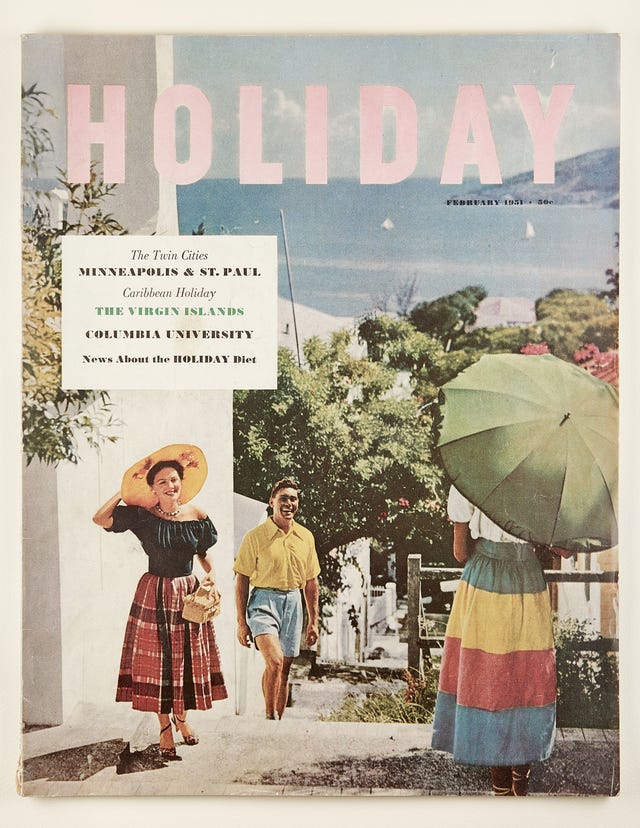
Every item on this page was chosen by a Town & Country editor. We may earn commission on some of the items you choose to buy.
In 1946, Philadelphia's Curtis Publishing Company, owner of such mass market titles as Ladies' Home Journal and the Saturday Evening Post , decided to pivot into an entirely untapped category—luxury travel. Millions were coming home from the war and suddenly finding themselves, for the first time ever, with the means to start chasing the American dream—buy a car, purchase a house, stock it with state-of-the-art appliances. And soon that dream would expand. Maybe there was something beyond the white picket fence and backyard, but what?

The answer was found in Holiday . As America's first travel magazine, it set the bar impossibly high and for nearly three decades, Holiday would be one of the most influential, beautiful, and aspirational tomes to grace coffee tables across the country.
Editor Ted Patrick and his art director Frank Zachary , who would later bring his discerning eye to Town & Country as its legendary editor-in-chief for 21 years, opened the world to their readers, showing them places they would have never dreamed of going (and thanks to the onset of the jet age in the '50s, that were easier than ever to get to).

Holiday: The Best Travel Magazine that Ever Was

" Everybody was learning and that was one of the things that was so great about it," says Pamela Fiori, who began her magazine career at Holiday in the late '60s and went on to become T&C 's editor-in-chief in 1993, where she remained for 17 years. She did a deep dive into Holiday 's storied history for her new book, Holiday: The Best Travel Magazine That Ever Was , which came out last month. "Patrick wanted Holiday to be more than just a travel magazine. He wanted it to be enlightening in the best sense of the word."

To achieve this goal, Patrick and Zachary brought on an impressive list of contributors, writers, and photographers, who included Slim Aarons (whose most iconic photographs of the glamorous jet set were shot on assignment for Holiday ), Robert Capa, E.B. White (his famous essay, Here is New York , was first published in Holiday 's April 1949 issue), Joan Didion, Truman Capote , Ernest Hemingway, and Colette. Together they created a magazine that, by its heyday in the 1950s, was "not only beautiful and arresting to look at, but intelligent and highly literary," Fiori says. "It wasn't just a magazine about pretty places."

Holiday would shutter in 1977, unable to compete with new forms of media (television, in this case) that were commanding people's attentions and making attention spans shorter. And it proved hard to recover from the turbulent late '60s. "When I started at Holiday in 1968 it was probably one of the worst years in the history of the United States," Fiori says. "There were issues out there that really couldn't be ignored—it was a difficult era with a lot of obstacles to putting out a magazine like Holiday. "
In many ways, this book is a tribute to a lost era of publishing, but also to a lost era of a certain type of travel. The open-mindedness and curiosity that people once had about unknown parts of the world. The ability to have their preconceived notions about a place completely changed. While all that hasn't disappeared completely, there is a wariness now. "There was no such thing as terrorism then," she says. "Back then, everything was new, fresh, attracting us. Are there places now I wouldn't go to? Yes. My list isn't long, but the earth is no longer a blank space to be explored."

But still, there are lessons Fiori learned during her time at Holiday that she still holds onto, and that couldn't be more relevant to our current era: "Always be curious. Never let yourself become jaded. Every place is a new place that has to be seen with eyes wide open and an open mind and heart. There were places that we covered that were not always the easiest destinations, but they were always worth studying."
Leena Kim is an editor at Town & Country , where she covers travel, jewelry, education, weddings, and culture.

The Best Room At... The Rittenhouse
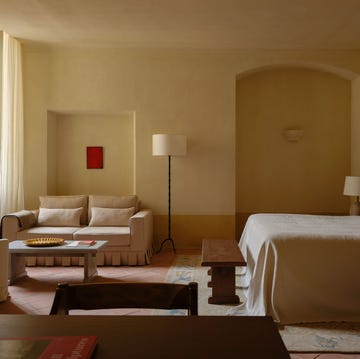
The Best Room At... Hôtel du Couvent
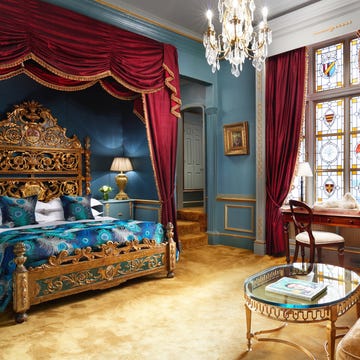
The Best Room At... The Gore Hotel London

The Best Room At... The Four Seasons Hotel Boston
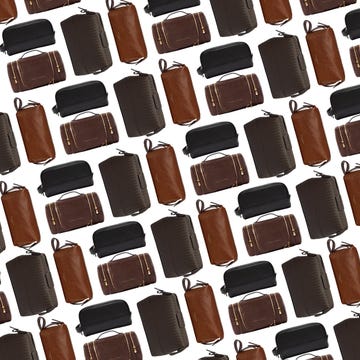
7 Luxurious Toiletry Bags for Men
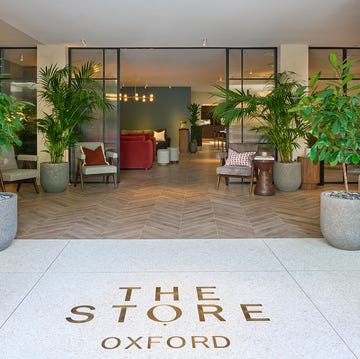
How a Famed UK Department Store Became a Hotel
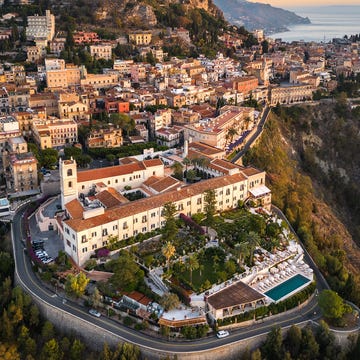
Best Room At... San Domenico Palace

The Best Room At... Wynn Las Vegas

Editor Approved Carry-Ons for International Trips

8 Duffle Bags to Swap with Your Suitcase

Can a Car Have Sprezzatura?

Are Hotel Pool DJ's Getting Too Loud?
clock This article was published more than 4 years ago
Holiday magazine: The rise and fall of the glamorous mid-century travel publication
In 1953, the French icon Colette wrote a love letter to Paris.
The city, she observed, is composed of “little islands formed sometimes by two or three streets, a bit of garden, a courtyard — little islands each with its special identity.”
Colette died the year after her essay was published in the American magazine Holiday, lending poignancy to her words: “I can show you hidden courtyards where a century-old tree, a vine, an artisan, a humble bourgeois of Paris still persist.”
Her reflection endures today in the book “ Holiday: The Best Travel Magazine That Ever Was ” (Rizzoli, 270 pp., $85), by Pamela Fiori.
Holiday began publishing global-travel features just as the world was emerging from World War II. The name itself was optimistic (much more airy than vacation), a mood reflected in pages that were lively, literary and highly visual. Even the hardcover, inside the book jacket, is a resort-evocative Lilly Pulitzer-pink.
In Holiday, there were bikinis, wicker cafe chairs and sailboats with their spinnakers ballooning, flying with the wind, as if a metaphor for the post-war era.
And there’s plenty of Wasp culture. A 1954 photo, for example, depicts formally attired Glyndebourne Festival operagoers standing on the lawn of an estate outside London. As the cutline noted, they arrived a full hour early in their evening clothes “to take late afternoon tea, to discuss Wagner and Verdi, to stroll beside the herbaceous borders and to admire the fine cows and century-old trees.”
But the magazine’s diverse itinerary also took readers from Cuba to Iowa to Zanzibar.
Great reads for the armchair traveler
The pages were also about places of the mind, Fiori notes. Those elements now make for an engaging book that combines travel and media history.
Fiori, who began her publishing career at the magazine in 1968, traces Holiday from its inception to its decline. Her look back at the onetime monthly (1946-1977) is rich in images by famed photographers and illustrators of the mid-20th century. The camera cadre included Slim Aarons, Henri Cartier-Bresson, Robert Capa, Burt Glinn, Bruce Davidson and Arnold Newman.
Some had covered World War II and were relieved to focus on scenes of gaiety, society and leisure. The world seemed open again to discovery and frivolity.
“Most of the [French] Riviera closed down during the war, except for Monte Carlo’s Casino,” read a 1948 Holiday report from Cannes. “But the last two seasons have been almost normal.”
The accompanying photo depicted a crowd having drinks in the midday sun at the Carlton Hotel Bar. (The hotel and bar, which was featured in Hitchcock’s “To Catch a Thief,” still treats guests to sea views.)
Capa, “considered the greatest, most fearless combat photographer of all time,” Fiori says, penned a decidedly light piece for the magazine on the French summer season in Deauville and Biarritz.
“Normandy is the summer capital of Paris,” he wrote. “The Deauville season runs from July 15 to the third week of August. Then the polo players, the pretty girls, the playboys and the maharajahs are off on the second leg of their journey; they take the road south and journey 500 miles to catch the season in Biarritz.”
There is ample coverage of pretty people and their playgrounds. Several featured spots still welcome guests, such as the Hotel Miramare in Positano, Italy, and the Marbella Club in Spain.
An Aarons photo captures the very sun-tanned actress and model Marisa Berenson, who is pictured in Capri, Italy, with fellow model Alberta Tiburzi. We see other international fixtures: Bridget Bardot; Sir Run Run Shaw, the Hong Kong entertainment mogul, beside his Rolls-Royce; and C.Z. Guest, (actress, best-dressed list regular, horsewoman, socialite), in Palm Beach, Fla.
Esteemed authors were dispatched to sites around the world. Bylines included E.B. White, William Faulkner, Eudora Welty, Alistair Cooke, Jack Kerouac and Joan Didion.
American writer John A. Williams described his experiences touring the United States as an African American. Santha Rama Rau addressed misconceptions of India (the entire country is not hot). Iowa was the subject of Paul Engle, who noted, “Its single greatest force is dirt — fat dirt. … The land rises and falls, not flat, not broken into steep hills, but always tilting its fertile face to the sun.”
V.S. Pritchett, the British writer, called Portugal the land of tiles, writing, “The houses, the churches, the banks, the cafes are tiled inside and often outside, too, and the tiles echo so that one or two men in a room sound like a crowd in a bathroom.”
Fiori included White’s essay on New York, a city he described as a place where one can be alone in the throng — quite relevant today as the stricken city hunkers down.
“Better than most dense communities,” White wrote, “it succeeds in insulating the individual (if he wants it, and almost everybody wants or needs it) against all enormous and violent and wonderful events that are taking place every minute.”
Even when you can’t travel, you can still bring the sounds of a far-off city to you.
Cooke, the journalist and broadcaster known to many as the distinguished former host of PBS’S “Masterpiece Theatre,” said his favorite day’s drive anywhere in the United States was east from Spokane, Wash., to Missoula, Mont.
He added, “If I had to choose one of all the natural phenomena of America to see before I died, it would be Bryce Canyon” in Utah.
Holiday issues featured bold illustrations by top graphic artists. Their work was as wonderfully mid-century as a Danish-modern chair. Names included George Giusti, Ronald Searle and Edward Gorey. Samuel Maitin’s very modern “California Without Cliches” illustration covered a 1965 issue that included an essay on Sacramento by Didion.
“It is hard to find California now,” Didion wrote, “unsettling to wonder how much of it was merely imagined or improvised.”
Among the illustrators whose work appeared on the pages of Holiday was Ludwig Bemelmans, known to many from his “Madeline” books and whose framed work is still displayed on the walls of Bemelmans Bar in the Carlyle in New York.
Also featured is noted caricaturist Al Hirschfeld, whose drawings expressed a lightheartedness with characters full of life. Hirschfeld and humorist writer S.J. Perelman made a round-the-world trip for Holiday that produced the dispatch “Westward Ha! Or Around the World in 80 Cliches.”
Unlike journeys, which mostly have a well-defined beginning and end, Holiday faded off, struggling to remain relevant.
Lifestyle magazines reflect the era. And with their eye-catching covers and exuberant cover lines, they are eternally optimistic.
In 2014, Franck Durand relaunched the Holiday magazine title. It’s published twice a year. In the book’s afterword, he writes that despite “worrying international events,” the new Holiday “chooses to observe reality with an attitude of amused elegance and hedonism, which runs counter to today’s trends.”
Post-pandemic, travelers will once again venture out, much as the original magazine chronicled in the mid-1940s. Until that time, Fiori’s book provides an aperitif, of sorts, whetting readers’ desire for using their passports again, after the viral war.
Powers is a Detroit-based freelance writer. Her website is rebeccapowers.com .
More from Travel:
The coronavirus crisis is devastating the news industry. Many newspapers won’t survive it.
Airlines have removed in-flight magazines to facilitate cleaning. Some may not be back.
The best movies to transport you to another place during your quarantine.

- X (Twitter)

Holiday: a Forgotten Travel Magazine of the Golden Age

I love flicking through old copies of LIFE magazine from way back when, but today I’ve discovered a new one to enjoy called Holiday . It was a travel magazine originally published during the 1940s, 50s, and 60s, aimed at the cocktail-party-loving post-War jetsetter.

In Holiday magazine, travel was men in fedoras flicking open silver-plated cigarette cases in the boarding area, and society swans pirouetting to their seats, Louis Vuitton hatboxes swinging from gloved forearms. And every copy, while promising a glimpse at enchanting cultures and lives, reminded readers that travel was coveted and special—and had nothing to do with taking off one’s shoes to go through a scanner,” writes Vanity Fair .

It reminds us of a magical time when cosmopolitan travel was booming and it was exciting to go to Europe on an ocean liner. What’s astonishing is its star-studded cast of writers and artists: the likes of Ernest Hemingway, Jack Kerouac, John Steinbeck, Truman Capote, Joan Didion… and glossy reportage photography by Slim Aarons and Henri Cartier-Bresson.

Here’s an article from March 1958 on living in Brooklyn, New York, featuring Truman Capote with photographs by Slim Aarons!

Even adverts enticing readers to subscribe were glamorous and exciting…
You might also like...

Oh yes, I love my Holiday Magazines…Each one is a treasure!! ~Cooks Falls Lodge~
Oh wow – do you have a collection? I have one so far – on NYC!
Write A Comment Cancel Reply
Save my name, email, and website in this browser for the next time I comment.
- Welcome to Ellie & Co
- About + Contact
- Privacy Policy
- Brighton Like a Local
- Secret Brighton
- Secret Sussex
- Unique Hotels
- Forget Brighton
- Books & Films
- Art & Design
- Unique homes
- Power Dressing
- Food Heaven
- Remember when…
- People watching

What Summer Travel in the ’50s Looked Like
Travel back in time..
- Copy Link copied
The 1950s! It was that golden era of rock and roll and Marilyn. A time of lavish cars, colorful clothes, and shiny appliances that made life easier. It also happened to be a swell time for travel. Some popular travel destinations in the 1950s included:
Hanging out at the “ultra modern” Beach Waves Motel in Wildwood Crest, New Jersey.
The Los Angeles Ambassador Hotel; before it became infamous and was simply famous.
Homowack Motel in Spring Glen, New York.
Le Baron’s Coffee Shop in Idaho Falls.
Relax by the pool and feel that summer wind blowing at Oklahoma’s Woodward Motel.
Peace and relaxation at Lake Havasu. That’s not a mirage, it’s the Hacienda Del Sol Ranch Hotel in Tucson.
Where else could Peggy and Johnny perfect their shuffleboard game than at the good ol’ Fernwood Motel in Bushkill, Pennsylvania.
For some family fun, head on over to Casino Pier & Rides in Seaside Park.
Splishing and splashing at Golden Host Motel in Sarasota.
San Francisco
Long Island!
Googie architecture at its finest in Hallandale Beach, Florida.
“On Highway 40, 12 miles west of Reno. Your last stop in Nevada and your last chance for a good 5-cent cup of coffee.”
All photos from Flickr/ 1950s Unlimited
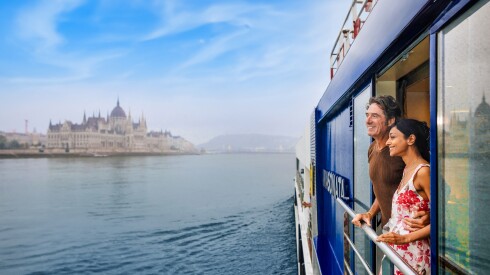
- Architecture
- Attractive Opposites
- Design Styles
- Design Trends
- Designer Spotlight
- Designers to Watch
- Editor's Pick
- Five Questions
- In Their Own Words
- Interior Design
- Jewelry and Watches
- On Location
- Photography
- Pop Culture
- Style Setter
- United by Design
- Why It's Worth It
Why ‘Holiday’ Is the Best Travel Magazine That Ever Was
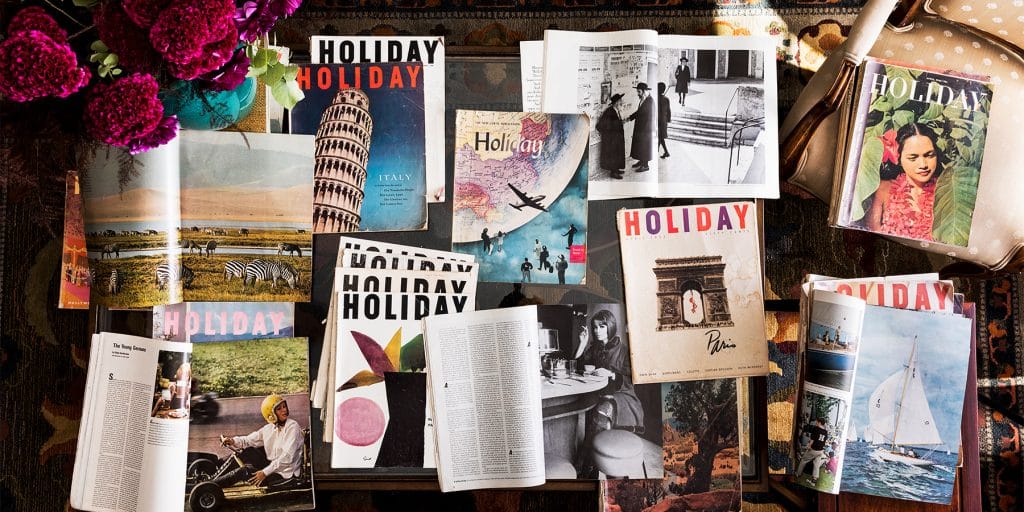
In print from 1946 through 1977 — and recently relaunched — the periodical has published works by such modern masters of prose and photography as E.B. White and Joan Didion, Slim Aarons and Henri Cartier-Bresson.
by Andrew Sessa | photos by Lesley Unruh

November 10, 2019 Longtime editor in chief of Travel + Leisure and Town & Country Pamela Fiori, photographed here in her Manhattan apartment, has just released a new book that celebrates Holiday, the magazine where she began her career. Top: An array of covers and spreads from Fiori’s home archive of Holiday issues. Styled by Sarah Cave; hair and makeup by the John Barrett Salon
P amela Fiori knows how to travel. And where. And with whom. Over the course of her five-decade career in publishing, she served as the longtime editor in chief of Travel + Leisure and Town & Country, even creating the latter’s travel-focused spinoff. Along the way, she transported readers around the world from the comfort of their living rooms, and she inspired them to get up and out of those living rooms to go explore the world themselves — always in style, and usually tucking torn-out magazine pages, with articles she’d assigned or even written, into their suitcases.
But before her time at T+L and T&C, there was Holiday, the magazine where Fiori started her career in 1968, as a fact checker, following a four-month stay in Florence, Italy and eventually to other parts of Europe. That Continental journey gave her the travel bug, but it was working at Holiday that ensured she’d never be rid of it. The periodical, she writes in the introduction to her new book, Holiday: The Best Travel Magazine That Ever Was (Rizzoli), took “readers on journeys that lifted their spirits and engaged their curiosities.”
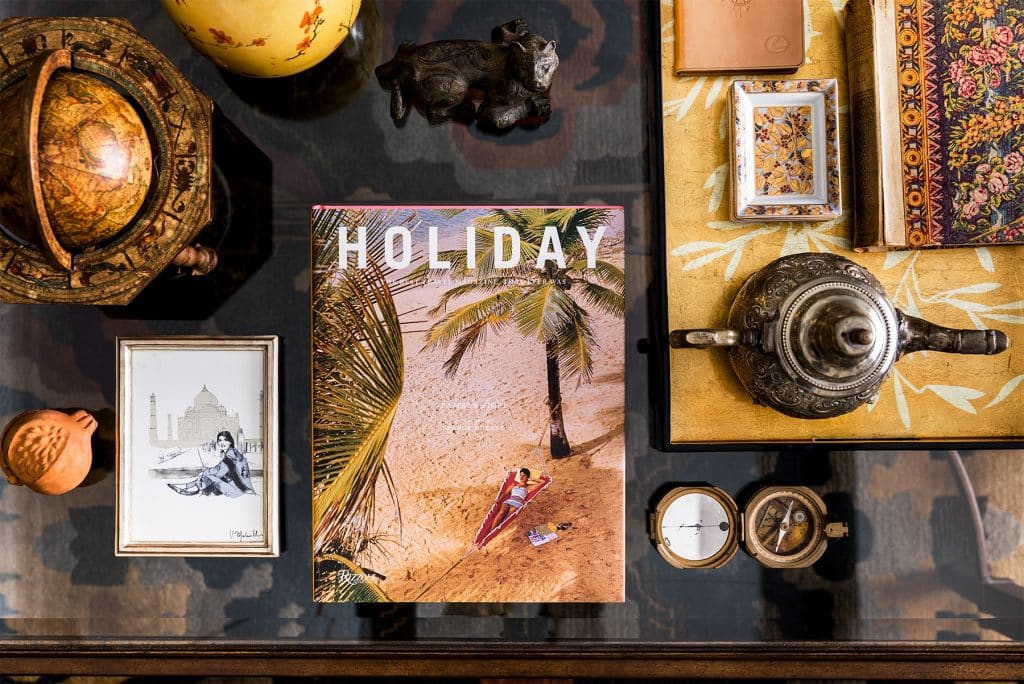
The book, Holiday: The Best Travel Magazine That Ever Was (Rizzoli), is surrounded by momentos from Fiori’s life and travels, including a drawing of her at the Taj Mahal by Victoria Molinelli; a compass from the 1940s belonging to her husband, Colt Givner; a vintage Indian teapot given to her by the photographer Oberto Gili ; and an antique globe .
Launched in 1946, Holiday was arguably the country’s first travel magazine, but having no obvious direct competition didn’t mean it was lazy about its editorial. To the contrary, its editors commissioned work from the greatest literary lions and award-winning photographers and illustrators of the day. Its pages presented deep dives into lands both far-flung and close to home, with a focus on telling compelling, transporting stories not just about places but about people, too — often including the stunning houses they called home.
The new book features scores of the best, most captivating articles and images from Holiday ’s 30-year run, as well as an afterword by Paris-based graphic designer Franck Durand, who relaunched the magazine in 2014 and whose atelier oversaw creative direction of this volume.
Fiori recently spoke to Introspective about the book and what puts Holiday in a class of its own.
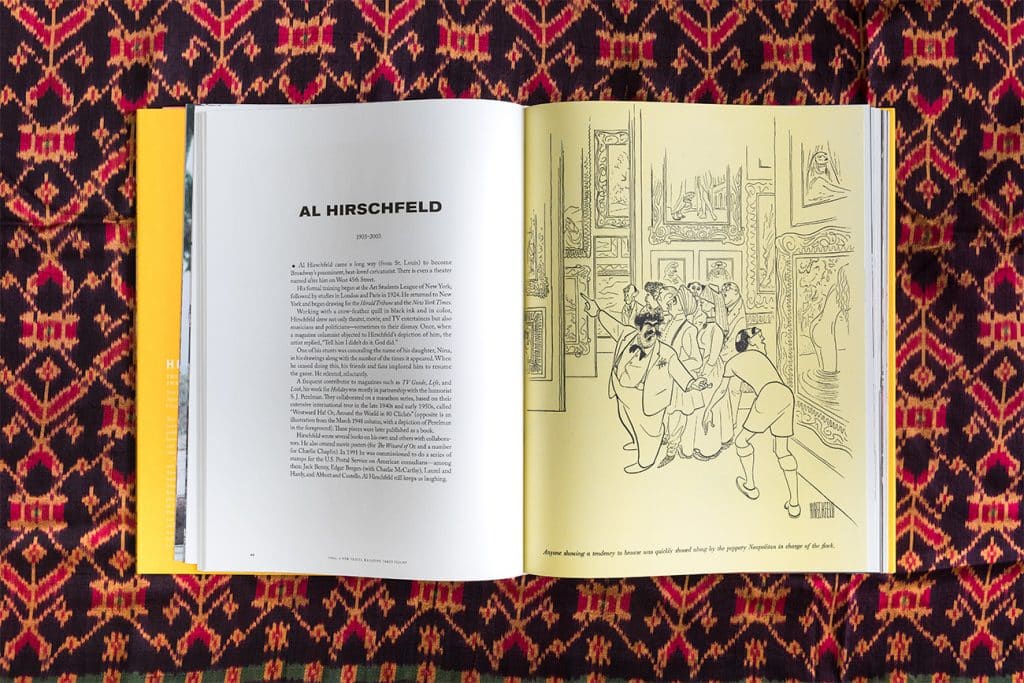
Among the top talents who contributed to Holiday was caricaturist Al Hirschfeld . Most of his work for the magazine, Fiori writes, was done with humorist S. J. Perelman. “They collaborated on a marathon series, based on their extensive international tour in the late 1940s and early 1950s, called ‘Westward Ha! Or, Around the World in 80 Clichés.’ ” The illustration here is from their March 1948 column.
We’ll begin with the big question: What is it that made — and still makes — Holiday the best travel magazine ever?
Apart from its being the first of its kind, Holiday was literary, artistic and photojournalistic. All its contributors were held to a high standard and were given the space to tell a comprehensive story.
There was nothing similar before in magazine form, unless you consider National Geographic, which was and is more anthropological. Today’s travel magazines do not the have the size, breadth or depth. And I should know: I edited one of them — Travel & Leisure — for many years.
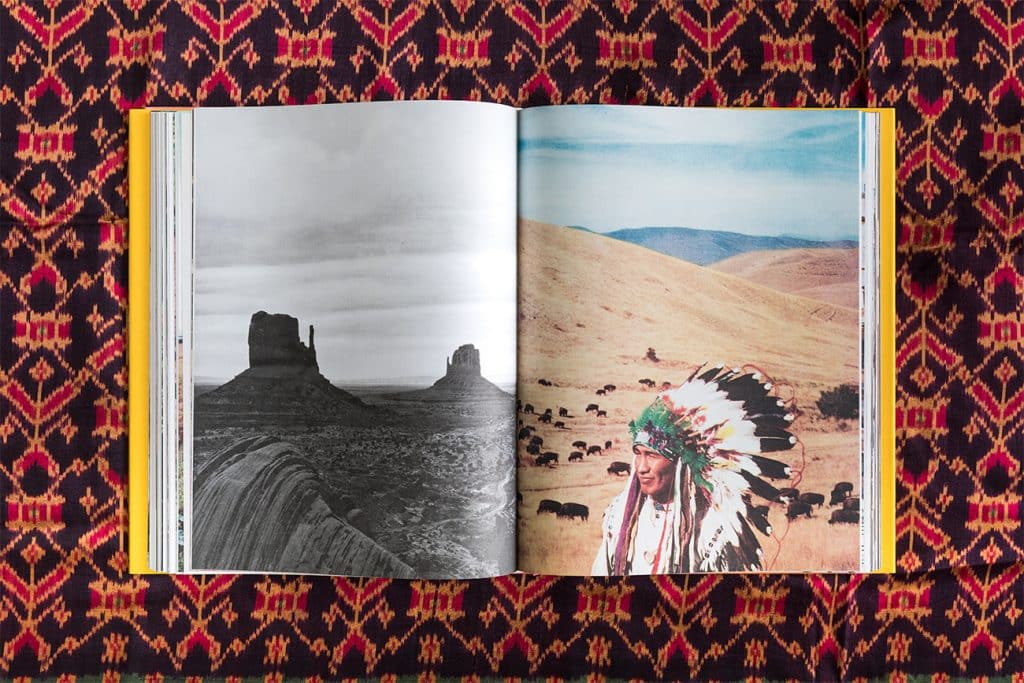
Holiday’s purview spanned the globe, to be sure, but the magazine also covered and depicted domestic destinations, as exemplified by this spread from the book. At left is a photo of Utah’s Monument Valley by an unknown artist, which ran in Holiday in January 1953; at right is a portrait by Arnold Newman of Patrick Adams, a member of the Native American Flatheads tribe, from the February 1956 issue.
The magazine worked with some of the world’s most talented writers and photographers on stories about the world’s most special places. What are your favorite articles?
Let’s start with one of the earliest: E.B. White’s magnificent essay “Here is New York,” published in the late nineteen forties. Then there is Budd Schulberg’s pungent take on Hollywood; Joan Didion on Sacramento, where she grew up; Laurens van der Post on Russia and Japan; Kenneth Tynan on Havana; the list literally goes on and on.
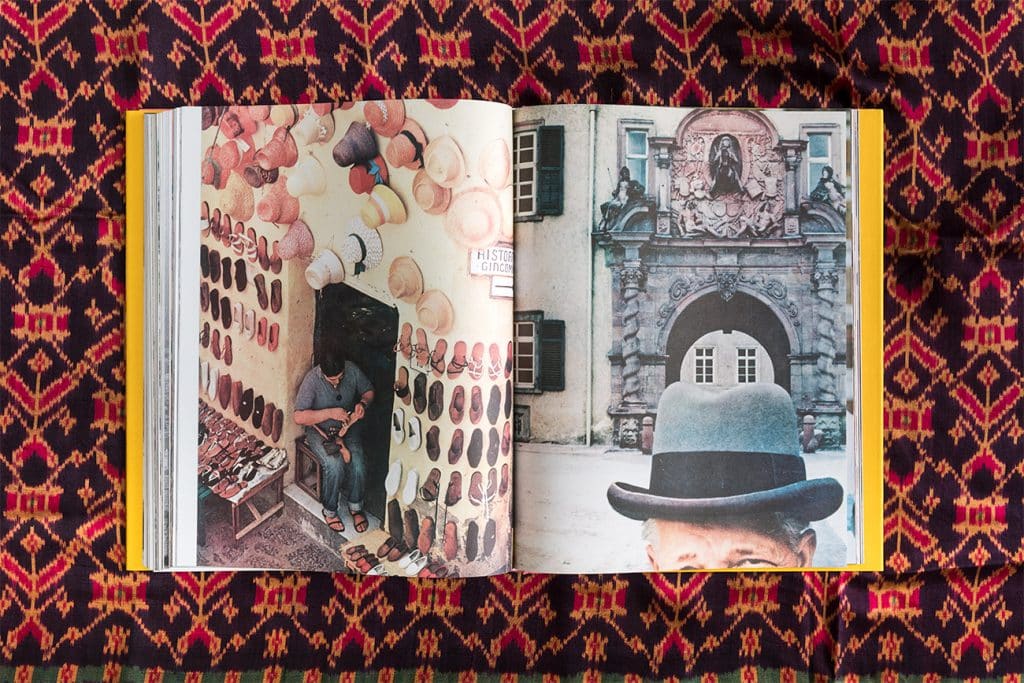
Burt Glinn photographed a shoemaker in Positano, on Italy’s Amalfi Coast, for the June 1962 issue of the magazine, while Elliott Erwitt shot in Bad Homburg, Germany, for that year’s January issue.
Holiday wasn’t just about beautiful places, of course, but also about the beautiful people doing beautiful things in those places, and the book is full of boldfaced names. Was that part of the editorial mission of the magazine?
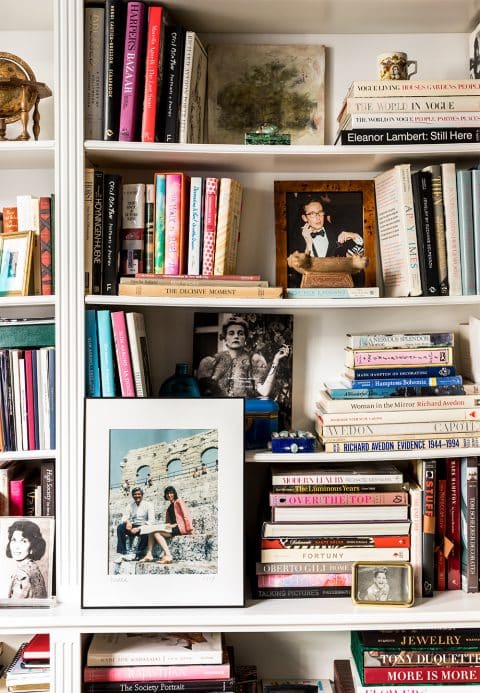
Perched amid books on fashion, jewelry, design, art, photography and more is a photo from a mid-1980s trip to Verona, in northern Italy , showing Fiori and Givner in the city’s ancient Roman amphitheater.
The line “Attractive people doing attractive things in attractive places” is attributed to photographer Slim Aarons [a regular Holiday contributor], whose post–World War Two career was all about luxury, and he adhered to that prescription like no one else. So, yes, that aspect was part of the vision — beautiful people, beautiful places. But it wasn’t the only part. Holiday editor Ted Patrick and his successors were intent on truth telling, on well-rounded narratives about destinations, including many of the world’s most complicated and challenging places, so that they were not whitewashed in any way.
1stdibs readers will be particularly intrigued and inspired by the depictions of fabulous houses, interiors and gardens in the magazine. Which stand out for you?
Almost any of Slim’s photos fit that bill. But even more memorable to me are the images by such greats as Robert Capa, Henri Cartier-Bresson , Elliott Erwitt , Arnold Newman and Burt Glinn . Credit for the design of Holiday goes directly and properly to Frank Zachary, its brilliant art director.
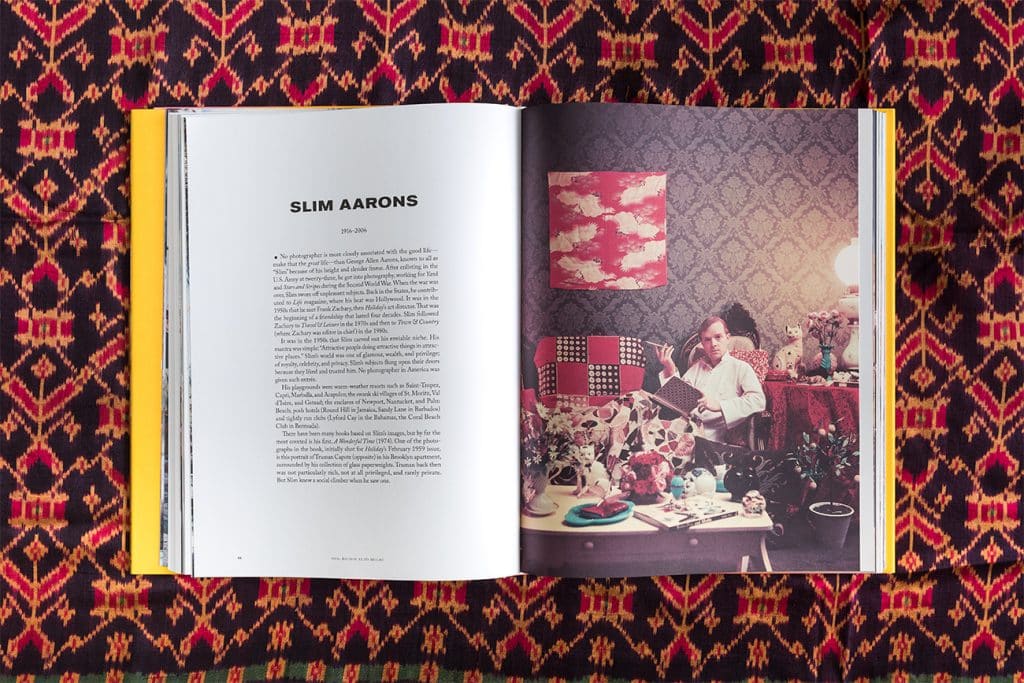
Slim Aarons shot this portrait of Truman Capote in Capote’s Brooklyn apartment with his collection of glass paperweights for Holiday ’s February 1959 issue. “Truman back then,” Fiori writes, “was not particularly rich, not at all privileged, and rarely private. But Slim knew a social climber when he saw one.”
Beyond photographers, the magazine also often enlisted artists and graphic designers to create its covers and illustrations. Can you tell us a bit about the most notable of these collaborations?
One of my favorite illustrators was George Giusti, whose covers were like Abstract Expressionist paintings . Ludwig Bemelmans was another — he both wrote and drew for the magazine. Likewise, Ronald Searle and John Rombola. Perhaps the most antic collaboration was that of caricaturist Al Hirschfeld with humorist S.J. Perelman. Patrick sent them on a round-the-world trip titled “Westward Ha!” which was one of Holiday ‘s most famous and hilarious series.
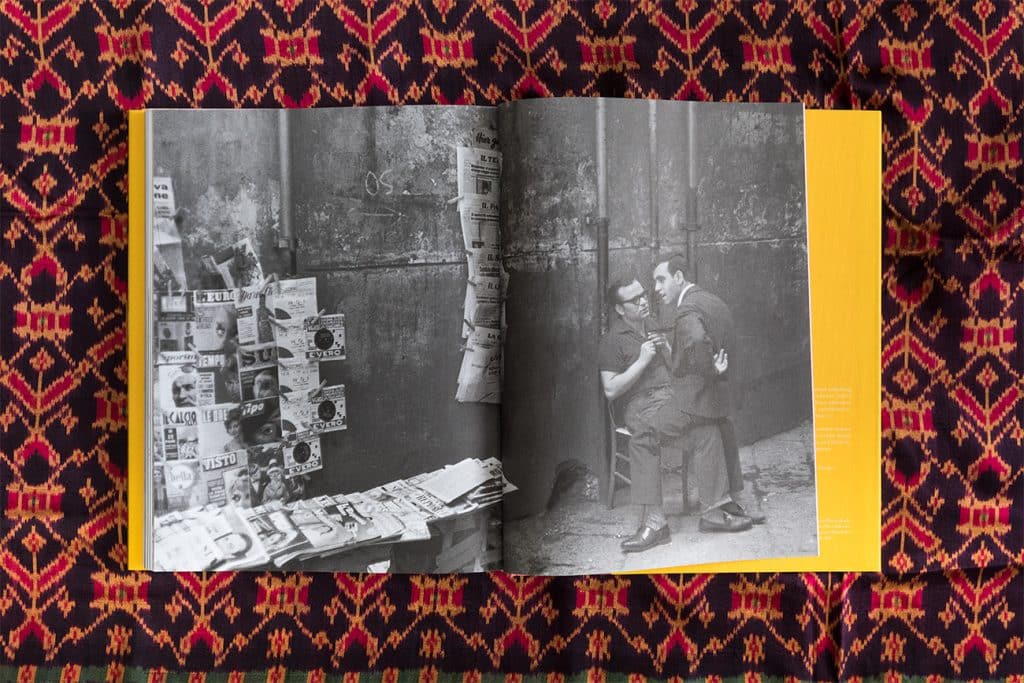
This image by Henri Cartier-Bresson — who is cited by Fiori as “[t]he twentieth-century photographer to whom all others genuflected” — was shot in Naples, Italy, and ran in the January 1961 issue. “His way of capturing ordinary people and situations gave them depth and permanence,” Fiori writes. “His images are unflinching and unforgettable.”
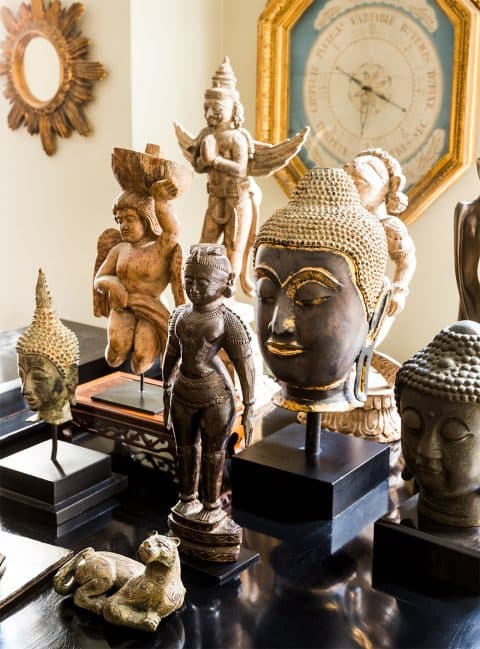
On the piano are arrayed antique Buddhas and other sculptures, mostly made by artisans in Thailand, India, Indonesia and elsewhere in Asia.
Was there anywhere the magazine didn’t — or wouldn’t or couldn’t — go?
Interestingly, there is only one photo of wildlife in East Africa. I suppose that’s because photo safaris had not come into fashion in the nineteen fifties and hunting was still allowed. There is little on Central America, nothing on Patagonia, Antarctica or the Galapagos, and not nearly enough about West Africa.
From your own travels, do you have favorite furnishings or decor finds that you brought back with you? Or design ideas you incorporated in your own homes?
The strongest influences were my trips to Africa, India and Asia. After a safari in South Africa, I completely redid our bedroom in our weekend house to resemble a lodge. My husband said, “Do me a favor. Don’t go on any more trips to exotic places.” Fat chance.
Where did your wanderlust come from? From the movies, especially The Wizard of Oz. The moment I saw it as a young child, I wanted to follow the Yellow Brick Road — and in many ways, I did, sans the witch and the menacing monkeys.
Travel, it seems, has changed your life, and in a variety of ways. How do you think it can change the lives of others? In other words, how do you think about the power of travel?
There’s not a doubt in my mind that travel — as opposed to tourism — can be life changing. The expression “Travel is its own reward” couldn’t be more true. It is the ultimate escapism and the best, most uplifting education on earth. Unless you are on a business trip, with limited time and exposure, and if you are open-minded, each trip you take will send you back home with perceptions that will alter your outlook forever.
But don’t take it from me. Get out there and see for yourself.
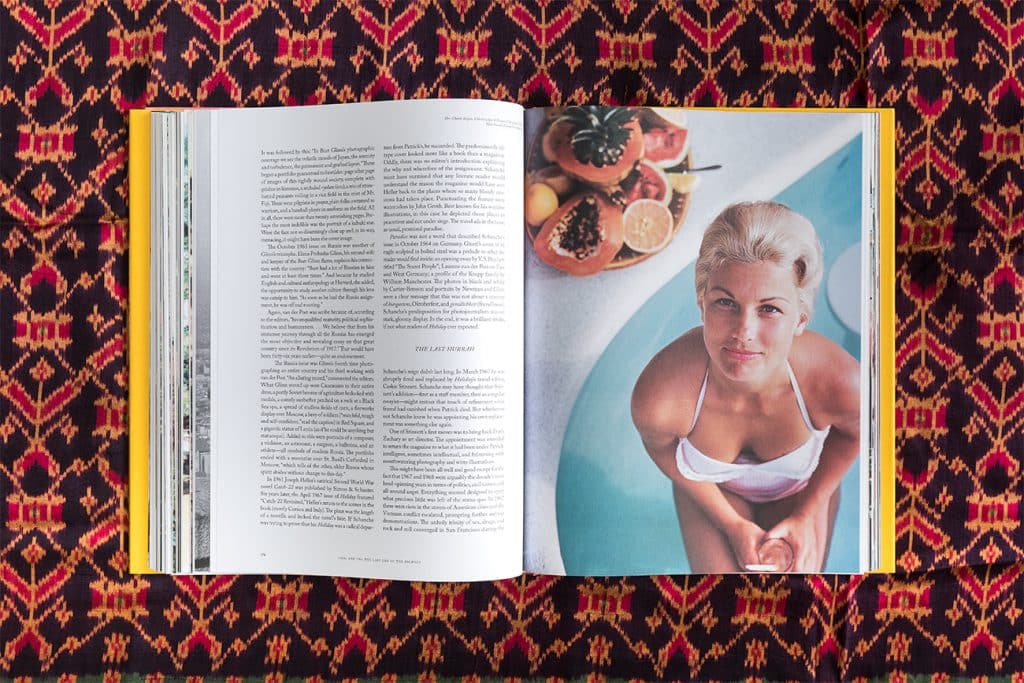
Aaron’s “mantra was simple,” Fiori writes. “Attractive people doing attractive things in attractive places.” He turned his lens on many of them for Holiday , producing such indelible, transporting images as this one, of Mrs. Charles Rogers at the Villa Vera Spa & Racquet Club in Acapulco, Mexico, which ran in the magazine’s November 1961 issue.
What do you hope readers will take away from the book? Inspiration, stimulation and an appreciation of truly great writing, evocative photography and glorious illustrations.
Buy the book.
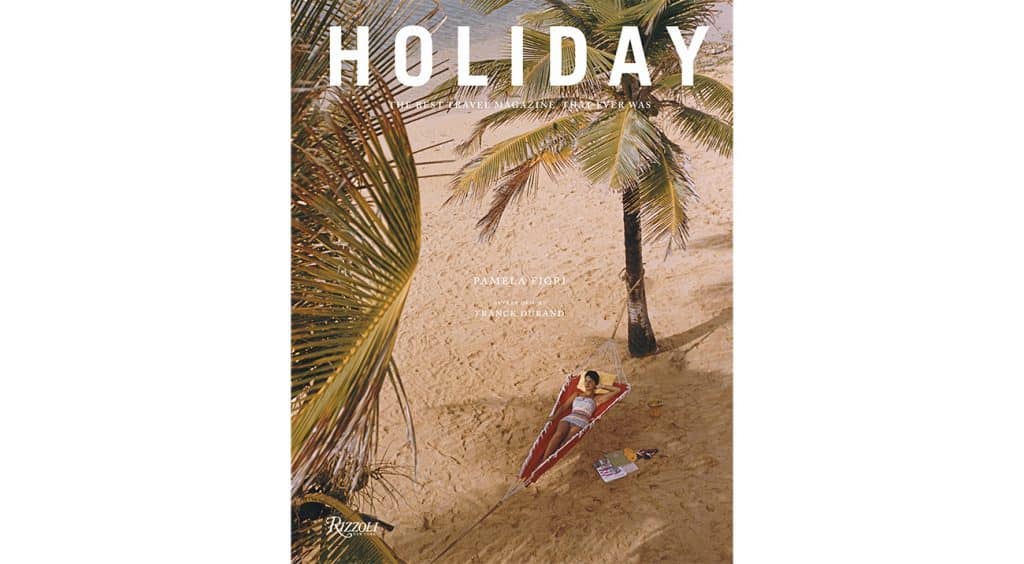
Or support your local bookstore.
Other Stories You Might Like
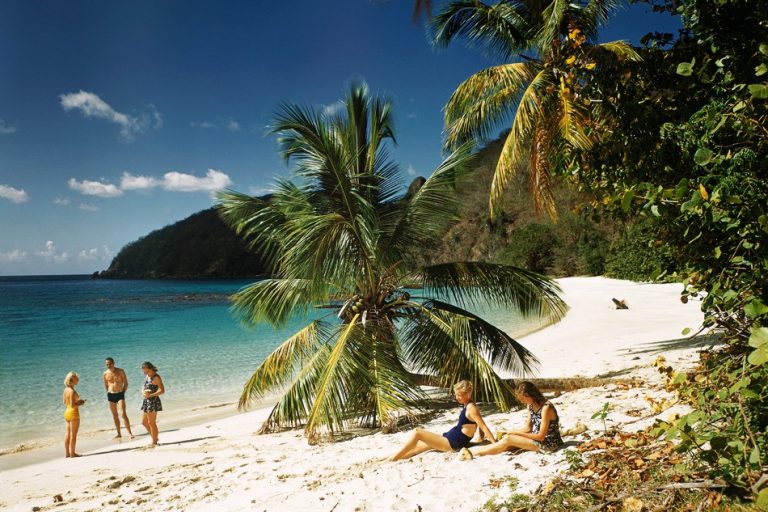
Transporting Reads
A pair of new books whisks us away to the glamorous bygone days of two different — but equally alluring — playgrounds for the wealthy: romantic Monte Carlo and the sun-drenched islands of the Caribbean. Armchair travel has never been this enticing.
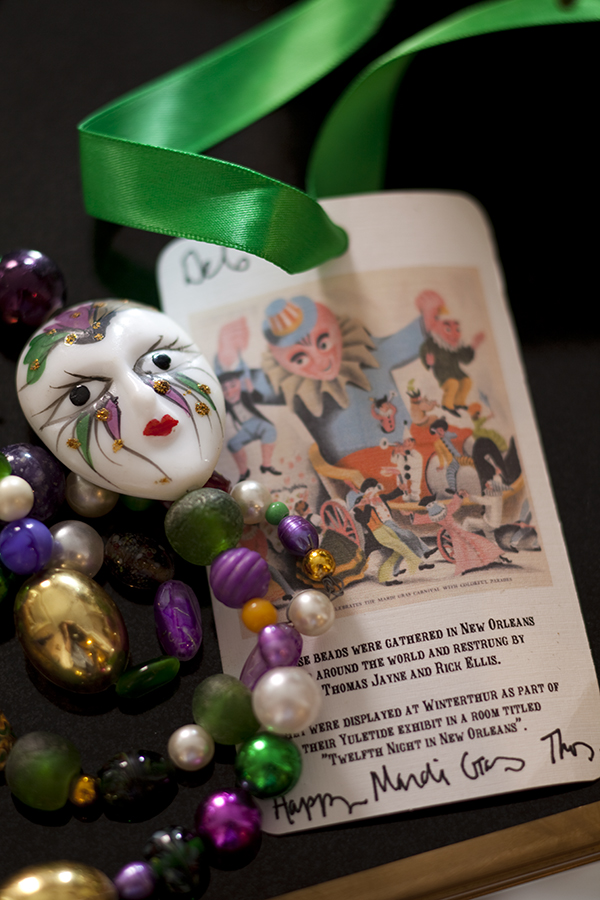
A Woman Under the Big Easy Spell
A high-powered executive at Hearst Corporation, Debra Shriver finds peace of mind by escaping whenever she can to her second home, an 1830s Greek Revival in New Orleans.
Loading next story…
No more stories to load. Check out The Study
- Browse Issues
January 1 , 1950
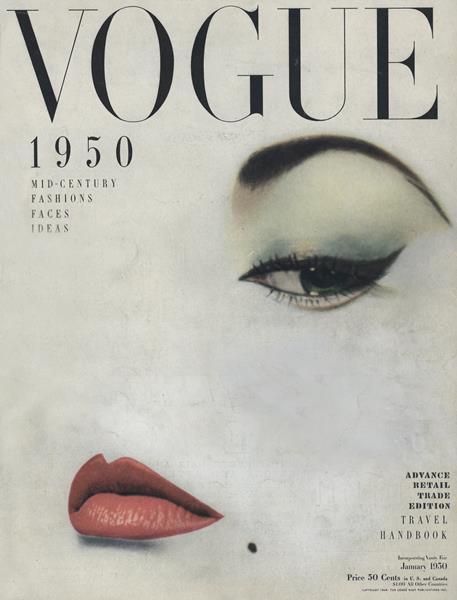
Featured Stories

Every issue. Every page. 1892 to today.
Get instant access to 125+ years of vogue. become a member exclusive & unlimited access to the official vogue archive • every issue. every page. 1892 to today..

- Search Please fill out this field.
- Manage Your Subscription
- Give a Gift Subscription
- Newsletters
- Sweepstakes
- Travel Tips
What Travel Looked Like Through the Decades
:max_bytes(150000):strip_icc():format(webp)/maya-kachroo-levine-author-pic-1-2000-1209fcfd315444719a7906644a920183.jpg)
Getting from point A to point B has not always been as easy as online booking, Global Entry , and Uber. It was a surprisingly recent event when the average American traded in the old horse-and-carriage look for a car, plane, or even private jet .
What was it like to travel at the turn of the century? If you were heading out for a trans-Atlantic trip at the very beginning of the 20th century, there was one option: boat. Travelers planning a cross-country trip had something akin to options: carriage, car (for those who could afford one), rail, or electric trolley lines — especially as people moved from rural areas to cities.
At the beginning of the 1900s, leisure travel in general was something experienced exclusively by the wealthy and elite population. In the early-to-mid-20th century, trains were steadily a popular way to get around, as were cars. The debut regional airlines welcomed their first passengers in the 1920s, but the airline business didn't see its boom until several decades later. During the '50s, a huge portion of the American population purchased a set of wheels, giving them the opportunity to hit the open road and live the American dream.
Come 1960, airports had expanded globally to provide both international and domestic flights to passengers. Air travel became a luxury industry, and a transcontinental trip soon became nothing but a short journey.
So, what's next? The leisure travel industry has quite a legacy to fulfill — fancy a trip up to Mars , anyone? Here, we've outlined how travel (and specifically, transportation) has evolved over every decade of the 20th and 21st centuries.
The 1900s was all about that horse-and-carriage travel life. Horse-drawn carriages were the most popular mode of transport, as it was before cars came onto the scene. In fact, roadways were not plentiful in the 1900s, so most travelers would follow the waterways (primarily rivers) to reach their destinations. The 1900s is the last decade before the canals, roads, and railway plans really took hold in the U.S., and as such, it represents a much slower and antiquated form of travel than the traditions we associate with the rest of the 20th century.
Cross-continental travel became more prevalent in the 1910s as ocean liners surged in popularity. In the '10s, sailing via steam ship was the only way to get to Europe. The most famous ocean liner of this decade, of course, was the Titanic. The largest ship in service at the time of its 1912 sailing, the Titanic departed Southampton, England on April 10 (for its maiden voyage) and was due to arrive in New York City on April 17. At 11:40 p.m. on the evening of April 14, it collided with an iceberg and sank beneath the North Atlantic three hours later. Still, when the Titanic was constructed, it was the largest human-made moving object on the planet and the pinnacle of '10s travel.
The roaring '20s really opened our eyes up to the romance and excitement of travel. Railroads in the U.S. were expanded in World War II, and travelers were encouraged to hop on the train to visit out-of-state resorts. It was also a decade of prosperity and economic growth, and the first time middle-class families could afford one of the most crucial travel luxuries: a car. In Europe, luxury trains were having a '20s moment coming off the design glamour of La Belle Epoque, even though high-end train travel dates back to the mid-1800s when George Pullman introduced the concept of private train cars.
Finally, ocean liners bounced back after the challenges of 1912 with such popularity that the Suez Canal had to be expanded. Most notably, travelers would cruise to destinations like Jamaica and the Bahamas.
Cue "Jet Airliner" because we've made it to the '30s, which is when planes showed up on the mainstream travel scene. While the airplane was invented in 1903 by the Wright brothers, and commercial air travel was possible in the '20s, flying was quite a cramped, turbulent experience, and reserved only for the richest members of society. Flying in the 1930s (while still only for elite, business travelers) was slightly more comfortable. Flight cabins got bigger — and seats were plush, sometimes resembling living room furniture.
In 1935, the invention of the Douglas DC-3 changed the game — it was a commercial airliner that was larger, more comfortable, and faster than anything travelers had seen previously. Use of the Douglas DC-3 was picked up by Delta, TWA, American, and United. The '30s was also the first decade that saw trans-Atlantic flights. Pan American Airways led the charge on flying passengers across the Atlantic, beginning commercial flights across the pond in 1939.
1940s & 1950s
Road trip heyday was in full swing in the '40s, as cars got better and better. From convertibles to well-made family station wagons, cars were getting bigger, higher-tech, and more luxurious. Increased comfort in the car allowed for longer road trips, so it was only fitting that the 1950s brought a major expansion in U.S. highway opportunities.
The 1950s brought the Interstate system, introduced by President Eisenhower. Prior to the origination of the "I" routes, road trippers could take only the Lincoln Highway across the country (it ran all the way from NYC to San Francisco). But the Lincoln Highway wasn't exactly a smooth ride — parts of it were unpaved — and that's one of the reasons the Interstate system came to be. President Eisenhower felt great pressure from his constituents to improve the roadways, and he obliged in the '50s, paving the way for smoother road trips and commutes.
The '60s is the Concorde plane era. Enthusiasm for supersonic flight surged in the '60s when France and Britain banded together and announced that they would attempt to make the first supersonic aircraft, which they called Concorde. The Concorde was iconic because of what it represented, forging a path into the future of aviation with supersonic capabilities. France and Britain began building a supersonic jetliner in 1962, it was presented to the public in 1967, and it took its maiden voyage in 1969. However, because of noise complaints from the public, enthusiasm for the Concorde was quickly curbed. Only 20 were made, and only 14 were used for commercial airline purposes on Air France and British Airways. While they were retired in 2003, there is still fervent interest in supersonic jets nearly 20 years later.
Amtrak incorporated in 1971 and much of this decade was spent solidifying its brand and its place within American travel. Amtrak initially serviced 43 states (and Washington D.C.) with 21 routes. In the early '70s, Amtrak established railway stations and expanded to Canada. The Amtrak was meant to dissuade car usage, especially when commuting. But it wasn't until 1975, when Amtrak introduced a fleet of Pullman-Standard Company Superliner cars, that it was regarded as a long-distance travel option. The 235 new cars — which cost $313 million — featured overnight cabins, and dining and lounge cars.
The '80s are when long-distance travel via flight unequivocally became the norm. While the '60s and '70s saw the friendly skies become mainstream, to a certain extent, there was still a portion of the population that saw it as a risk or a luxury to be a high-flyer. Jetsetting became commonplace later than you might think, but by the '80s, it was the long-haul go-to mode of transportation.
1990s & 2000s
Plans for getting hybrid vehicles on the road began to take shape in the '90s. The Toyota Prius (a gas-electric hybrid) was introduced to the streets of Japan in 1997 and took hold outside Japan in 2001. Toyota had sold 1 million Priuses around the world by 2007. The hybrid trend that we saw from '97 to '07 paved the way for the success of Teslas, chargeable BMWs, and the electric car adoption we've now seen around the world. It's been impactful not only for the road trippers but for the average American commuter.
If we're still cueing songs up here, let's go ahead and throw on "Lifestyles of the Rich and Famous," because the 2010s are when air travel became positively over-the-top. Qatar Airways rolled out their lavish Qsuites in 2017. Business class-only airlines like La Compagnie (founded in 2013) showed up on the scene. The '10s taught the luxury traveler that private jets weren't the only way to fly in exceptional style.
Of course, we can't really say what the 2020 transportation fixation will be — but the stage has certainly been set for this to be the decade of commercial space travel. With Elon Musk building an elaborate SpaceX rocket ship and making big plans to venture to Mars, and of course, the world's first space hotel set to open in 2027 , it certainly seems like commercialized space travel is where we're headed next.
:max_bytes(150000):strip_icc():format(webp)/Ellie-Nan-Storck-00d7064c4ef24a22a8900f0416c31833.jpeg)
Related Articles

Switch to the dark mode that's kinder on your eyes at night time.
Switch to the light mode that's kinder on your eyes at day time.
A Look at Golden age of Air Travel in the 1950s
Air travel in the 1950s was marked by a significant increase in the number of people flying, as well as advancements in aircraft technology and infrastructure. The decade saw the introduction of jet airliners, which greatly increased the speed and efficiency of air travel. The first commercial jet airliner, the de Havilland Comet, was introduced in 1952, followed by the Boeing 707 and Douglas DC-8 in the late 1950s. These new jet airliners allowed airlines to offer faster, more comfortable, and more convenient flights, and they quickly became popular with passengers.
During the 1950s, air travel was still considered a luxury, but it was becoming more affordable and accessible to the general public. Airlines offered more flights and destinations than ever before, and air travel was becoming more common for both business and leisure. Many airlines also began to offer vacation packages, which included airfare, accommodations, and activities, making it even easier for people to travel.
Passenger services during this time continued to improve, with in-flight meals, drinks, and entertainment becoming more common. Airlines also began to offer different classes of service, with first-class offering more luxurious amenities than economy class. Flight attendants were also becoming more commonplace, and their role expanded to include safety, customer service, and in-flight service.
The flight crews of the 1950s were composed of highly trained and experienced pilots, navigators, and radio operators. With the introduction of jet airliners, the flight crews were also larger than before, with a pilot, co-pilot, flight engineer, navigator, and sometimes a flight attendant as a standard crew.
#1 A female instructor stands at a chalkboard, pointing to a chalk diagram of an airplane while female students take notes at their desks during a stewardess training school, 1950.
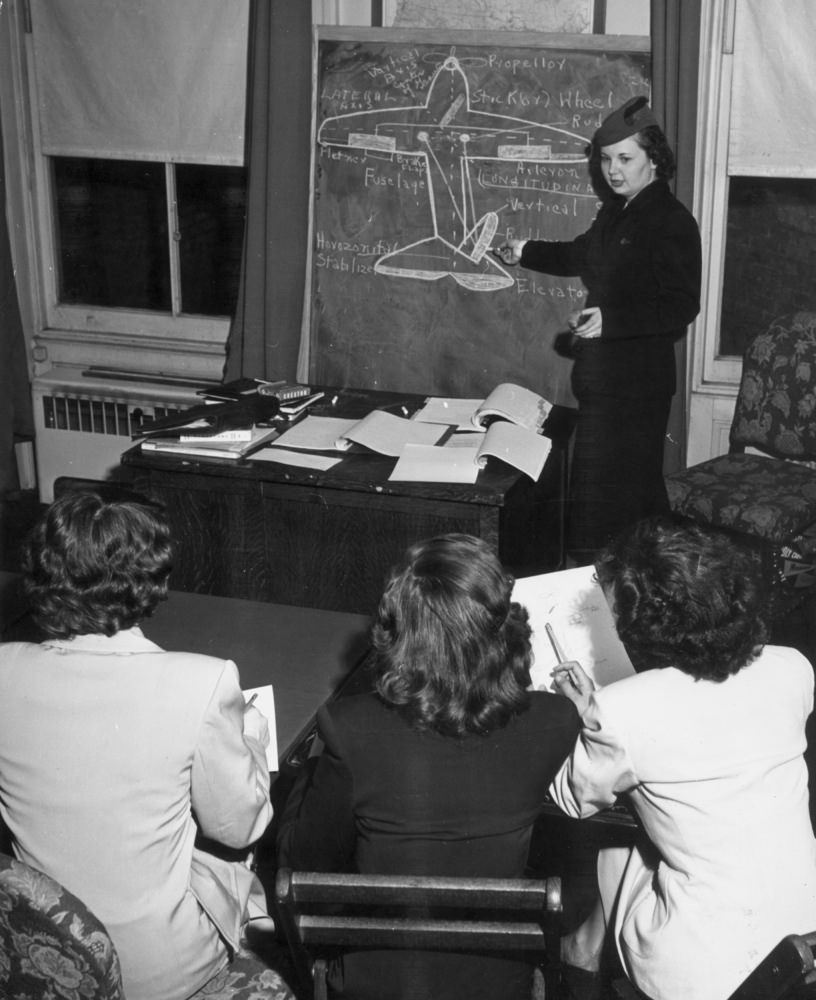
#2 Luggage being unloaded from airplane, 1950s
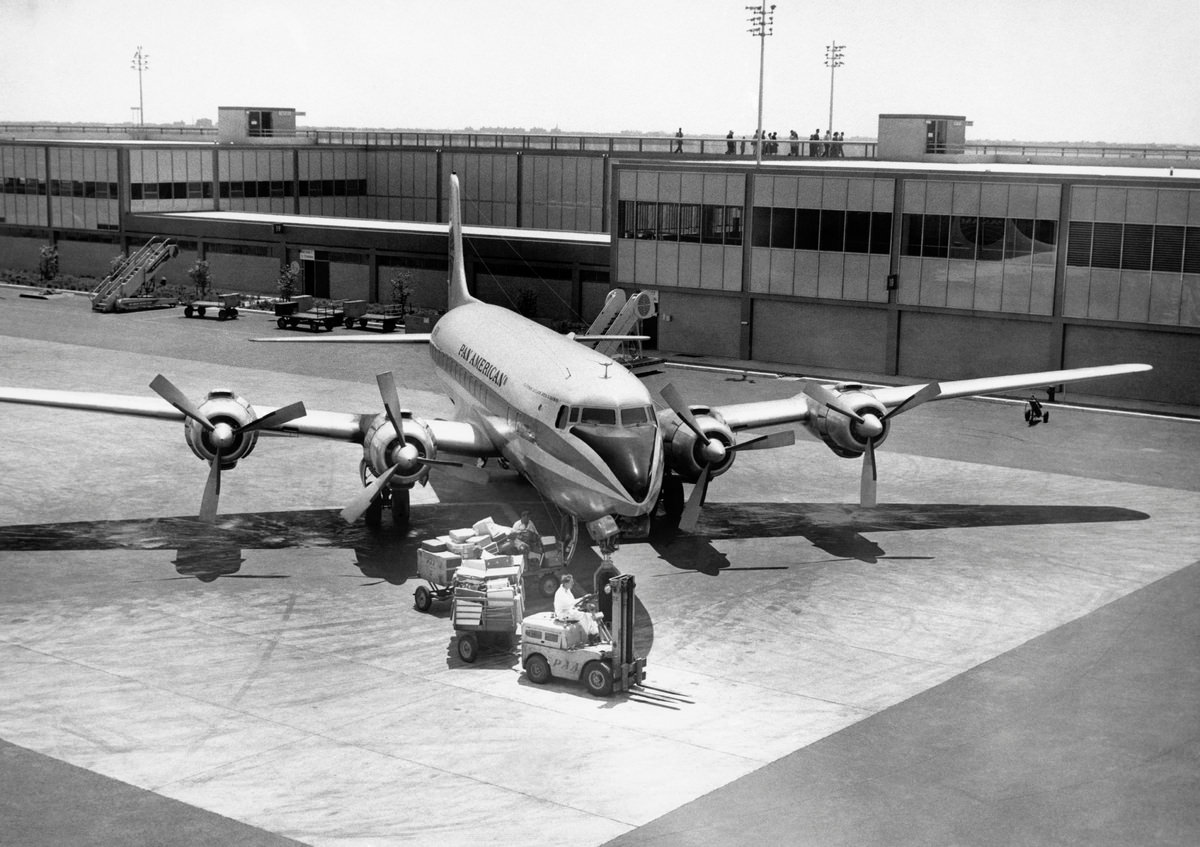
#3 Luggage being unloaded from airplane, 1950s
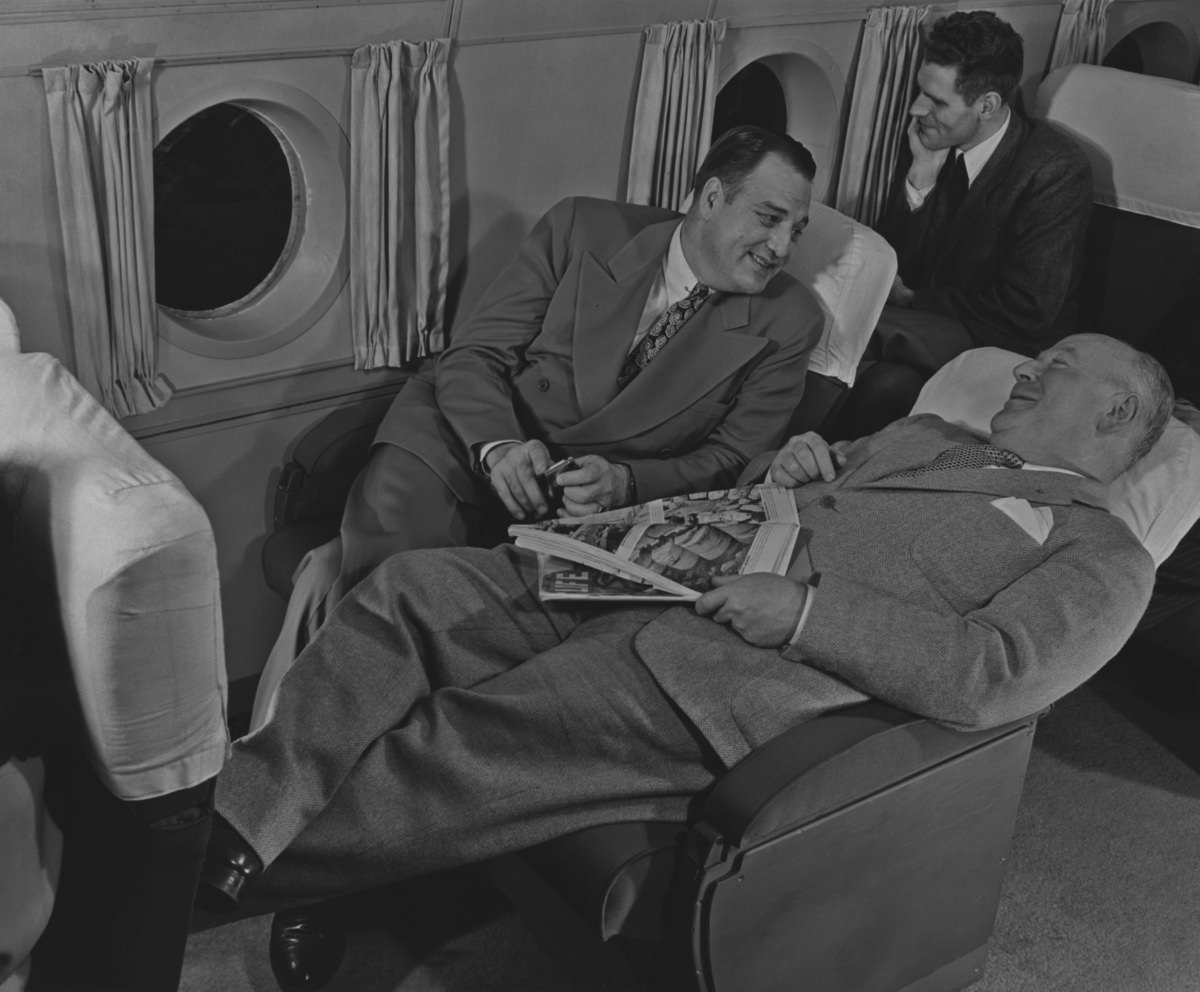
#4 A Pan American World Airways flight attendant preparing in-flight meals in the galley of an airliner, 1950s
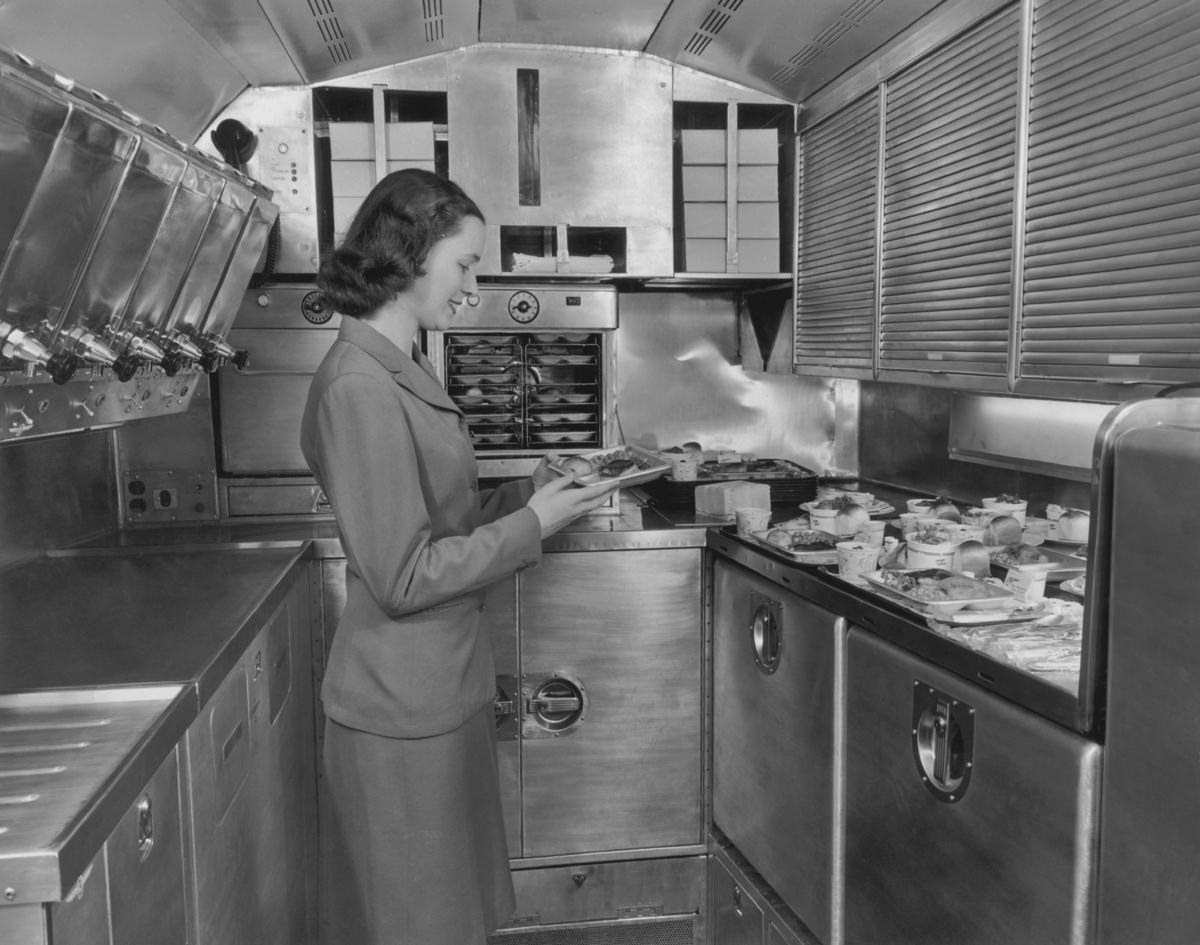
#5 A bus in bus docks at New York’s East Side Airlines Terminal. The docks are open on one side to permit exhaust fumes to escape, 1950s
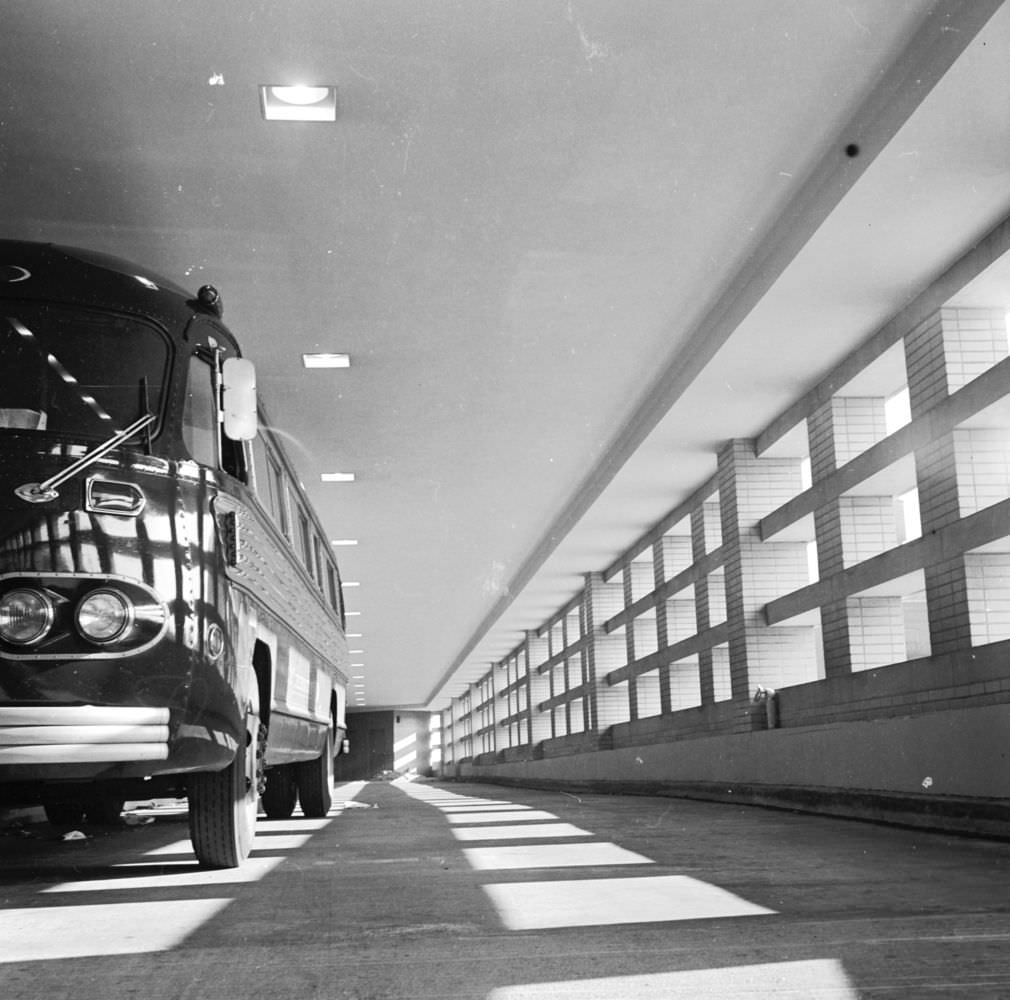
#6 Passengers checking in at New York’s East Side Airlines Terminal, 1950s
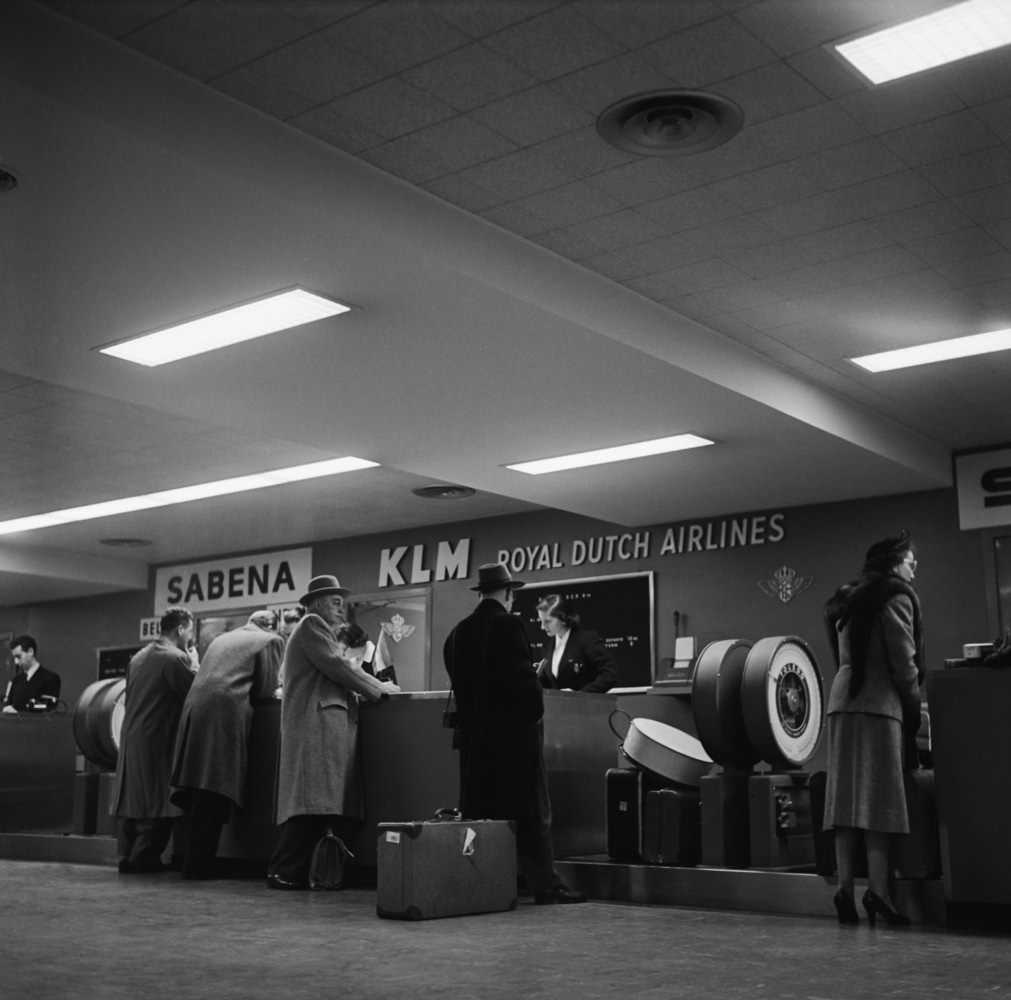
#7 Passengers checking in their baggage at New York’s East Side Airlines Terminal, 1950s
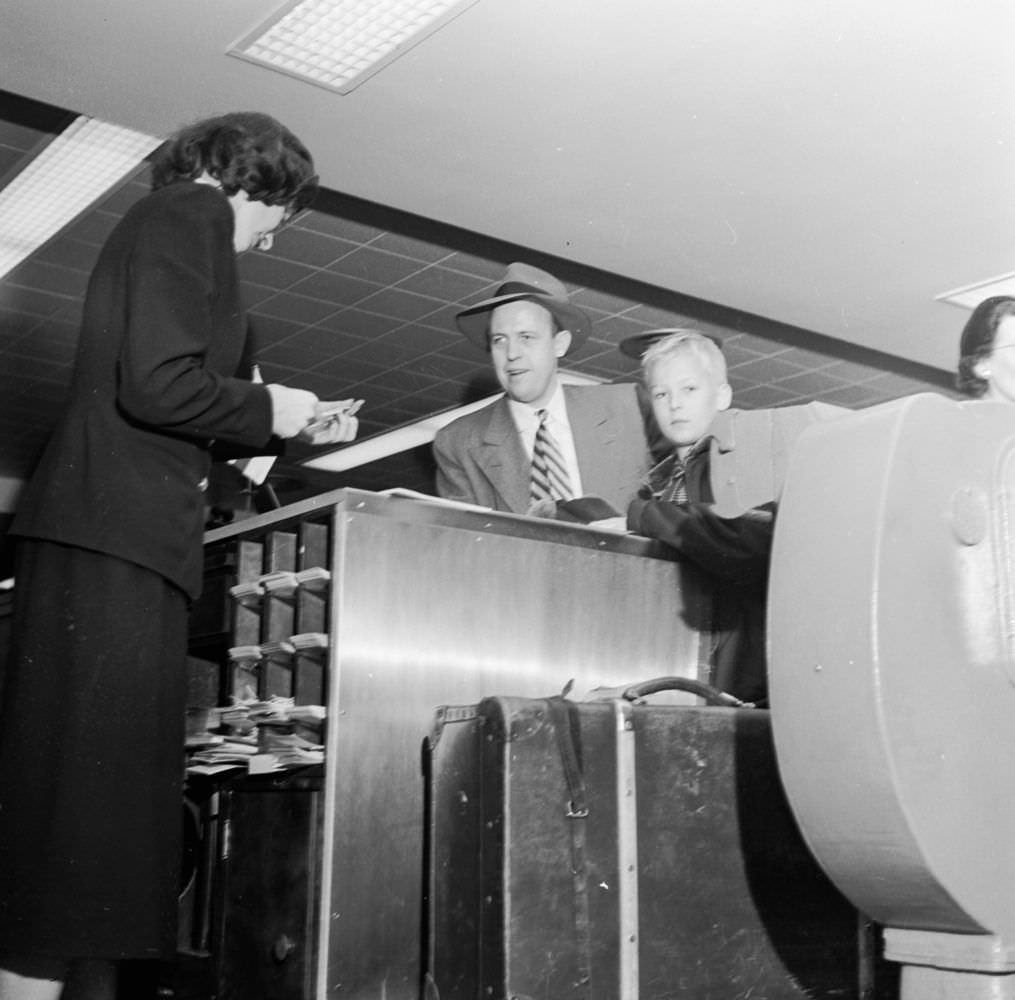
#8 Passengers checking in their baggage at New York’s East Side Airlines Terminal, 1950s
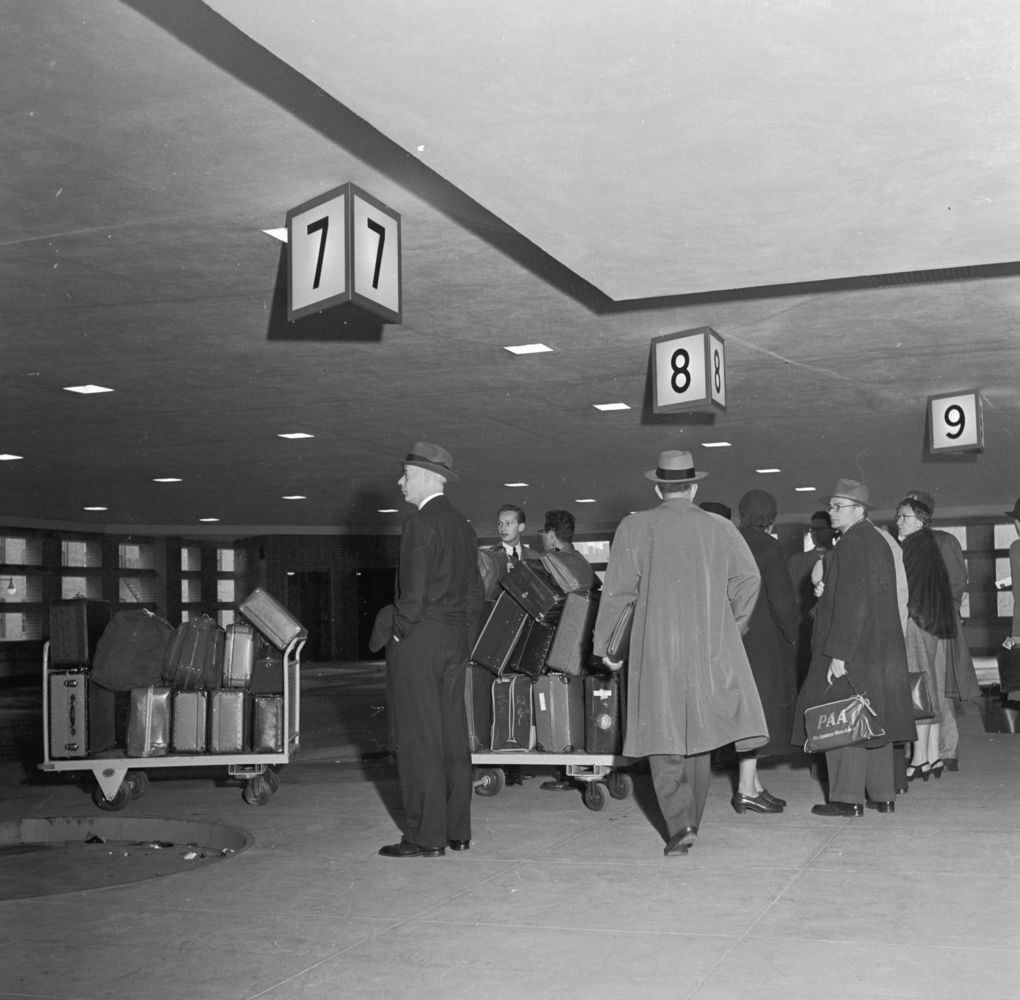
#9 New York’s East Side Airlines Terminal which operates on a 24-hour basis to provide transportation to every flight leaving from the city’s various airports, 1955.
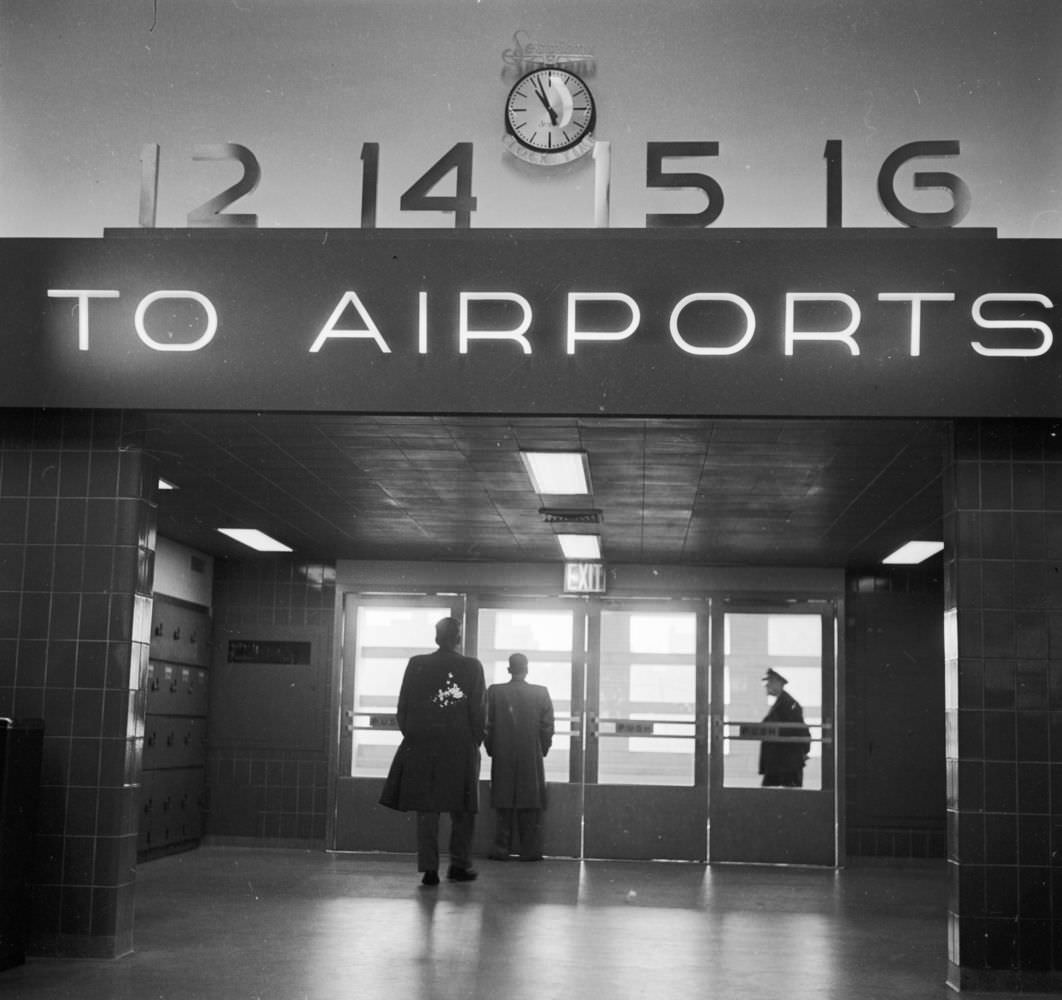
#10 A TWA pilot and stewardess greet the passengers coming off the plane, 1950
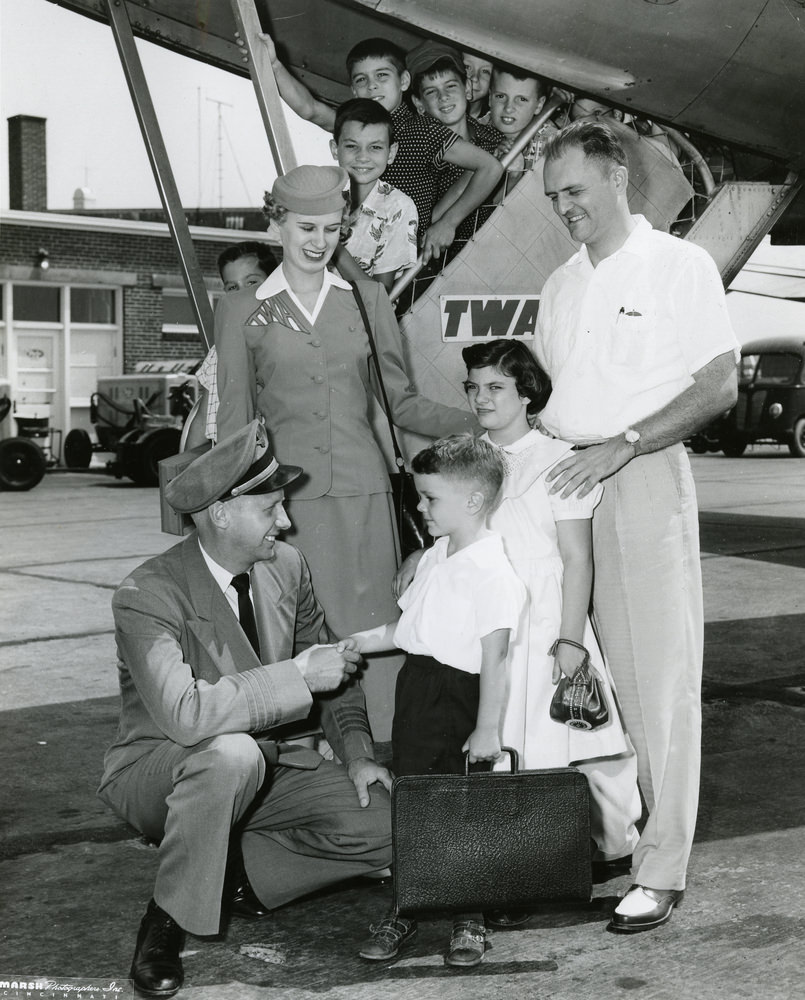
#11 PanAm Boeing 747
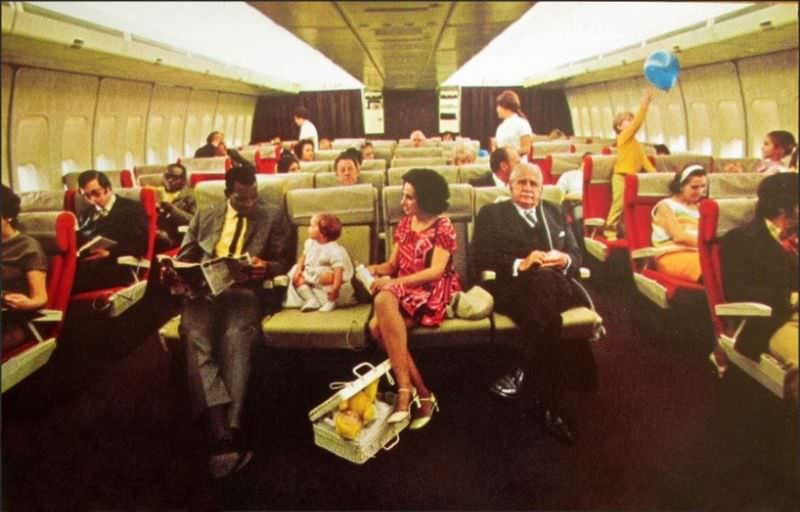
#12 A view from the control tower of the Greater Cincinnati Airport
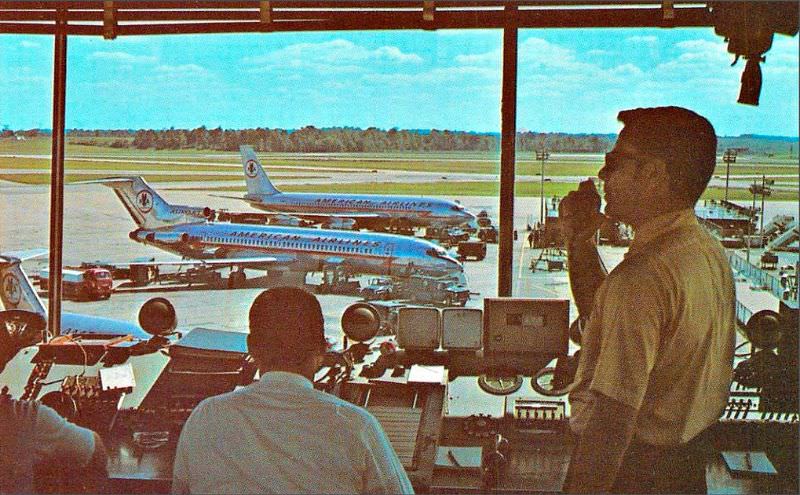
#13 American Airlines
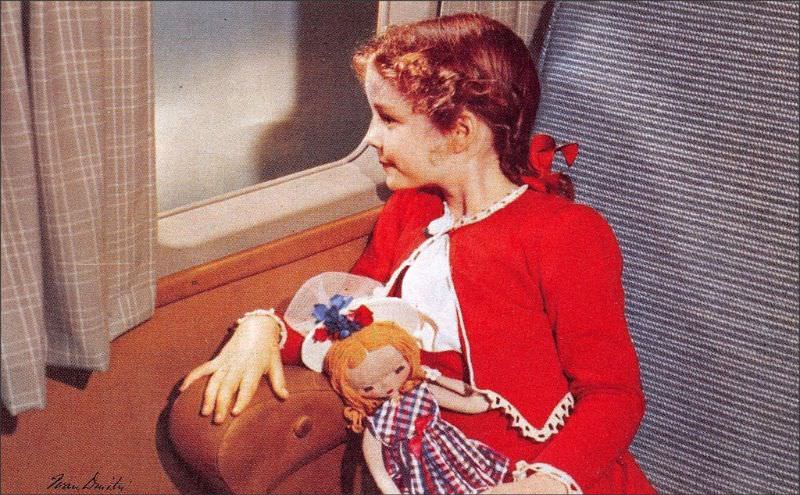
#14 Boeing 707 and 720
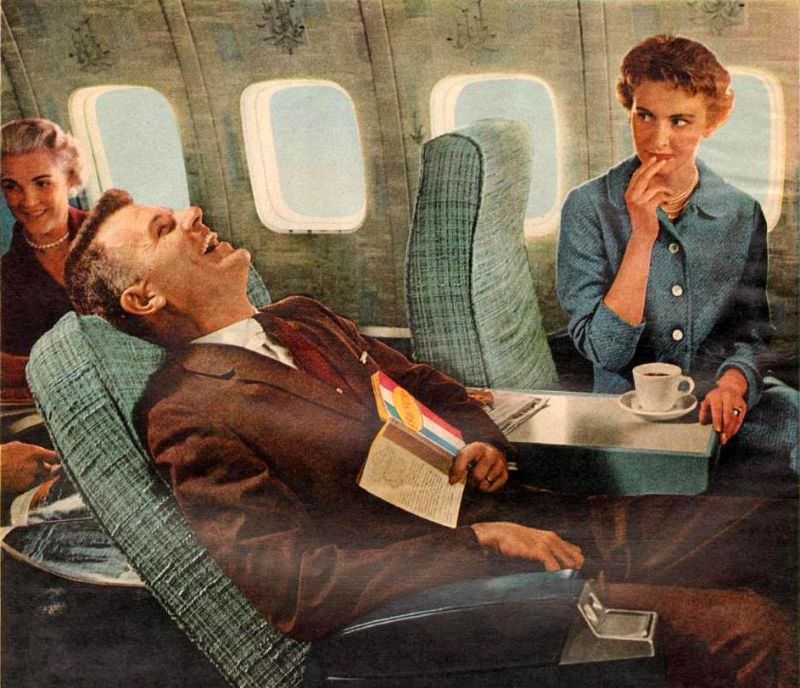
#15 Columbia Metropolitan Airport, Columbia, SC
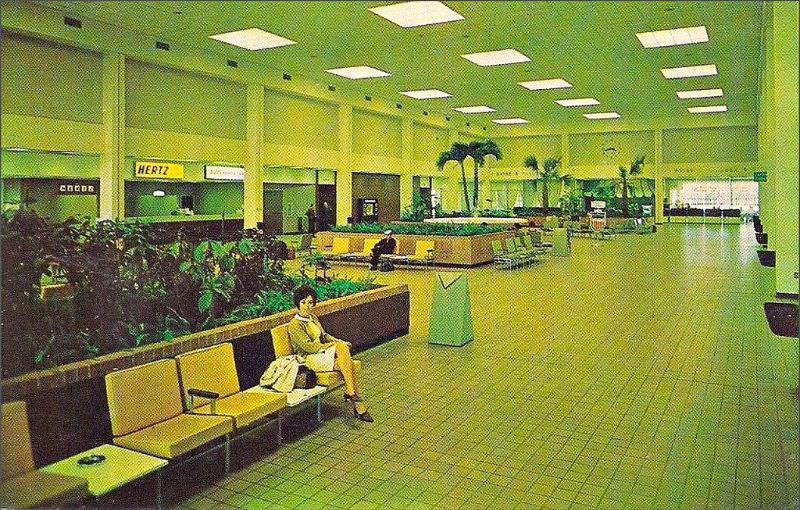
#16 Continental 747 Ponape Lounge, Airline Attendant
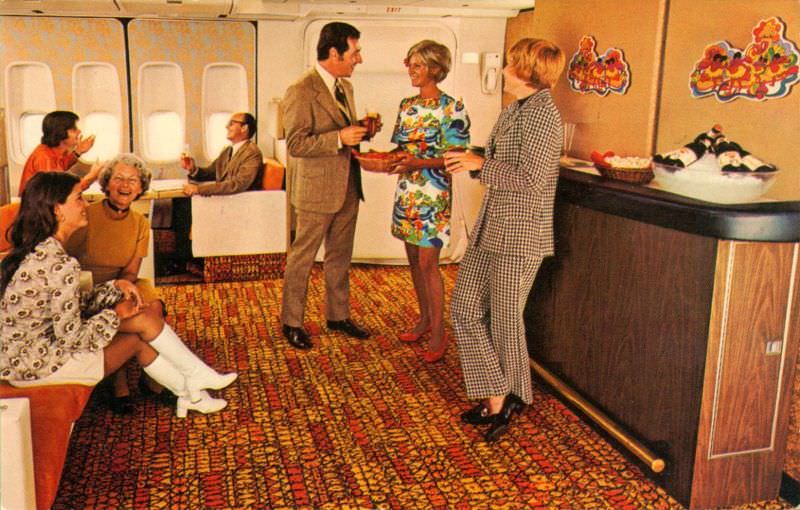
#17 Continental Airlines, 1950s
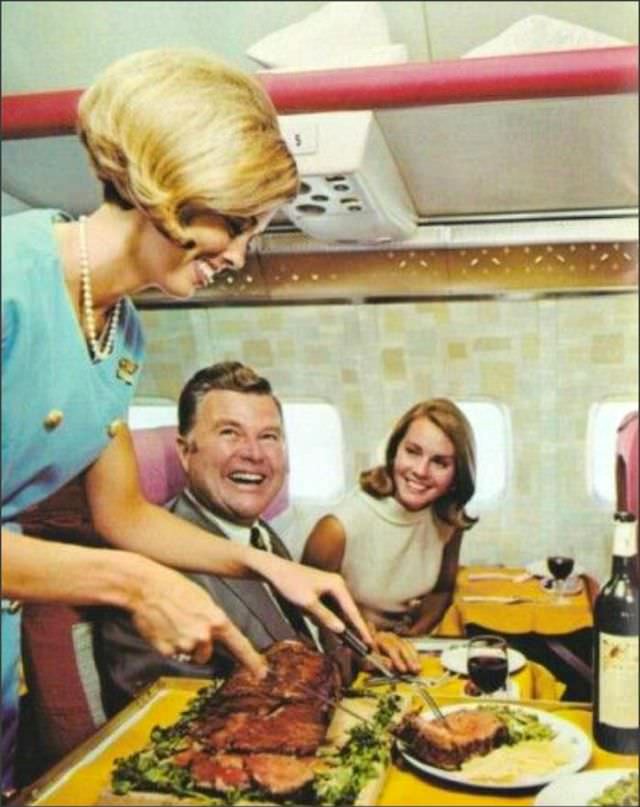
#18 Continental Airlines, 1950s
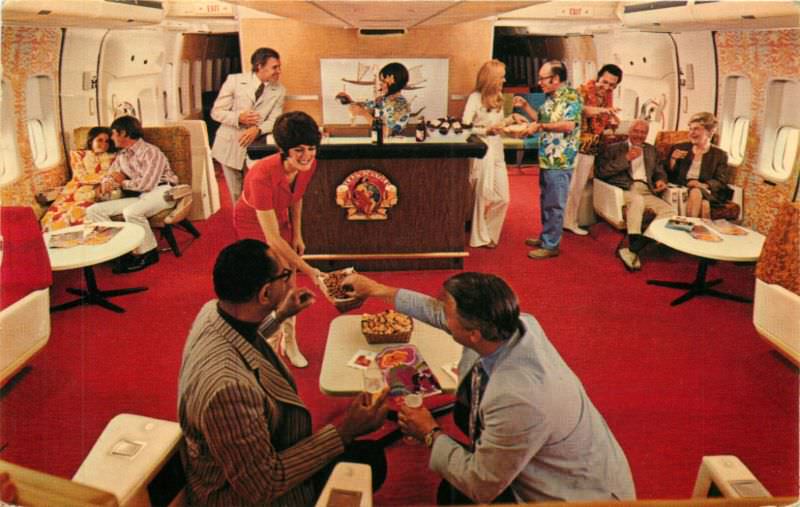
#19 DC-6 Mainliner United Airlines 48
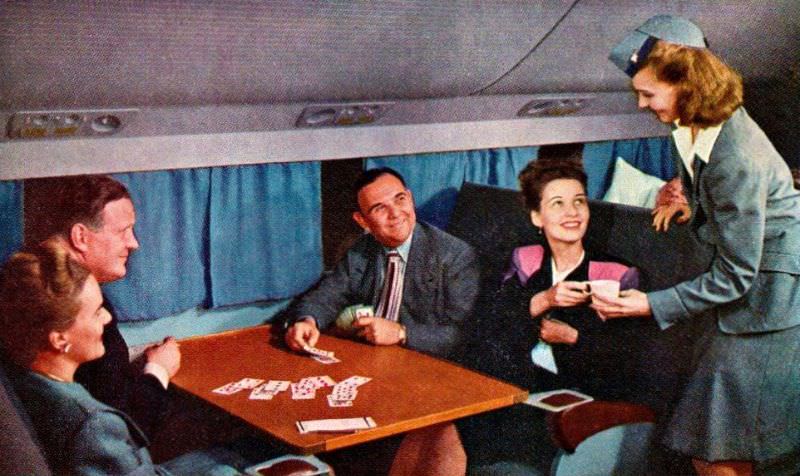
#20 Delta Airlines Convair 880
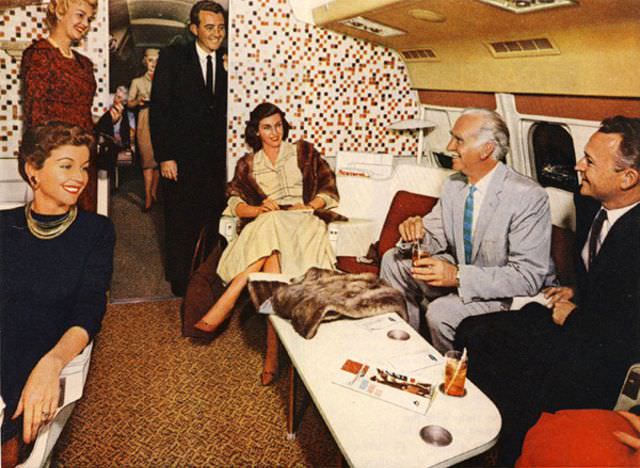
#21 Delta Airlines, 1950s
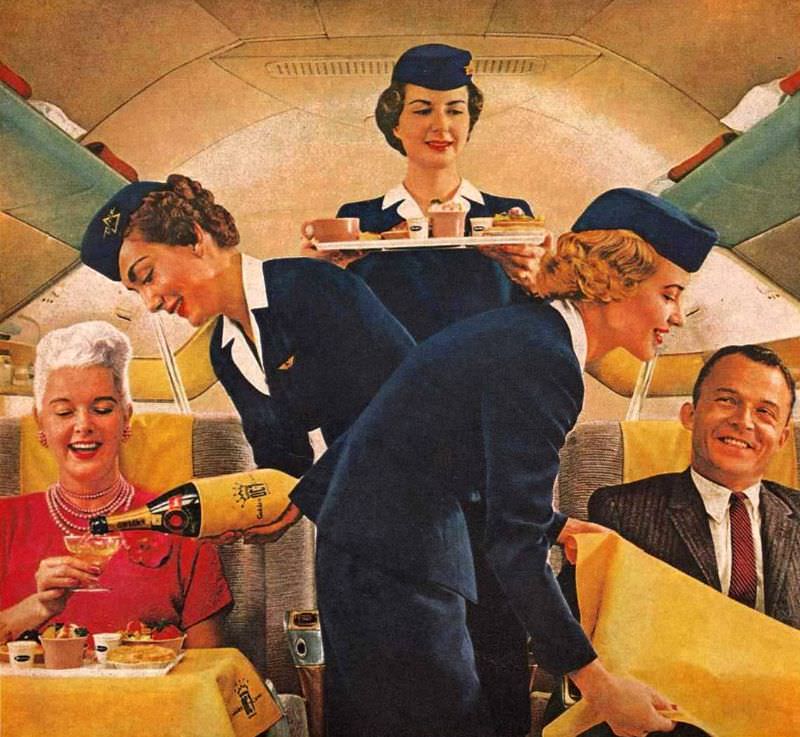
#22 Eastern Airlines Falcon Lounge, 1950s
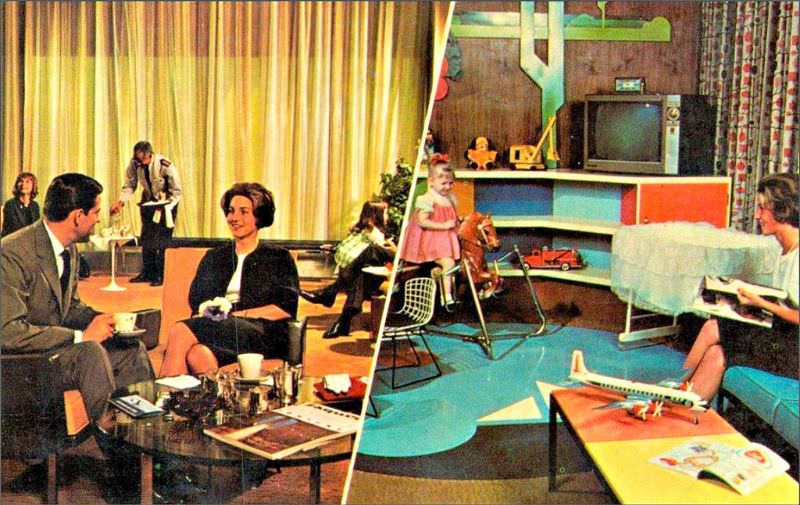
#23 Houston International Airport, 1950s
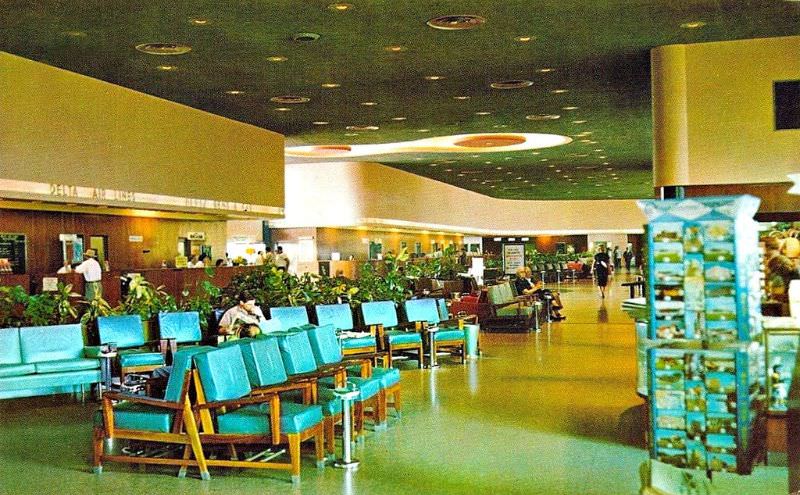
#24 Moisant International Airport, New Orleans, 1950s
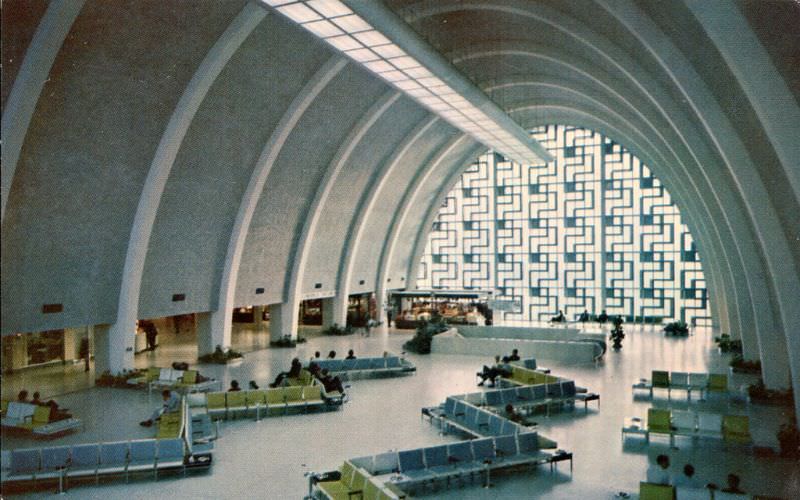
#25 Pacific Southwest Airlines (PSA) Electra Jet, 1950s
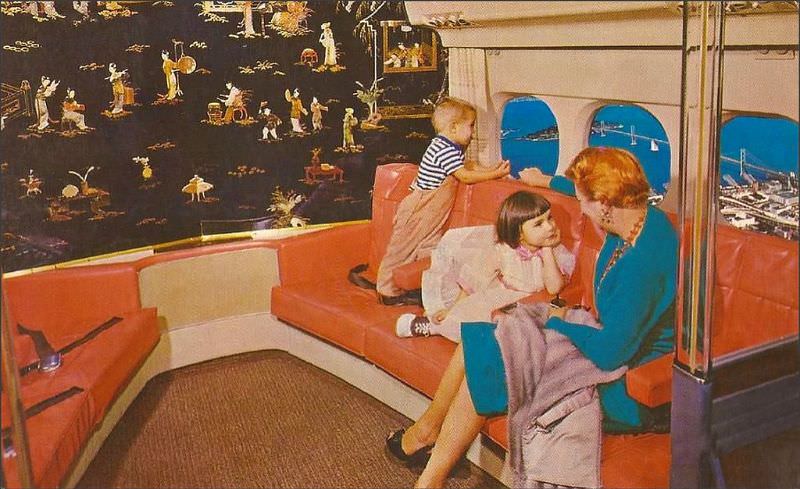
#26 Pan Am Airlines, 1950s
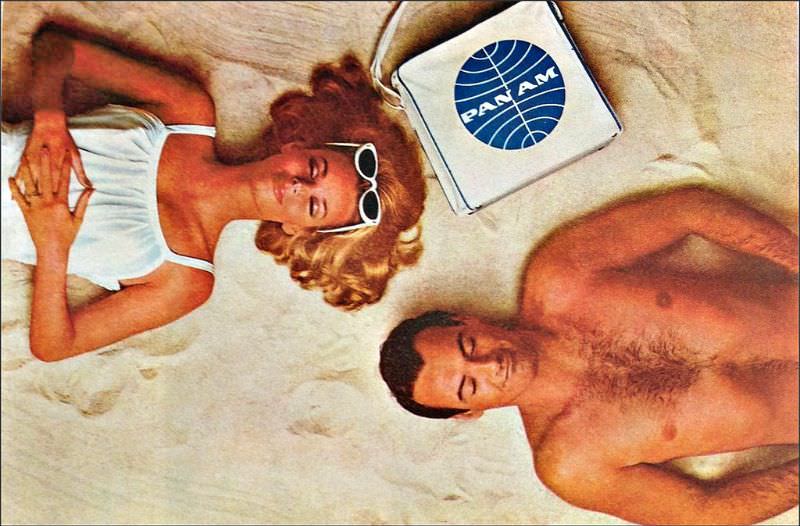
#27 United Air Lines DC-6 and DC-6B Mainliners, 1950s
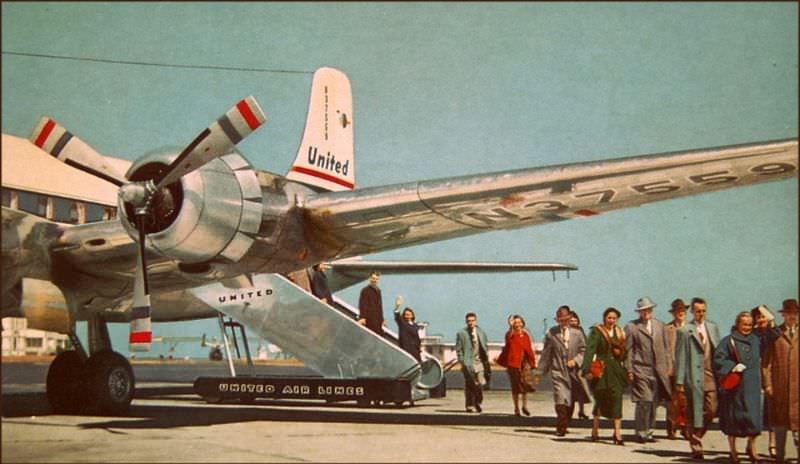
#28 United Airlines DC6 Airplane Meal Service Club Car Section, 1950s
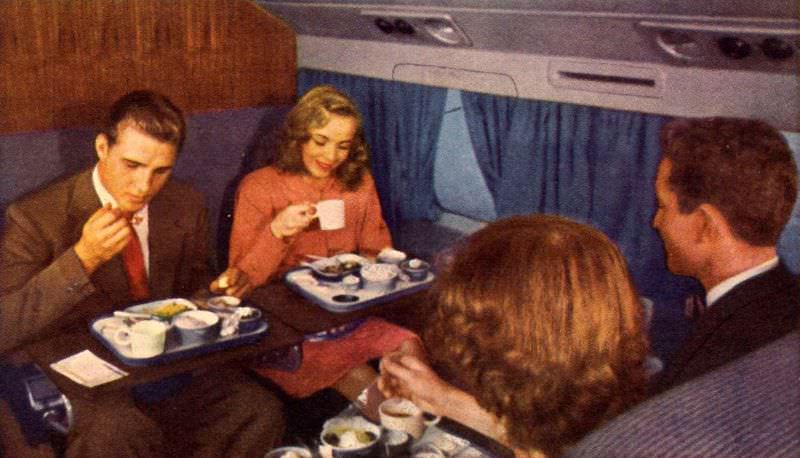
#29 United Airlines Red Carpet Service, 1950s
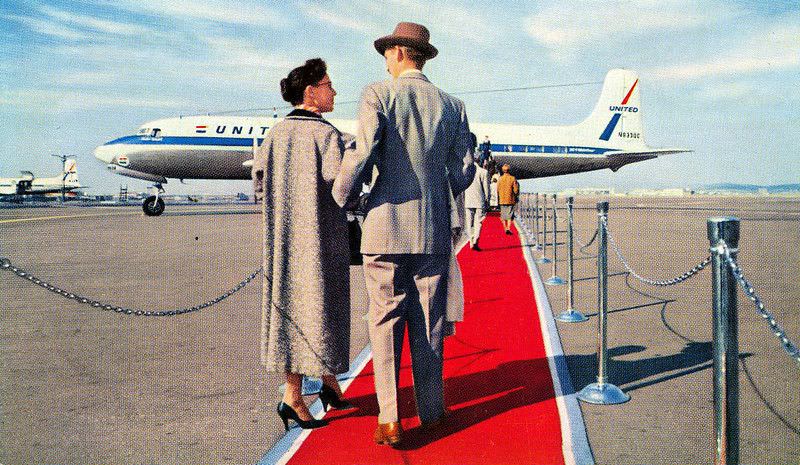
#30 United Airlines, 1950s
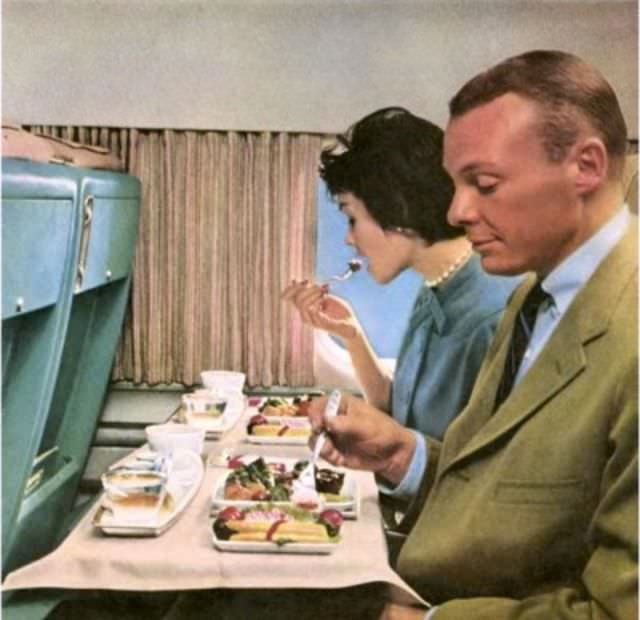
#31 United Airlines, 1950s
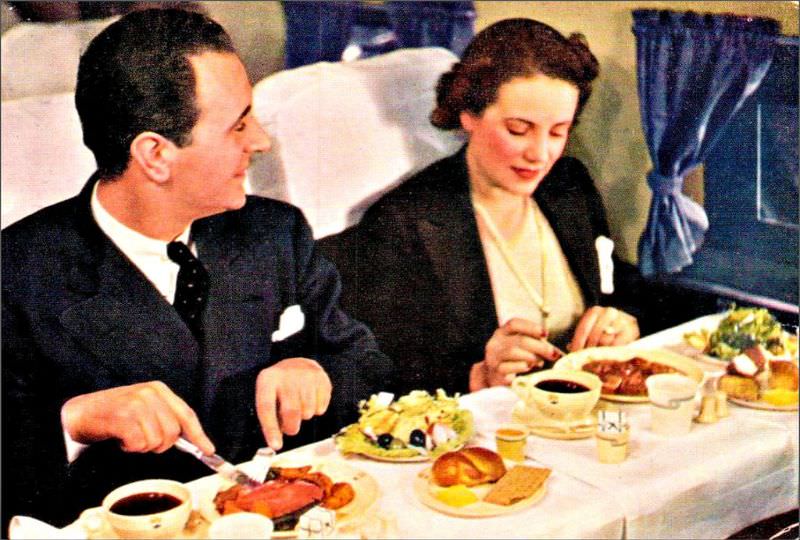
#32 Western Airlines, 1950s
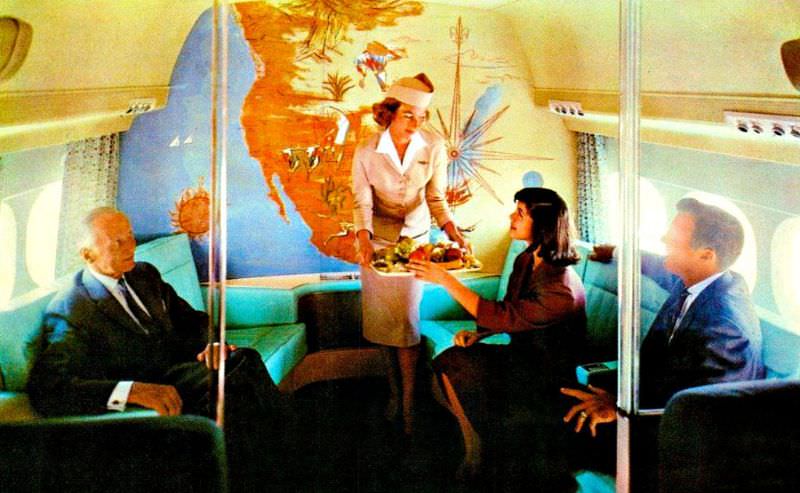
#49 An air steward serves a plate of grapes to a female passenger from a basket of fruit on a Bristol Britannia medium to long range airliner in October 1956.
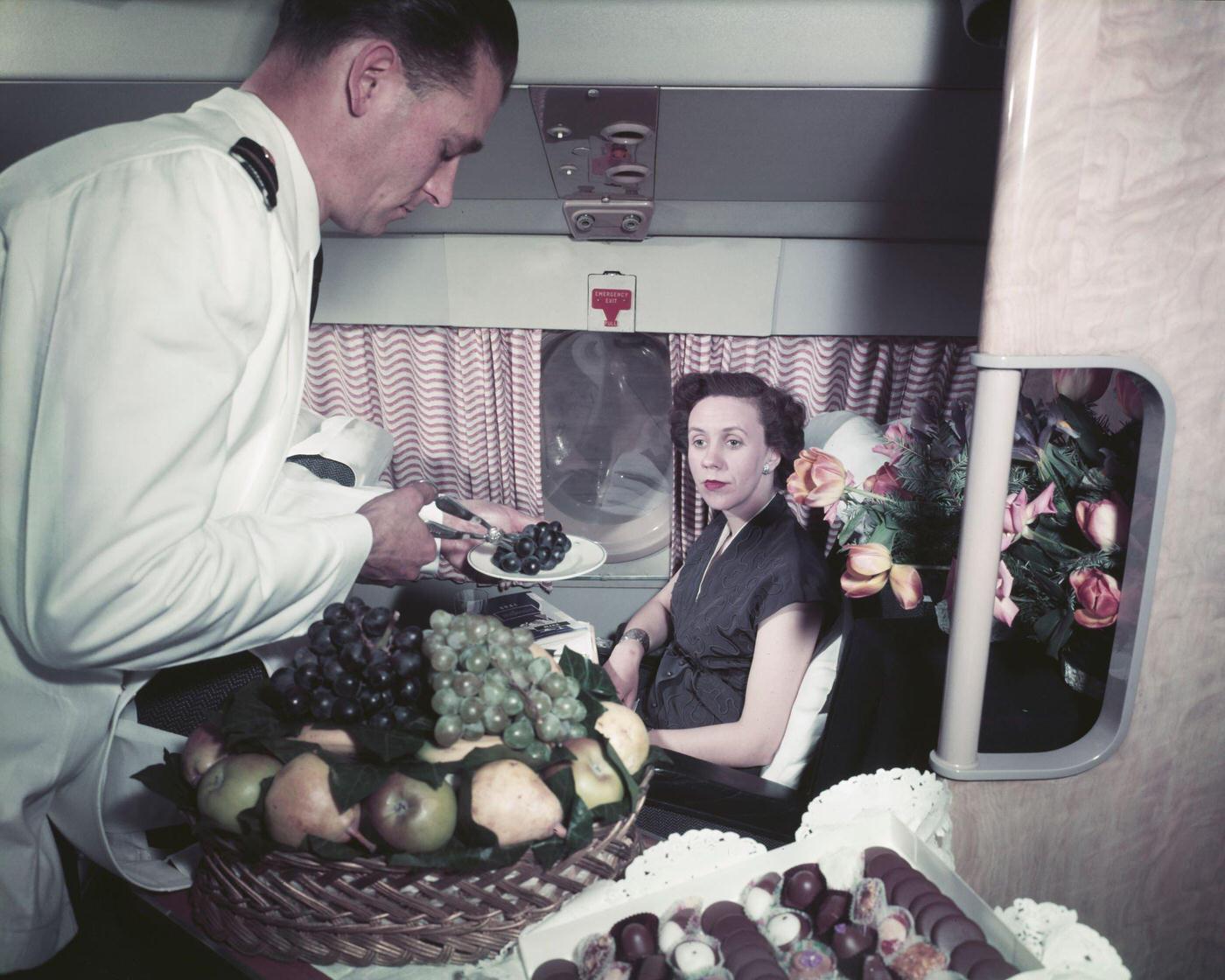
#50 Passengers board BOAC’s new Britannia propellerturbine airliner GANBI at London Airport, bound for Johannesburg, on 1st February 1957.
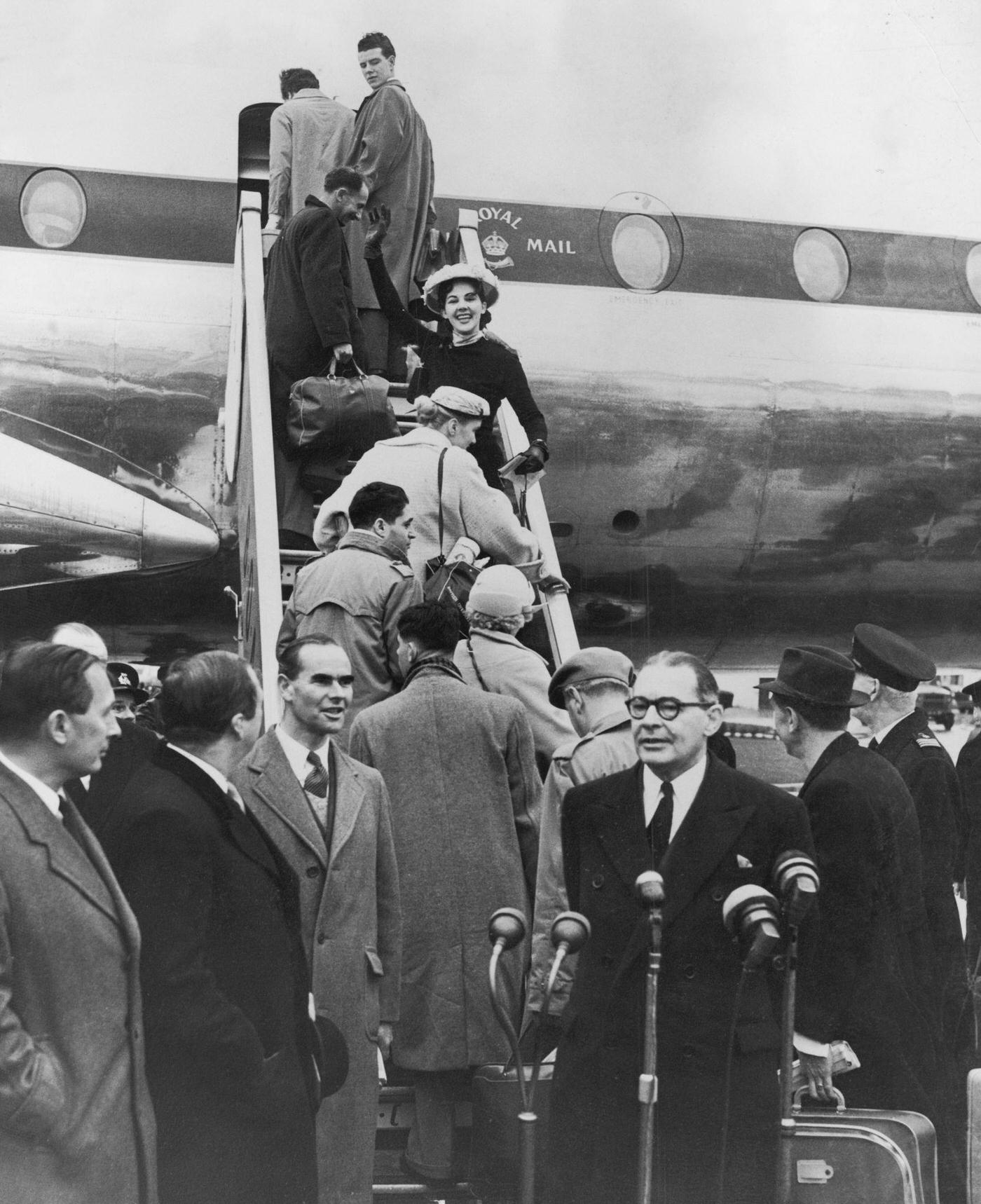
#51 Trainee BOAC cabin crew members simulate being passengers in a replica of a Hermes aircraft during their training near Heston Airport, Middlesex, in 1958.
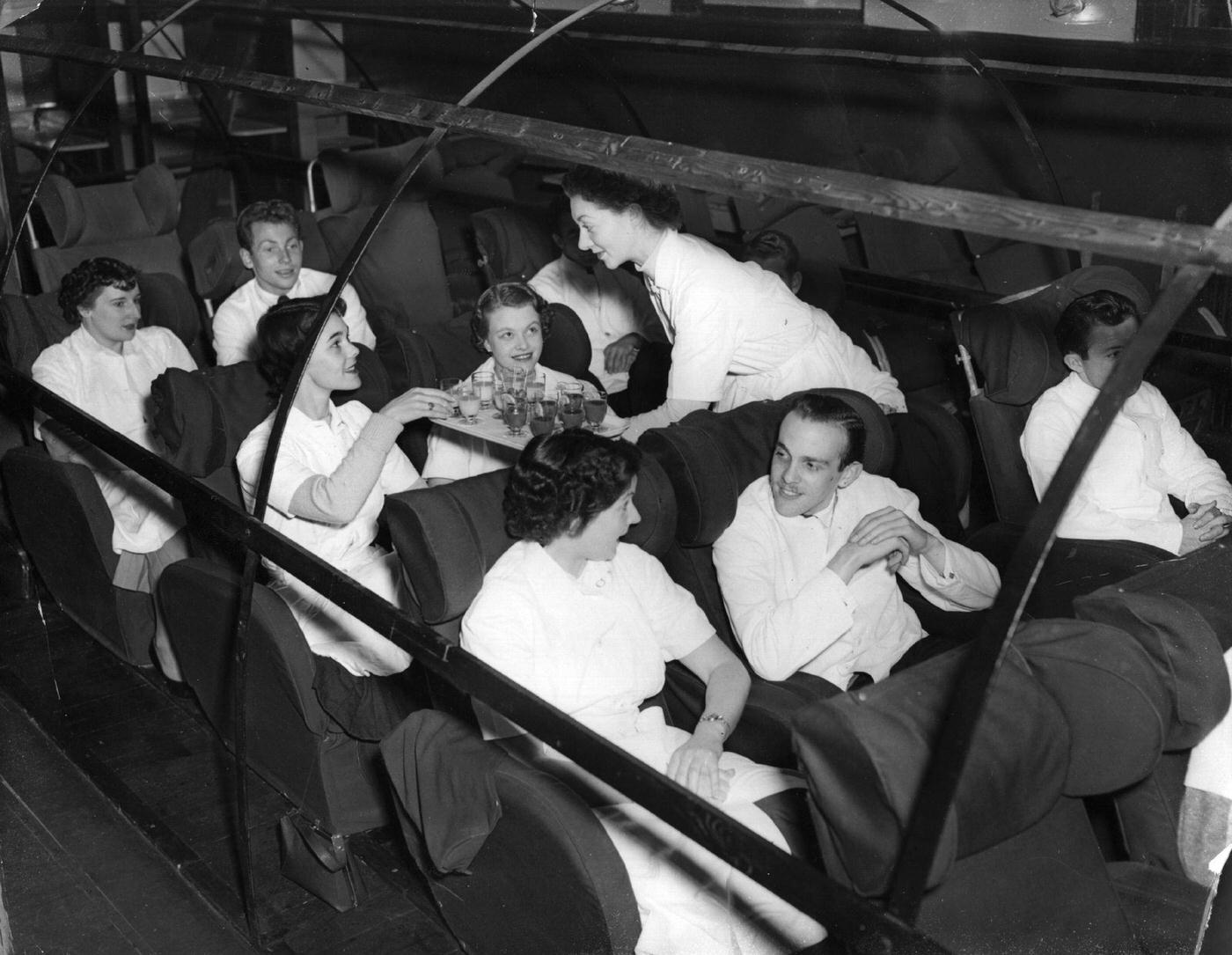
#52 Two air hostesses welcome a passenger boarding a Swiss Air aircraft at London Airport in the 1950s.
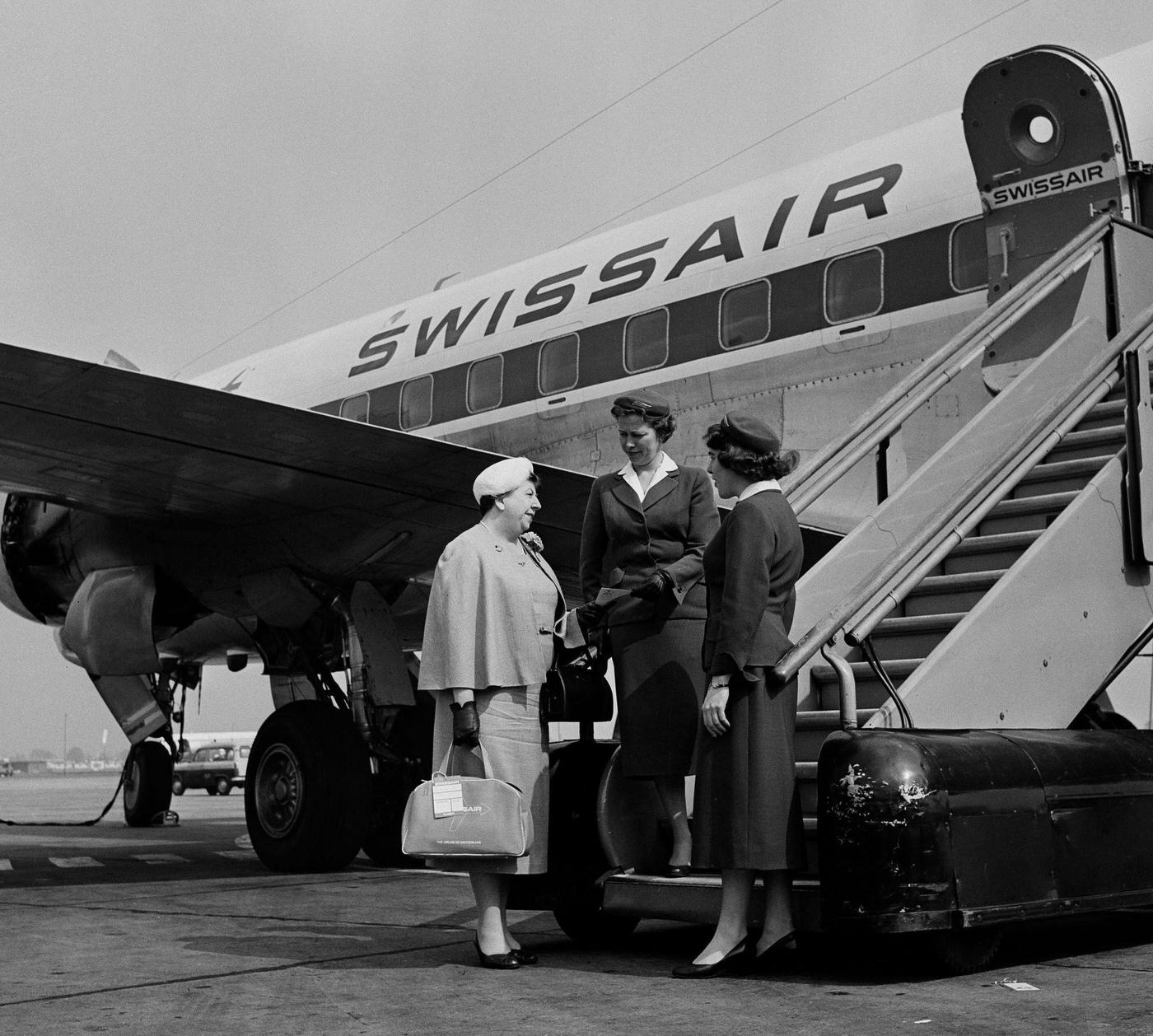
#53 Passengers relax on a flight in 1950.
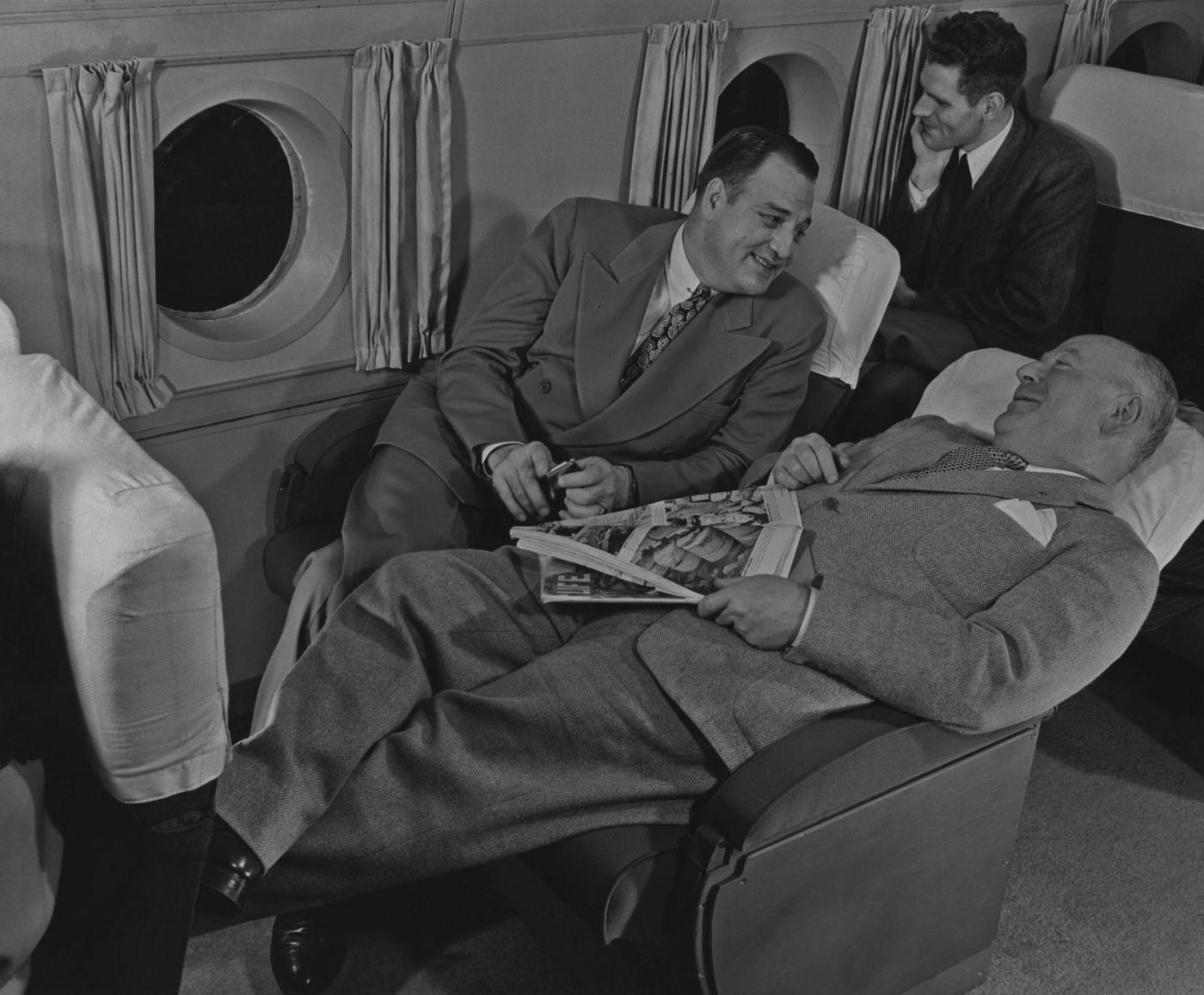
#54 The flight crew reviews the passenger list of a British West Indian Airlines plane at Piarco International Airport in Piarco, Trinidad, British West Indies, in 1952.
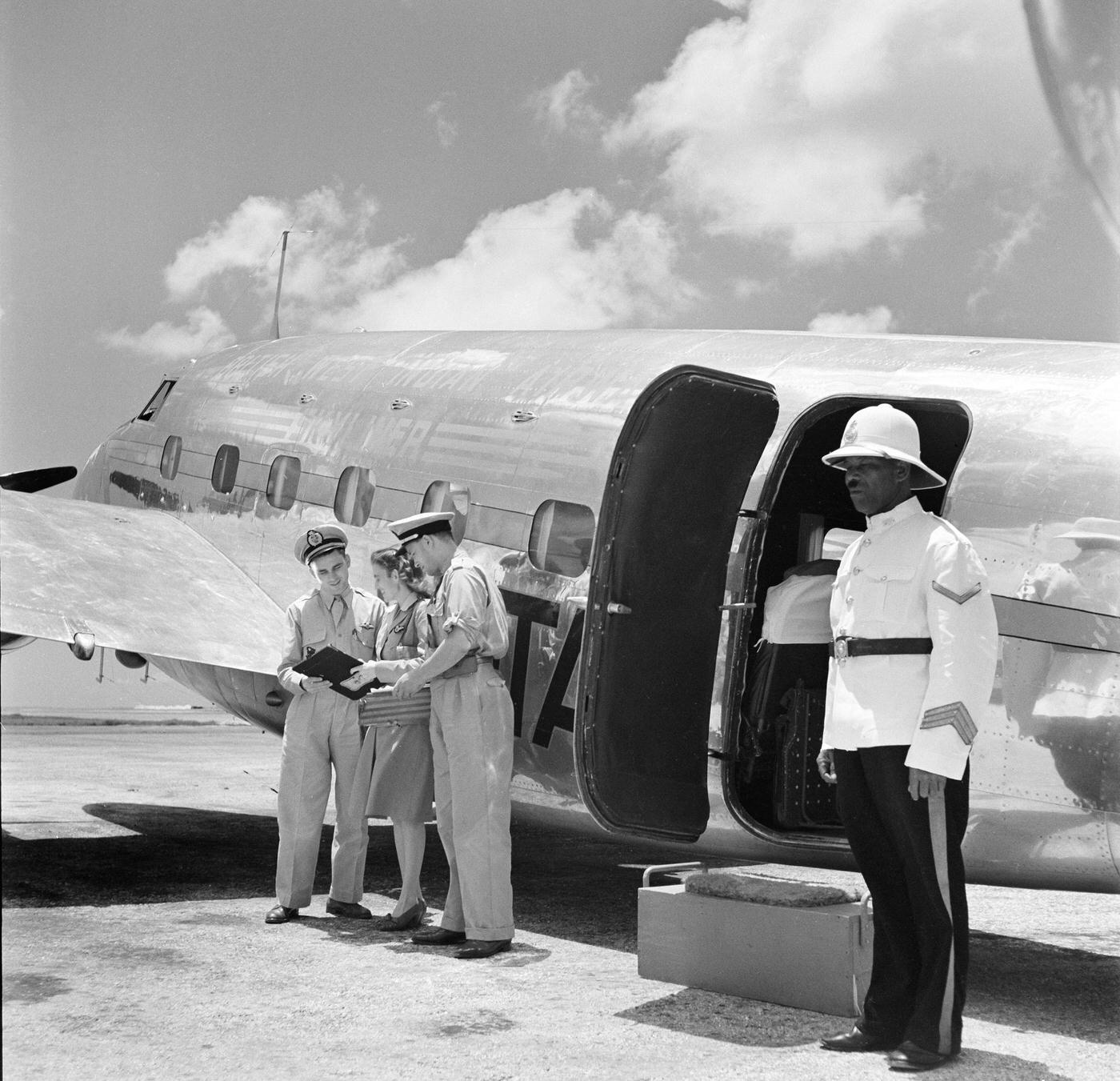
#55 A Panagraoperated passenger plane takes off from Cochabamba, Bolivia in 1955.
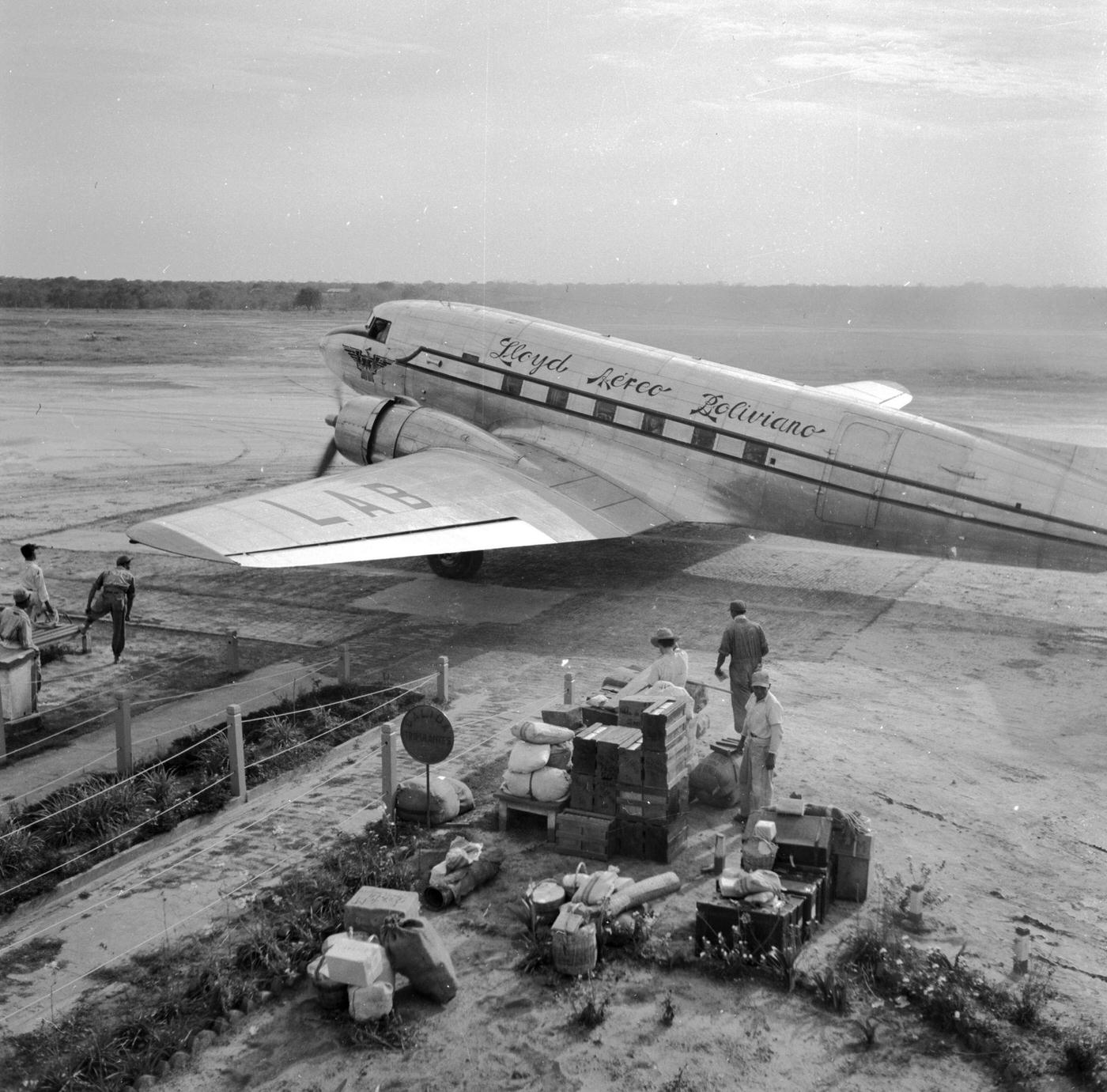
#56 Tourists raise Mexican sombreros before boarding a Canadian Pacific jet in Mexico in 1950.
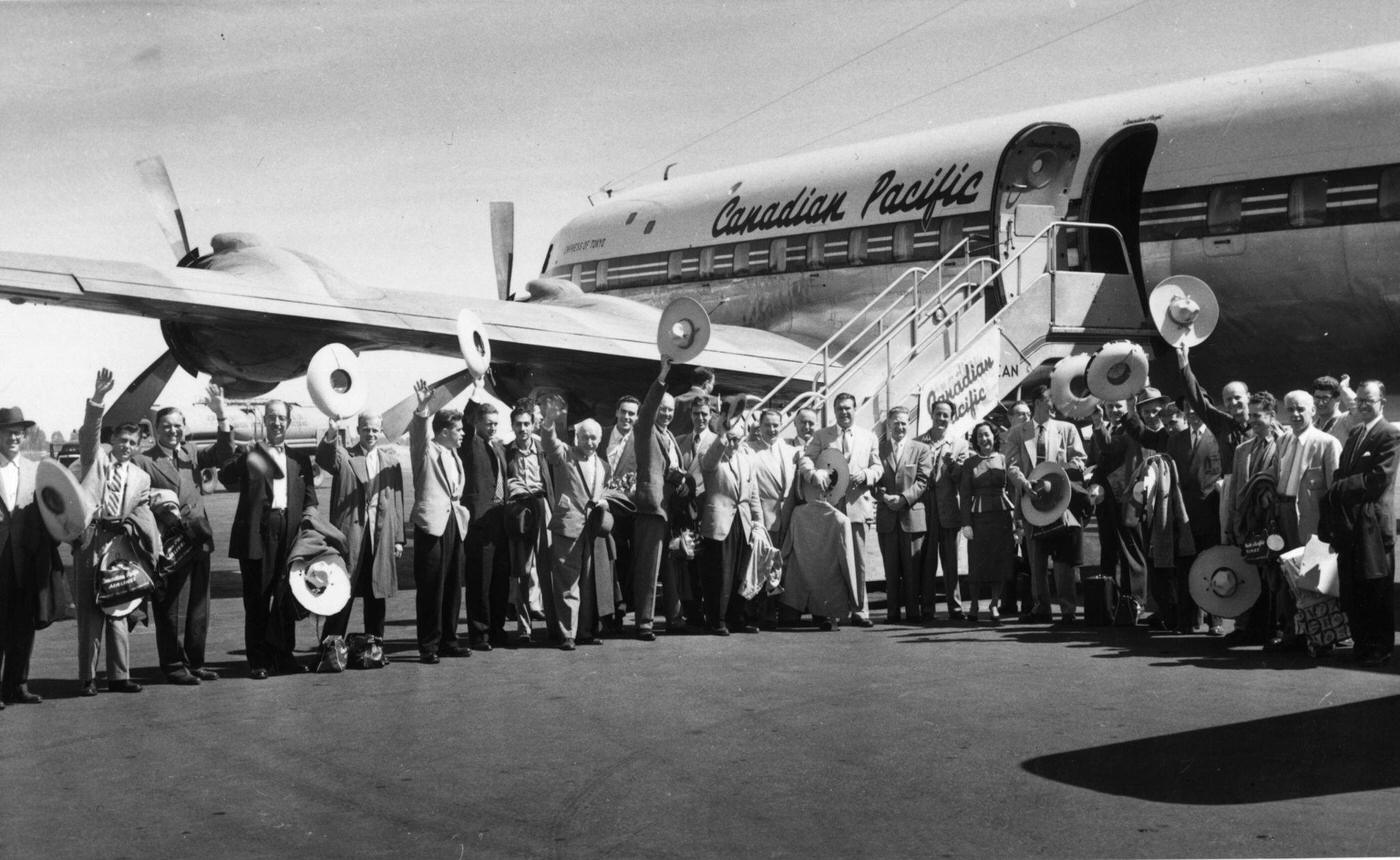
#57 Arthur Parkes, a television engineer, proves that aircraft can receive television transmissions up to a height of 12,000 feet, confounding the British Broadcasting Corporation in 1955.
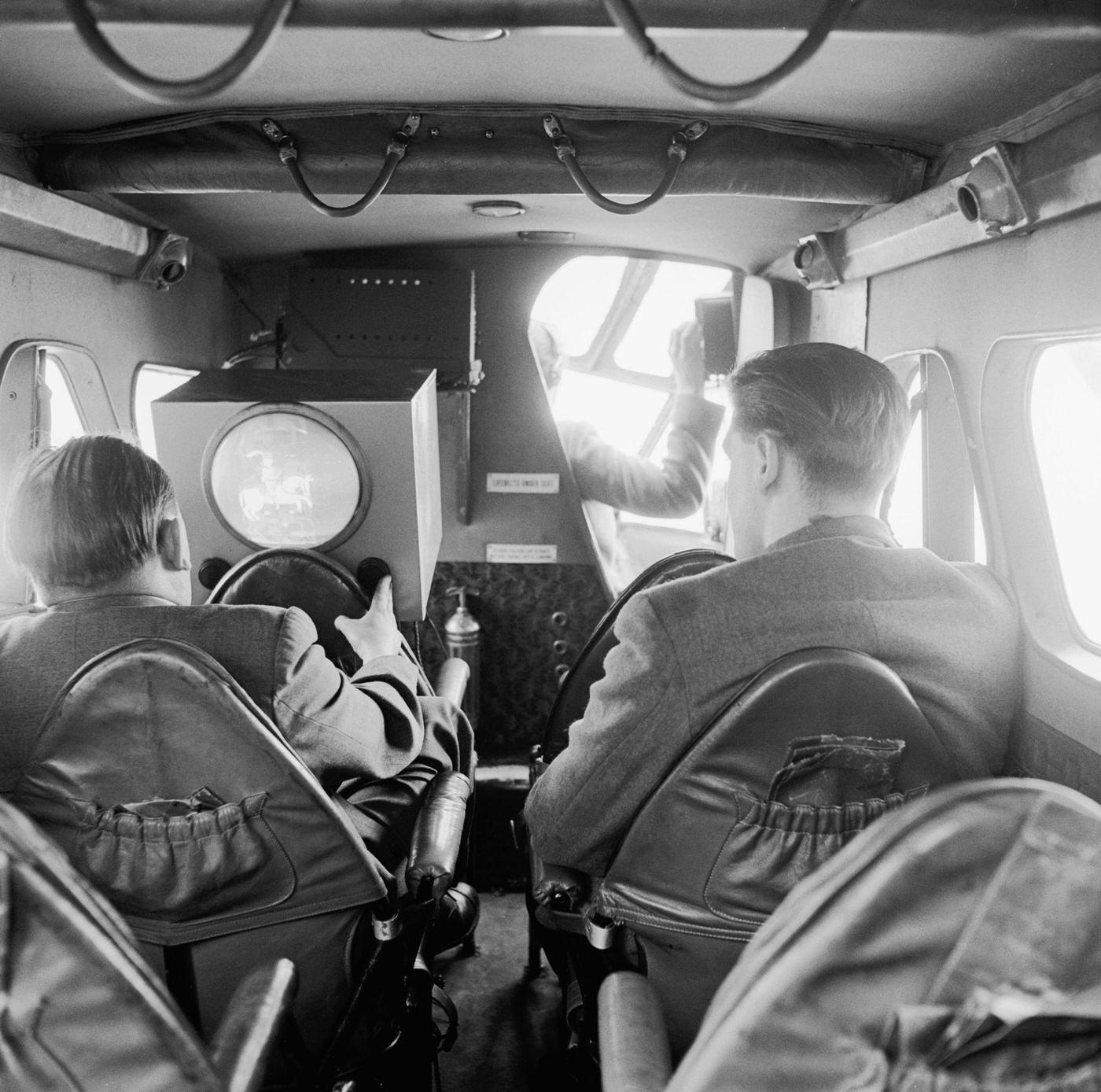
#58 A Concorde fuselage test is conducted on May 17th, 1954.
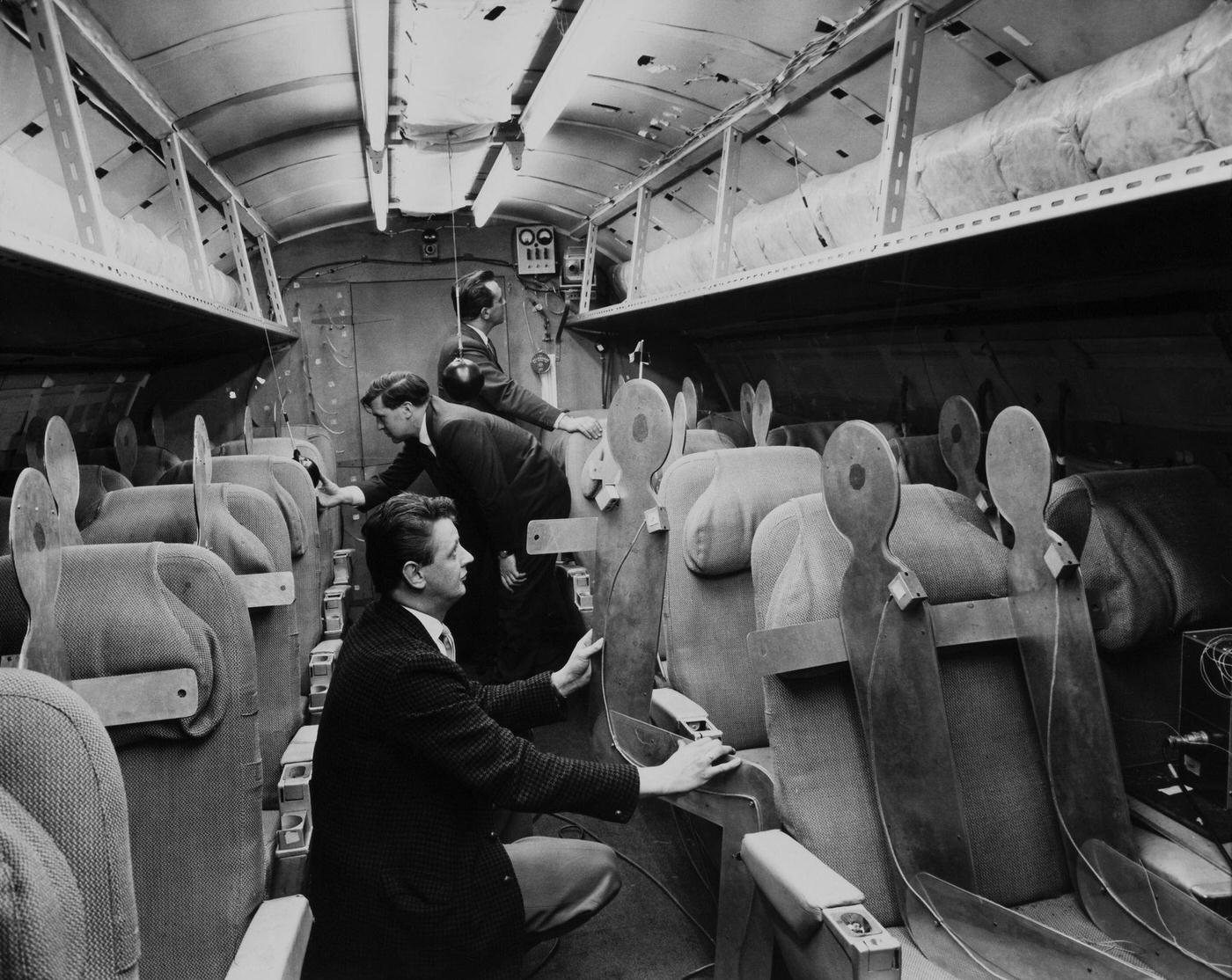
#59 A female soldier knits while traveling to a military base on a plane, as seen in a Cosmopolitan magazine photo.
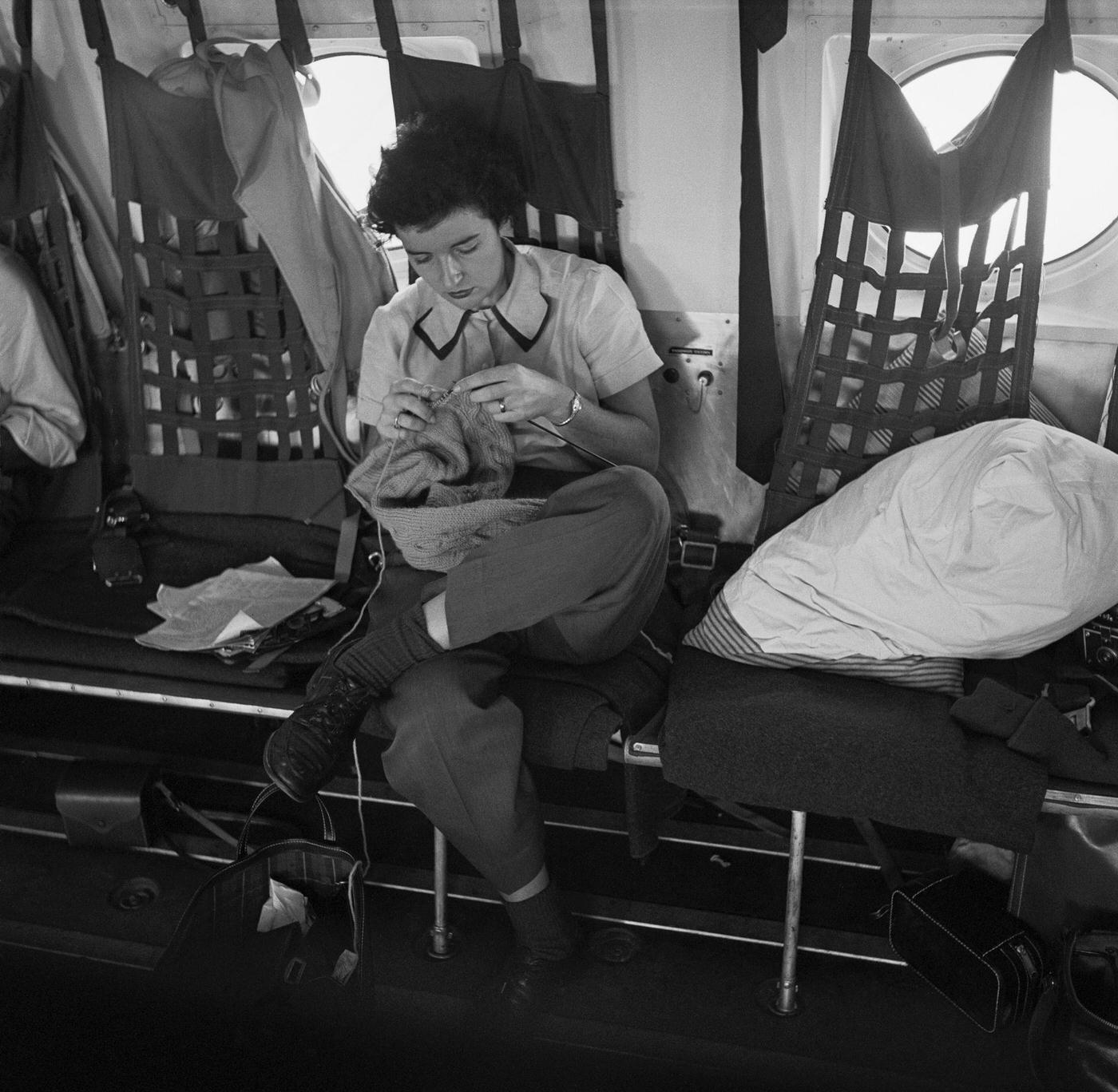
#60 A Comet airplane is pictured in 1950.
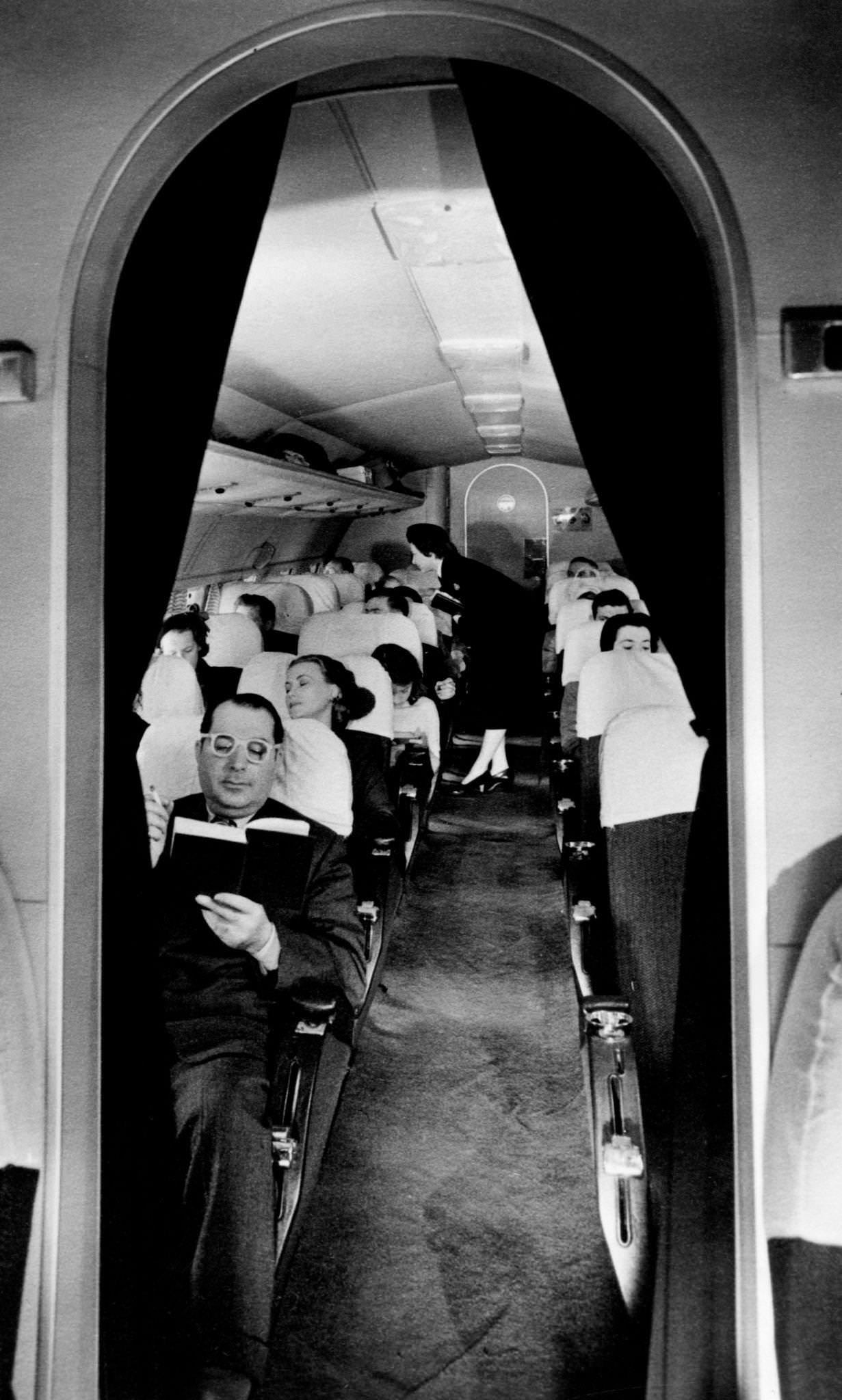
#61 A PAA Atlantic Division stewardess serves breakfast in bed to a female passenger during a transatlantic flight in 1952.
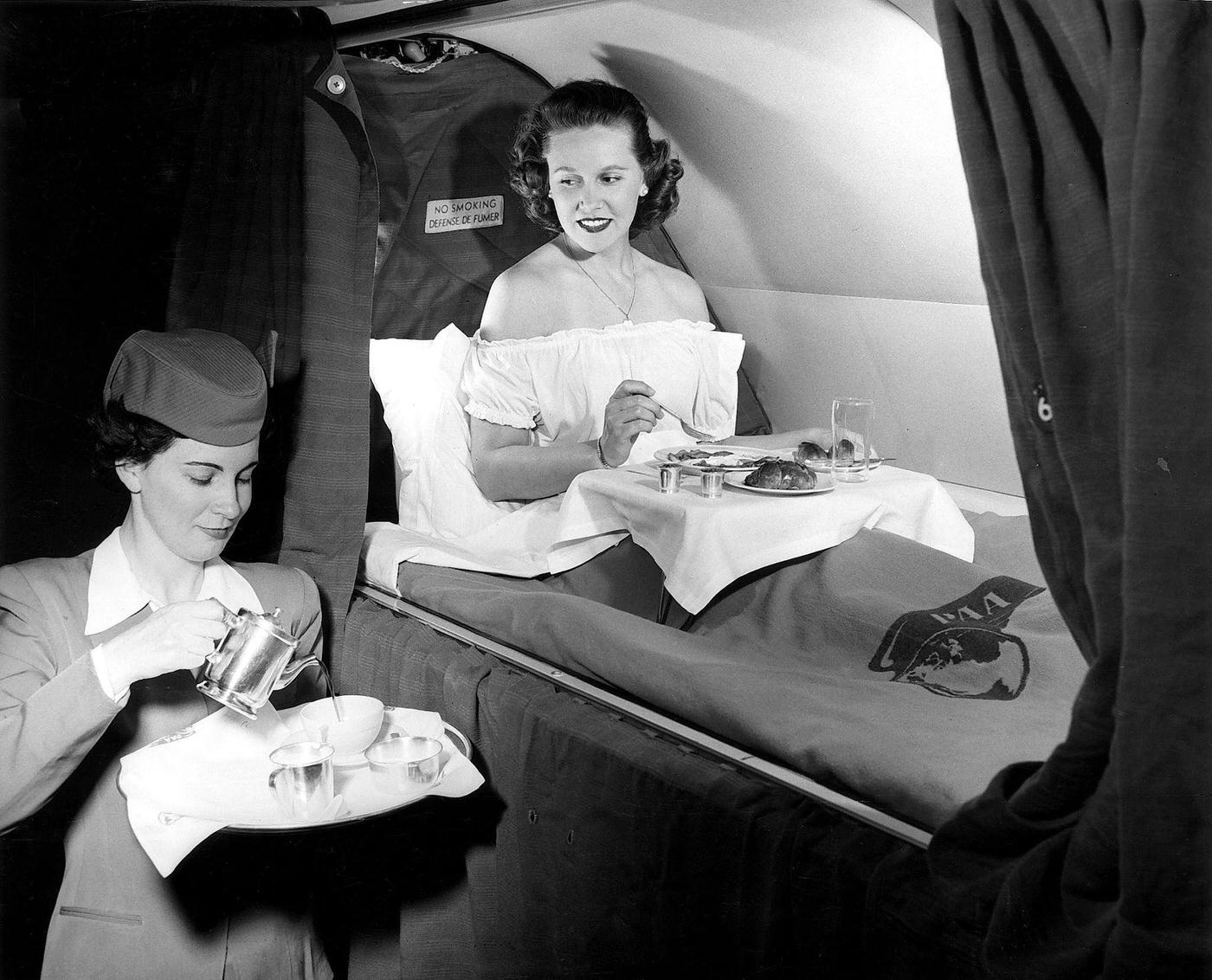
#62 A TWA pilot and stewardess greet passengers disembarking from a plane in the 1950s.
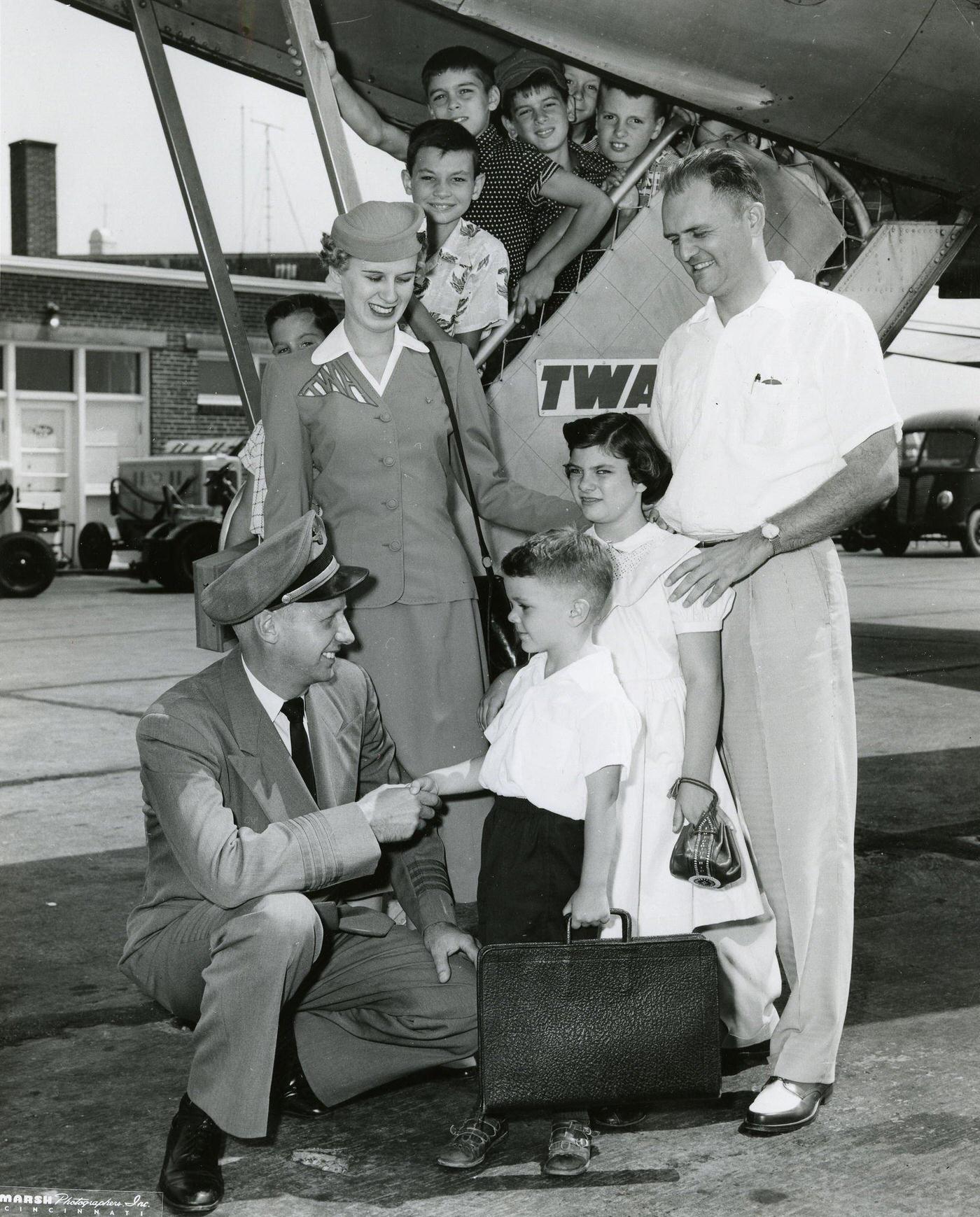
#63 Passengers and a stewardess are pictured aboard a TU114 airliner, which was the world’s largest at the time, in 1959.
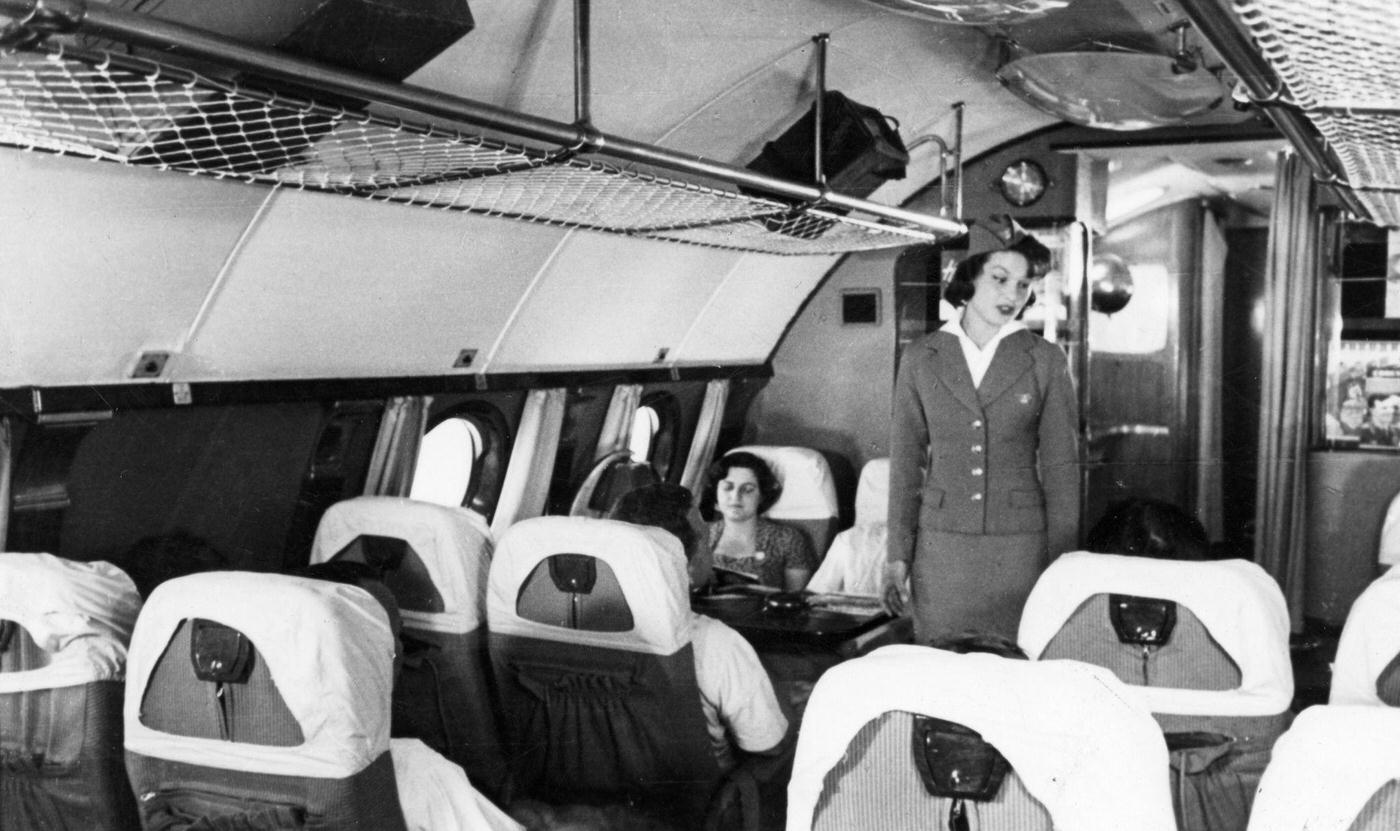
#64 A couple is seen aboard a British Overseas Airways Corporation plane in 1958.
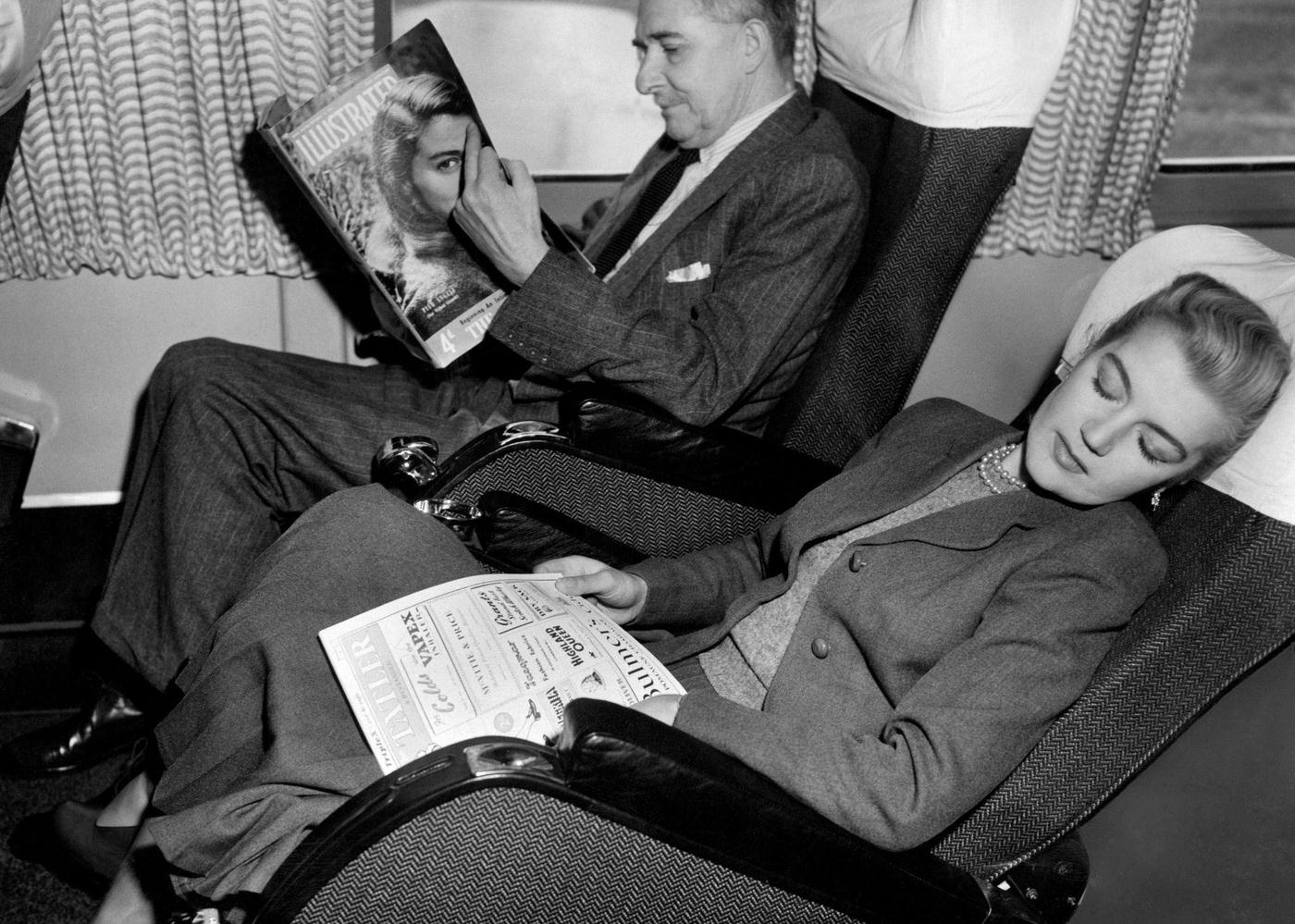
#65 A BOAC airline stewardess serves breakfast in bed to a passenger on a BOAC Speedbird Stratocruiser in 1952.
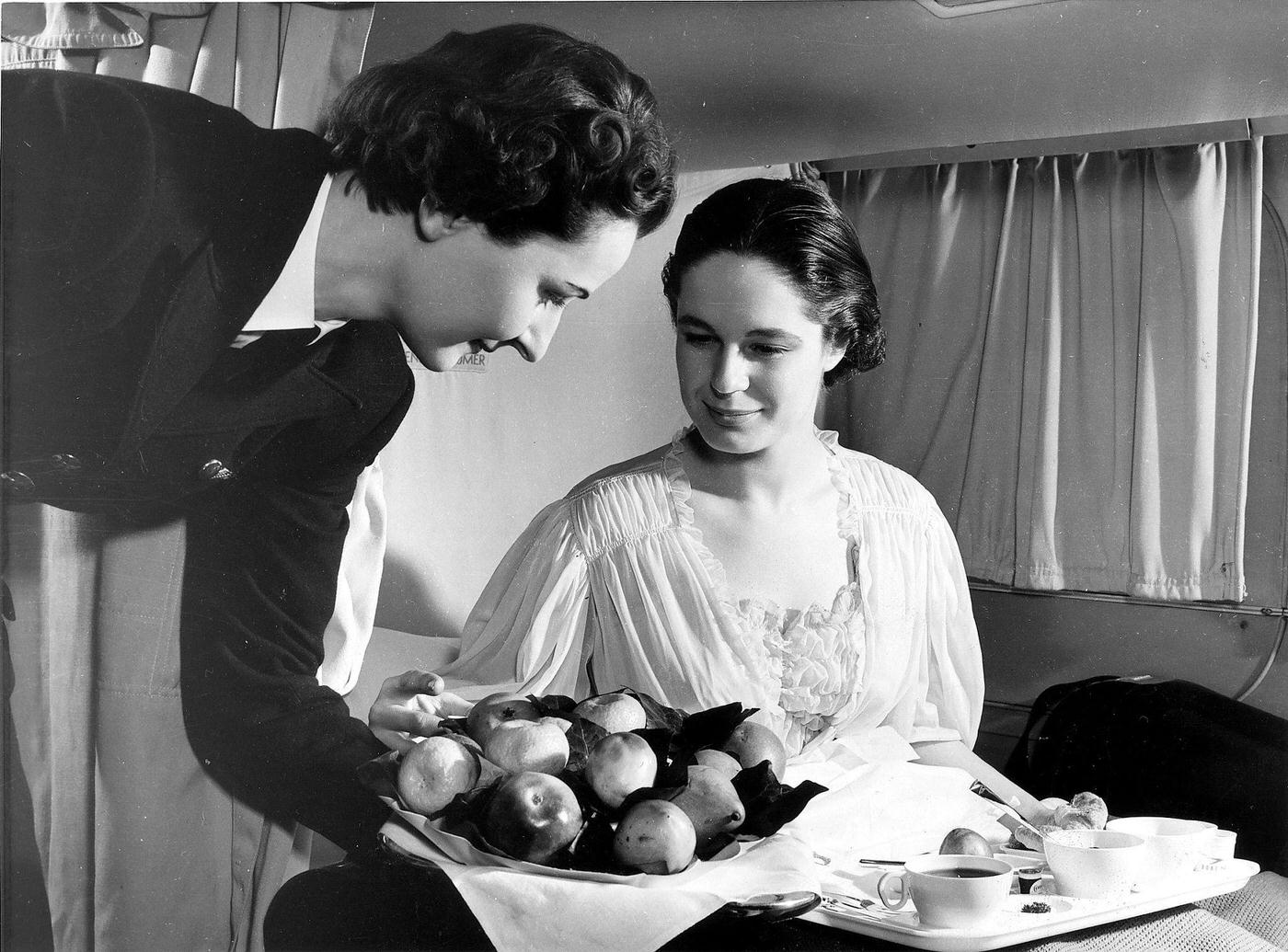
#66 A Bristol Superfreighter aircraft carries cars on crossChannel flights operated by Silver City Airways from their own airport in Ferryfield near the town of Lydd in 1955.
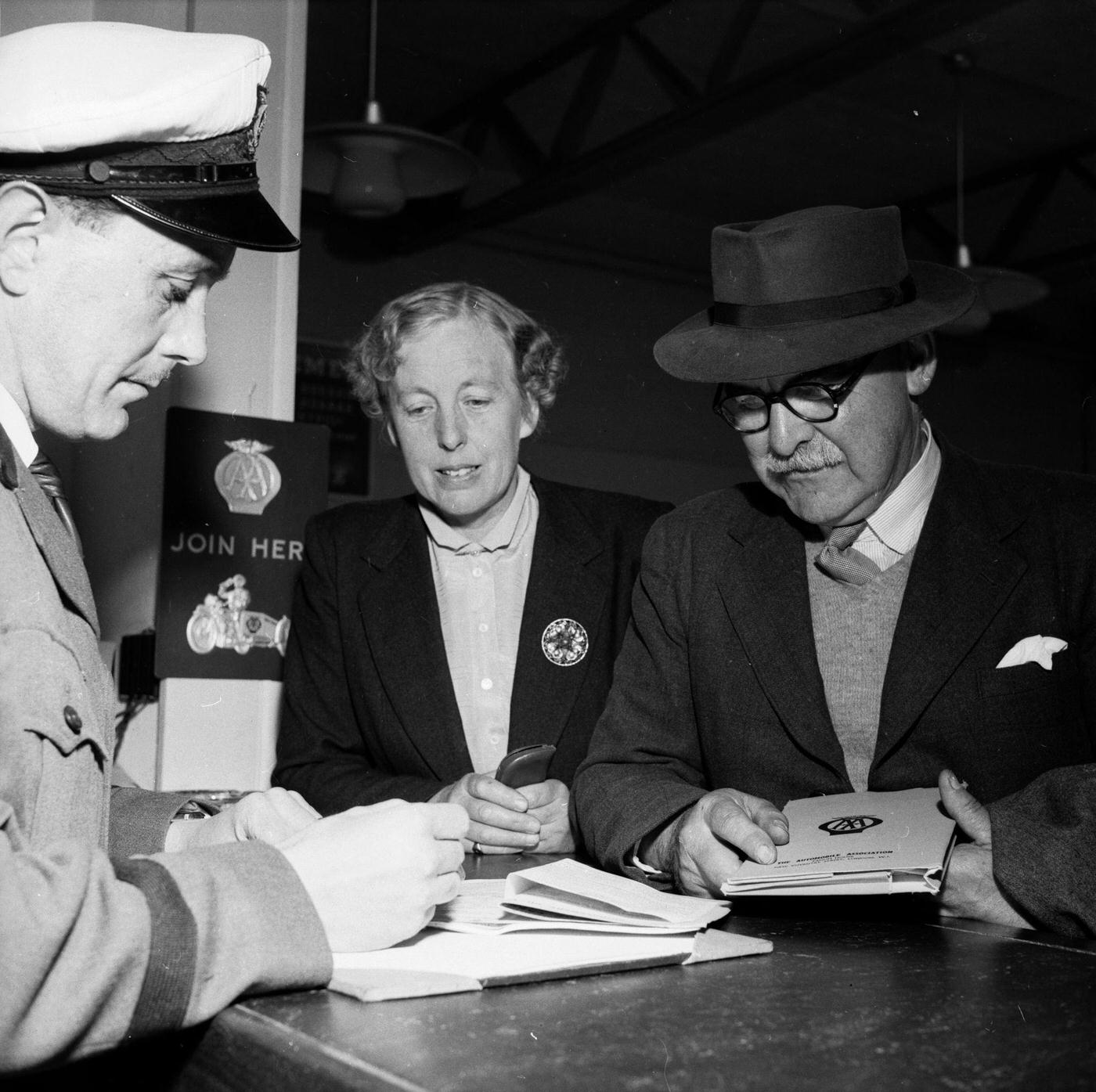
#67 Air hostesses are captured serving passengers on a plane in 1955.
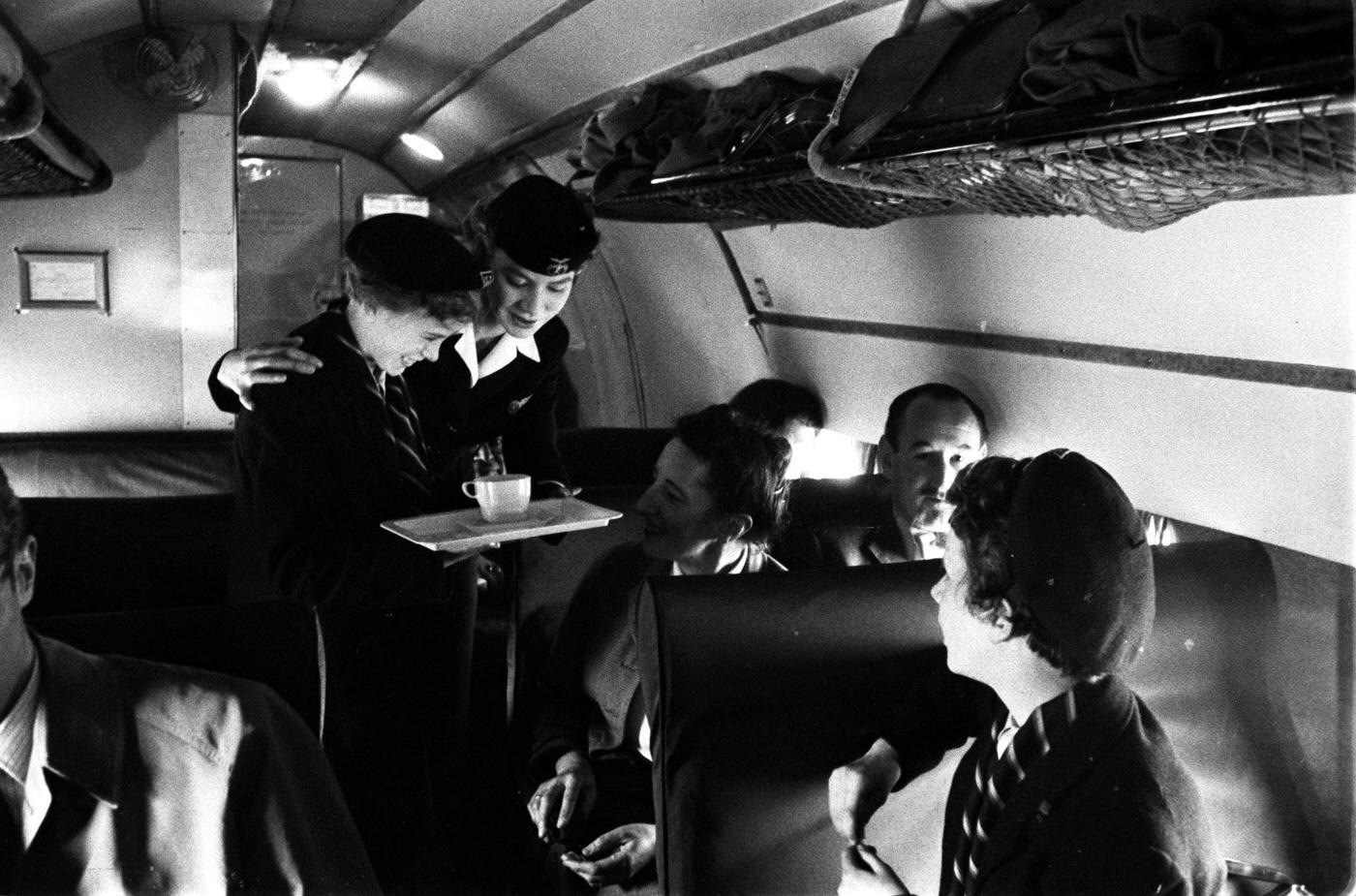
#68 Air hostess Irene Mallory is seen serving food to passengers on her trolley in 1955.
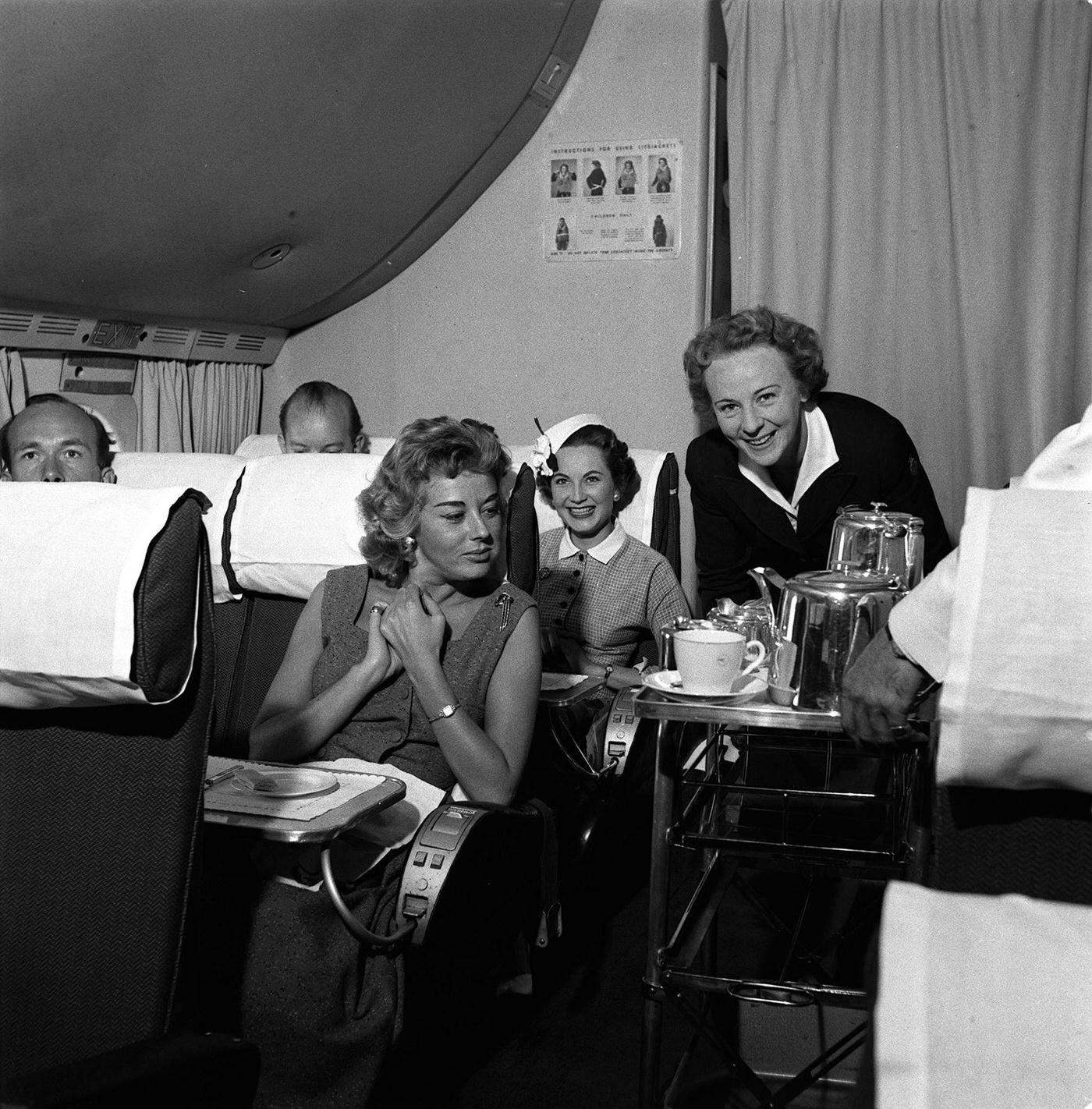
#69 Passengers are depicted on a transSiberian flight on board a TU104 airliner in July 1956.
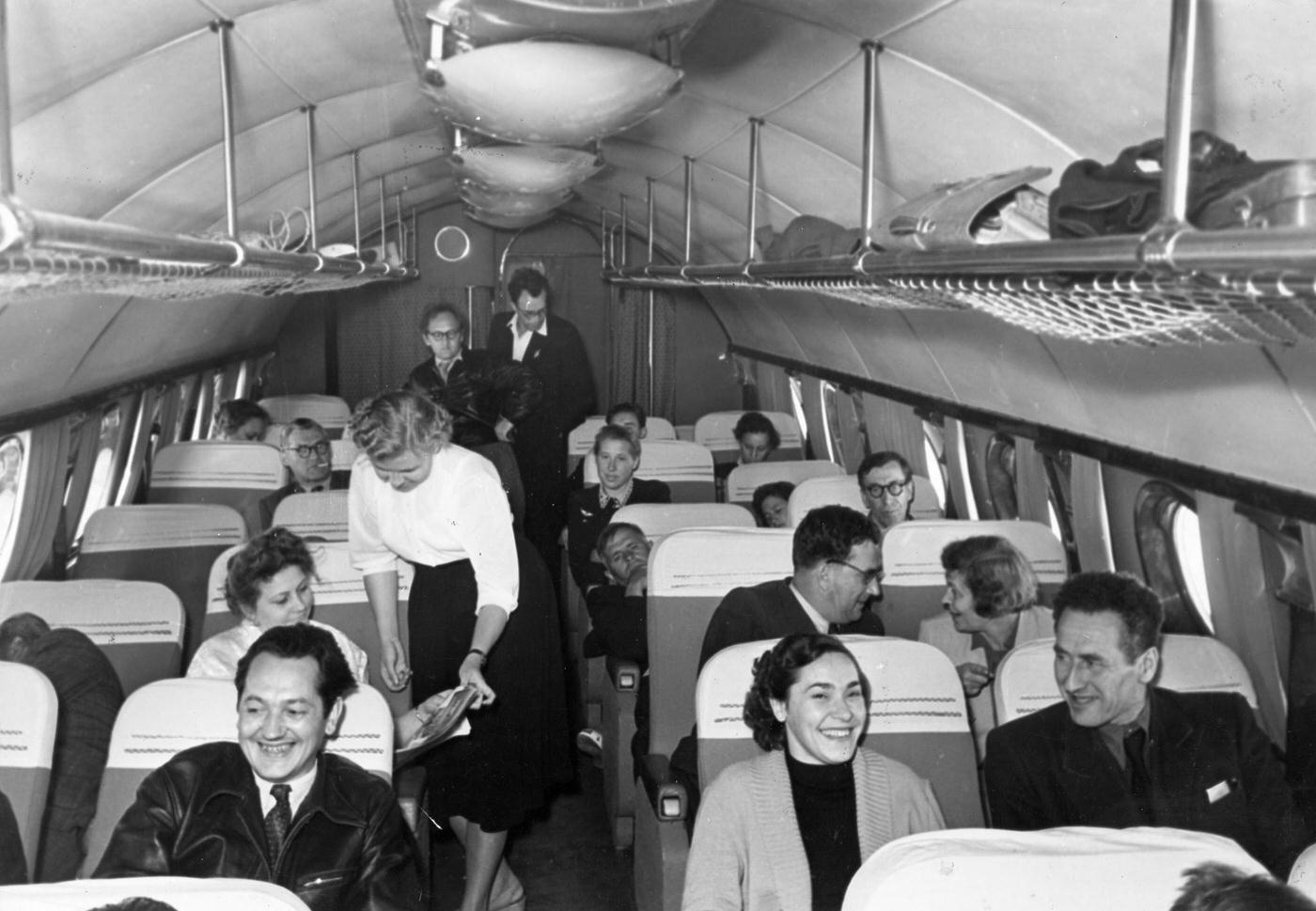
#70 A secretary from KLM is captured doing dictation on board a KLM passenger plane at Frankfurt Airport in January 1955.
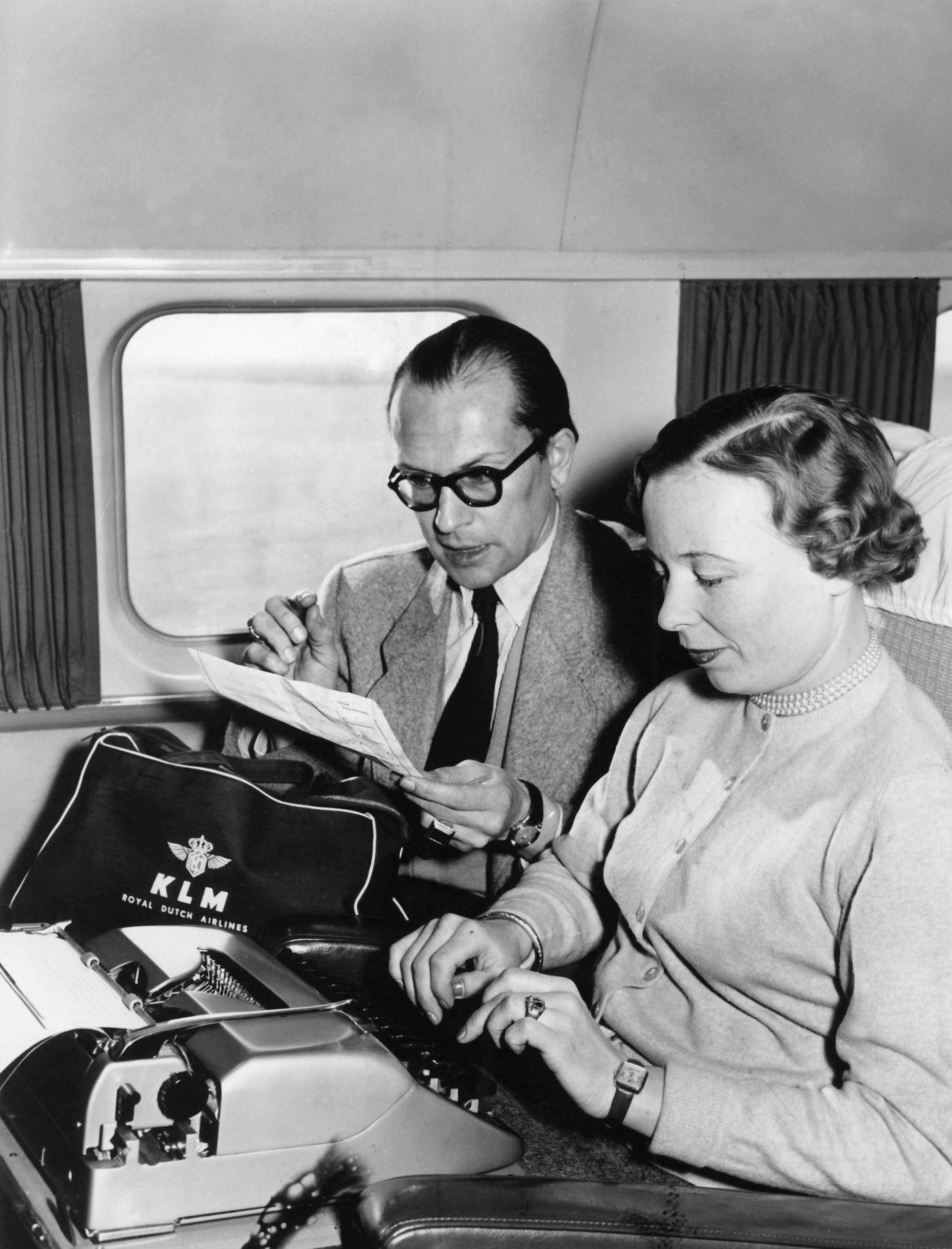
#71 The Basilica of St. Pius is inaugurated in Lourdes, France on March 25, 1958. The underground hall spans 14,000 square meters of concrete beneath the plaza.
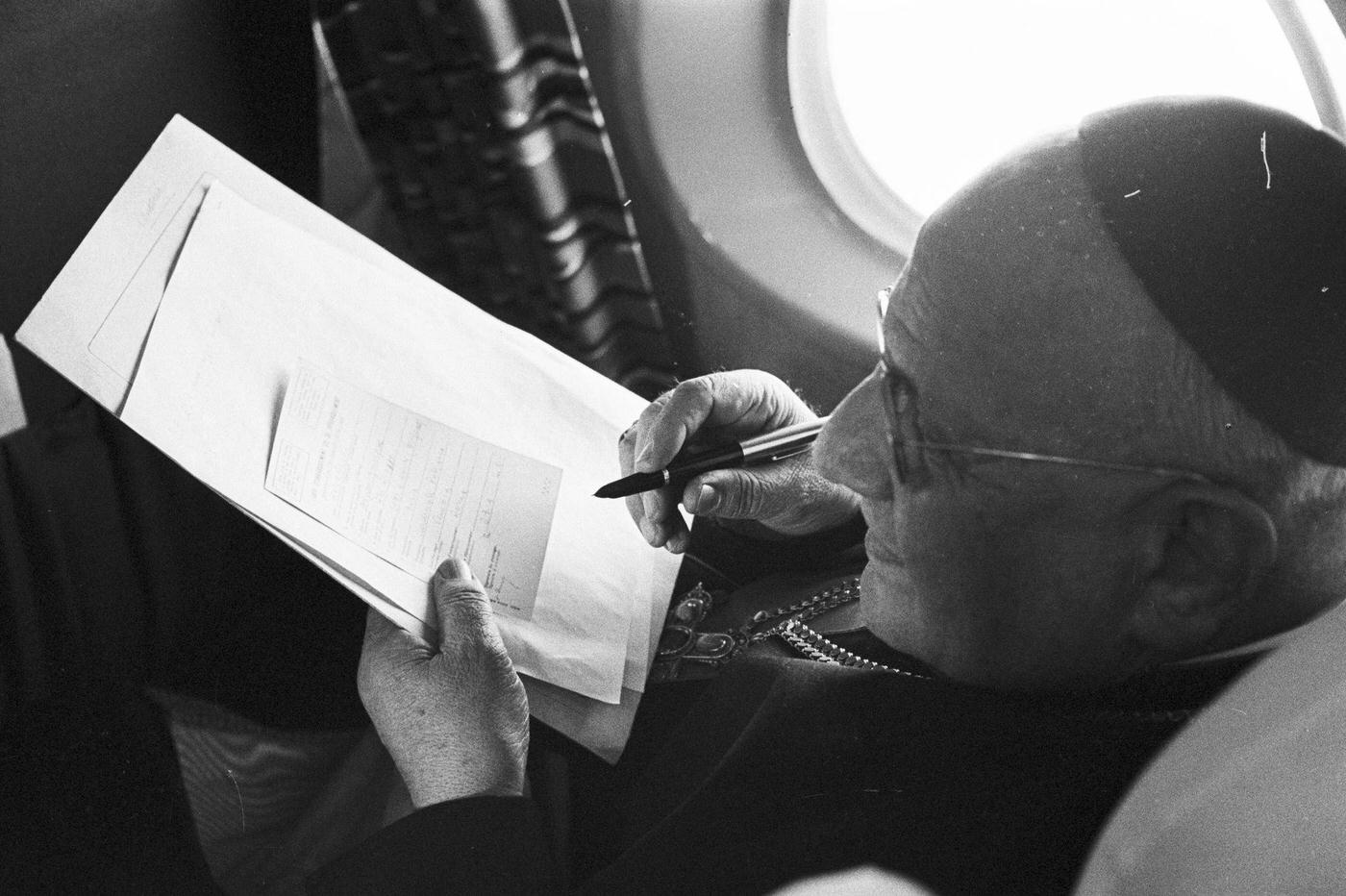
#72 A group of airline stewardesses pose inside the luxurious mockup of the Boeing Jet Stratoliner, which will enter service with airlines worldwide in 1959.
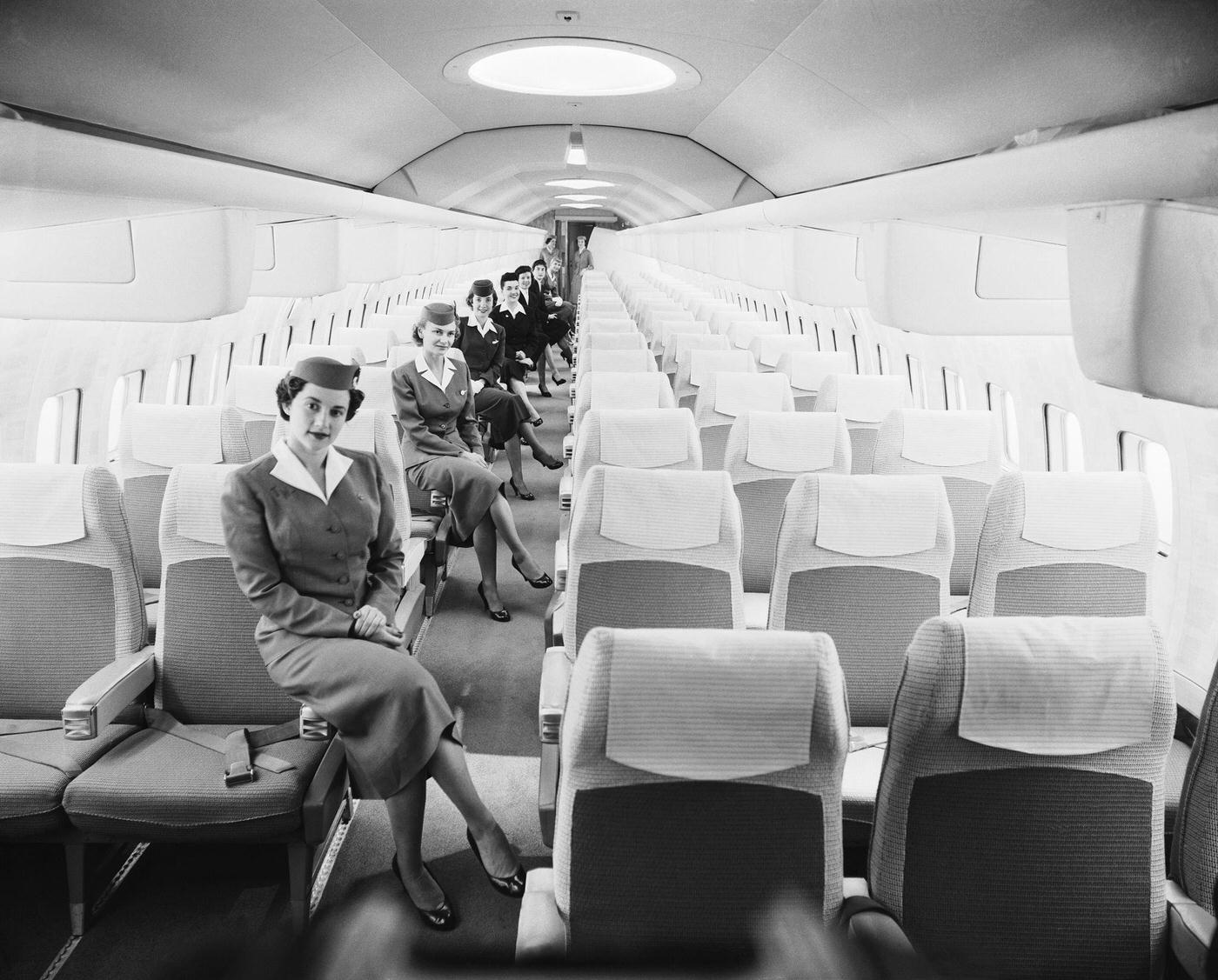
#73 Kentucky Colonel Ward Elmore, who is one of 25 people from the Laguna Honda Home in San Francisco, makes his first plane flight on August 22, 195?, and also celebrates his first 100 years.
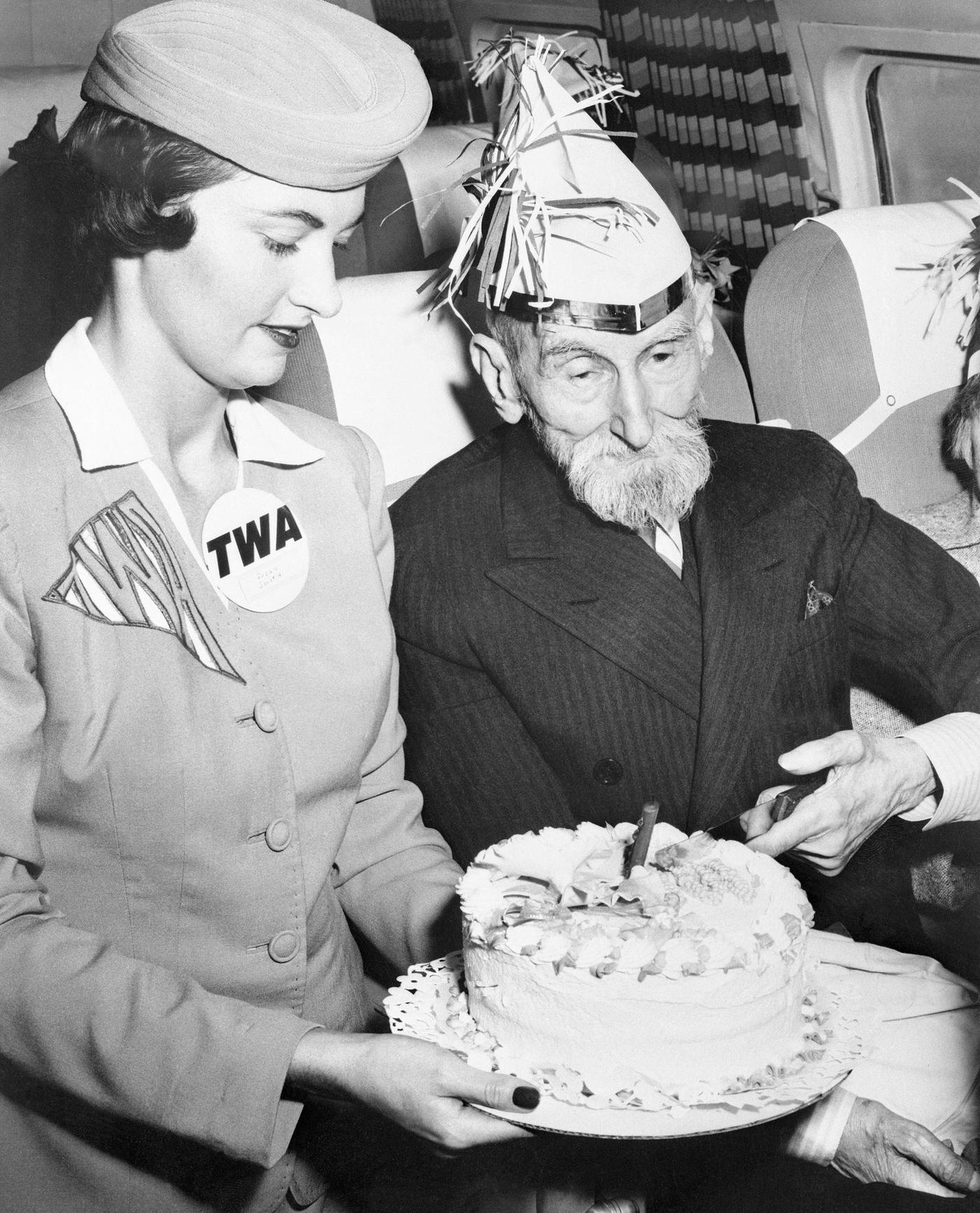
#74 In October 1956, a male air steward prepares a tray of food in the galley for passengers on board a Bristol Britannia medium to long range airliner.
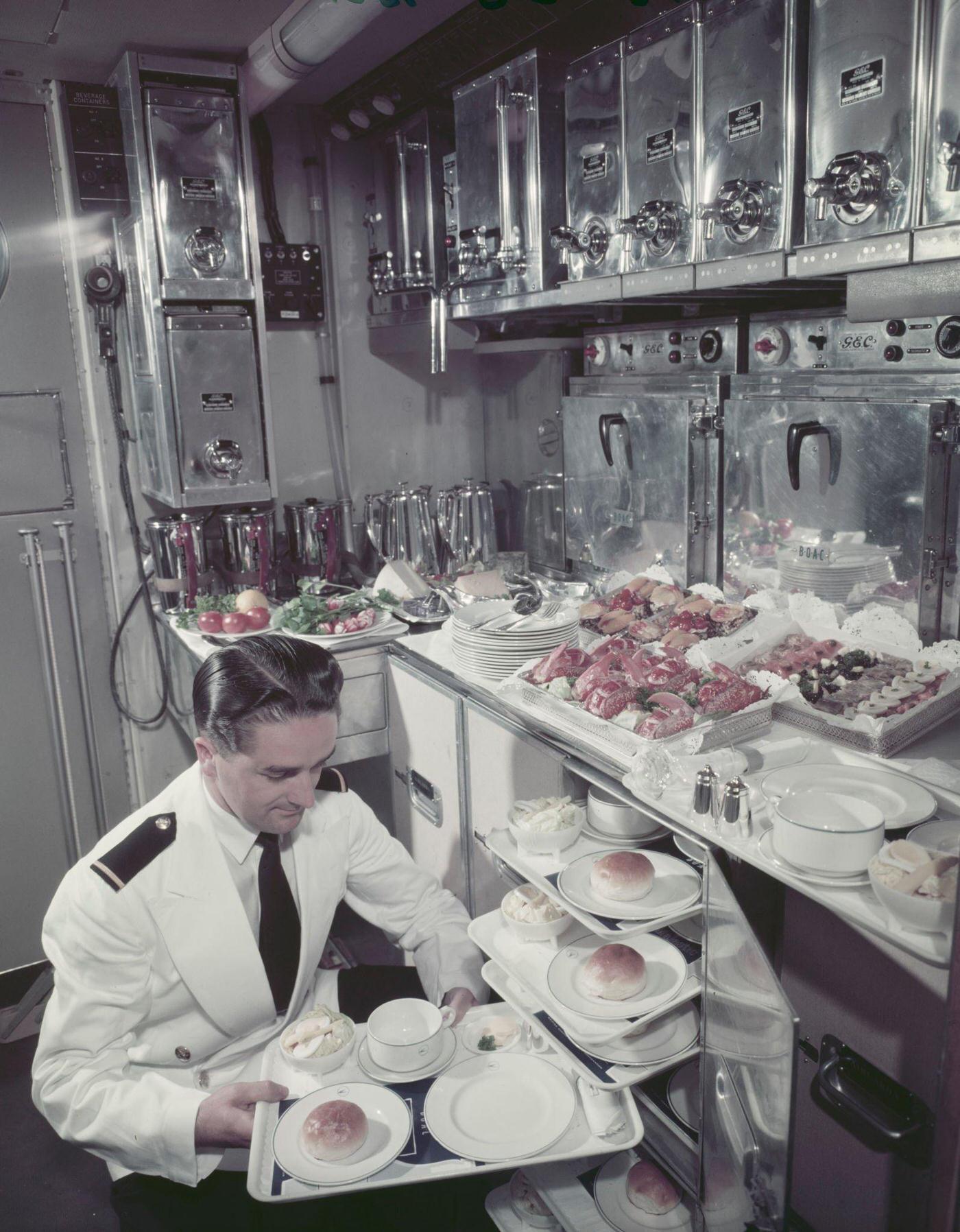
#75 Ginger Rogers, a famous screen actress, and her husband, French actor Jacques Bergerac, arrive at ParisOrly airport after flying from the United States.
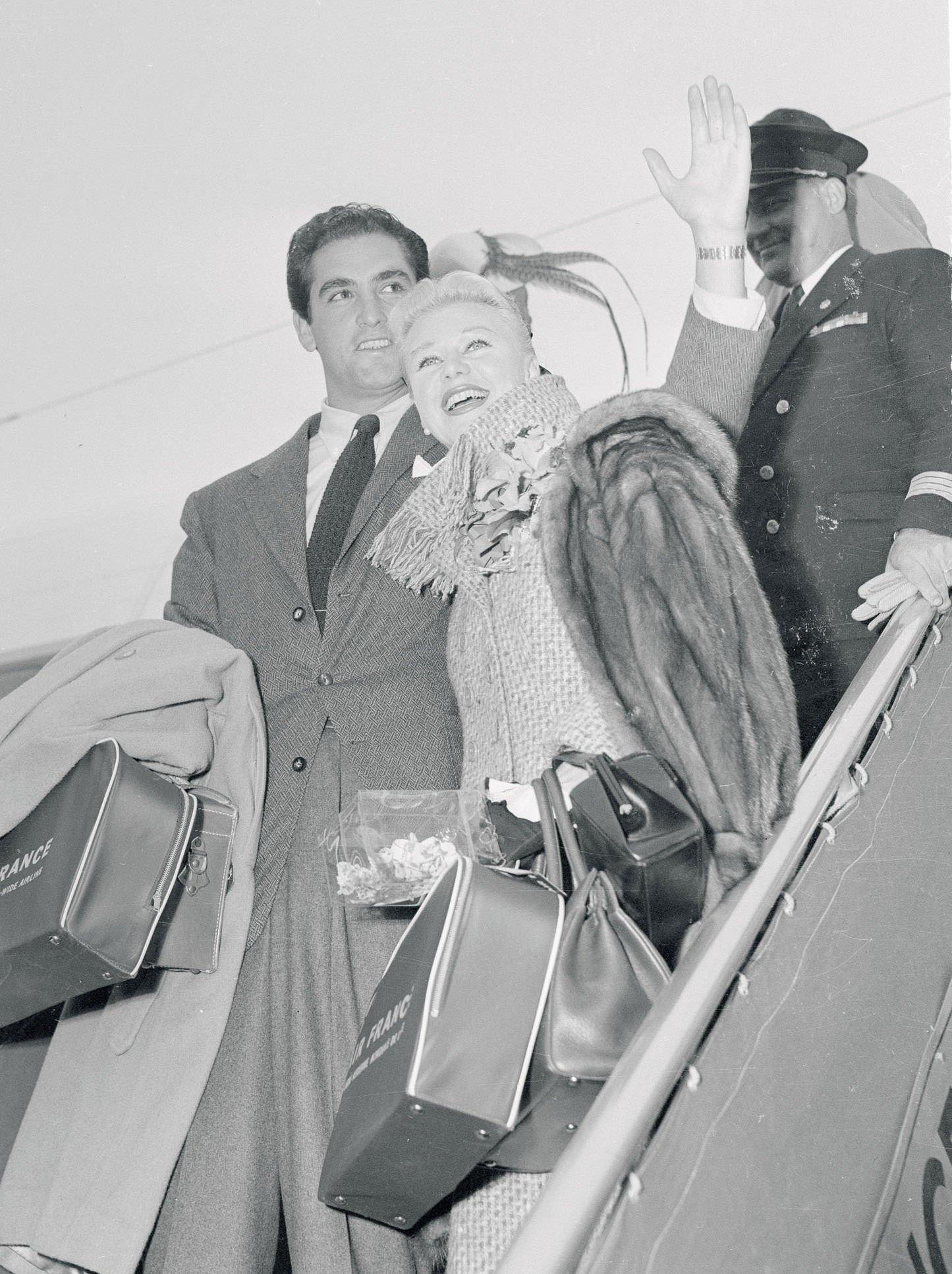
#76 The first passengers of the world’s inaugural jet service board their plane bound for Johannesburg, while nearby reporters capture the event.
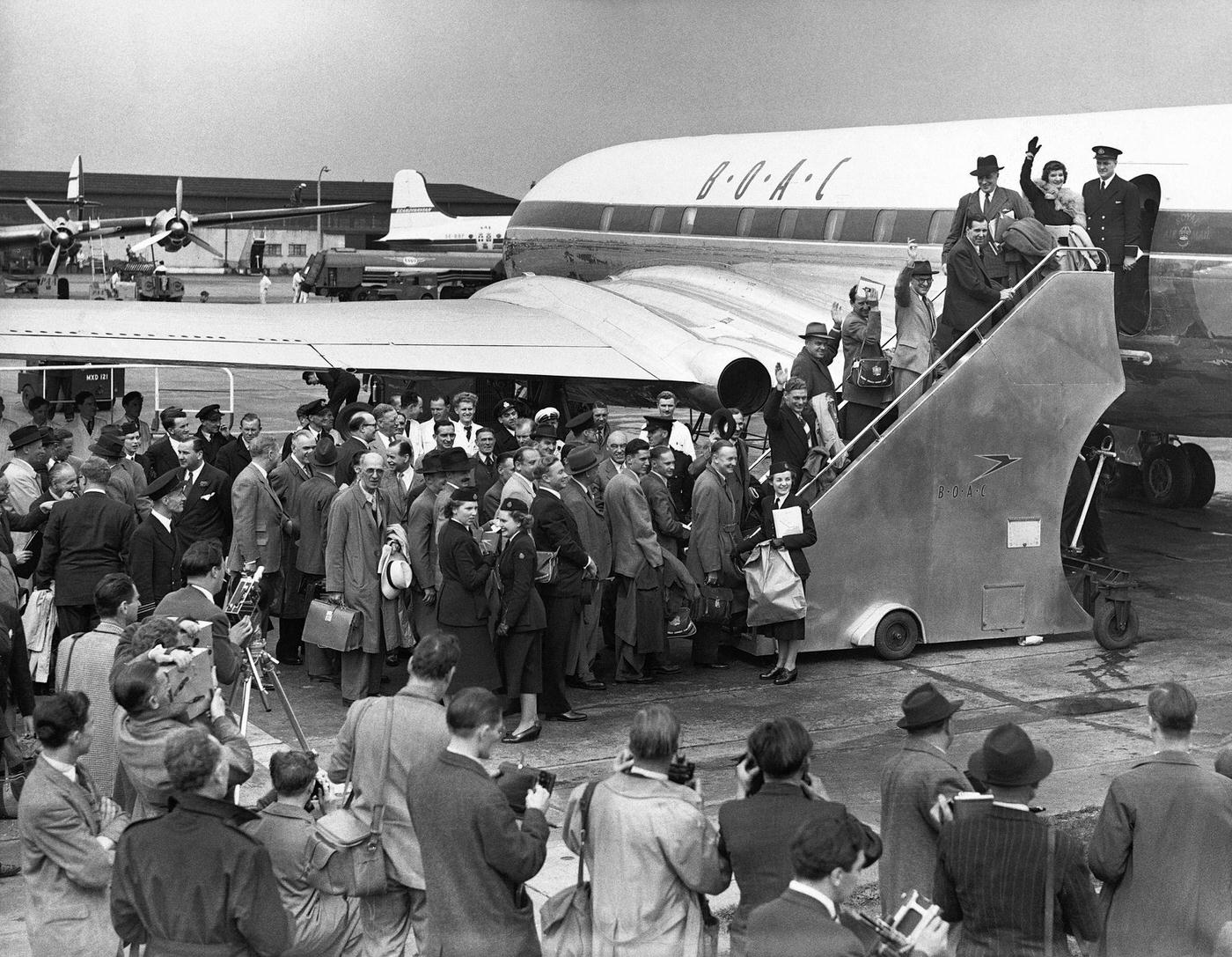
#77 Passengers get ready to nap on a Transocean Air Lines Boeing 377 Stratocruiser in the mid1950s. Transocean Air Lines was a pioneer discount airline that operated between 1946 and 1962.
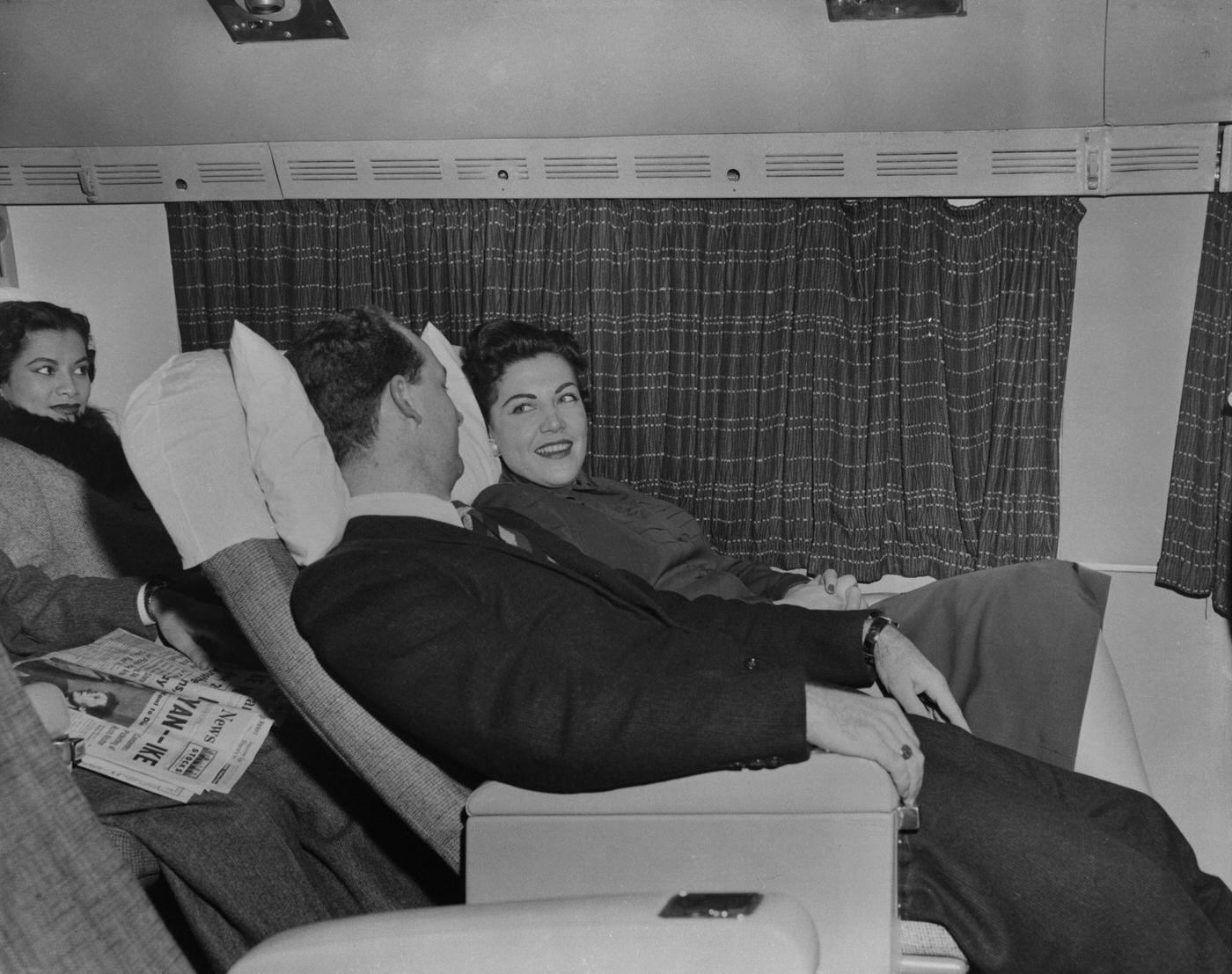
#78 Passengers are depicted on a Transocean Air Lines Boeing 377 Stratocruiser in the mid1950s.
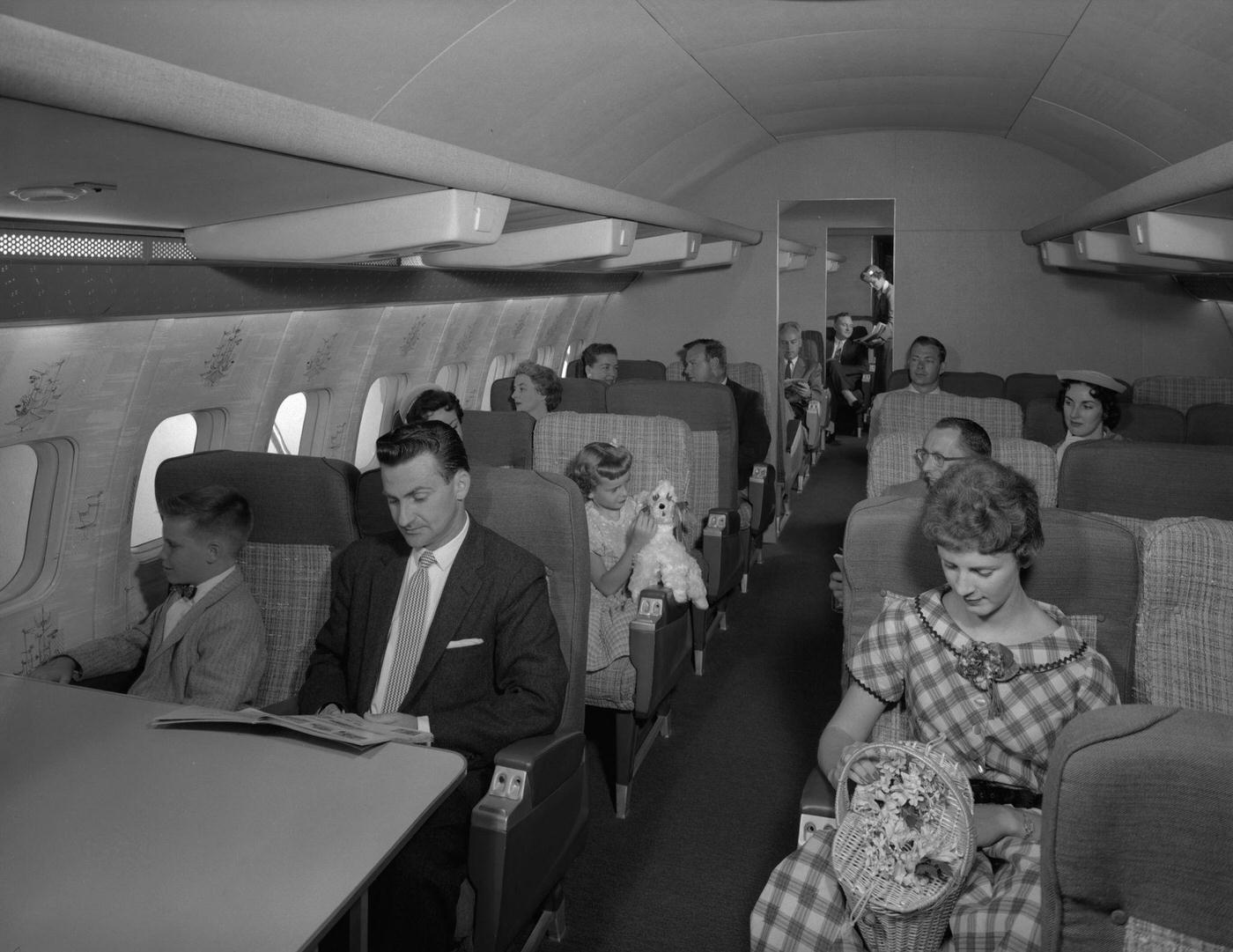
#79 An air hostess engages in conversation with passengers on a Transocean Air Lines Boeing 377 Stratocruiser in the mid1950s.
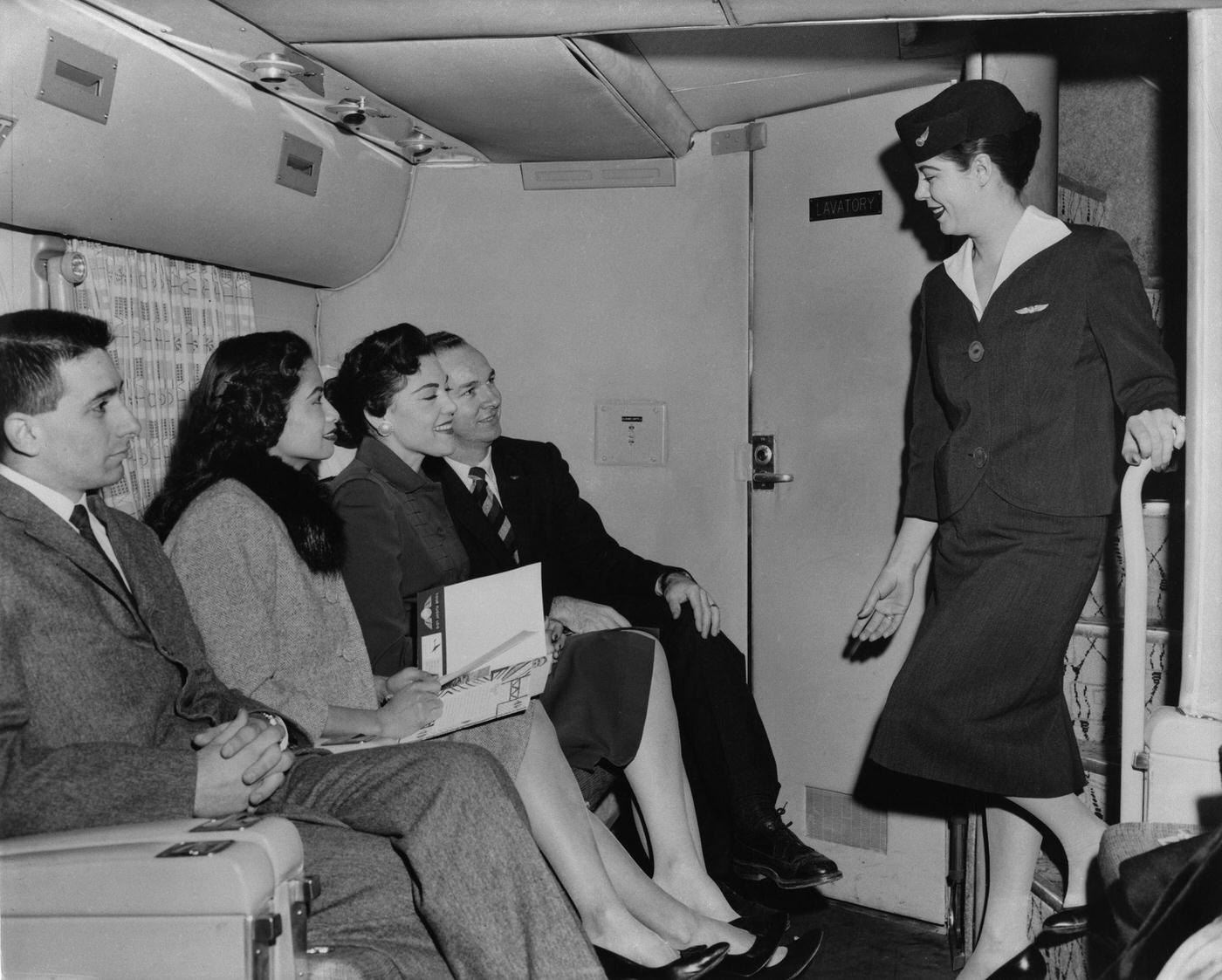
#80 The first British Comet jet passenger service from London Airport to Johannesburg is shown in this photo from 1952.
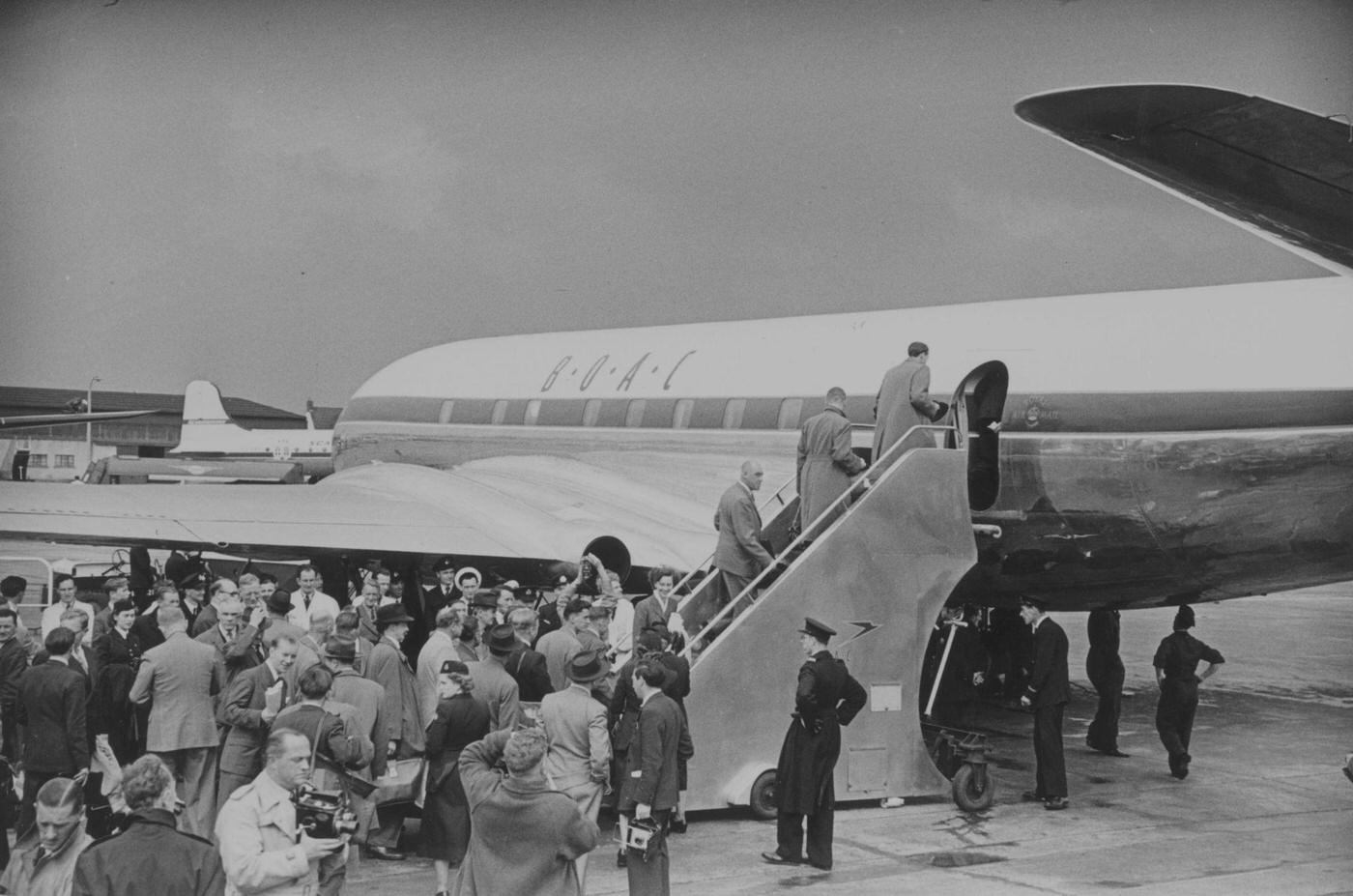
#81 Passengers bound for Johannesburg board the inaugural British Overseas Airways Corporation (BOAC) De Havilland Comet jet airliner at London Airport, marking the world’s first regular jet service.
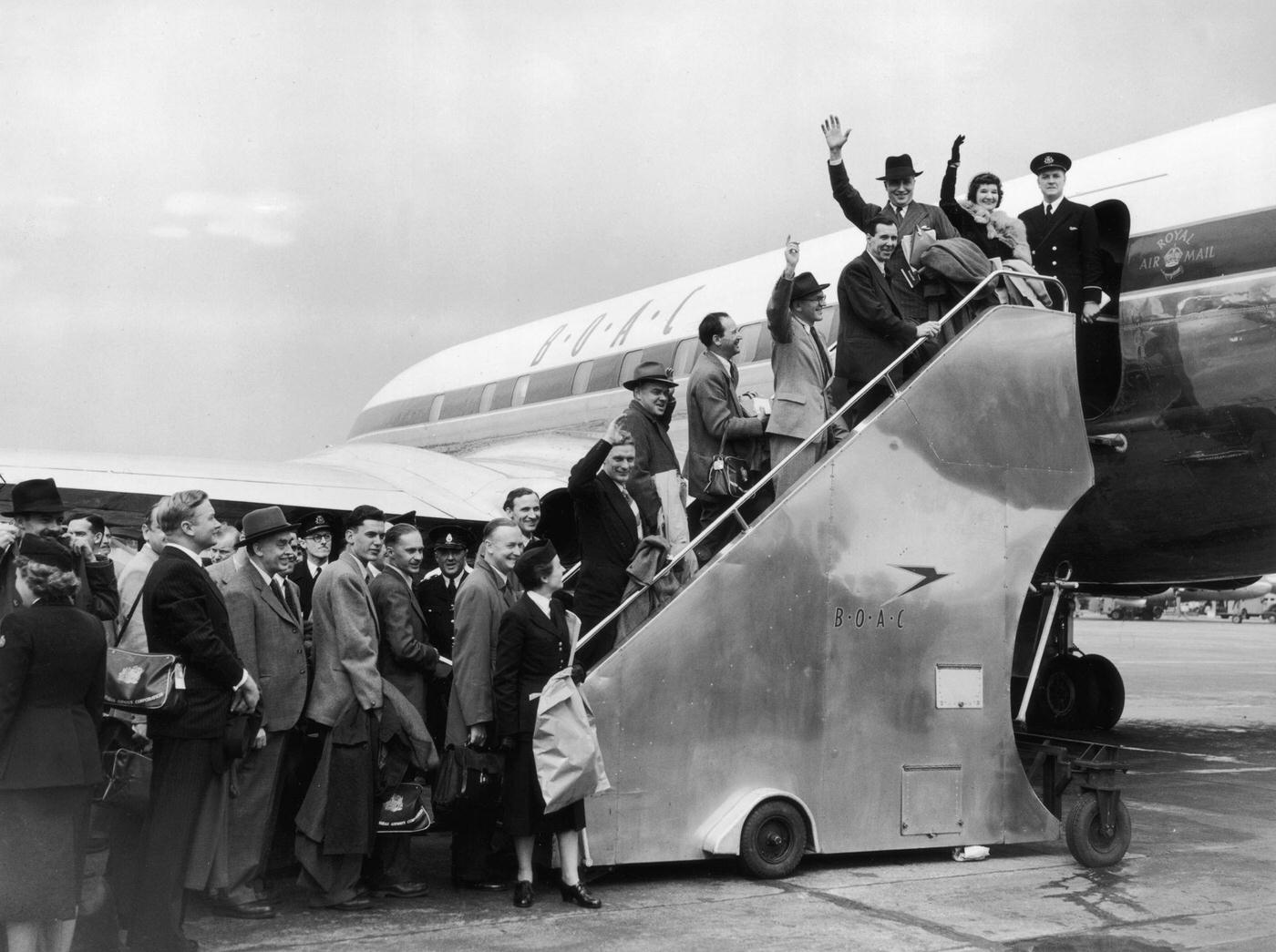
#82 The SaundersRoe SR45 Princess passenger flying boat prototype, GALUN, emerges from its hangar at the SaundersRoe Cowes facility on the Isle of Wight in the United Kingdom on October 31, 1951.
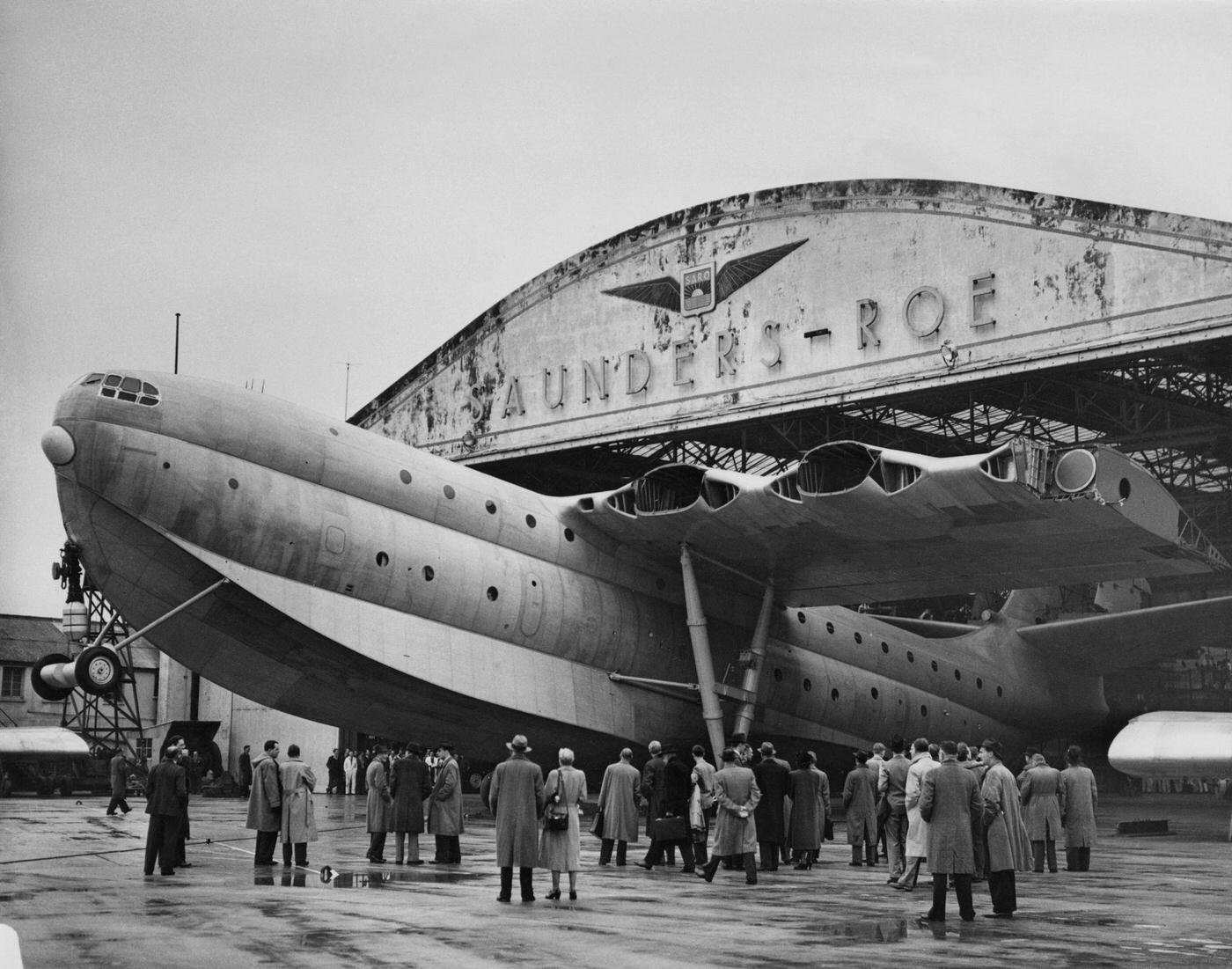
#83 Yankee catcher Yogi Berra and Phil Rizzuto play cribbage while waiting for chartered TWA flights to take off amidst a railroad strike.
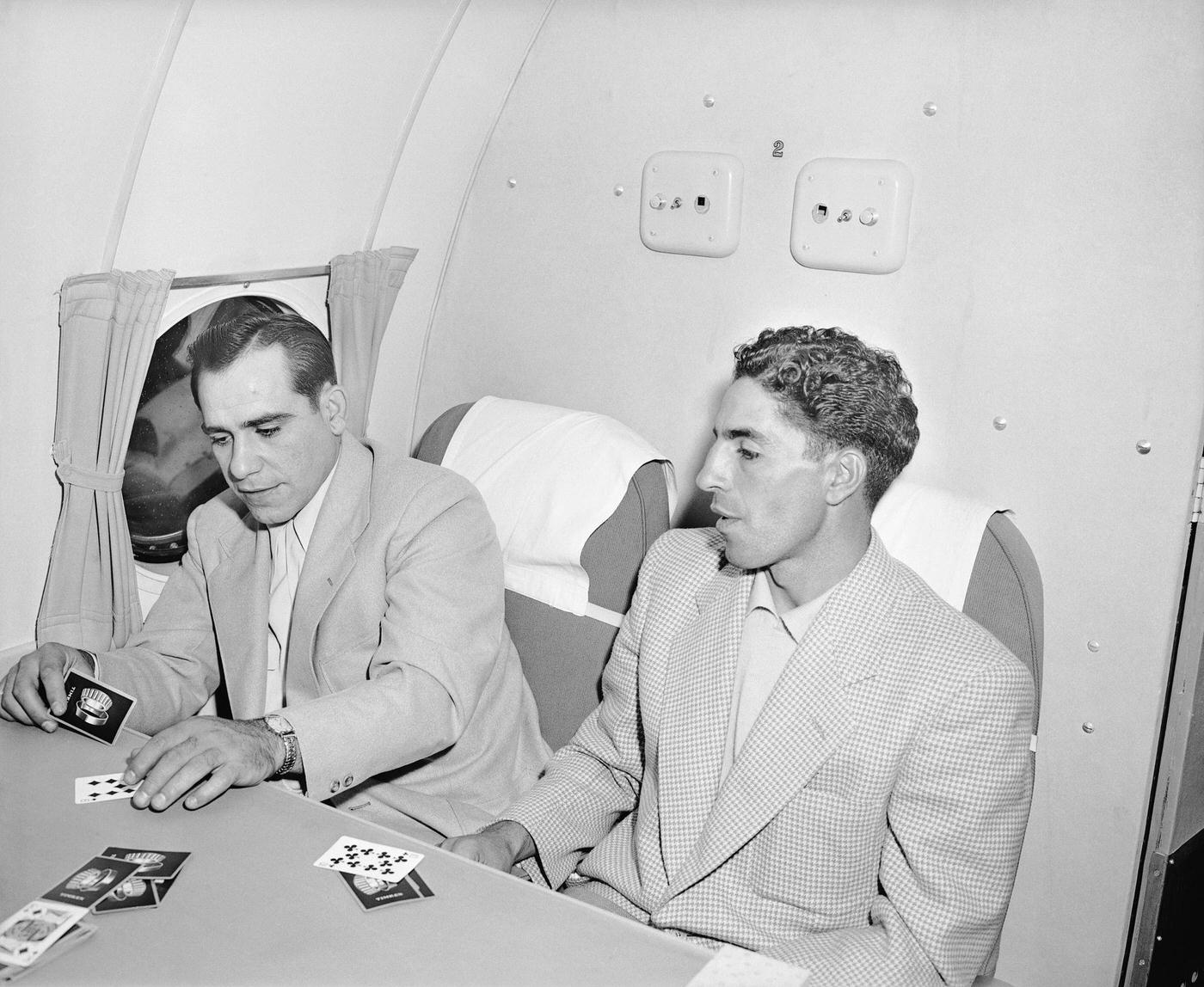
#84 Evacuees from Baghdad are about to board a flight at Esenboga Airport in Ankara, Turkey on July 25, 1958.
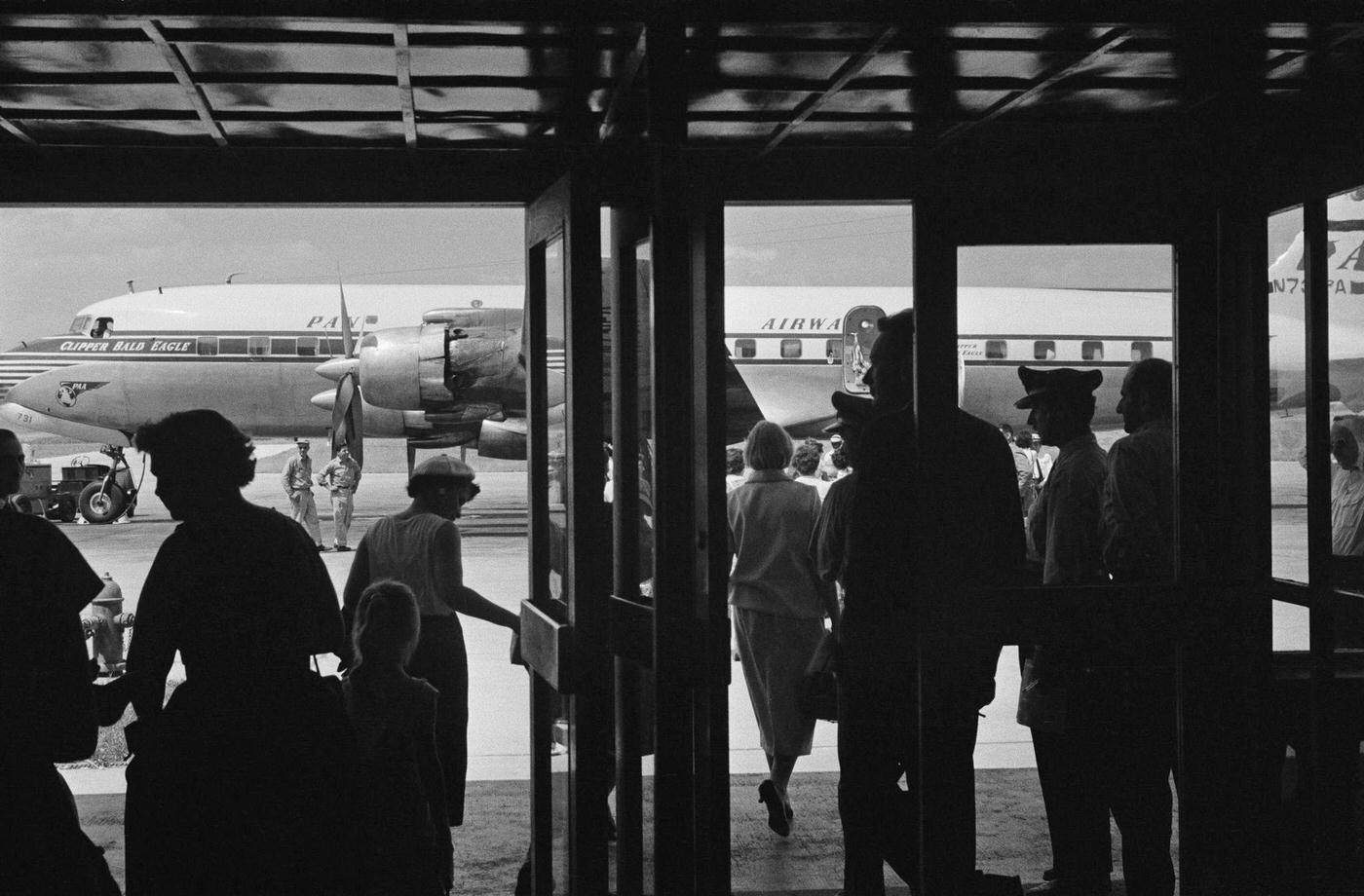
#85 Passengers disembark from a British Overseas Airways Corporation (BOAC) Canadair C4 Argonaut aircraft onto a shuttle bus at London Airport in June 1951.
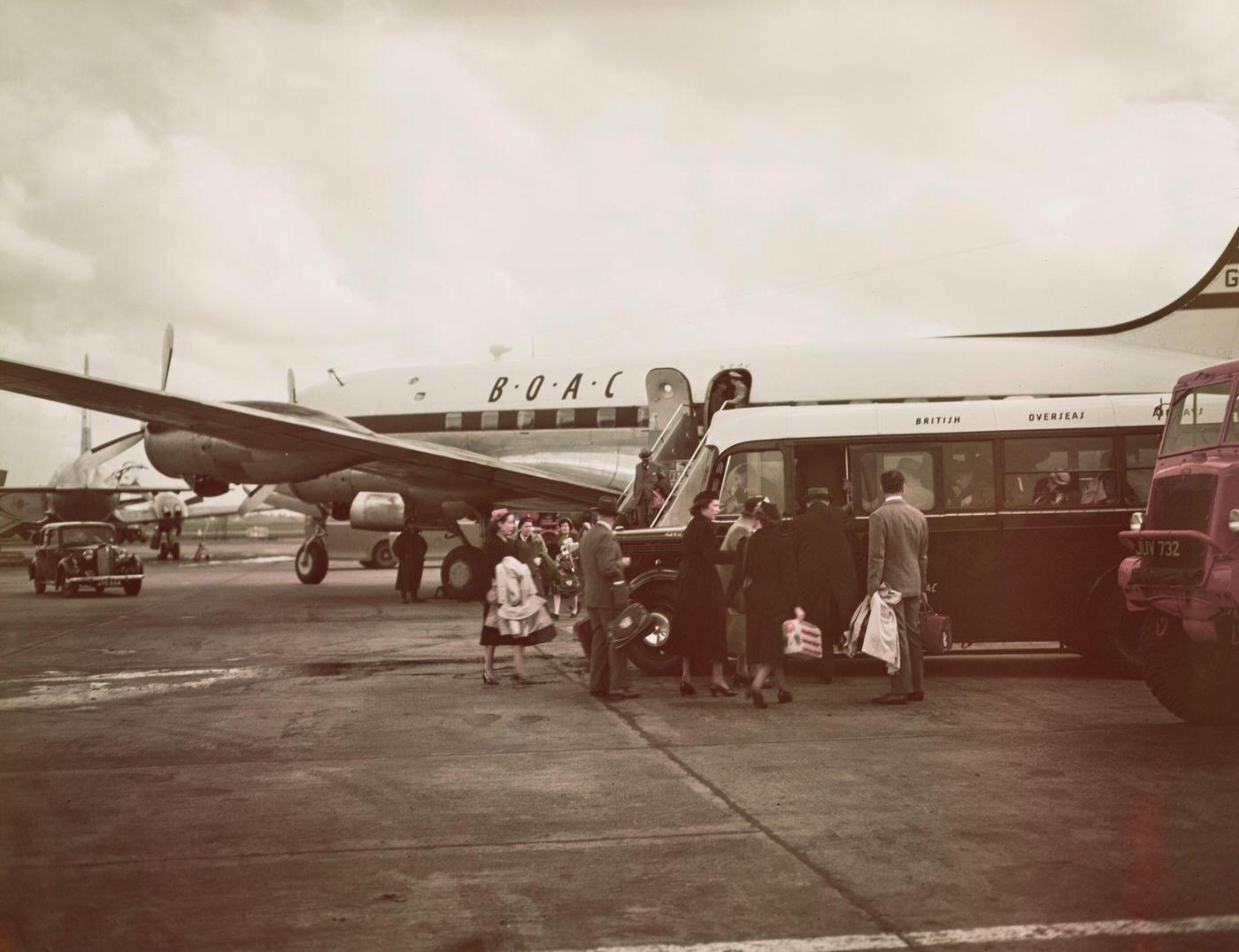
#86 The BOAC Comet is seen taxiing on the runway at London Airport before flying to Johannesburg, marking the world’s first jet passenger service.
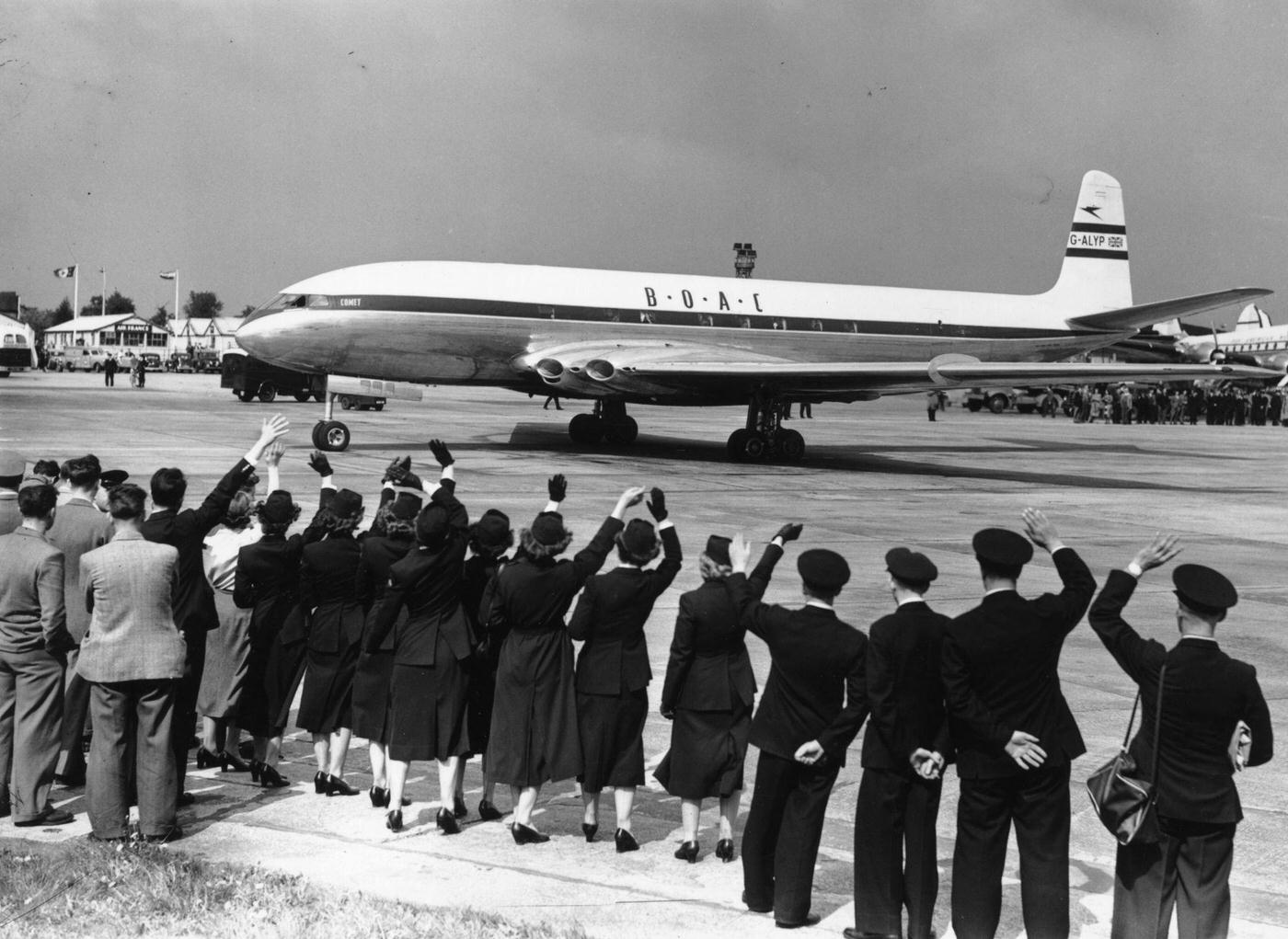
#87 Travellers sleep on board an airplane in New York, as seen in this 1950 photo from Picture Post.
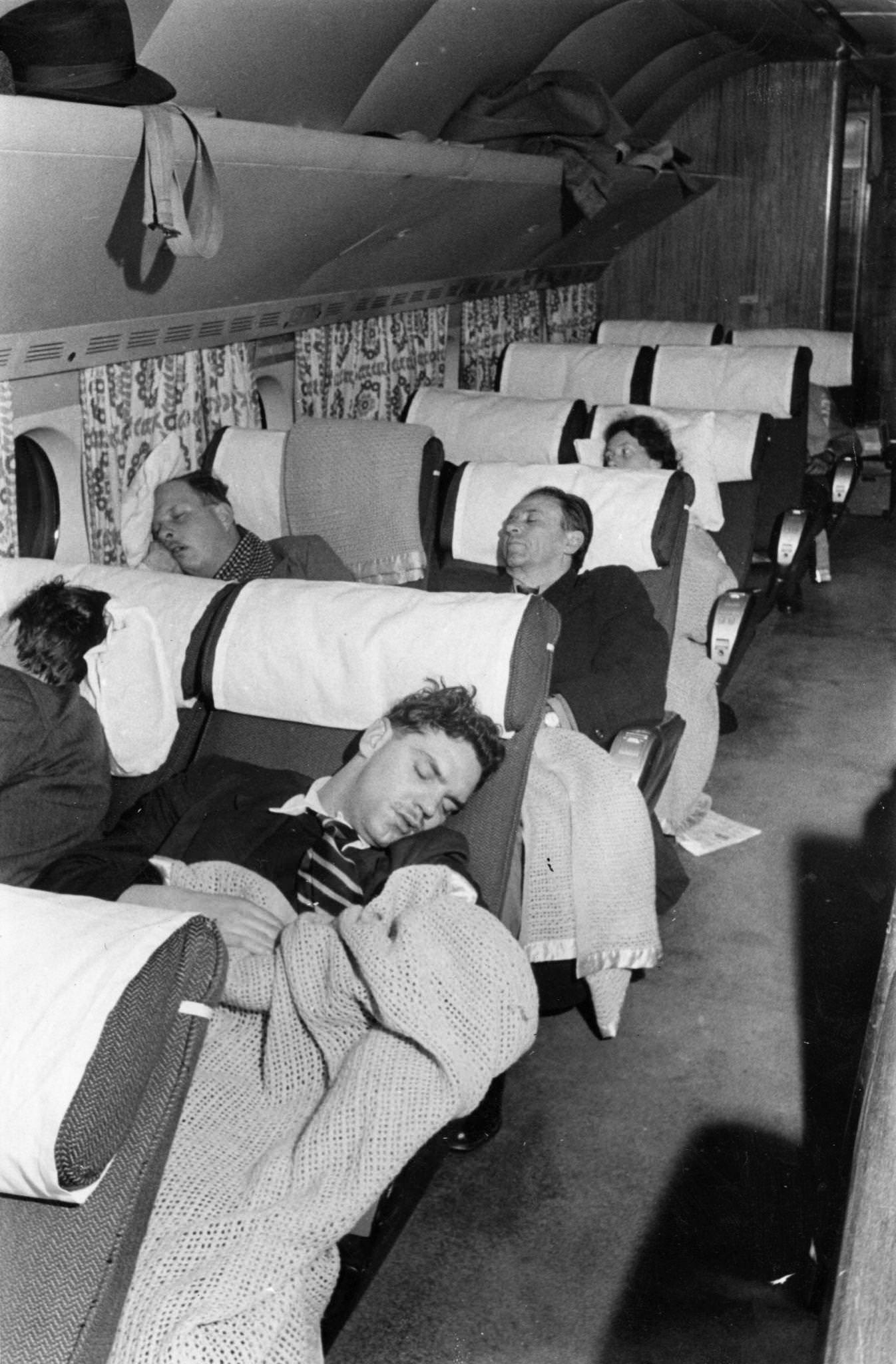

#88 Britishborn American actress Liz Taylor arrives at New York International Airport with fellow actresses Grace Kelly and Lorraine Day in 1955.
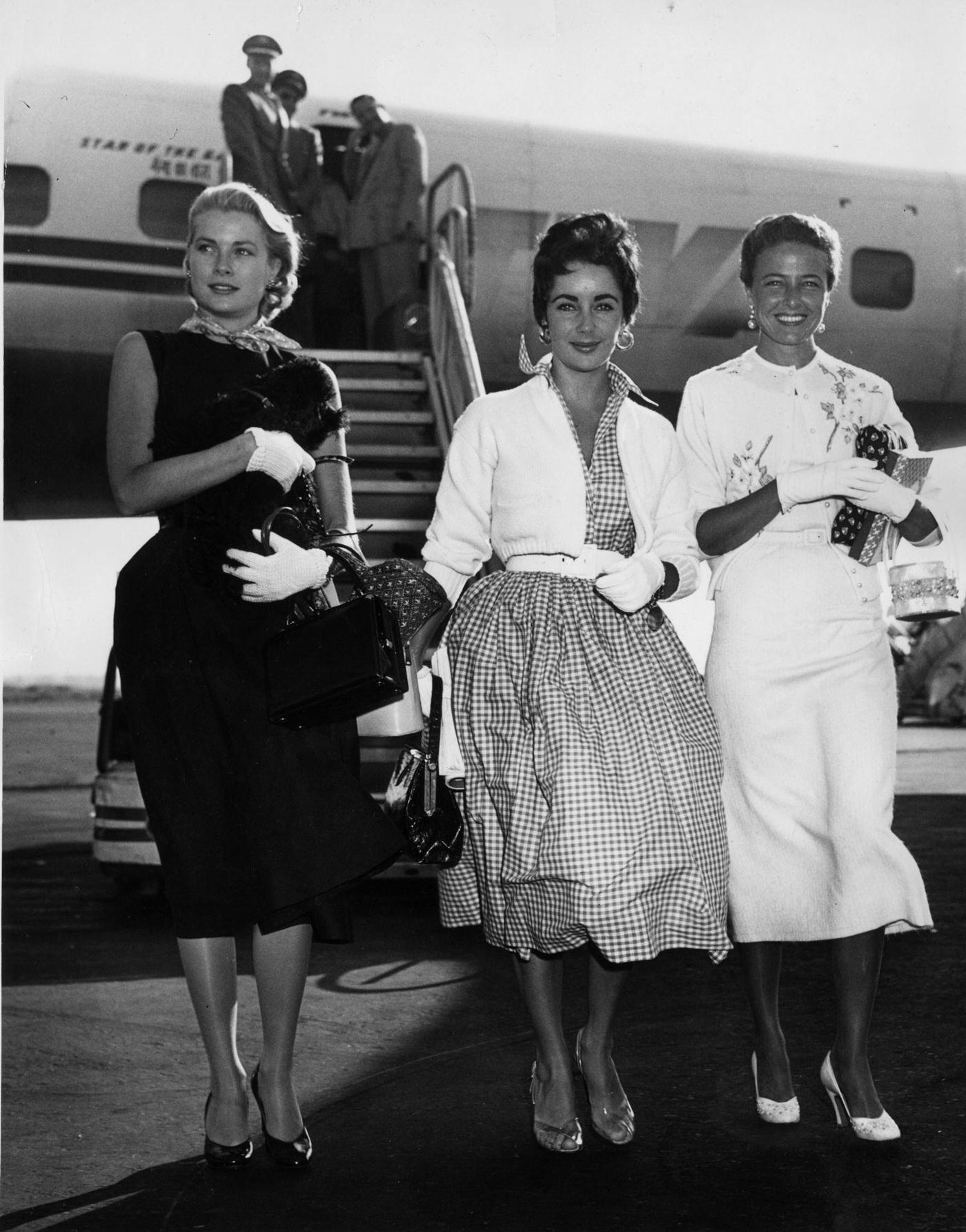
#89 In October 1956, a male air steward and female air stewardess serve food and drinks from a trolley to passengers on board a Bristol Britannia medium to long range airliner.
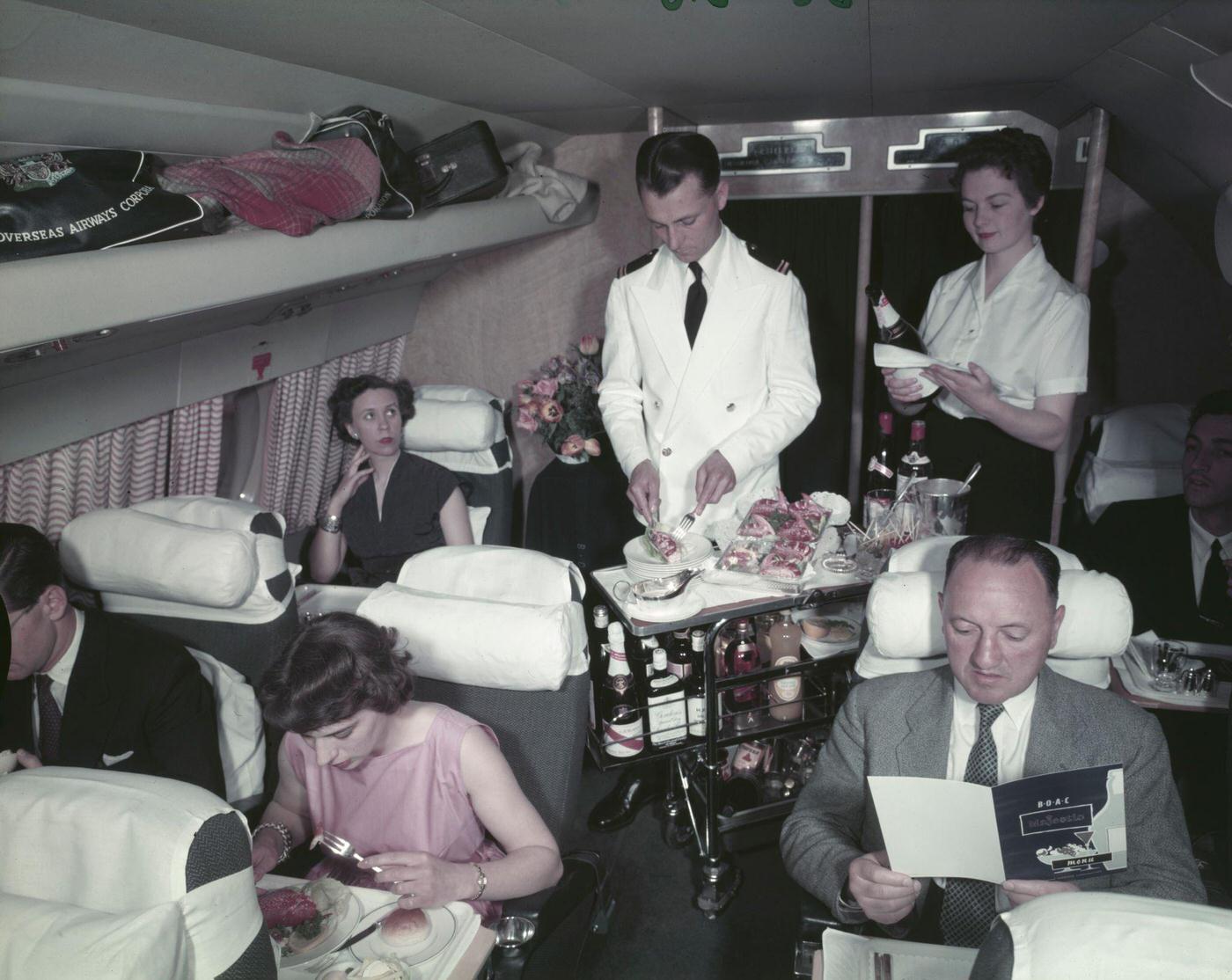
#90 A passenger on board the world’s first jet airliner service receives luncheon from E Courtney, a member of the cabin crew. The Comet flight is headed for South Africa.
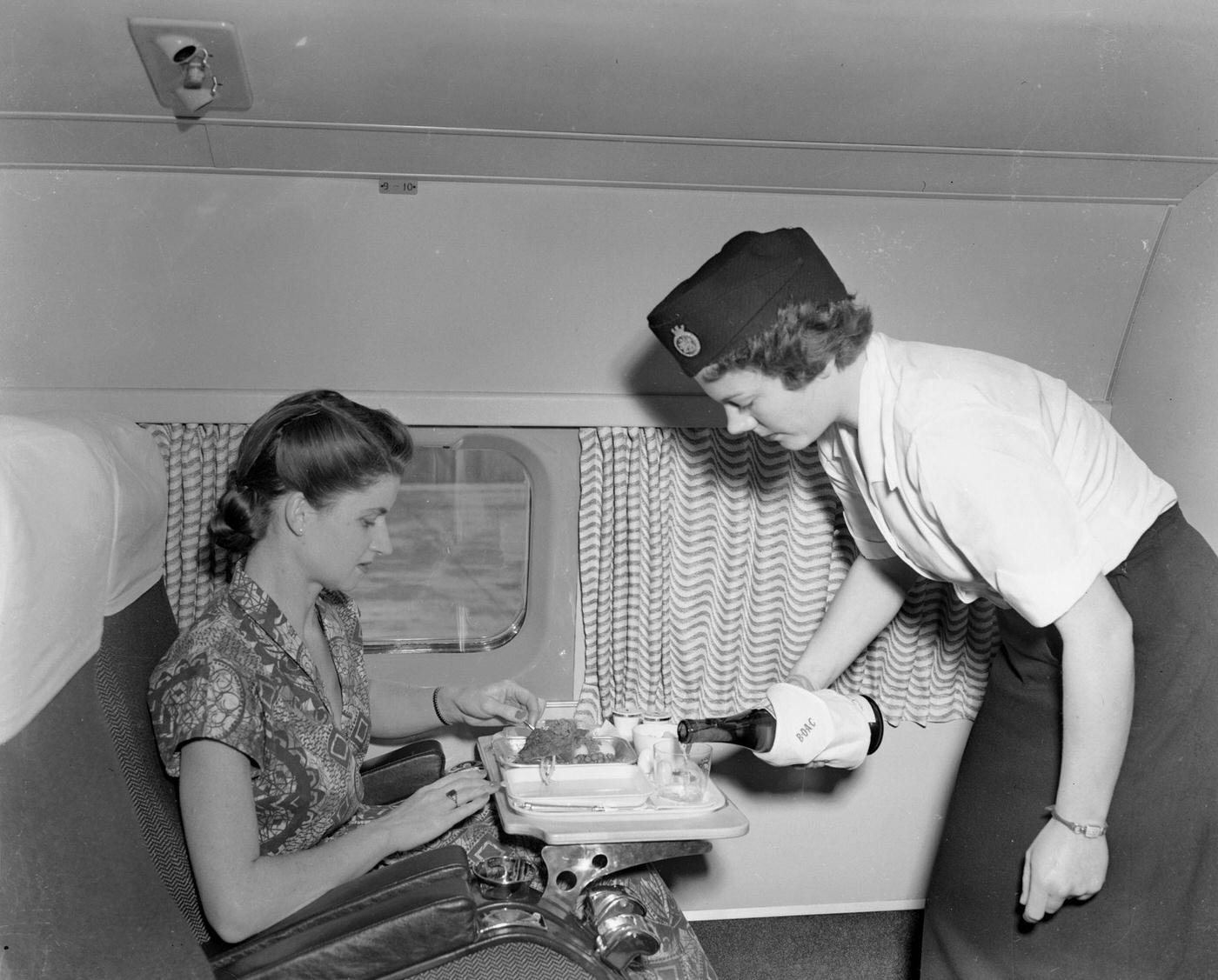
#91 Passengers boarding the jet service to Paris from the Pan American World Airways 707 Jet Clipper, which inaugurated the airline’s Trans Atlantic services to London on October 26, 1958.
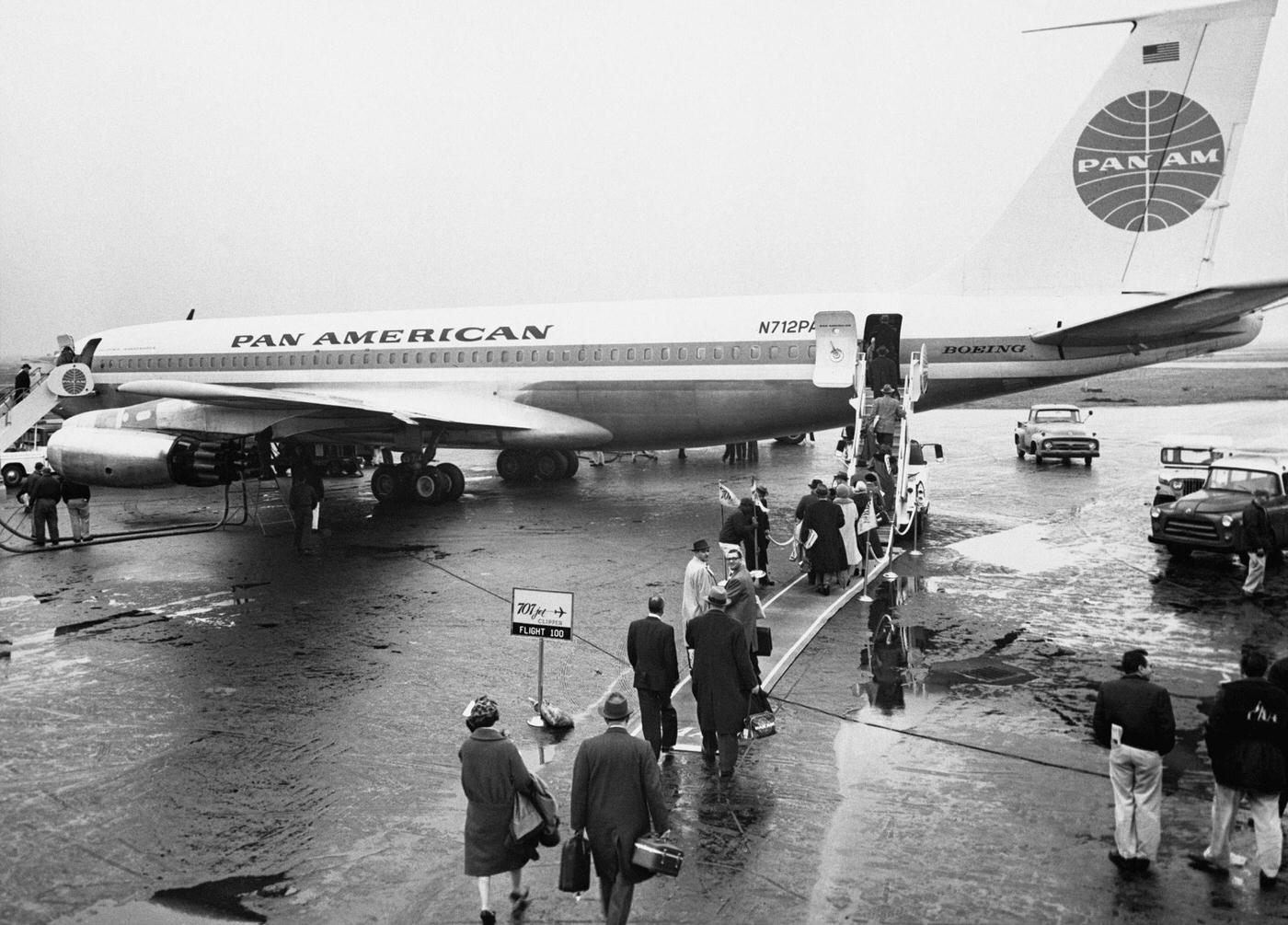
#92 Passengers enjoying a meal inside a mock-up of the Boeing 707 Stratoliner. The development of the Stratoliner began in the 1950s during the race to capture the commercial airline market.
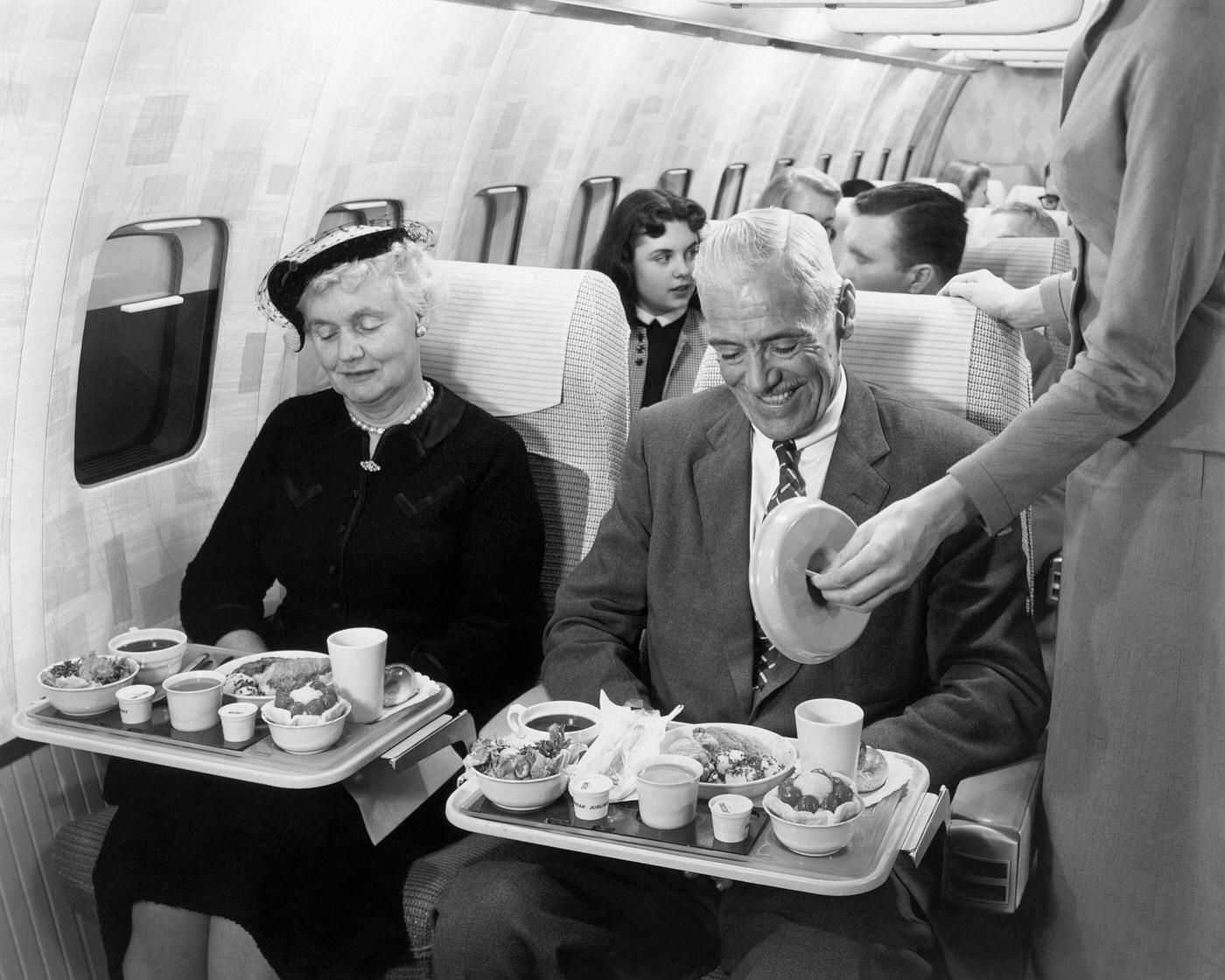
#93 Passengers dining on the Empire in 195.
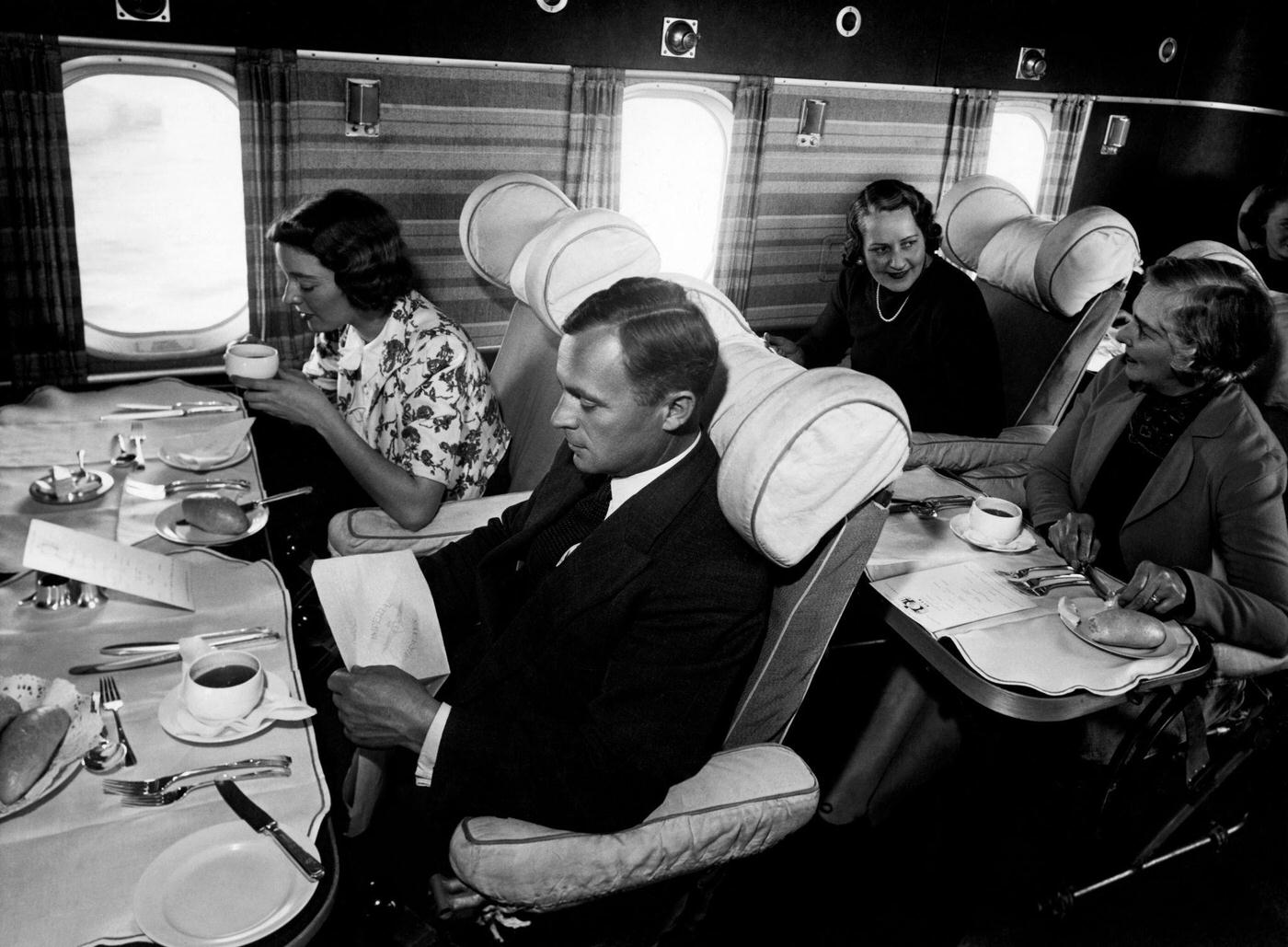
#94 Passengers playing on the Empire in 1950.
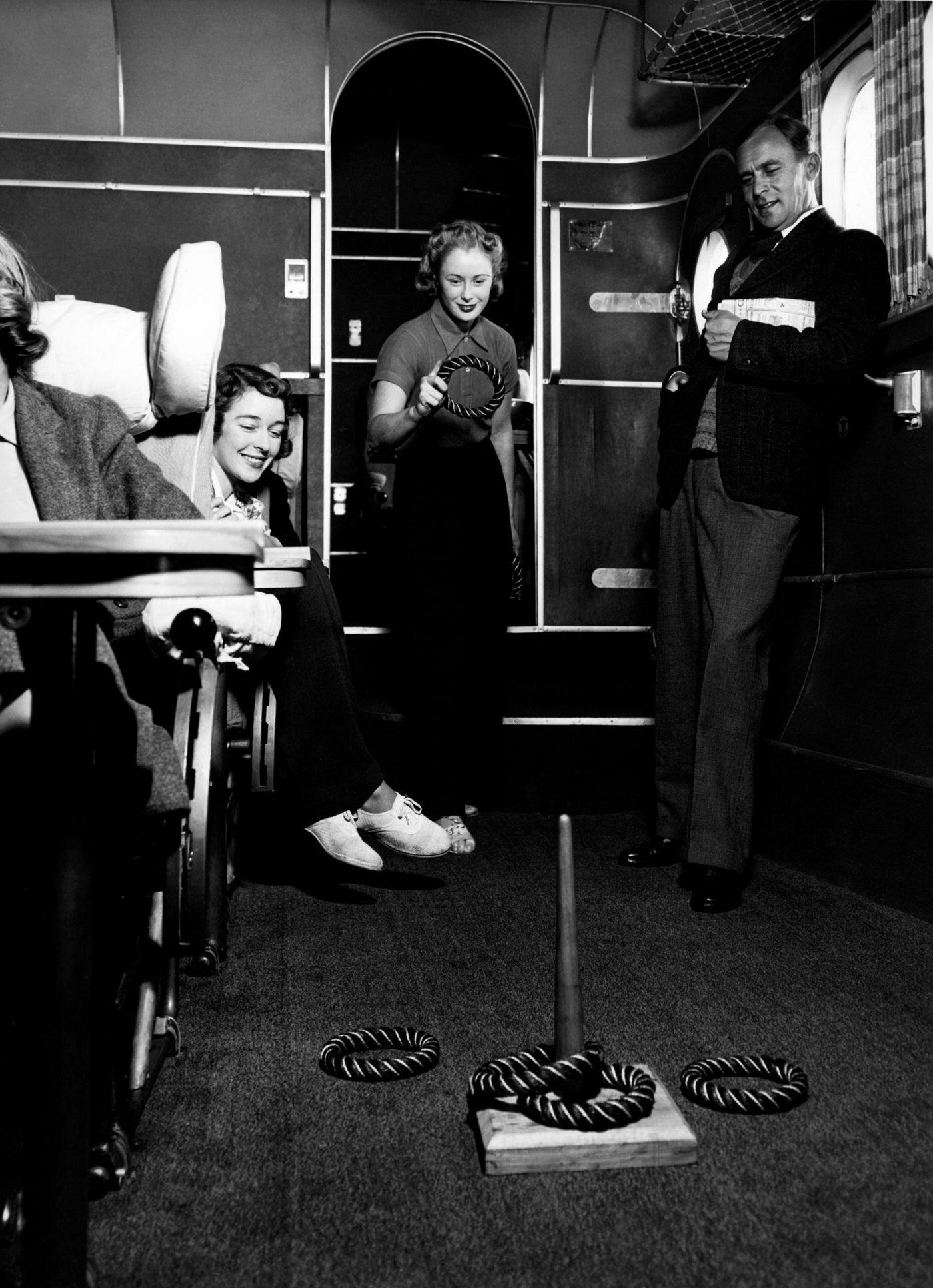
#95 A couple on a plane in 1955.
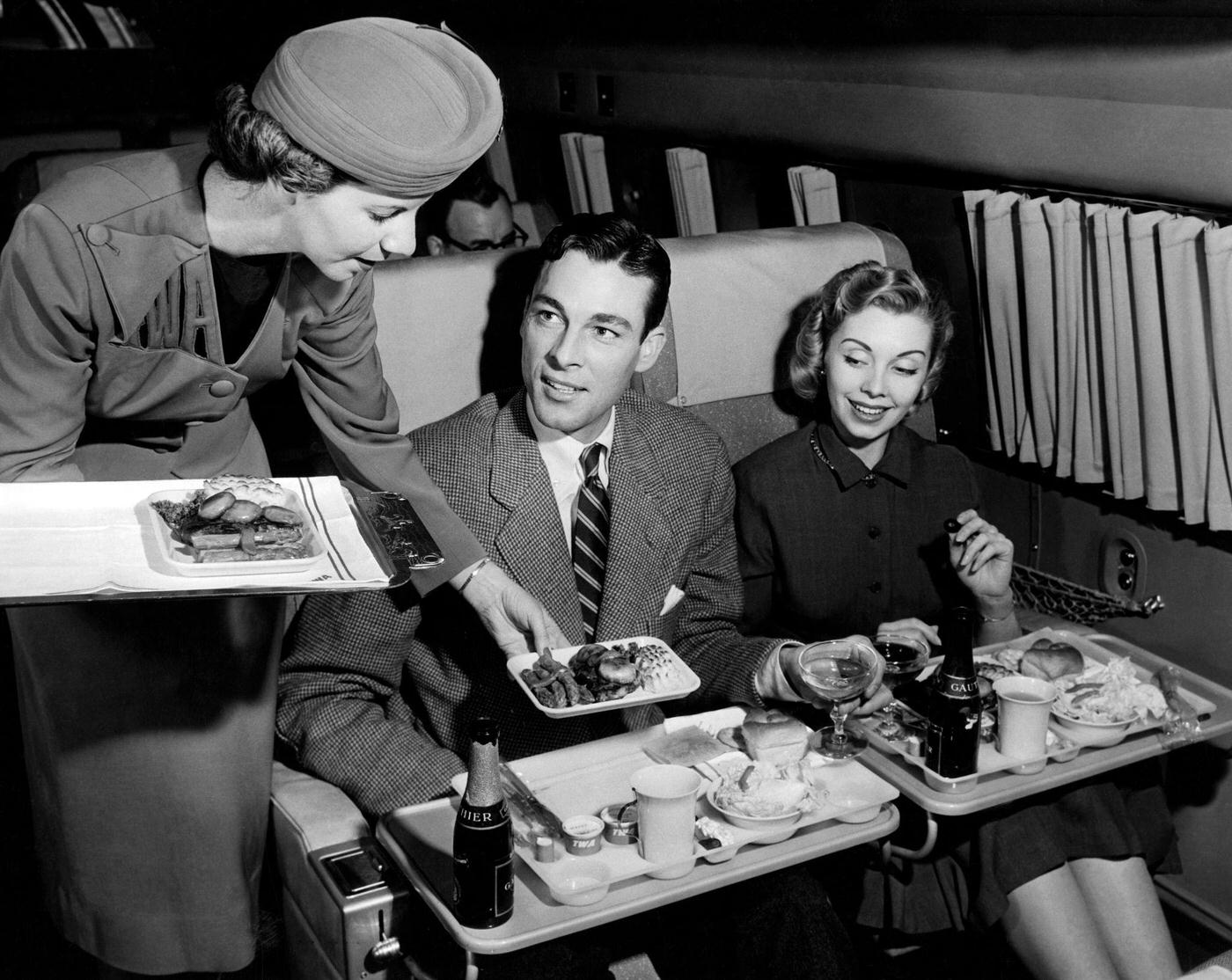
#96 On August 7, 1959, an air stewardess serves food to passengers on board a Qantas Boeing 707 plane at London airport.
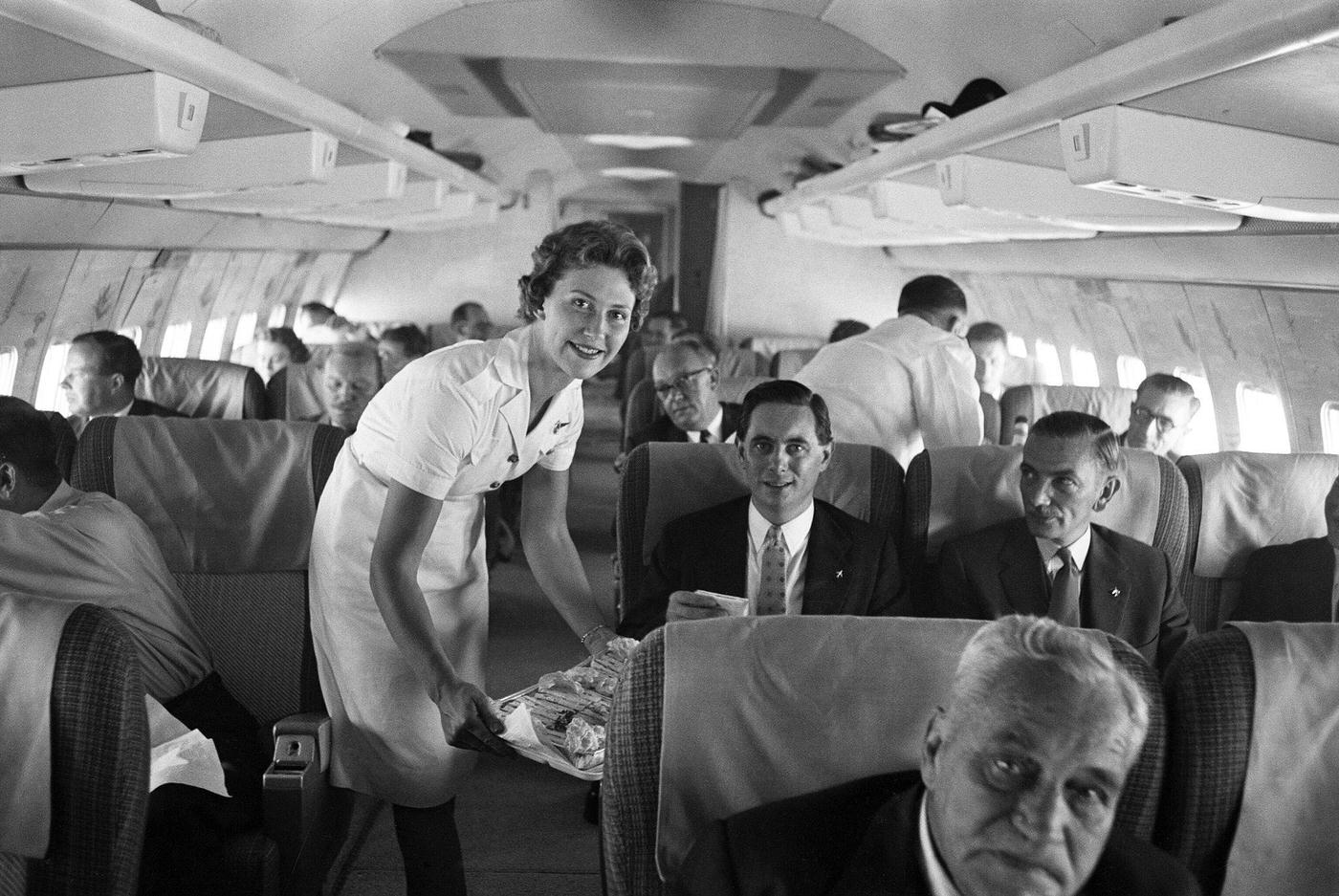
#97 In the 1950s, an interior view of a commercial passenger plane shows a flight attendant pouring a glass of wine for a man who sits next to a couple who are toasting each other with full glasses.
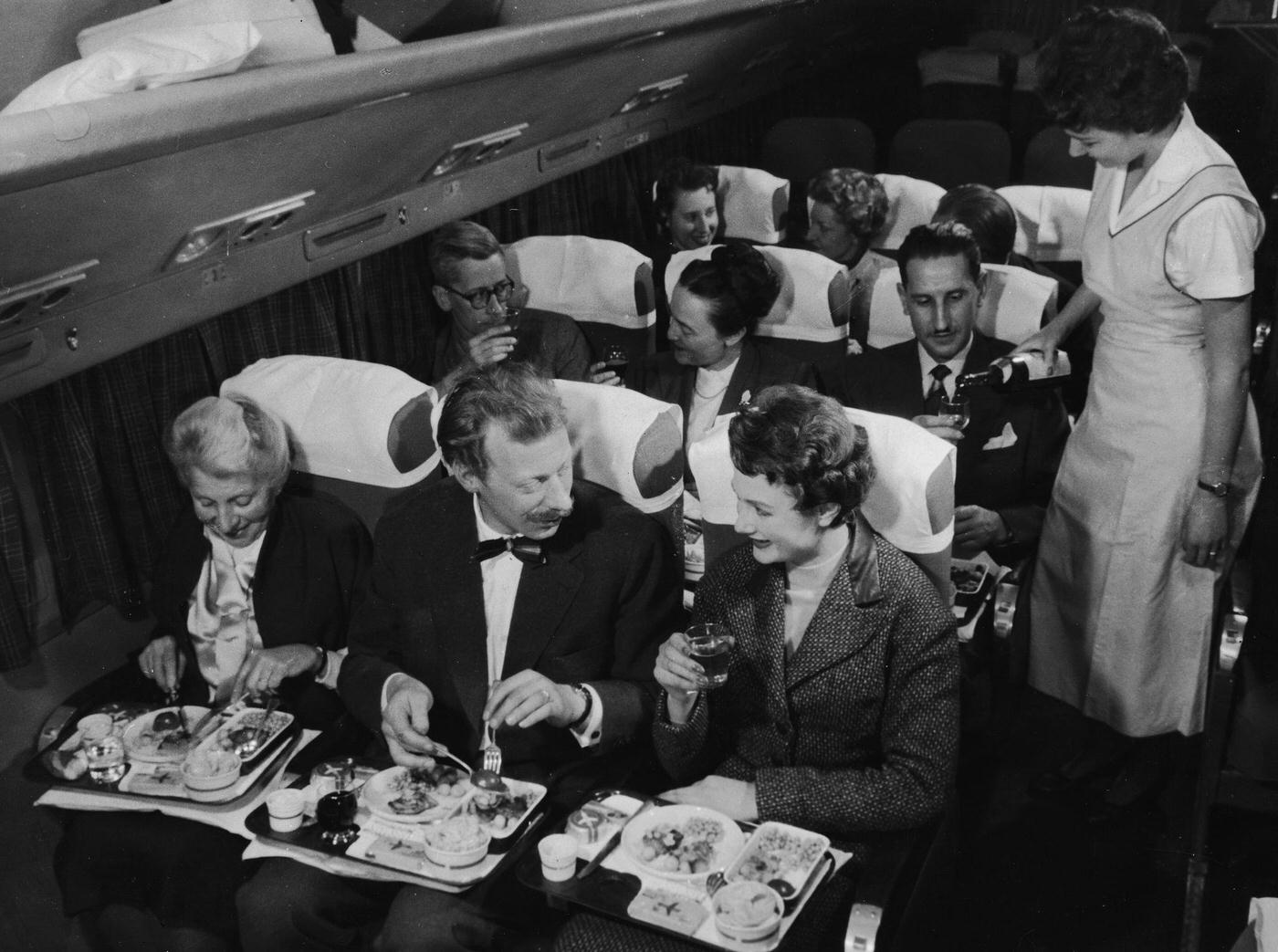
#98 In 1957, a view of airline passengers is seen along the center aisle of a plane. Many of the passengers are refugees from the failed Hungarian Revolution and are on their way to the United States.
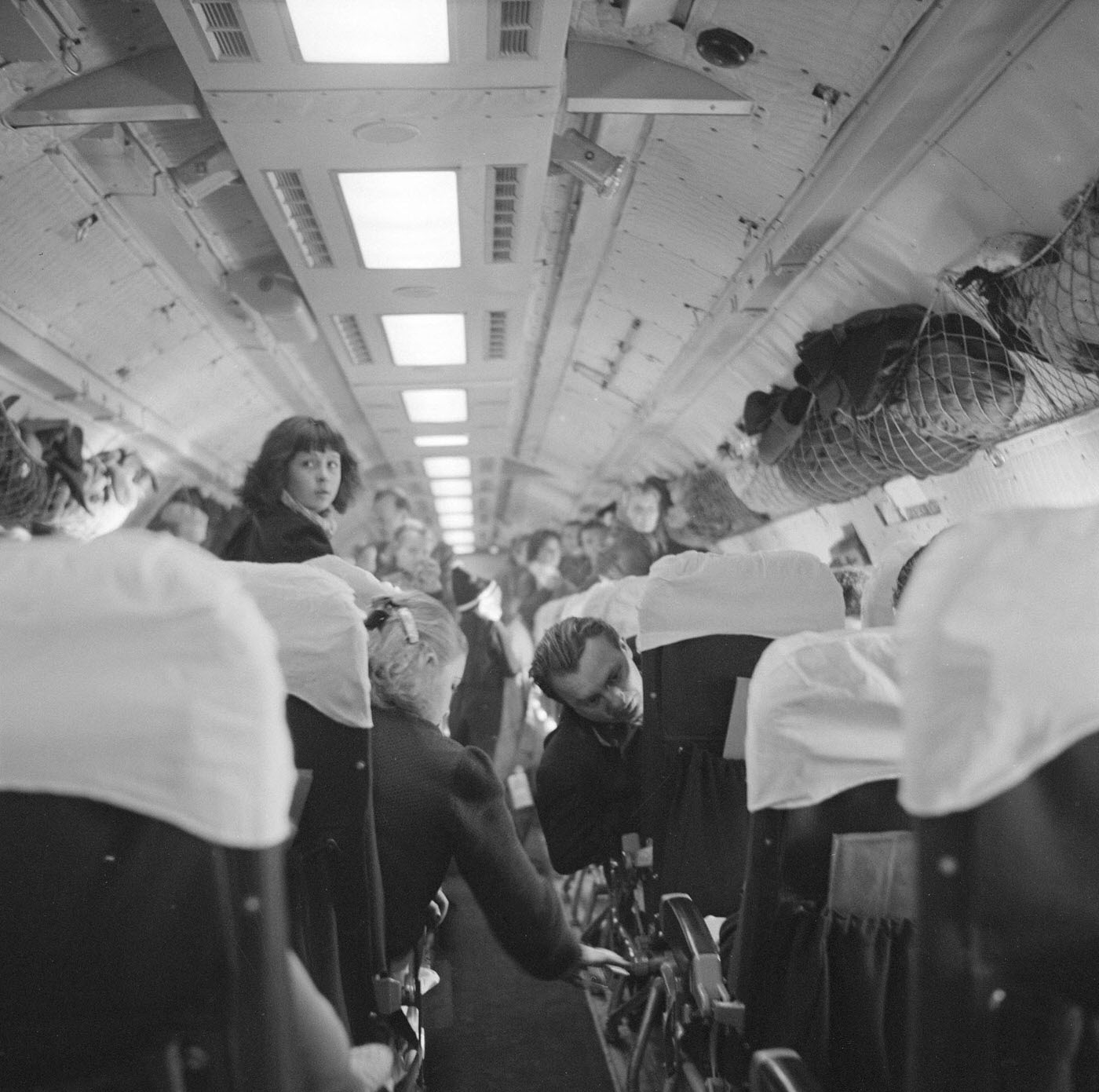
#99 Passengers enjoying a relaxing smoke on a Transocean Air lines Boeing 377 Stratocruiser in the mid-1950s. Transocean Air lines was a pioneer discount airline that flew between 1946 and 1962.
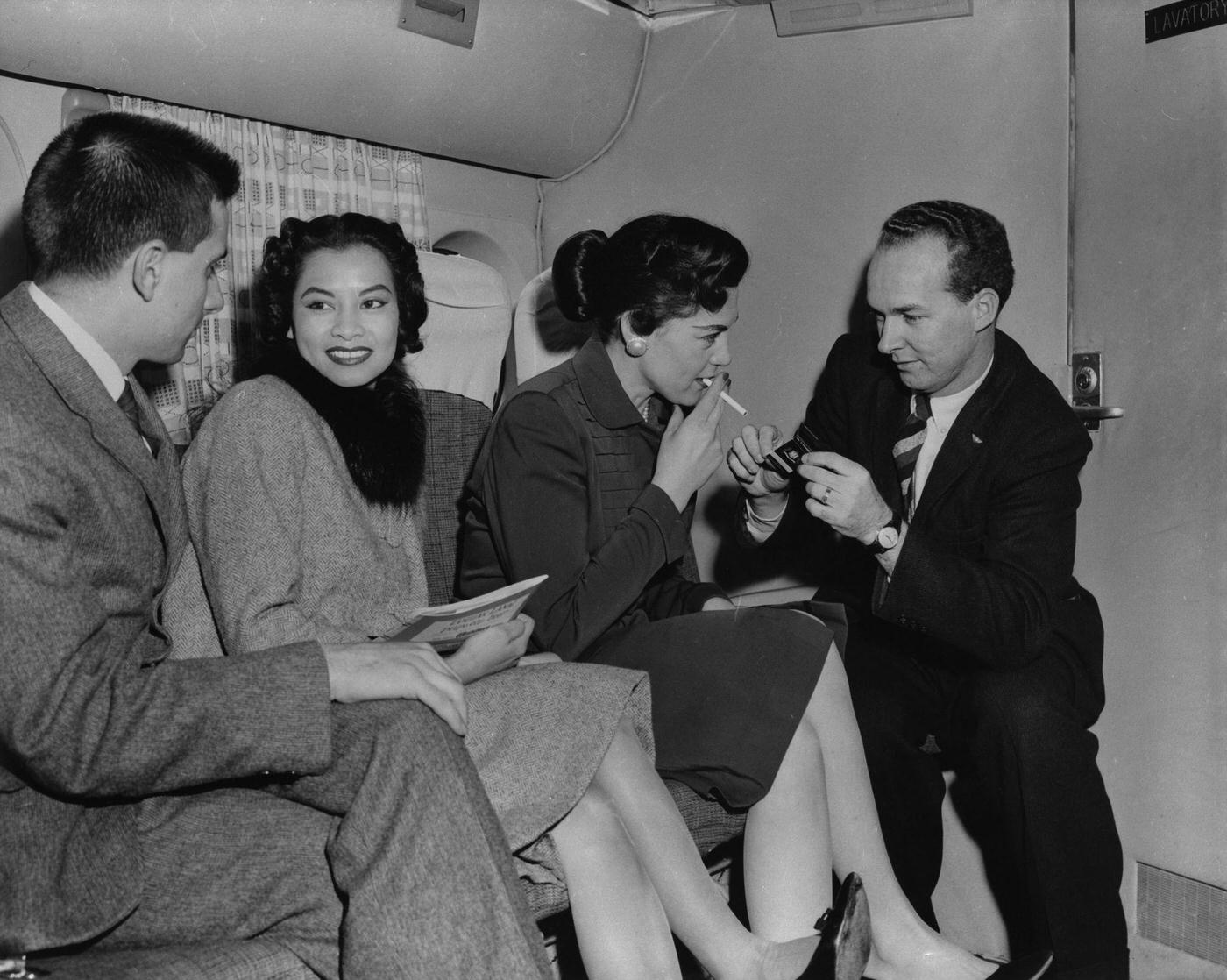
#100 A stewardess serves drinks while passengers have lunch aboard a BEA Vickers Viking passenger plane in 1958.
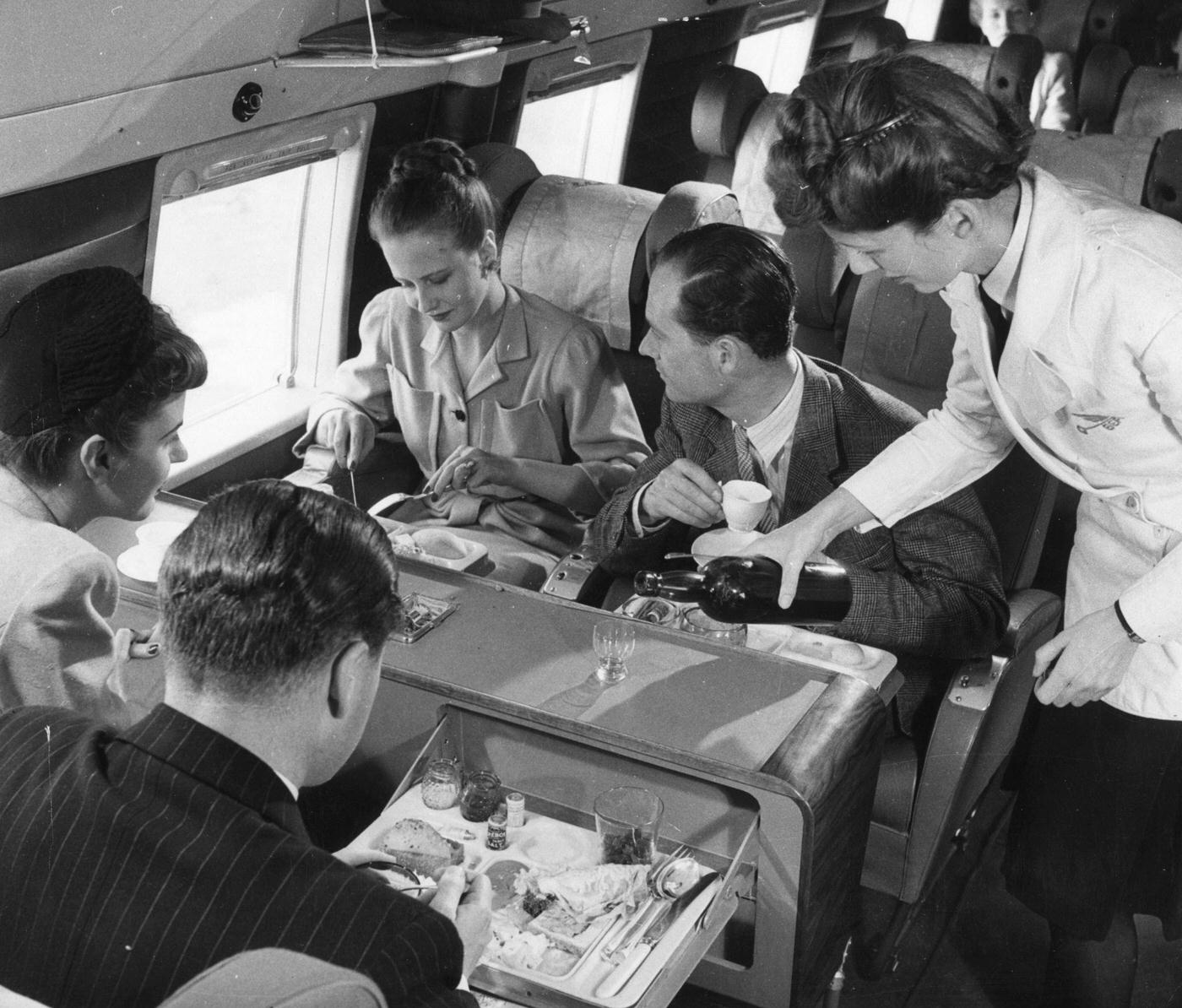
#101 In 1955, an interior view of the passenger cabin of a Douglas DC-7 Mainliner airplane shows a pair of flight attendants serving travelers.
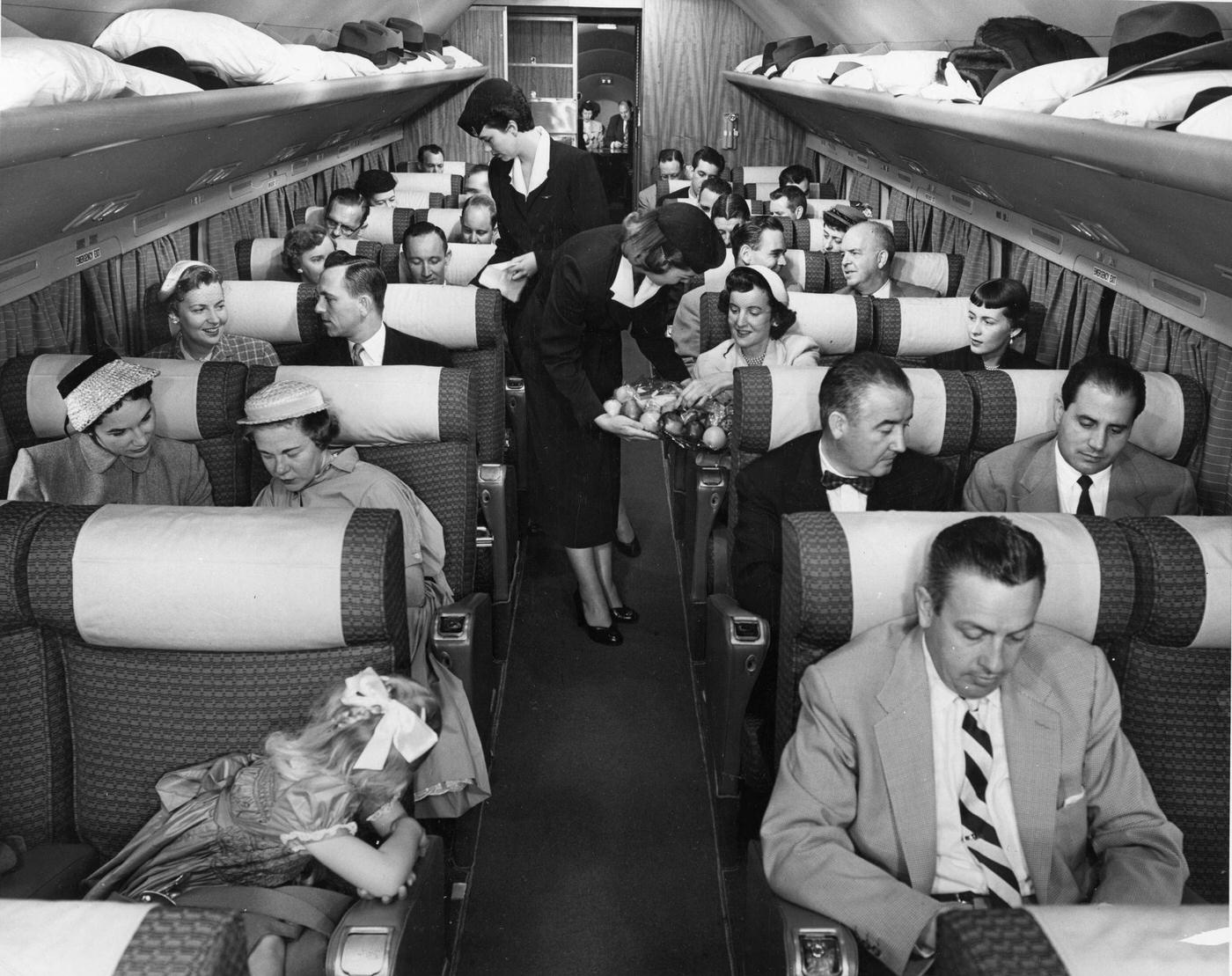
#102 In the mid-1950s, an air hostess serves a snack to passengers on a Transocean Air lines Boeing 377 Stratocruiser. Transocean Air lines was a pioneer discount airline that flew between 1946 and 1962.
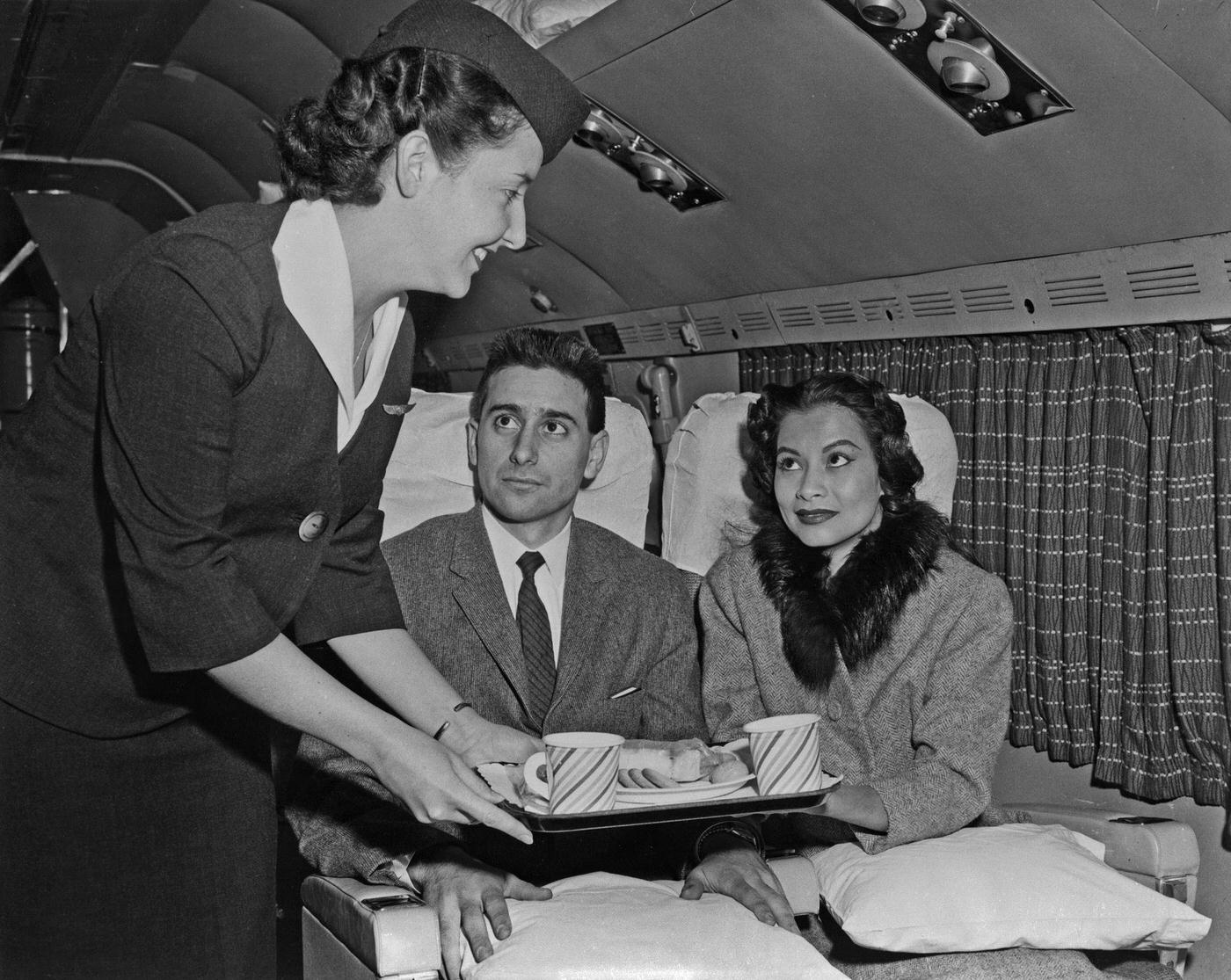
#103 This Vickers Viscount airliner was a surprise visitor to Woolsington (Newcastle Airport), having arrived from London with passengers due to a rail strike in 1955.
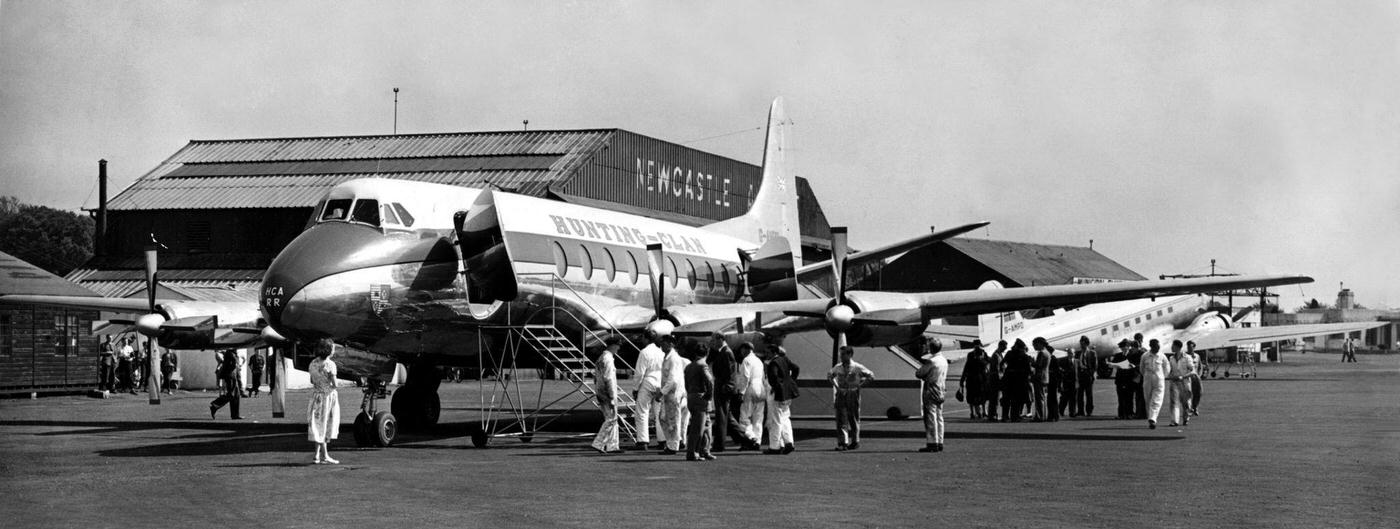
#104 Passengers relaxing on the sleeper seats during a demonstration flight of the new Comet 4 at Hatfield in 1958.
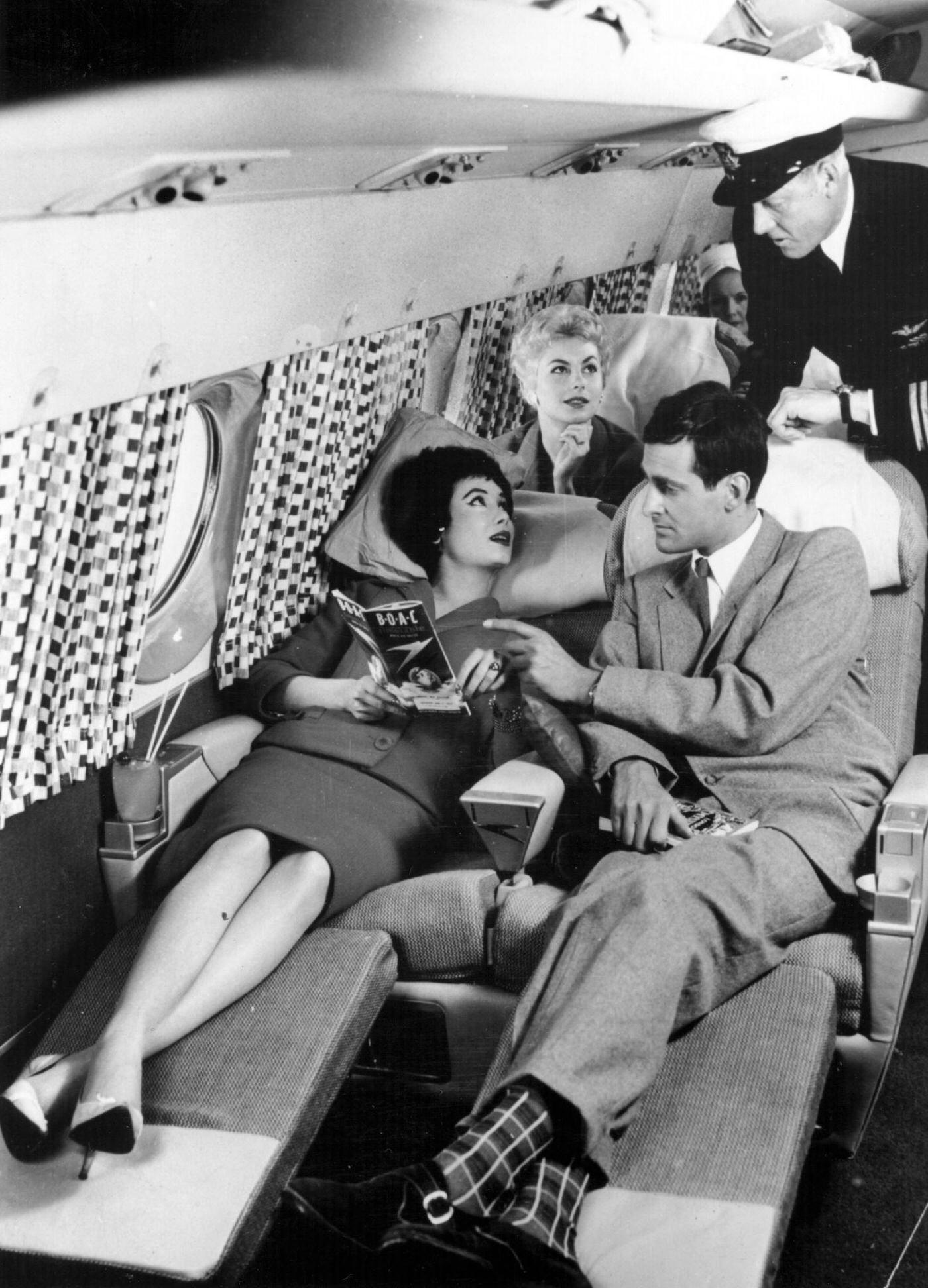
#105 In the 1950s, an interior view of the first-class compartment of a commercial passenger plane shows a flight attendant bending forward to adjust the seat of a sleeping man.
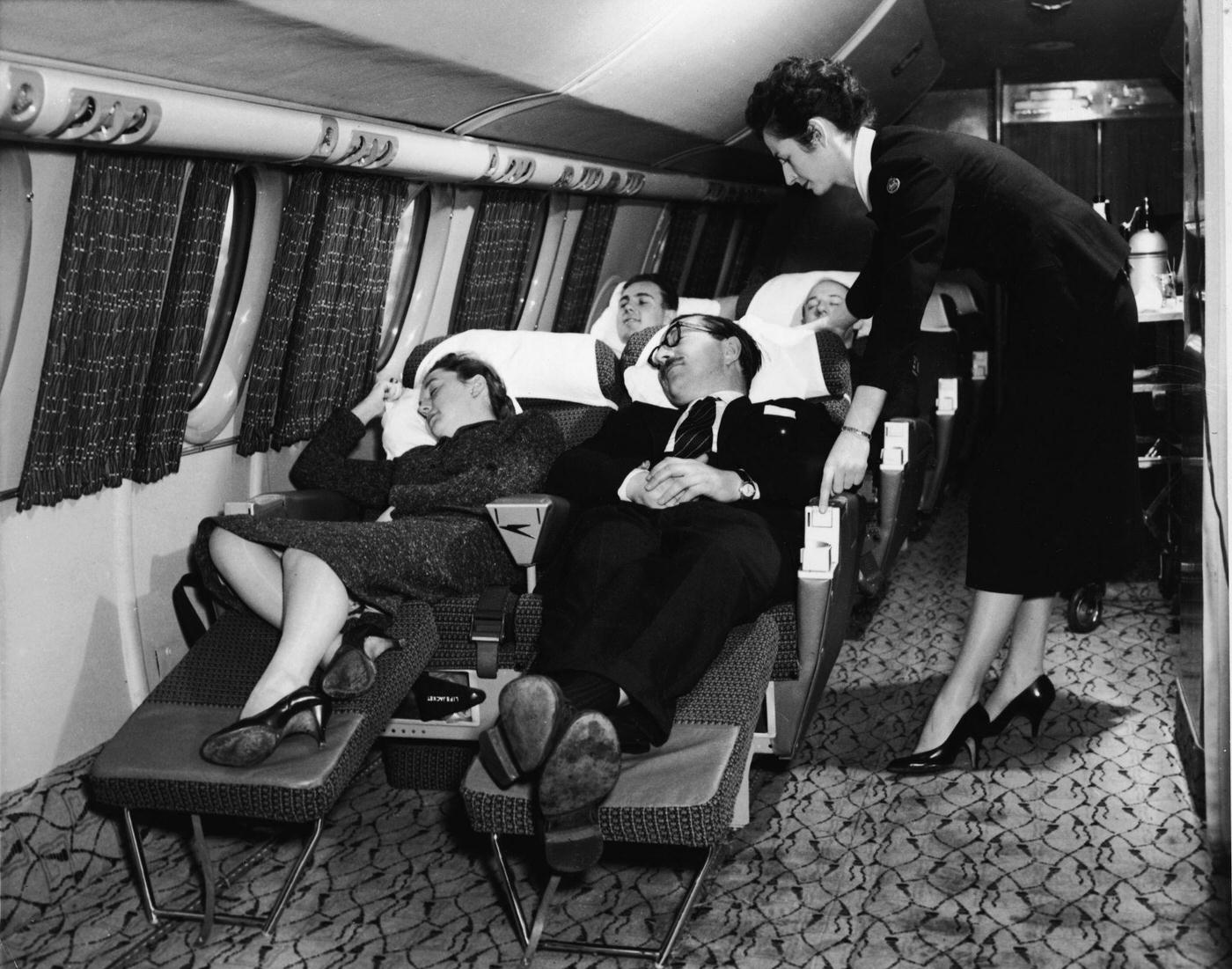
#106 In the 1950s, a first-class compartment of a commercial passenger plane shows a well-dressed couple in the foreground smiling and enjoying their meal, while behind them a flight attendant in a bow tie serves another happy couple.
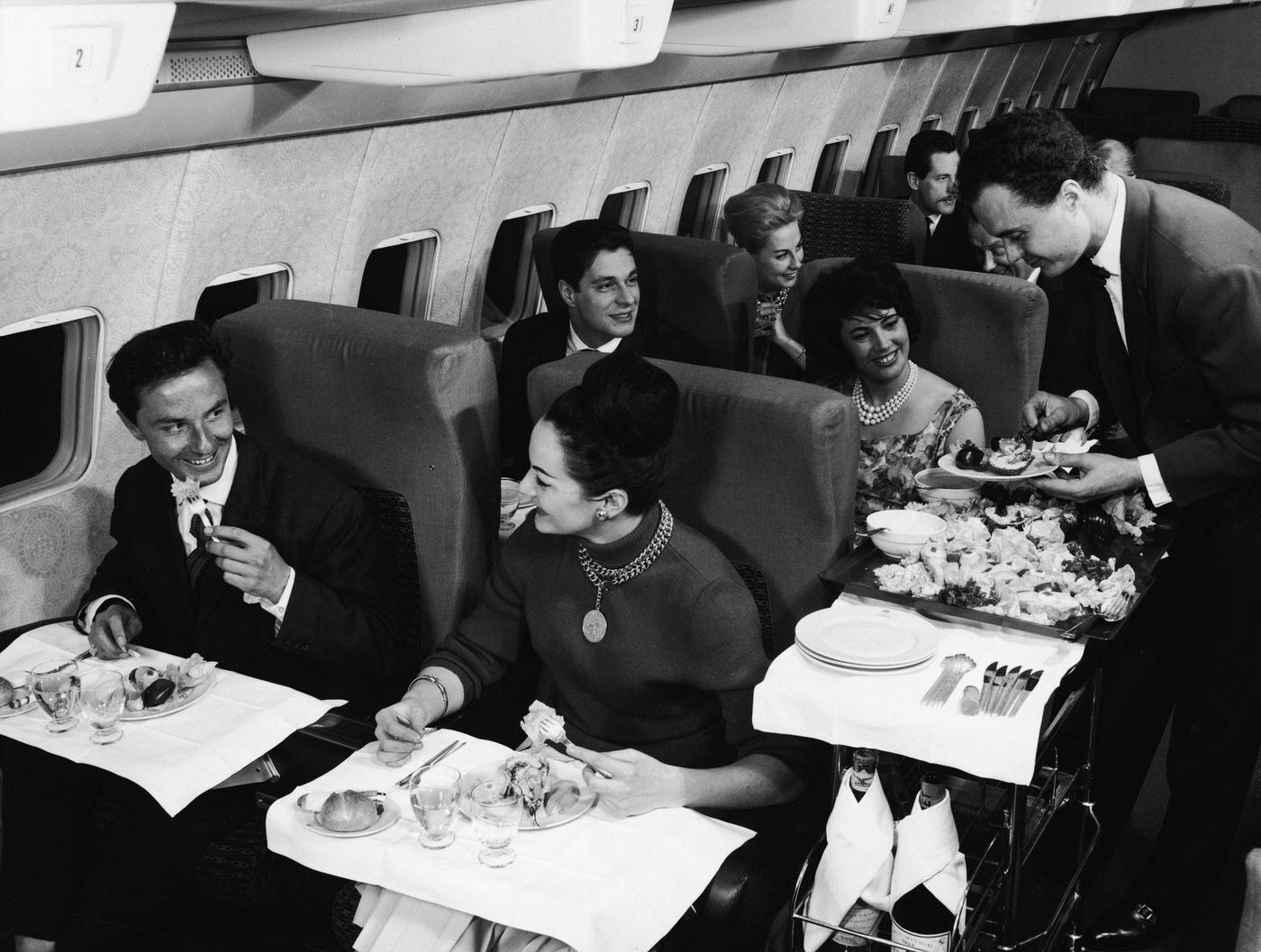
#107 In the 1950s, an interior view of a commercial passenger plane shows a woman contemplating a move in a checkers game she is losing to a young girl, while a man with a cigarette watches them.
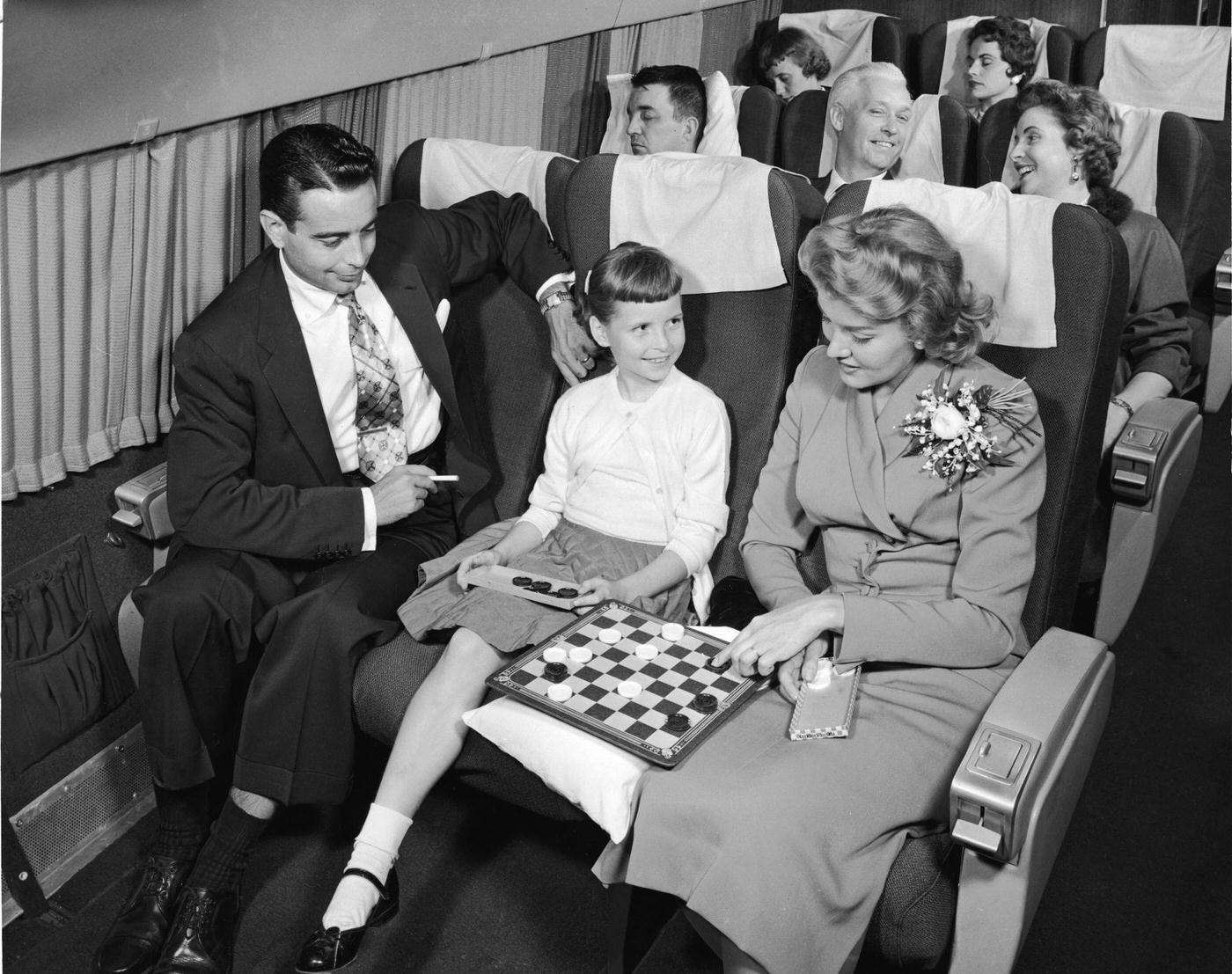
#108 Passengers on a Transocean Air lines Boeing 377 Stratocruiser in the mid-1950s. Transocean Air lines was a pioneer discount airline that flew between 1946 and 1962.
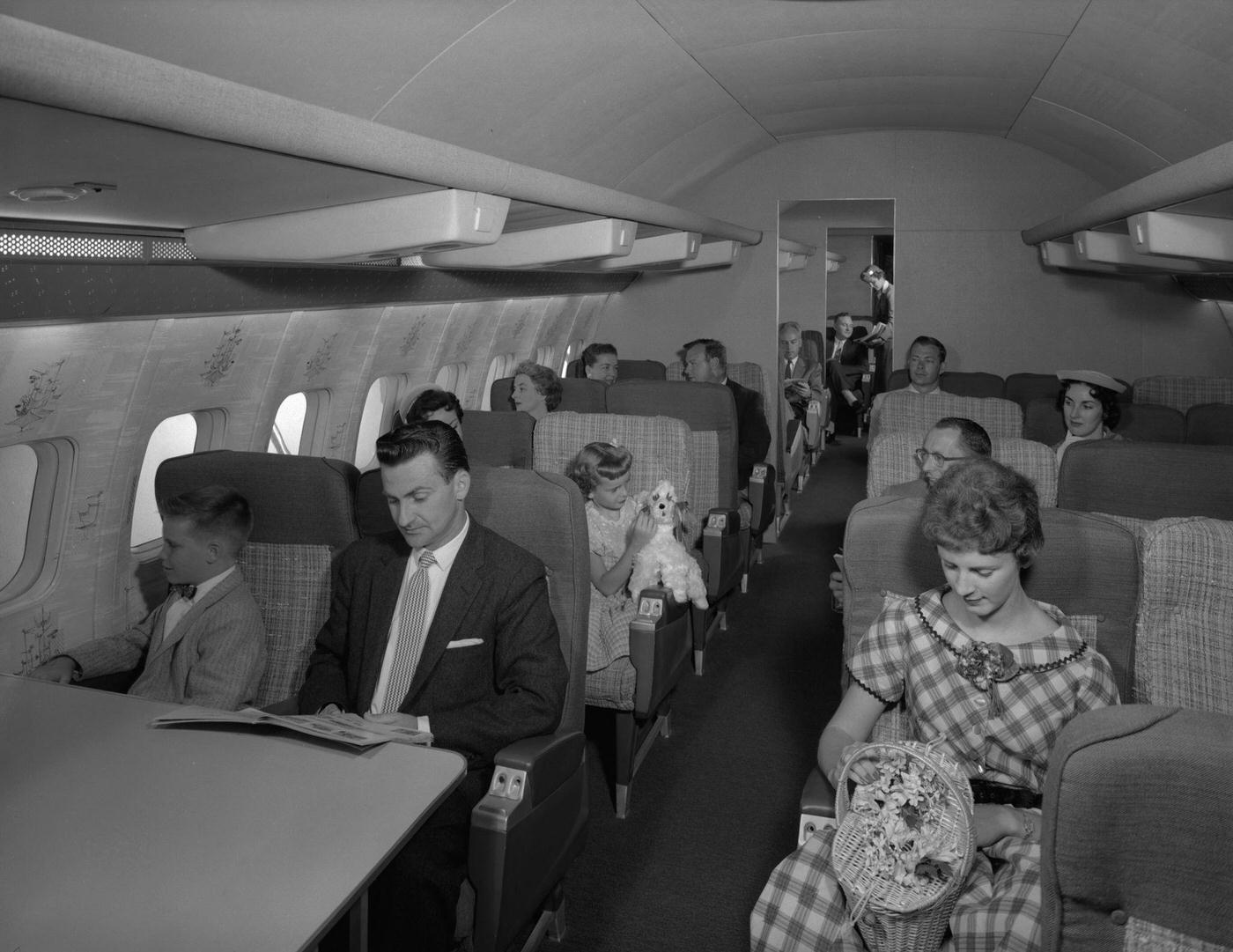
#109 Passengers prepare to take a nap on a Transocean Air lines Boeing 377 Stratocruiser in the mid-1950s. Transocean Air lines was a pioneer discount airline that flew between 1946 and 1962.
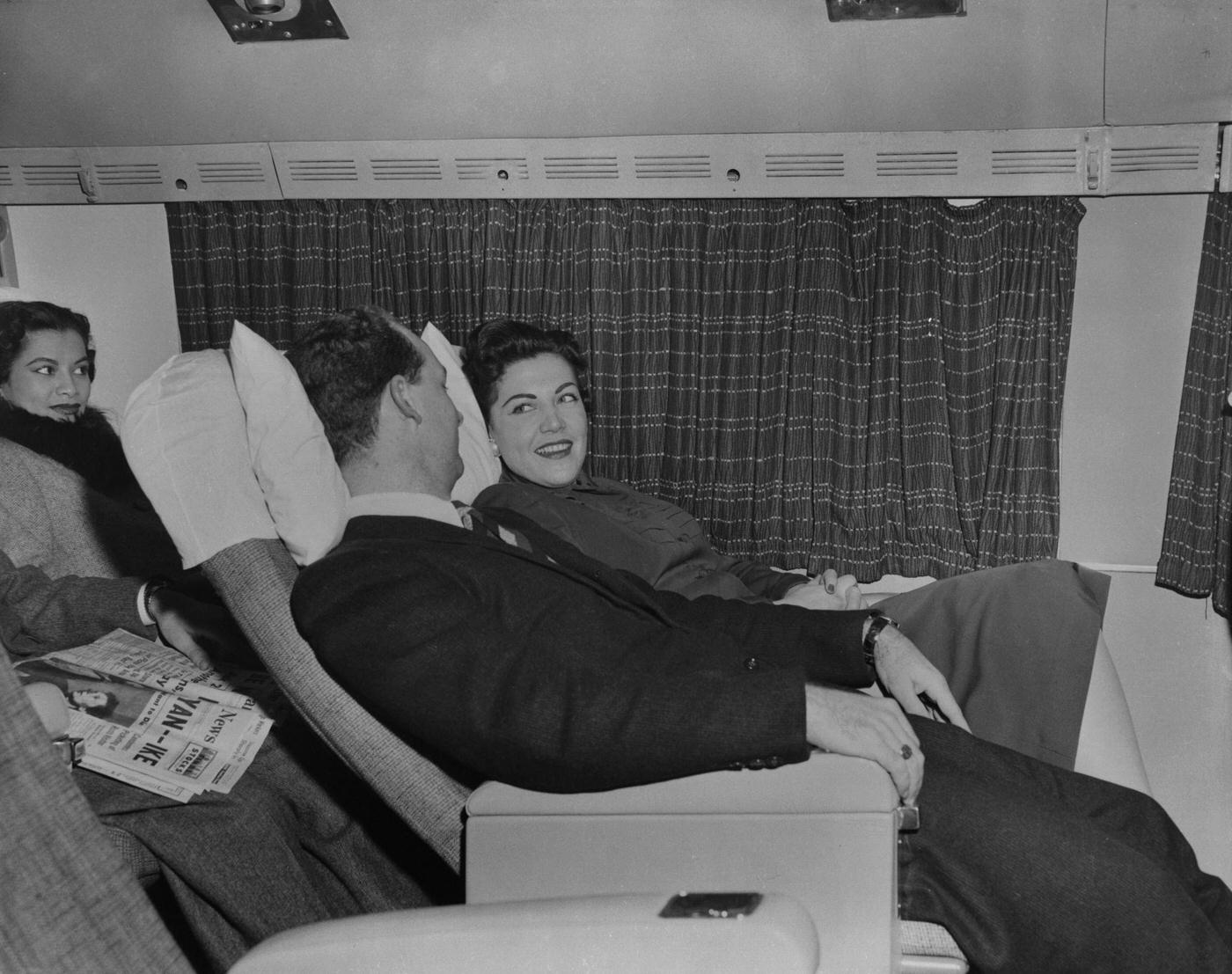
#110 Passengers on a Transocean Air Lines Boeing 377 Stratocruiser in the mid 1950s enjoy a light snack served by a friendly air hostess. Transocean Air Lines was a pioneering discount airline that operated between 1946 and 1962.
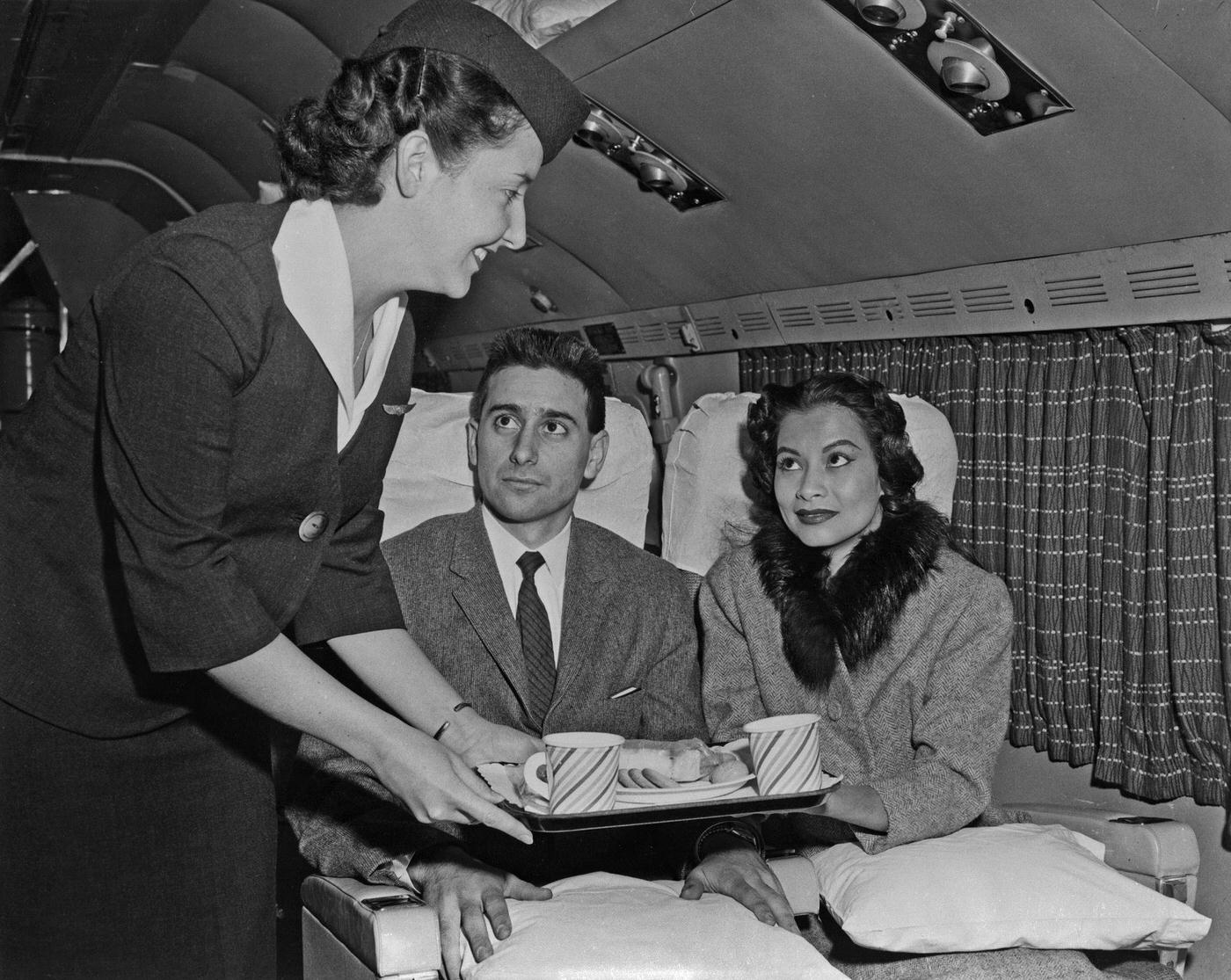
#111 During a flight on a Transocean Air Lines Boeing 377 Stratocruiser in the mid 1950s, an air hostess takes time to chat with passengers and ensure their comfort during the flight.
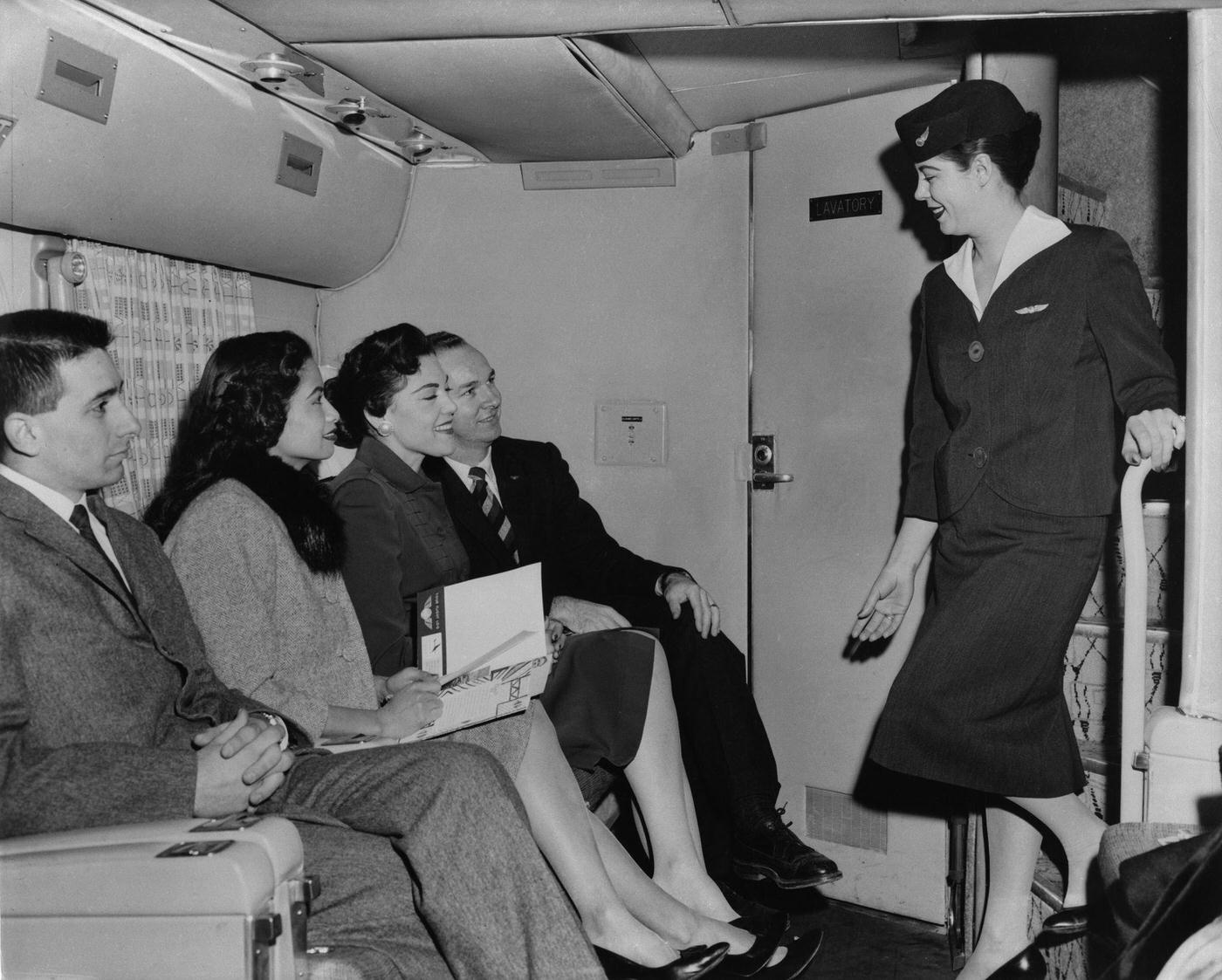
#112 Passengers take a moment to relax and enjoy a cigarette on a Transocean Air Lines Boeing 377 Stratocruiser flight in the mid 1950s. Transocean Air Lines was a pioneering discount airline that operated between 1946 and 1962.
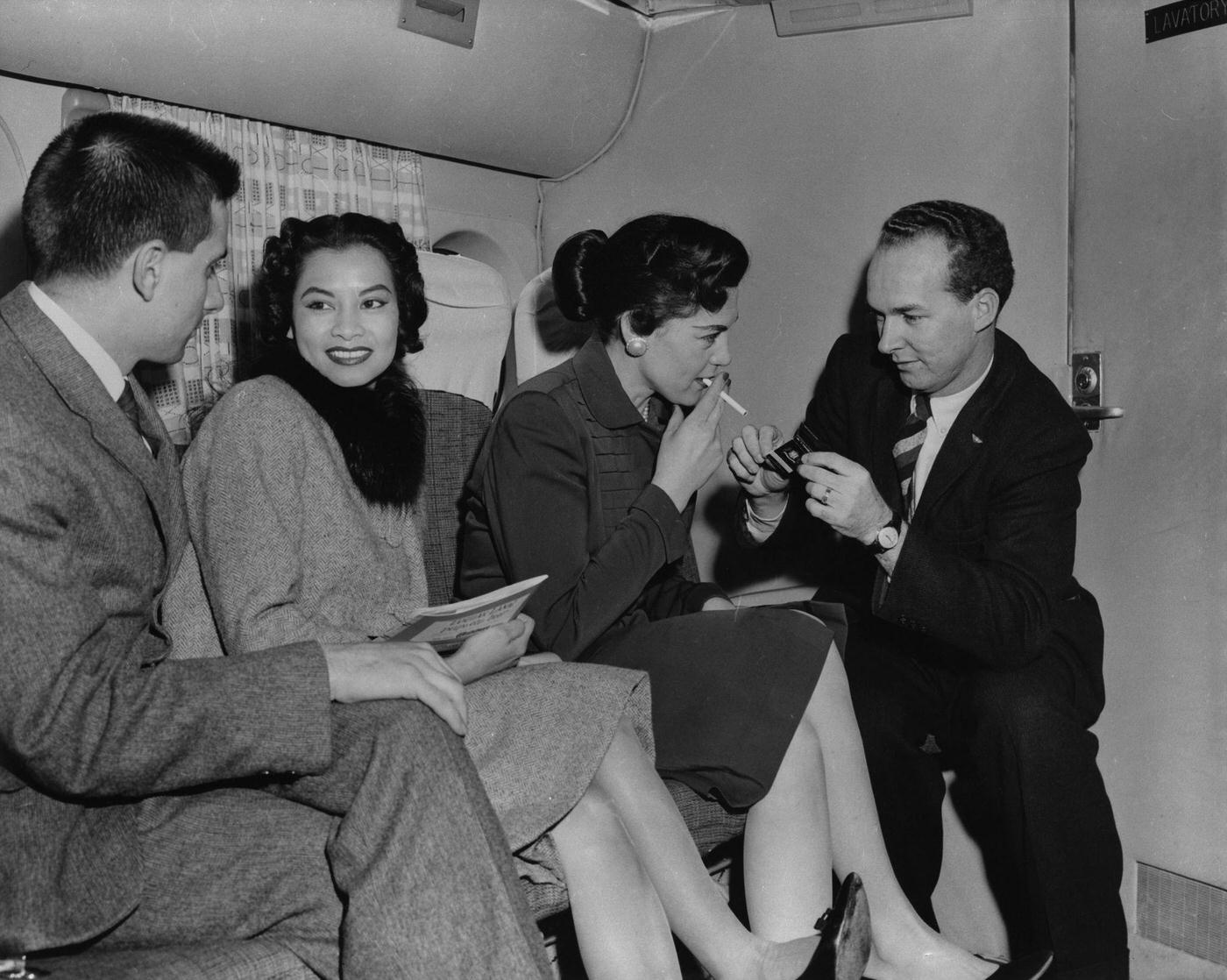
#113 An attentive air hostess serves passengers in the observation area of a Transocean Air Lines Boeing 377 Stratocruiser during a flight in the mid 1950s.
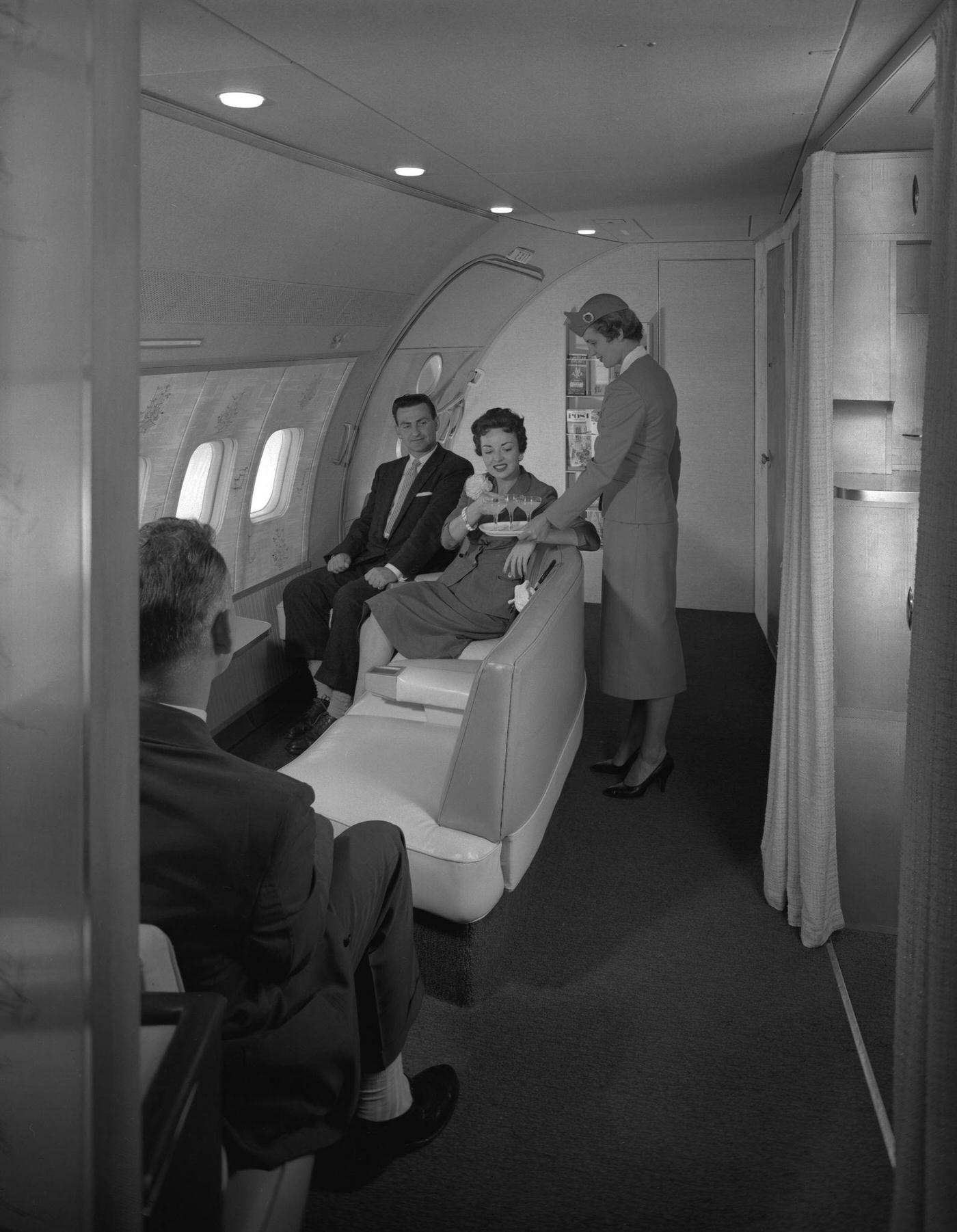
#114 Passengers are treated to excellent service on a Transocean Air Lines Boeing 377 Stratocruiser flight in the mid 1950s as an air hostess serves refreshments in the observation area. Transocean Air Lines was a pioneering discount airline that operated between 1946 and 1962.
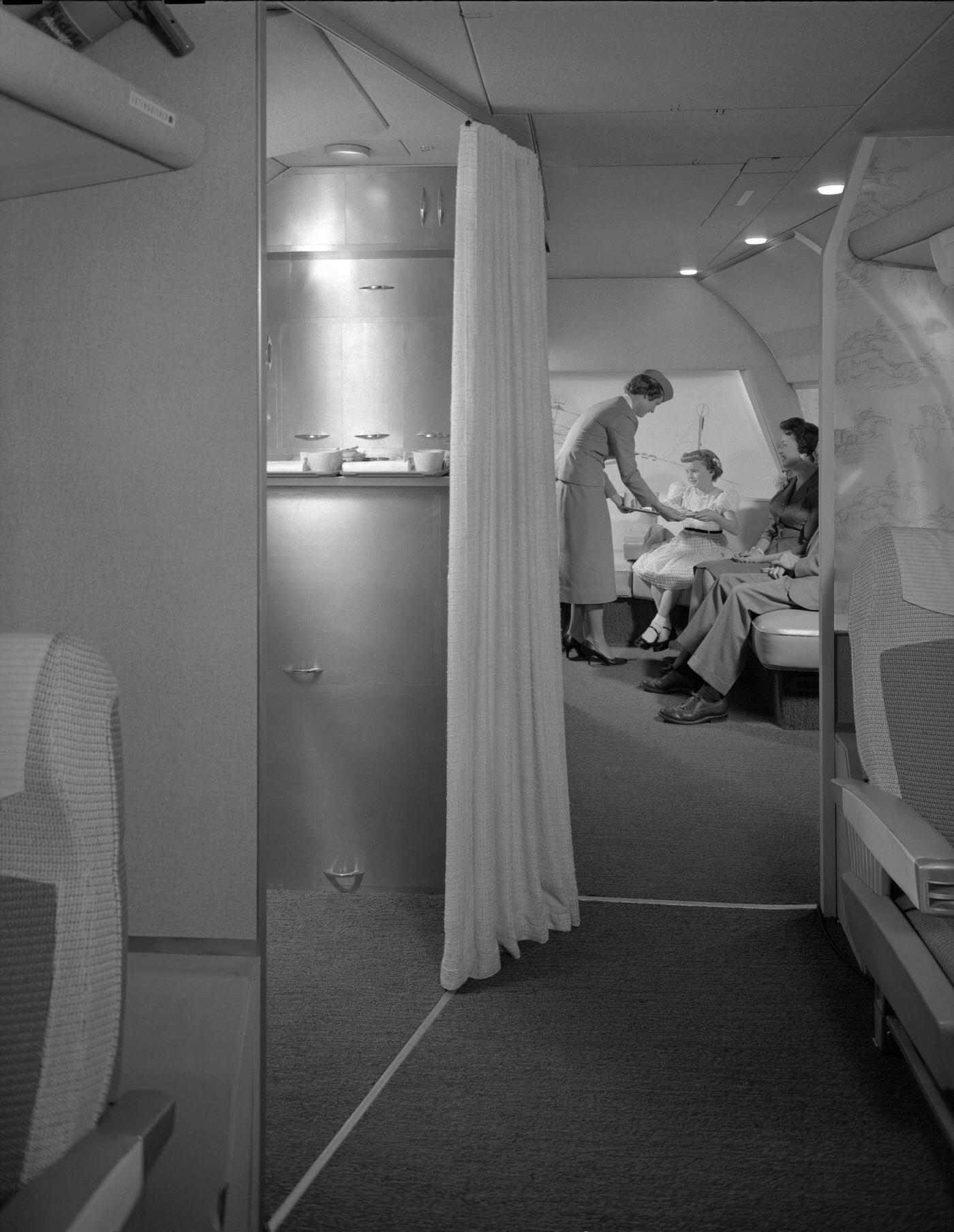
#115 Luggage being unloaded from airplane, 1950s
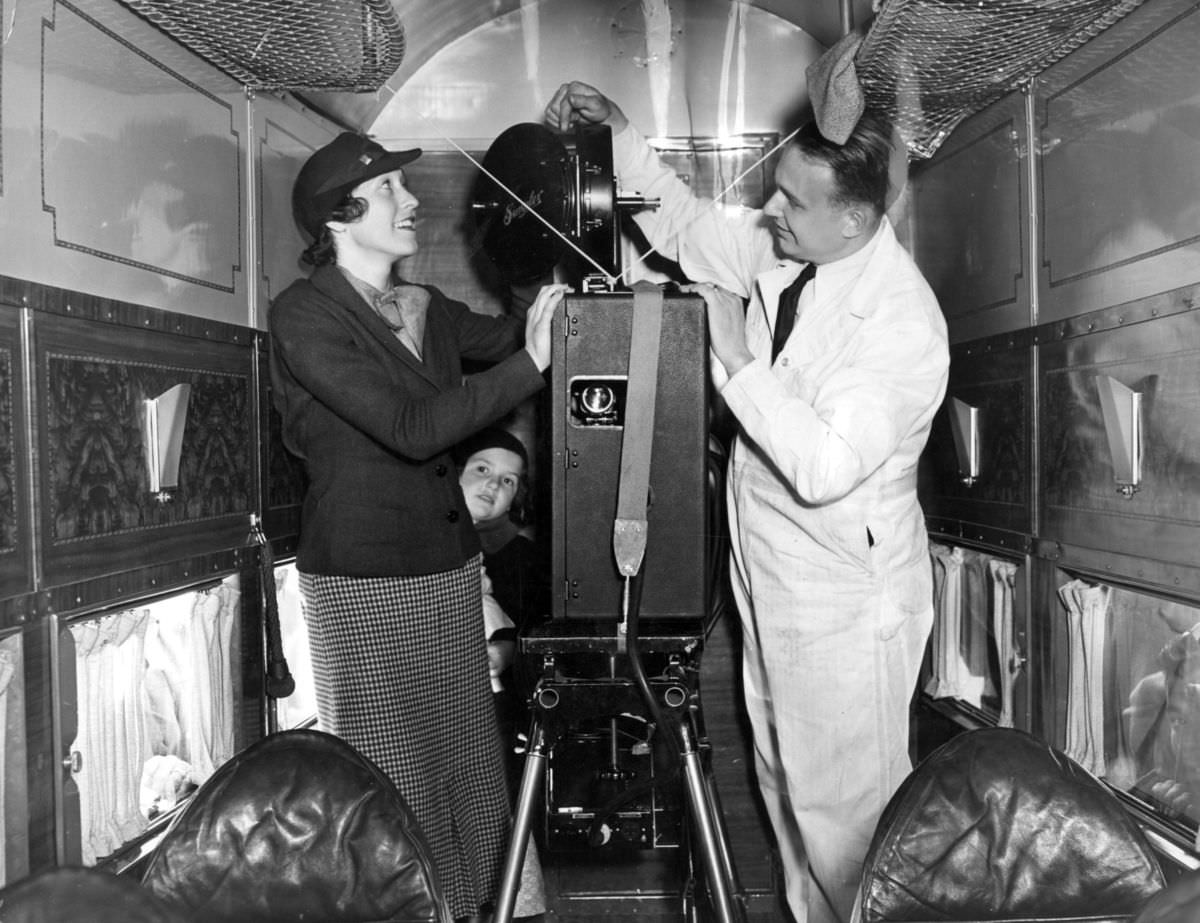
Written by Aurora Hale
I am a blogger, entrepreneur and small business coach. I'm an introvert and cat lover. My favourite hobbies are breakfast, lunch, and dinner.
Leave a Reply Cancel reply
Your email address will not be published. Required fields are marked *
Post Comment
© 2024 Bygonely
Share this Post 🥺
With social network:, or with username:.
Username or Email Address
Remember Me
Don't have an account? Register
Forgot password?
Enter your account data and we will send you a link to reset your password.
Your password reset link appears to be invalid or expired.
Privacy policy.
To use social login you have to agree with the storage and handling of your data by this website. Privacy Policy
Add to Collection
Public collection title
Private collection title
No Collections
Here you'll find all collections you've created before.
Hey Friend 🥺 Before You Go…
Subscribe to our newsletter and get the best historical content straight into your inbox.
Email address:
Don't worry, we don't spam
What Life Magazine Taught Me About Life
As a child, I saw the country in its photos, stories, and advertisements—and learned some hard truths about America.

I grew up in the 1950s, on a farm in Virginia miles away from any town or neighbors. For most of my childhood we didn’t have a television, so my three brothers and I amused ourselves fighting pretend Civil War battles in the fields and woods around our house or vying over card and board games that we spread across the living-room floor.
But for me, the best entertainment was always reading. I read for pleasure, for company, and for escape from my contained Virginia world. I could explore other places and imagine myself into other lives—lives that went beyond the limited choices available to my mother and the women of her circle, who were all ruled by the era’s prescriptions of female domesticity. The written word introduced me to what girls could do: solve mysteries, like Nancy Drew; brave the Nazis, like Anne Frank; demand change, like the protagonist of Susan Anthony: Girl Who Dared . Reading could provide, to borrow Scout’s words in To Kill a Mockingbird , a way to escape “the starched walls of a pink cotton penitentiary closing in on me.” And words could carry me beyond the gentle slopes of the Blue Ridge Mountains that rose behind our house. They offered a view of national and global affairs that caught me up in a sense of urgency. I was frightened by the fact that Sputnik had been launched and was passing by overhead every 96 minutes in its orbit of the Earth. I wondered how the Russians had beaten us into space. I was inspired by the courage of Hungarians fighting against communism. I was reassured by portraits of the confident prosperity of postwar America. Yet I felt growing doubt and unease as I read descriptions of the turbulence and conflict emerging to undermine it.
We didn’t receive a regular daily newspaper. My father was in the horse business, so The Morning Telegraph— the bible of thoroughbred racing—appeared every day at the breakfast table. I was proud when he taught me to decipher the complicated “Past Performance” charts printed for every horse running that day, detailing previous outings, weight carried, split times, and race outcomes: win, place, show, or also ran. The Telegraph contained all the news one could want about the world of the track, but next to nothing about the world of public affairs.
We did receive lots of magazines. My father bought Playboy as a one-off, tucking copies into corners of bookcases around the house where we children inevitably found them. I remember poring over the contents, always astounded by the women in the centerfolds, who looked like no one I had ever encountered, clothed or otherwise. Most magazines, however, were placed in a wooden rack in the den, next to a comfortable overstuffed chair under the stairs. It was an inviting place to read, with an inviting library of publications. Sports Illustrated , The Saturday Evening Post , and The Chronicle of the Horse were regulars, as was The New Yorker , which lured me in with its cartoons, though more often than not I had to ask my parents to explain why one or another was funny.
Above all, I read Life magazine. It’s hard to imagine, in today’s fragmented media environment, how any single source of information could reach more than a tiny fraction of the nation. In 1950, an estimated half of all Americans looked at Life every week. I was among them.
Read: ‘A work of art designed by the devil’
Returning to Life now, more than six decades later—looking through issue after issue covering the years of my childhood—I am struck by how the world of the 1950s it portrayed seems both so familiar and so strange. Davy Crockett coonskin hats, Hula-Hoops, pogo sticks, Elvis— Life chronicled crazes that reached even to rural Virginia. I recognize nearly every product pitched in the dozens of pages of advertising that filled each issue of the magazine, even though many of the products have not existed for years. The back cover of most issues displayed a full-page cigarette ad—for Lucky Strikes (“Cleaner, Fresher, Smoother”) or Camels (“It’s a psychological fact that pleasure helps your disposition! That’s why everyday pleasures—like smoking, for instance—mean so much.”) One news story Life published about childbirth depicted a woman smoking during labor. This startles me now, but back then I took for granted a home filled with clouds of smoke from my mother’s daily pack of Camels and my father’s cigars.
Multipage spreads in the magazine presented the newest models of enormous cars, designed, like our family station wagon, to transport all those Baby Boom children. These ads featured vehicles that were lavishly finned and often stylishly two-toned, though by the end of the decade smaller models such as the Nash Rambler, the Ford Falcon, and even the VW Beetle had begun to mount a challenge.
The food that appeared in Life now seems almost unimaginable.
A soda ad urged parents to add 7Up to babies’ bottles in order to coax them to drink their milk (suggested proportion: half and half). Another ad proclaimed the advent of National-Use-Up-Your-Leftovers-in-a-Jell-O-Salad Week. For an elaborate Southwest barbecue, “everything, even the meat, comes from cans.” In the mid-1950s, the average American family ate 850 cans of food annually. A special issue on food in January 1955 extolled “the servants who come built into the frozen, canned, dehydrated and precooked foods which lend busy women a thousand extra hands in preparing daily meals.” These busy women were perpetually in a hurry and would welcome such innovations as instant oatmeal, instant coffee, and Swanson’s TV dinners.
Life chronicled the emergence of aspects of contemporary existence that I tend to think of as present since the beginning of time. This was the decade when credit cards entered American life. The Interstate Highway System was launched in 1956. Passenger travel by jet began in 1958. In the first part of the decade, Life reported airplane crashes with disturbing regularity, perhaps because, astoundingly, air-traffic control existed only near airports, and pilots themselves were responsible for spotting other planes when they weren’t taking off or landing. When two pilots failed at this assignment over the Grand Canyon, in 1956, and 128 people died, the FAA at last took over responsibility nationwide. It is not surprising that my mother hated to fly and did her best for years to have her children avoid air travel.
If I had read Life in search of models for my adult life, I would have been hard-pressed to find much that was encouraging about what lay ahead. Every third or fourth cover featured a glamour shot of a woman—almost always an established or emerging movie star: Shelley Winters in a tub of bubbles, “Lovely Liz Taylor,” Joan Collins on a swing, Sophia Loren, Audrey Hepburn, Kim Novak. Such lives were clearly unattainable—and, to my mind, of little interest. Other kinds of stories about women were scarce and overwhelmingly reflected an unease with who American women were becoming. In 1955, an article titled “The 80-Hour Week” described housewives as the nation’s “largest, hardest working, least paid occupational group.” The middle-class white woman featured in the article did not overtly complain about her burdens, but her words conveyed a kind of stunned desperation. “I just wish I was away on a long trip,” she remarked.
In December 1956, Life published a special double issue on “The American Woman: Her Achievements and Troubles.” Once again, the focus was exclusively on middle-class white women, with an opening story about American “beauties” who hailed their derivation from “many racial stocks”—such as German and Scandinavian. The new freedoms that women enjoyed in postwar America, one contributor concluded, had created a “backwash” of “emotional and psychological problems.” As the issue’s editorial observed, the “American woman is often discussed … as a problem to herself and others.” Life seems to have been anticipating Betty Friedan’s classic, The Feminine Mystique , by nearly a decade.
I hope my childhood self skipped over these stories as I paged my way through the magazine. They could only have filled me with dread. Perhaps, though, I stopped to look at one article with a more inspiring message and direct relevance to my later life: “Tough Training Ground for Women’s Minds; Bryn Mawr Sets High Goals for Its Girls.” The college, according to the article, offered “some of the most intensive intellectual training available in any college in the U.S.” Nearly a decade later, Bryn Mawr would offer me a lifeline.
It was in many ways highly forward-looking of Life to offer such recognition to women—and, more especially, to acknowledge their discontent. One disgruntled reader assailed the editors for even taking up the subject. “Bah! With the world situation being as it is … you clutter up 172 pages of Life with women.” Life in fact regularly cluttered up dozens of its pages with women—promoting cars, appliances, beauty products, and fashion in the ads that filled the magazine. Of course, these women were not dissatisfied housewives but exuberant consumers. Such a portrait sat more easily with Life ’s readers than any effort to look beneath the surface of the myths about gender.
Throughout the 1950s, countless advertisements in Life displayed women encased in girdles—like Playtex’s aptly named “Magic-Controller”—and featured elaborately engineered bras as well as a diabolical apparatus first introduced in 1952 called a Merry Widow. The contraption extended from breasts to girdle top, ensuring that no flesh could escape appropriately corseted discipline. The doctrine of “containment” that had made its appearance as a watchword of U.S. foreign policy seems to have had its counterpart in feminine fashion. Men’s bodies were not subjected to such restraint, but their “unruly” hair required attention. Vitalis hair tonic promised to restore order, casting its oil upon waves of curls or windblown locks.
Read: ‘You’ve come a long way, baby’: the lag between advertising and feminism
Pale pink, proclaimed “fashion’s favorite color” in 1955, was everywhere: cars, stoves, typewriters, washing machines, refrigerators, toilets, bathtubs. Mamie Eisenhower was pink’s greatest champion, introducing it into the White House—“First Lady Pink” was the particular hue—as well as in plumbing fixtures in her own Gettysburg house. In my mind, pink was the color that marked girls as frail and sweet and irrelevant. Not unlike a girdle or a Merry Widow, pink seemed intended to contain.
Life ’s pages of advertisements were an advertisement for America, its abundance and its complacency. Complacency was reflected in much of the magazine’s news content as well. Americans in the 1950s, the magazine editorialized, were “mightily pleased with themselves.” But who were the Americans Life addressed and portrayed? With the exception of a butler serving a drink on a silver tray, every individual pictured in the hundreds of Life ads I’ve seen from the 1950s was white.
The magazine’s news stories exhibited more variety. Life regularly featured Black athletes and entertainers. Marian Anderson, Sidney Poitier, Harry Belafonte, W. C. Handy, Floyd Patterson, Bill Russell, Sugar Ray Robinson, Althea Gibson, and Willie Mays occupied categories in which mid-century white America had come to acknowledge Black achievement. In the course of the decade, the magazine began covering other Black Americans as well, but these stories were neither appreciations nor celebrations. Instead, they were focused on what was often called “the Negro Problem”—how Black people constituted a crisis in American life and a challenge to the idealized images of American democracy and prosperity that the magazine consistently foregrounded.
Starting with the Supreme Court’s Brown v. Board of Education decision in 1954, Life demonstrated steady support for the civil-rights movement, even as it sought to present the variety of positions in the escalating national debate about race. Voices of white southerners who opposed integration or thought it should not be mandated by federal courts were given serious attention. Life even enlisted William Faulkner to warn the nation: “Go slow now. Stop for a time, a moment.” The white southerner, Faulkner observed, “faces an obsolescence in his own land which only he can cure.” But Life ’s gestures at what it prized as objectivity and evenhandedness appeared alongside a clear commitment to Black progress and equality, evident in both editorial and news content. From 1954 to 1956, Life published 46 articles about civil rights, filling 160 pages of the magazine. Overwhelmingly, these chronicled the stories of Black efforts to advance integration and the ensuing white backlash of cruelty and violence—from racist schoolyard taunts to bombings, beatings, and lynchings.
In 1956, the magazine published a five-part series on segregation, introduced with a dramatic and disturbing cover illustration depicting an antebellum Charleston slave auction. Life ’s rendering of the nation’s past was remarkably critical in the context of both its time and its middlebrow identity; the magazine avoided any romanticized or sanitized version of America’s racial history. Disturbing portraits of the nation’s past included illustrations of Confederates shooting wounded Black prisoners during the Civil War, white people slaughtering Black people seeking political rights in Louisiana’s 1873 Colfax massacre, and a horrifying photograph from the early 20th century of a Black man being burned alive by a crowd of jeering white men.
Read: The magazine and Martin Luther King
These were not stories regularly told in the era’s history books. But they were images that riveted my attention, because the world they portrayed differed so markedly from the narrative of benevolent white paternalism and genteel racial harmony that I had absorbed since my earliest childhood. And they contrasted sharply with Life ’s own prevailing assumptions about 1950s America as a nation “up to its ears in domestic tranquility.” Contradictions like these and the denial on which they fed pushed me to question the assumptions of the world around me and the lessons I had been taught. I resented what I began to perceive as the blindness or even bad faith of those who had misled me. This generated the tone of indignation and surprise in a letter I wrote to President Dwight Eisenhower—“Mr. Eisenhower,” I called him—on three-holed notebook paper in 1957. “I am nine years old and I am white, but I have many feelings about segregation,” the letter began—so I discovered when I found the letter years later in the Eisenhower presidential archives, in Abilene, Kansas. “Please Mr. Eisenhower,” I entreated, “Please try and have schools and other things accept colored people.” How could I have not known why my school was all white? How could I have been taught about the ideals of American democracy and Christian love when such terrible injustices did not just exist but were so vigorously defended, often by the very same people mouthing civic and religious pieties?
Life was not merely recounting a distant past. In nearly every issue during the mid-1950s, the magazine confronted readers—in shocking photographs as well as words—with a new set of outrages, events never mentioned by my parents or teachers. Stories depicted the murder of Emmett Till in 1955, the lynching of Mack Parker in 1959, and the assaults on Black students seeking to integrate schools in Little Rock, Charlotte, Greenville—and even in the Virginia county adjacent to ours. In Life ’s pages, I encountered Black boys and girls close to my own age, including a number seeking to attend schools not far from my own home. I could see Black children, sometimes even younger than I was, bravely facing angry mobs as they seized a right I could simply take for granted.
Life had shown me photographs of Hungarian children risking their lives in the 1956 revolution, thousands of miles away. Books had introduced me to “girls who dared” in other eras and other places. But now children of my generation, children in my state of Virginia, were creating their own heroic stories. It was not the Montgomery Bus Boycott or the Mack Parker lynching or the 1957 Prayer Pilgrimage for Freedom in Washington—all of which were fully reported on in Life —that moved me to write to Eisenhower. It was school integration. I identified and empathized with these girls and boys. In many ways, the civil-rights movement of the 1950s and ’60s originated as a children’s crusade, a designation later explicitly used by civil-rights leaders when children—some as young as 6 or 7—filled the streets and jails of Birmingham, Alabama, in the summer of 1963. Half a decade earlier, the courage of such young people seeking justice had both inspired me and filled me with a sobering sense of responsibility.
What I was reading was more than stories. This was about how it might be possible—and even necessary—to live a life.
This article was adapted from Drew Gilpin Faust’s book, Necessary Trouble , published this month by Farrar, Straus & Giroux.

When you buy a book using a link on this page, we receive a commission. Thank you for supporting The Atlantic.
About the Author
More Stories
The Strange Ritual of Commencement Speeches
The Men Who Started the War
Simple Flying
The golden age of flying: how things have changed.

Your changes have been saved
Email is sent
Email has already been sent
Please verify your email address.
You’ve reached your account maximum for followed topics.
- Flying in the 1950s and 1960s was luxurious and glamorous, with spacious cabins and no class distinctions.
- Amenities on board included beds, lounges, and sophisticated meals prepared by esteemed chefs.
- Flight attendants were young, glamorous, and focused on passenger comfort, until safety became a priority in the 1980s and 1990s.
The golden age of travel in the 1950s and 1960s was the epitome of glamour and luxury. Flying was a huge event and only for the relatively wealthy. It was a prestigious and glamorous experience to have. What made it so special and different to air travel today? Let's go back in time.
In the cabin
Aircraft cabins were less crowded and the seats had more legroom and space to move around. The seats were large and comfortable, no matter how long or short your flight. You could recline your seat without offending anyone. The seat pitch was between 36–40 inches today compared to that of 28 inches today. The aisle was much wider than today's aircraft. There was no distinction between first class and economy, it was all one cabin.
Love aviation history ? Discover more of our stories here!
Other amenities onboard
Some aircraft had beds on board like bunks with a privacy curtain in which passengers could sleep. It was not unusual for passengers to find a piano lounge or bar on the aircraft, where they could relax and socialize. Cocktails were served at sophisticated parties and the passengers could enjoy themselves and possibly forget their fear of flying. Passengers were given 'postcards from the sky' to send to friends and family, which became very collectible.
The experience
Traveling on an aircraft was a luxury experience that followed the cruise liner experience. Airlines focused on comfort and luxury, and it was not just a seat getting you from A to B. It was something to enjoy and tell your friends about. There were no pajamas allowed onboard, it was a fashion show with everyone dressed in their finest attire. Passengers dressed in a very smart and formal manner. There were no baggage limits or fees and items were delivered by courier back to their homes.
Inflight meals
There was no sign of meals in a foil tray back in the day. Menus were created by esteemed restaurant chefs. Mealtimes were a gourmet experience and there were multiple courses. Ice sculptures adorned with caviar were normal. Soup would be served from a tureen and lobster was often an appetizer. Roast beef and prime rib could be freshly hand carved from the silver trolley. Of course, white linen, silver cutlery and fine china were the order of the day. Champagne, brandy and fine French wine were abundant.
Inflight smoking
In the 1950s and 1960s, smoking onboard an aircraft was completely normal. Flight attendants would hand out cigarettes and cigars and light them for the passengers. Onboard fires became an issue when hot cigarettes would catch light to hand towels in the lavatory, enforcing fire detectors and suppressors in later years. The last smoking flight took place in 2000.
How Have Aircraft Tugs Evolved Over Time?
Tugs are common for jet aircraft pushback now, with use expanding significantly since the development of jets.
Flight attendants
The flight attendants were young, single and glamorous and had to retire before the age of 30. They led a glamorous lifestyle, jetting around the world on extensive trips. They had designer uniforms, often with gloves and a hat and could never put on weight. The emphasis was on comfort in the cabin and making it a great experience for the passengers. This changed in the 1980s and 1990s, when safety became the focus of the role.
Aviation safety
Security at the airport was a relatively simple process, a bit like going to a bus stop, until hijacking became more common during the late 1960s. In the US alone, between 1968 and 1971, there were 130 hijackings. People were scared of flying as it was a relatively new form of travel for most. In fact, it was quite a dangerous time to fly and accidents were common. The aircraft cabin was often unpressurized, so it could be loud in the cabin. Cigarettes and alcohol had probably quelled fears.
Being A Flight Attendant In The Golden Age Of Flying
Living the jet set lifestyle.
In the 1970s, flying became more affordable for the public. A TWA flight in 1953 from Chicago to Phoenix cost $138, which would be $1200 in today's money. People saved up money in order to fly. In the 1980s, ticket prices came down even further, allowing more people to be able to fly. In the 1970s and 1980s, there was a lot of change in the aviation industry and there was no need for glamour and luxury anymore. The golden age of travel was truly over but bringing with it a chance for more people to fly than ever before and, of course, better safety standards.
- flight attendants
July 6, 2020
Art , Vintage Ads
Vintage Ads: Travel in the 1950s
Whether it was by bus, plane, or train, these 1950s ads from The Saturday Evening Post showed that you could travel in style!
Post Editors
- Share on Facebook (opens new window)
- Share on Twitter (opens new window)
- Share on Pinterest (opens new window)
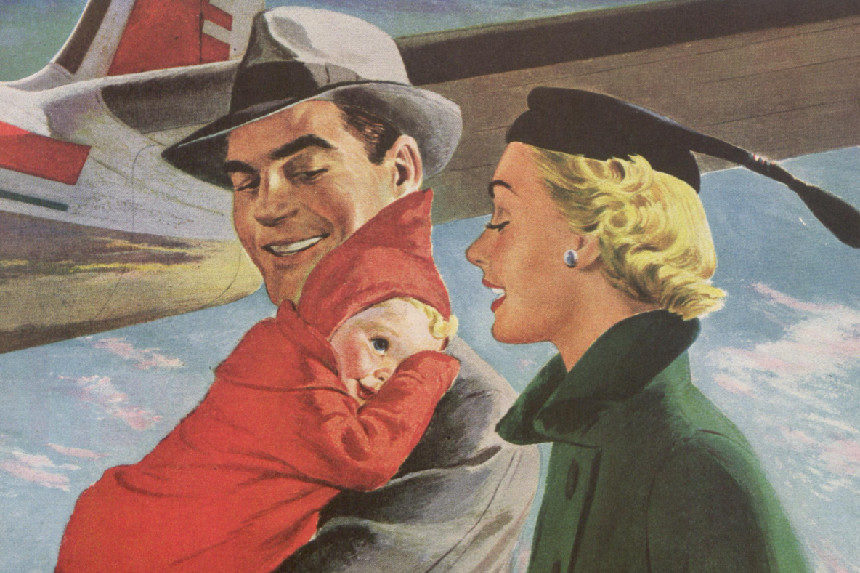
Weekly Newsletter
The best of The Saturday Evening Post in your inbox!
Want to look at all of our ads from the 1950s? Become a member ! Members receive 6 issues of The Saturday Evening Post per year plus complete access to our online archive dating back to 1821.
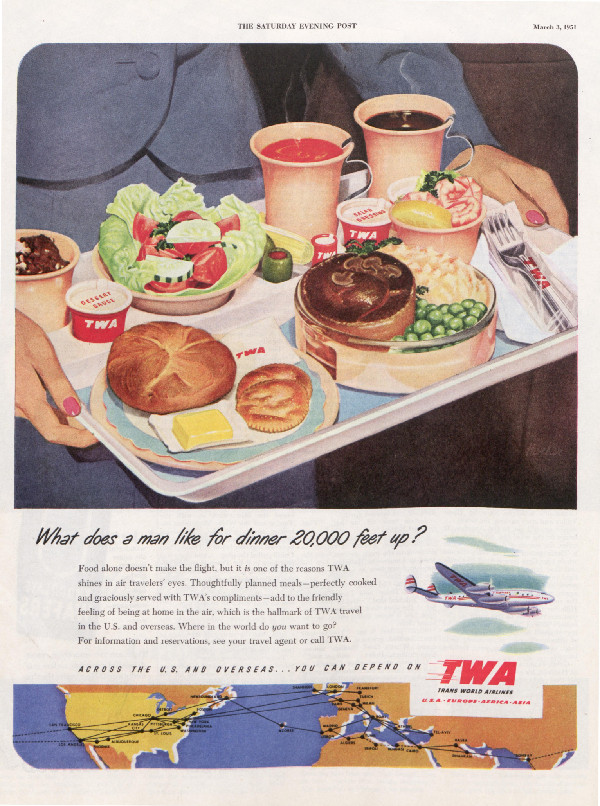
Become a Saturday Evening Post member and enjoy unlimited access. Subscribe now
Recommended

Aug 13, 2024
Art , The Art of the Post
The Art of the Post: Fun at Comic-Con
David Apatoff
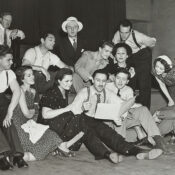
Jul 31, 2024
Art , History
Let’s Put on a Show! Hallie Flanagan and the Federal Theatre Project
Amelie Allen
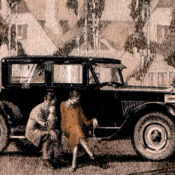
Jul 17, 2024
Archives , Vintage Ads
Vintage Ads: Big Name Cars
Jeff Nilsson
Looking for work by William (Bill) Zdinak. Do we know who painted some of these ads?
Hi my name is Stephanie Lawton, I work as an unpaid volunteer Exhibition Officer at the Solway Aviation Museum, Carlisle, Cumbria UK (Registered Charity) I would like to ask if you would grant me permission to use the image General Motors poster November 18, 1950, as part of a display for next year on The History of Aviation Thank You Stephanie
The 50’s were wonderful for me: Home from Korea; Meeting and marrying the Love of My Life; starting a family and buying a home. Rock and Roll replacing the great old songs was the only downer and I finally got used to it.
Yes, the 50s, 60s, 70s etc. were all wonderful; but my granddaughter is 10, and TODAY is her “good old days”.
I wish people would stop living in the past, always yearning for “the good old days”.
As a Korean War vet, I returned to civilian life, a car, marriage, kids, jobs, college, and GI Bill home ownership in ’55. The Post artwork seemed to document our exciting, busy, and joyful lives.
I often yearn for the fifties. I graduated from high school in 1957. The music especially so far surpassed anything I hear today. My sister and I sang duets with many of them, and PBS still features some of the remaining musicians,j and I never cease loving to hear them. I remember when Elvis became popular. We thought his music was weird at first, but as we moved into the 60’s of course (if my memory serves me right), it became favorites.
What surprised me from your beautiful pictures was the amazing artwork. I remembered that all ads and magazine picture at one time were not photos, but I really had forgotten that was true as late as the 50’s. Big surprise. I do remember them, though, so very well. Thank you Saturday Evening Post
I love all of these ads with their beautiful, enticing artwork. Especially the 2nd from the bottom for Capital Airlines. When I first saw the main picture at the top I guessed between 1951-’53. ’52 it was. The ’50s, like the 1960’s and ’70s that followed, all had 3 distinctive sections of early, mid and late. That’s long gone with nearly everything else, of course. These are all great examples from early section. Planes, trains, buses, luggage and early American Express!
After all those difficult years of the Depression and World War II came hard won better times which were wonderful, while they lasted.
Your email address will not be published. Required fields are marked *
We’re fighting to restore access to 500,000+ books in court this week. Join us!
Internet Archive Audio

- This Just In
- Grateful Dead
- Old Time Radio
- 78 RPMs and Cylinder Recordings
- Audio Books & Poetry
- Computers, Technology and Science
- Music, Arts & Culture
- News & Public Affairs
- Spirituality & Religion
- Radio News Archive

- Flickr Commons
- Occupy Wall Street Flickr
- NASA Images
- Solar System Collection
- Ames Research Center

- All Software
- Old School Emulation
- MS-DOS Games
- Historical Software
- Classic PC Games
- Software Library
- Kodi Archive and Support File
- Vintage Software
- CD-ROM Software
- CD-ROM Software Library
- Software Sites
- Tucows Software Library
- Shareware CD-ROMs
- Software Capsules Compilation
- CD-ROM Images
- ZX Spectrum
- DOOM Level CD

- Smithsonian Libraries
- FEDLINK (US)
- Lincoln Collection
- American Libraries
- Canadian Libraries
- Universal Library
- Project Gutenberg
- Children's Library
- Biodiversity Heritage Library
- Books by Language
- Additional Collections

- Prelinger Archives
- Democracy Now!
- Occupy Wall Street
- TV NSA Clip Library
- Animation & Cartoons
- Arts & Music
- Computers & Technology
- Cultural & Academic Films
- Ephemeral Films
- Sports Videos
- Videogame Videos
- Youth Media
Search the history of over 866 billion web pages on the Internet.
Mobile Apps
- Wayback Machine (iOS)
- Wayback Machine (Android)
Browser Extensions
Archive-it subscription.
- Explore the Collections
- Build Collections
Save Page Now
Capture a web page as it appears now for use as a trusted citation in the future.
Please enter a valid web address
- Donate Donate icon An illustration of a heart shape
Bucks County Traveler Magazine November 1950
Bookreader item preview, share or embed this item, flag this item for.
- Graphic Violence
- Explicit Sexual Content
- Hate Speech
- Misinformation/Disinformation
- Marketing/Phishing/Advertising
- Misleading/Inaccurate/Missing Metadata
plus-circle Add Review comment Reviews
Download options.
For users with print-disabilities
IN COLLECTIONS
Uploaded by Chase Palmer on August 31, 2024
SIMILAR ITEMS (based on metadata)
Space exploration as it was imagined in the '50s
By Nathan Ingraham
Share this story
:format(webp)/cdn.vox-cdn.com/uploads/chorus_asset/file/14408300/408082main_fd10_full.1419979773.jpg)
Back in the 1950s, when the allure of space travel captured the imagination of a nation, Collier's magazine fed that desire with a series of articles that outlined in detail how the US would explore the reaches of space. While the scenarios detailed in the magazine over the span of two years didn't come true, it wasn't for lack of talent: Collier's editor Gordon Manning put together a dream team of scientists and artist to bring their vision to readers, a vision that included a 50-man moon expedition by 1964 and a manned mission to Mars not long after.
io9 has a great look at the endeavor , with plenty of detail on each step of the scenario dreamed up by Manning's team — and just as importantly, a wide variety of the original illustrations are included as well. The circular space station, in all its 2001 glory, is a particularly impressive piece of art. Of course, to built the massive structure would have required an estimated launch every four hours at the height of construction. For all the details behind this wildly ambitious and visually stunning space exploration that was not to be, head on over to io9.
What to expect from Apple’s ‘It’s Glowtime’ iPhone 16 event
Sony is taking concord offline on september 6th after disastrous launch, the remarkable paper pro is as outrageous as it is luxurious, canva says its ai features are worth the 300 percent price increase, android 15 is out — but it’s not ready for your phone yet.
More from TL;DR
:format(webp)/cdn.vox-cdn.com/uploads/chorus_asset/file/22311018/splatoon3.jpg)
You should play Splatoon with your family
:format(webp)/cdn.vox-cdn.com/uploads/chorus_asset/file/25286461/247024_Pilot_Pen_CVirginia.jpg)
Why can’t I buy a refillable version of my favorite pen in the US?
:format(webp)/cdn.vox-cdn.com/uploads/chorus_asset/file/25261414/1245969948.jpg)
Car-tech breakup fever is heating up
:format(webp)/cdn.vox-cdn.com/uploads/chorus_asset/file/6778339/akrales_160629_1114_A_0269.jpg)
GM should just bring back the Chevy Volt

ST Pete's Business Daily
(and a whole lot more), sign up for a free lifetime subscription, and take your seat at the table.

Vintage St. Pete: Piers through the years
This story appears in the book Vintage St. Pete: The Golden Age of Tourism and More ( St. Petersburg Press ).
No one in all Florida rejoices more than I in the development of your great city, with its splendid schools and churches … You have added an important milestone in your progress of development, and I have the greatest optimism for St. Petersburg’s future, and I predict even greater progress and prosperity.
U.S. Senator Park W. Trammell, former governor of Florida, d edicating St. Petersburg’s “Million Dollar Pier,” November 25, 1926
There’s been one long pier or another on St. Pete’s eastern waterfront, extending the local footprint into Tampa Bay, for 131 years. The first one, erected in 1889, was an extension of the Orange Belt Railroad, which was itself something new in the city.
Ships with deep drafts could come into the bay and dock at the 3,000-foot Railroad Pier, as it was known, and its cargo would be unloaded directly into boxcars.
Conversely, St. Petersburg exported three million pounds of fish per year in the 1890s. Processing and ice houses were added to the Railroad Pier, as was a small bath house and toboggan-style slide for recreational use (getting to the Gulf beaches, in those days of palmetto thickets, rattlesnake scrub and crude dirt thoroughfares, was difficult for most if not all of the citizenry).
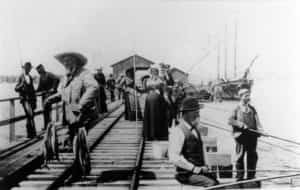
The 1889 Railroad Pier
The arrival of another structure, the 1,500-foot Brantley Pier and its roomy bath house, set the stage for a battle between industrial and recreational use. The Brantley Pier was replaced by the Electric Pier, which featured electric lamp lights and ran a visitor trolley along an electrified track. Fishing off the Electric Pier became a popular pastime.
The City purchased several miles of waterfront in 1910, to be used as dedicated park space, effectively ending the battle.
Three years later, the waterfront park system received a new structure, the St. Petersburg Municipal Recreation Pier, strong and sturdy enough to support two-way vehicular traffic. At its zenith was a shaded wooden pavilion, where visitors could sit quietly and watch the birds and the boat traffic on Tampa Bay.
There was an indoor saltwater swimming pool; this structure, a few years later, became the home of the St. Petersburg Museum of History.
The Electric Pier, just 10 feet south of the Municipal, was demolished in 1914. The Railroad Pier would stand, weak and decaying, until it was taken down in 1952.

1913: The city’s first Municipal Pier, left, and the Electric Pier.
The Hurricane of 1921 destroyed the Municipal Pier, and the City set about to design and build a sturdy replacement (also destroyed in the storm was the privately-owned “Fountain of Youth Pier,” at 1st Street and 5th Avenue South).
The new city pier had to be something special, too, because tourism – steady, warm weather, beaches and plentiful citrus fruit – was now St. Petersburg’s calling card.
It was Lew Brown, the flamboyant editor of the Evening Independent newspaper, who began a $1 million fundraising campaign. Brown and his readers raised $300,000 towards the project he called the “Million Dollar Pier,” and through a bond issue the City came up with the rest.
And so the “modern era” of city-owned concrete piers began. Extending 1,452 feet into the bay, the new Municipal Pier was formally dedicated on Thanksgiving Day, Nov. 25, 1926, with a crowd of 10,000 in attendance.

The “Million Dollar Pier,” bay view. Postcard image.
It was one of the grandest celebrations in St. Petersburg history as the city’s first airfield, named for local developer Walter Fuller, was dedicated on the same day. The 32-acre Fuller Flying Field was located between 22 nd Avenue North and Tyrone Boulevard, the site of contemporary Tyrone Square Mall.
The airfield named for naval aviator Albert Whitted, still in existence today, would not break ground for another four years.
The day was filled with parades, band performances, airplane flyovers and speedboat demonstrations. As it was Thanksgiving, there were public, formal religious services.
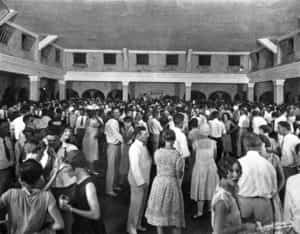
A public dance inside the casino.
The Pier, of course, was the main attraction, as it was something every citizen could enjoy. At the head was a Mediterranean Revival-style casino building, which included a ballroom for concerts, dances and conferences; the office space in the upper level was home to the studios of WSUN, the city’s first radio station (WSUN-TV, the first TV station, broadcast from the pier between 1952 and 1970).
Spa Beach was dredged from the bay bottom, created as the downtown alternative to the (relatively) far-away Gulf shore.
Both beach and pier were fully segregated at the time (as had been the “spa” saltwater swimming pool); in fact, it would be 1959 before blacks were allowed to partake of either.

The stone, roofless building resembled an Egyptian temple and bore a likeness of the sun god, Ra. Images of snakes and birds decorated the edifice, known as the Temple of the Sun. Admission, locker, soap, a towel and shower cost 35 cents. Once inside, guests discovered numerous chairs and benches amid pure white sand. Capacity was 500 people, and the Solarium averaged 400-600 guests daily in season.
St. Petersburg: An Oral History, Scott Taylor Hartzell
In 1961, despite the addition of modern amenities, including private showers and massage rooms, public disinterest forced the Solarium to close. It was right around this time, too, that civic and community voices began to call for replacement of the outdated, dirty and festering “Million Dollar Pier.”
The wrecking ball came for the casino structure in January, 1967.

St. Petersburg was struggling with a serious image problem in the late 1960s; the perception that it was “God’s Waiting Room,” a dull, sleepy hamlet where old folks lived in trailer parks, napped in the palm tree shade and played 24/7 shuffleboard, had permeated the national consciousness. There was, to be precise, absolutely nothing cool or exciting about St. Petersburg.
In short order, city officials order the removal of the trademark green benches that dotted downtown (not a moment too soon for black residents, who considered the originally off-limits benches unpleasant symbols of the city’s segregated past).
Money was secured for a newer, more contemporary pierhead design.
Architect William Harvard got the contract for his “Inverted Pyramid,” which was wide on top and narrow at the bottom – the idea, he explained, was to give those at ground level a better and less-obstructed view of Tampa Bay.
Plans called for the five-level, $4 million project to debut during the 1970-71 winter season; delays and cost overruns pushed it back to 1973.

Emcee Marshall Cleaver introduced the Stockdales – Adele and Julian – who will provide entertainment in The Pier’s Brassaloon starting today. Real troupers, the daughter and father, on organ and guitar respectively, led the crowd in “When the Saints Go Marching In,” with enthusiastic hand-clapping to warm numb fingers. One thought of USO shows in Alaska.
The public was allowed in starting Monday, Jan. 15. The Pier included four restaurants, a cocktail lounge and an ice cream bar, all managed by the Marriott Corporation, plus shops, meeting rooms and the requisite baithouse for anglers.
A tram called the Pier Tug made the rounds from the waterfront to the pier head for those who did not care to drive, or walk.
Bayfront Center manager Al Leggat, whose nearby facility was also city-owned, gave Bothwell some good news in June. “Here at the Bayfront, we had 883,000 patrons in a year – October 1971 to October 1972. In half that time, The Pier drew almost as many. You know, for the first time in history the city’s making quite a bit of money from the pier.”
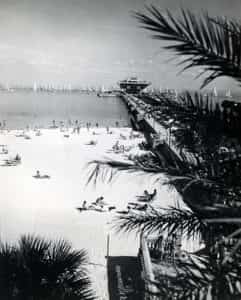
The Times reported that year that the City of St. Petersburg would have to subsidize the operation with $177,000 to keep it solvent.
Under consideration was a proposal by an Orlando consulting from to modify the waterfront area into “Pier Park,” with a country fair-type atmosphere including a floating restaurant, rides and games, a botanical garden and more.
“The trouble with downtown is that it isn’t thought of as a place to go,” said city community development director Bruce Hahl.
“I don’t want to give another penny to outside firms when we could do the work ourselves,” councilman Dick Martin said.
Mayor Corrine Freeman was in favor of the overhaul. “The only way the pier is going to be successful is people using it,” she explained. “Tearing it down is not the answer. With the expertise of these consultants, we should be able to have something creative and attractive.”
Meanwhile, the St. Petersburg Police Department assigned extra foot patrol officers to the pier, “to ward off drunks and other undesirables hanging around,” according to the Times .
Pier Park (with a budget of $74 million) was again proposed in the 1980s, and again vetoed.
Despite numerous overhauls, some of them expensive and many more of the simple, Band-Aid variety, The Pier, with its long-outdated Brady Bunch look, stood sentinel over Bayshore Drive and the bay until 2013, when the city finally shuttered it; it was taken down two years later, at a cost of $15 million.
The Columbia Restaurant, Cha Cha Coconuts and Johnny Reno’s Waterfront Restaurant & Watering Hole were no more, and the smattering of shops that remained, four decades after the Pier’s debut, faded into nostalgia.
The next step in this long civic adventure began July 6, 2020, when the new $92 million pier opened, during the Covid-19 pandemic. With four restaurants, several recreation areas and more greenspace than many city-owned parks covering 26 acres, it is now referred to as the Pier District.
The Pier represents something special to the people of the Sunshine City. It’s an integral part of our skyline. It’s long been a fundamental St. Petersburg icon. So I understand the importance of the Pier to the people of this city … I know that we are going to deliver an exciting new Pier that makes this city proud.
St. Petersburg mayor Rick Kriseman, May 14, 2014
Photographs and postcard images provided by StPetersburgPier.com, the St. Petersburg Museum of History and the Florida Archives.

April 22, 2022at11:48 am
I totally agree with Lillian, King and Brenda. 92 million wasted.
February 26, 2022at5:37 pm
I don’t like the new pier
June 16, 2020at12:53 am
In all fairness for $92 million I would never of built that pier. That pier ugly and I’m very ashamed of Saint Petersburg for having outside developers build that type of pier.
James Hendrix
June 15, 2020at8:23 pm
Agreed. It looks finished. Let us go out and discover our new park. I see the Eichelman sculpture is even back up.
Lillian Koziol
June 15, 2020at8:23 am
The new Pier looks like a Mitsubishi car dealership.
June 15, 2020at12:13 pm
WHY do we the people have to wait for an unveiling ceremony? If the pier construction is completed then open the gates. We do not need/want a political speech, we paid for it so just open it!
Your email address will not be published. Required fields are marked *
Add your idea below. Review Catalyst posting guidelines here.
Subscribe to the St Pete Catalyst Daily Spark newsletter
By posting a comment, I have read, understand and agree to the Posting Guidelines .
Subscribe to the Daily Spark
Get the latest right to your phone
You may like

‘Gronklane’: Salad restaurant welcomes Bucs, Patriots legend

Partners break ground on underserved community’s only park

PSTA makes history with overdose-aid initiative
Share with friend
Enter the details of the person you want to share this article with.
- vatican city
What to Know About Pope Francis’ Historic Asia Trip

P ope Francis has embarked on the 45th and longest overseas trip of his papacy, touching down Tuesday in Jakarta, Indonesia for the start of a busy 12 days of activities, despite concerns about the 87-year-old Catholic leader’s deteriorating health.
“Please pray that this journey may bear fruit,” he posted on X on Monday announcing the start of the “Apostolic Journey,” which had originally been scheduled for 2020 but delayed due to the COVID-19 pandemic.
Today I begin an Apostolic Journey to several countries in Asia and Oceania. Please pray that this journey may bear fruit. — Pope Francis (@Pontifex) September 2, 2024
Francis’ first stop on the journey, in the world’s largest Muslim-majority country where about 87 percent of the population practice Islam, reflects his enduring efforts through his visits across the world to reach out to Catholics in regions where they are minorities and to foster interfaith cooperation.
Indonesia’s eight million Catholics make up just 3 percent of the population. “There are not many Catholics in Indonesia, so it shows that we are being acknowledged and we are being counted,” a local told Al Jazeera . “It shows we have a role to play in Indonesia.”
After meeting with Indonesian outgoing President Joko Widodo as well as representatives from civil society and local clergy on Wednesday, Francis is expected to hold a mass for some 70,000 people at a stadium on Thursday.
The pope also plans to attend a meeting with other religious leaders on Thursday in Jakarta’s Istiqlal Mosque. The mosque, the largest in Southeast Asia, is connected to the capital’s main Catholic cathedral via an underground “tunnel of friendship,” built in 2020 as a symbol of religious harmony.
Francis will sign an interfaith declaration with Nasaruddin Umar, the grand imam of Istiqlal Mosque. Umar told the Associated Press that he and Francis will “discuss the common ground between religious communities and emphasize the commonalities between religions, ethnicities and beliefs.” Umar also said that the choice to make Indonesia the pope’s first stop makes “the Muslim community proud.”
In 2019, Francis became the first pontiff to visit the Arabian Peninsula, where, together with the grand imam of al-Azhar Sheikh Ahmed al-Tayeb, he signed a historic interfaith document and pledged to work together to tackle extremism. In 2021, Francis met with Iraq’s top cleric Grand Ayatollah Ali al-Sistani and attended a gathering of religious leaders—a rare display of unity given the country’s long-standing divisions among religious and ethnic groups.
For the current visit to Jakarta, there are also hopes that Francis, who has been outspoken about climate efforts, will promote environmental protection. Indonesian authorities have long dragged their feet on effectively tackling the problem of air pollution in the capital city.
Ahead of his trip, Francis urged people in his monthly video message to commit to protecting the environment, describing the Earth as a “sick” planet.
“The visit of the pope is great because it provides a sounding board,” air pollution expert Piotr Jakubowski told the Associated Press , “from another, very well-respected world leader.”
Continuing his journey through Asia, on Friday, Francis is expected to arrive in Papua New Guinea, a small Pacific island nation where nearly all of its citizens identify as Christian and about 26% of the population are Roman Catholic. There, the pope will meet with local bishops and priests as well as missionaries. He will then make his way to Timor-Leste, the region’s youngest nation—it gained independence from Indonesia in 2002—where 97.5% of the population is Catholic.
The last stop on Francis’ itinerary is Singapore. While only 19% of Singapore’s population identify as Christian—among them, about a third are Catholics—Francis’ visit to the city-state, which has a majority ethnic Chinese population and balances good ties with both China and the U.S., has been interpreted by some as part of the Vatican’s sustained efforts to warm relations with China.
During his visit to Mongolia last year, Francis took the opportunity to send his well wishes to the Chinese people. And in May, the Vatican announced its intentions to establish a permanent office in China, home to millions of Catholics. As a result of tensions surrounding the appointment of bishops and the Holy See’s ties with Taiwan, no pope has ever visited China.
This packed Asia trip is an ambitious one for the pope, whose ailing health has in recent years caused him to cut down on some of his public engagements. Francis, who lost part of his lung to an infection when he was younger, has in recent years undergone intestinal surgeries and suffered from mobility issues. Over the past year, he has battled bouts of bronchitis and influenza. Nevertheless, he is already planning his next trip—to Belgium and Luxembourg later this month.
More Must-Reads from TIME
- How Nayib Bukele’s ‘Iron Fist’ Has Transformed El Salvador
- What Makes a Friendship Last Forever?
- How to Read Political Polls Like a Pro
- Long COVID Looks Different in Kids
- What a $129 Frying Pan Says About America’s Eating Habits
- How ‘Friendshoring’ Made Southeast Asia Pivotal to the AI Revolution
- Column: Your Cynicism Isn’t Helping Anybody
- The 32 Most Anticipated Books of Fall 2024
Contact us at [email protected]
672 Wine Club
- Motorcycles
- Car of the Month
- Destinations
- Men’s Fashion
- Watch Collector
- Art & Collectibles
- Vacation Homes
- Celebrity Homes
- New Construction
- Home Design
- Electronics
- Fine Dining
- Benchmark Wines
- Brian Fox Art
- Chase United
- Disneyland Resort
- Sports & Leisure
- Health & Wellness
- Best of the Best
- The Ultimate Gift Guide
- The Venice Simplon-Orient-Express and Veuve Clicquot Team Up for Luxe, Bubbly Train Trips
The duo's series of Champagne-soaked Solaire Journeys by rail is nothing short of glamorous, from Vienna to Paris.
Mike desimone and jeff jenssen, mike desimone and jeff jenssen's most recent stories.
- How Young Wine Drinkers Are Changing the Collectors Market
- This Indulgent Cabernet Sauvignon Blend Shows Off Sonoma’s Terroir
- Share This Article

Related Stories
- I Went Diving With Ocean Explorer Jean-Michel Cousteau in the Maldives—Here’s What Happened
- Meet the Chefs Swapping Michelin-Starred Kitchens for Superyacht Galleys
We Recreated Jules Verne’s ‘Around the World in 80 Days’ and Had the Journey of a Lifetime

With access to three dining rooms and a bar car, you needn’t worry about being confined to your suite—though once you’re ensconced, it’s remarkably easy to spend hours marveling over the details in the captivating space. Each Grand Suite is named for cities along the route—Istanbul, Venice, Budapest—and showcase beautifully inlaid panels, delicate marquetry work, Venetian-style lanterns, and myriad hidden compartments. Large picture windows next to the king-size bed and dining table provide views of towering mountains, rivers, and quaint villages as you sip Champagne and nibble on blini topped with Beluga caviar. Even the two closets are small wonders (no easy feat on a train), with lovely curved doors and enough room for shoes and three hangers, which is all you need for your eveningwear and a smart change of clothes or two. The ample marble shower boasts elegant brass fittings, and, somehow, there’s a surfeit of power outlets and USB chargers nestled within this paragon of old-world luxury.

The first of this year’s Solaire Journeys rolled from Singapore to Kuala Lumpur via the Eastern & Oriental Express, while the year’s final voyage—from Cusco, Peru, to Arequipa and Machu Picchu—will take place in October aboard two Belmond trains: the Hiram Bingham and the Andean Explorer. In July, we traveled from Vienna to Reims on the Venice Simplon-Orient-Express (a nod to the fact that Madame Clicquot’s first exported bottles were delivered to Venice) for an over-the-top exercise in hospitality that included a pre-trip stay at Vienna’s Hotel Imperial, a former palace that properly sets the stage for the pampering ahead.

The opening-night dinner in the Lichtenstein Palace , followed by a carriage ride around the ancient city the next morning, conjures a level of royal treatment that carries over seamlessly as soon as you set foot on the train. Vintage Veuve Clicquot and La Grande Dame flow freely the entire trip, particularly during the multicourse lunch prepared by Imbert and chef Mory Sacko during a stop at the Champagne house’s limestone crayères in Reims, ending only when you finally pull into the station in Paris three days later. In between, there’s nighttime entertainment in the bar car featuring piano and burlesque dancers, in-suite breakfasts of caviar-topped omelet—served with more vintage Veuve, naturally—and, the closing surprise, a live DJ set paired with Champagne and sliders during the final 90 minutes of your adventure. Disembarking from such a lavish fantasy world was a difficult step down, indeed.
Mike DeSimone and Jeff Jenssen, also known as the World Wine Guys, are wine, spirits, food, and travel writers, educators, and hosts. They have been featured guests on the Today Show, The Martha…
Read More On:
- Veuve Clicquot
More Destinations

In a Bid to Wow Fliers, Private Jet Terminals Are Getting Luxe Makeovers

Ask Robb: What the Hell Is Happening to First-Class Seats?

Six Senses Are Suddenly Everywhere. Inside the Luxury Resort’s Growing Global Empire.

Meet the Wine Club That Thinks Differently.
Receive editor-curated reds from boutique California producers four times a year.
Give the Gift of Luxury
Latest Galleries in Destinations

7 Super-Luxe Trips for the Traveler Who Has Seen Everything

Orient Express La Dolce Vita Train in Photos
More from our brands, taraji p. henson brings the drama in velvet mugler minidress for ‘jimmy fallon,’ talks new miniseries ‘fight night’, turf wars: each nfl team has its own multimillion-dollar calculus, cherokee nation opens first tribally operated film school: ‘we need more native americans working at every level of this industry’, the new york mets close out their artist series with a big win and a sarah sze–designed hat, the best yoga mats for any practice, according to instructors.
How Aquazurra Designer Edgardo Osorio Does St. Petersburg, Russia
The shoe designer heads north for a cultural excursion (and some vodka and caviar).

This article originally appears in the July 2016 issue of ELLE.
Since launching Aquazzura in 2011, Edgardo Osorio has received recognition for pieces that walk the line between footwear and works of art. In his downtime, the 30-year-old native of Colombia seeks design inspiration from foreign locales. Most recently, he set his sights on Saint Petersburg: "It's one of those incredible cities that really leave an impression on you," Osorio says. Before packing his bags, he dove into books about the city's history by Pulitzer Prize-winning biographer Robert K. Massie. "Read about Catherine the Great, Peter the Great, and Russian culture before you go so that you get to experience it personally," he says. Indeed, when Osorio returned to his Florence home base, he created a fall 2016 collection that included a riff on the cowboy boot with embroidery that's a nod to the city's opulent architecture.

The Four Seasons Lion Palace. Offering views of Aleksandrovsky Garden and a stone's throw from the Hermitage—one of the world's great art museums—the hotel, a former royal palace, is the definition of luxe digs, with rooms starting at $410 per night. The lobby's interior has been restored to its original 1820s grandeur, and the four-level Luceo Spa offers ultra indulgent treatments that include gold-extract body scrubs. "Ask for a room with a terrace overlooking Saint Isaac's Cathedral," Osorio says.
While the designer reports that caviar and vodka was his go-to dinner combination ( when in Rome... ), lunch was all about a meal at Mansarda. Designed by Piuarch studio, the architectural firm behind Dolce & Gabbana's Milan offices, the ultra sleek restaurant features a delicious selection of Italian and sushi dishes.

Adding "museum hopping" to the itinerary was a no-brainer for Osorio. At the gigantic Hermitage—it occupies more than 2 million square feet— he concentrated on the ornate Russian interior decoration of the nineteenth to early twentieth centuries. (The museum also boasts one of the world's largest collections of Western European art.) Also on the agenda: a visit to the Fabergé Museum and a well-worth-it, 30-minute drive south of central Saint Petersburg to the Catherine Palace, the former home of Empress Elizabeth that's known for its Amber Room, decked out in amber panels, gold leaf, and mirrors. After the palace, the designer made his way to Saint Isaac's Cathedral, one of the largest churches in the city."If you visit the cathedral after spending the day at the palace," Osorio advises, "you can watch the sun set while walking up the stairs."
After dinner one night, it was off to the River Neva, where, at 2 a.m., Osorio met up with longtime friends who live in the city for a riverboat tour. The group got to take in the White Nights of Saint Petersburg, a phenomenon that occurs from late May to early July, when the sun never fully sets due to the city's latitude. "It was like Paris meets Venice," he says. Several riverboat companies offer such cruises—you can book tours in advance for as little as $10.

Travel & Food

ELLE Escapes: Athens

Why You Need to Visit the White Elephant Nantucket

ELLE Escapes: Napa Valley

Why You Need to Visit Tangier This Summer

ELLE Escapes: Chicago

ELLE Escapes: Los Cabos

The Ultimate Guide to Paris

ELLE Escapes: Shelter Island

ELLE Escapes: Los Angeles

ELLE Escapes: Cape Town

Nicky Zimmermann Shares Her Guide to Sydney

ELLE Escapes: The Catskills

IMAGES
VIDEO
COMMENTS
Holiday: The Best Travel Magazine that Ever Was. Now 42% Off. $55 at Amazon. " Everybody was learning and that was one of the things that was so great about it," says Pamela Fiori, who began her ...
Holiday was an American travel magazine published from 1946 to 1977, whose circulation grew to more than one million subscribers at its height. The magazine employed writers such as Alfred Bester, Truman Capote, Joan Didion, Lawrence Durell, James Michener, and E. B. White.. In 2014, the magazine was relaunched as a bi-annual magazine based in Paris, but written in English.
Fiori, who began her publishing career at the magazine in 1968, traces Holiday from its inception to its decline. Her look back at the onetime monthly (1946-1977) is rich in images by famed ...
Vintage 1950s Travel Brochures & Pamphlets. 1953 Happiness Tours brochure - Over 40 vacation suggestions. Visit places like the Canadian Rockies, Yellowstone, Nassau and so much more! 1950s travel brochure for visiting Central Ontario for your Canadian Vacation (avail as of May 2023 HERE).
In Britain's postwar years, air travel was a rarity for ordinary holidaymakers. Spanish vacation: In the 1950s, Johnston visited Spain's Costa Brava region and the island of Mallorca. Summer days ...
It was a travel magazine originally published during the 1940s, 50s, and 60s, aimed at the cocktail-party-loving post-War jetsetter. In Holiday magazine, travel was men in fedoras flicking open silver-plated cigarette cases in the boarding area, and society swans pirouetting to their seats, Louis Vuitton hatboxes swinging from gloved forearms ...
Holiday: The Best Travel Magazine that Ever Was, by Pamela Fiori, is a colourfully illustrated, 270-page coffee-table book covering "the magazine's history, giving it context during the era of ...
The 1950s! It was that golden era of rock and roll and Marilyn. A time of lavish cars, colorful clothes, and shiny appliances that made life easier. It also happened to be a swell time for travel. Some popular travel destinations in the 1950s included: Hanging out at the "ultra modern" Beach Waves Motel in Wildwood Crest, New Jersey.
The book, Holiday: The Best Travel Magazine That Ever Was (Rizzoli), is surrounded by momentos from Fiori's life and travels, including a drawing of her at the Taj Mahal by Victoria Molinelli; a compass from the 1940s belonging to her husband, Colt Givner; a vintage Indian teapot given to her by the photographer Oberto Gili; and an antique globe.
January 1, 1950. January 1, 1950 View Full Issue Table of Contents. Travel. Handbook on the Southern Isles. People and Ideas. The Word Serenity. By Charles Morgan 14 min. Travel. Where To Ski: In Canada, In Europe. More Features. Vogue | January 1, 1950. December 1949 February 1 1950. Vogue Archive Every issue. Every page. 1892 to today.
1900s. The 1900s was all about that horse-and-carriage travel life. Horse-drawn carriages were the most popular mode of transport, as it was before cars came onto the scene. In fact, roadways were ...
During the 1950s, air travel was still considered a luxury, but it was becoming more affordable and accessible to the general public. ... #59 A female soldier knits while traveling to a military base on a plane, as seen in a Cosmopolitan magazine photo. 0 Points Upvote Downvote #60 A Comet airplane is pictured in 1950. 0 Points Upvote Downvote
Cocktail lounges, five course meals, caviar and an endless flow of champagne: life on board airplanes was quite different during the "golden age of travel," the period from the 1950s to the ...
From 1954 to 1956, Life published 46 articles about civil rights, filling 160 pages of the magazine. Overwhelmingly, these chronicled the stories of Black efforts to advance integration and the ...
The golden age of travel in the 1950s and 1960s was the epitome of glamour and luxury. Flying was a huge event and only for the relatively wealthy. It was a prestigious and glamorous experience to have. What made it so special and different to air travel today? Let's go back in time. In the cabin
This is what it was like to fly in the 1950s: Welcome to The Jet Age. The Boeing 707 made its first flight on December 20, 1957, and was put into commercial service the following October by Pan Am ...
The best of The Saturday Evening Post in your inbox! SUPPORT THE POST. Want to look at all of our ads from the 1950s? Become a member! Members receive 6 issues of The Saturday Evening Post per year plus complete access to our online archive dating back to 1821. TWA. March 3, 1951. ( Click to Enlarge) Pan American.
Bucks County Traveler Magazine November 1950. Publication date 1950-11 Topics Bucks County Traveler Magazine Collection magazine_contributions; magazine_rack Item Size 24.4M . Bucks County Traveler Magazine November 1950 Addeddate 2024-08-31 20:40:20 Collection_added magazine_rack ...
International Space Station. Back in the 1950s, when the allure of space travel captured the imagination of a nation, Collier's magazine fed that desire with a series of articles that outlined in ...
Pier 2020. The next step in this long civic adventure began July 6, 2020, when the new $92 million pier opened, during the Covid-19 pandemic. With four restaurants, several recreation areas and more greenspace than many city-owned parks covering 26 acres, it is now referred to as the Pier District.
John Sizemore is a travel writer, photographer, yoga teacher, and visual entertainment developer based out of Austin, Texas. Follow him on Instagram at @sizemoves. In his downtime, John likes to ...
History of St. Pete. Like most of the United States, the Tampa Bay area was home to generations of Indigenous tribes before the first White settlers arrived. While Spanish explorers came and went in the 1500s, it wasn't until much later that the St. Pete we know began to form. People began moving to the area during the 1830s and 1840s ...
Pope Francis has embarked on the 45th and longest overseas trip of his papacy, touching down Tuesday in Jakarta, Indonesia for the start of a busy 12 days of activities, despite concerns about the ...
When the modern globe-trotters evoke the golden age of travel, they're usually referring to the sophisticated jet-setters of the 1950s and '60s.And yet even that model of luxuriantly civilized ...
Travel & Food How Aquazurra Designer Edgardo Osorio Does St. Petersburg, Russia The shoe designer heads north for a cultural excursion (and some vodka and caviar).
Purple line: Bukharestskaya, Obvodny Kanal, Mezhdunarodnaya, Zvenigorodskaya, Admiralteiskaya (the deepest metro station in Russia and the second deepest in the world, 102m), Sportivnaya. Map of Top 10 most beautiful metro stations in St.Petersburg. 1 - Avtovo; 2 - Kirovsky Zavod; 3 - Pushkinskaya; 4 - Mezhdunarodnaya; 5 ...